Revvity Signals Research Suite - 2024 Updates
The Signals Research Suite is a complete, integrated data capture, processing & analysis SaaS software for scientific research. Capture, manage, and share experiment data, notes and research findings in a secure and accessible environment built on the foundation of Signals Research Platform.
Releases By Year
What's New
This version 24.10 release of Signals brings a series of enhancements to the ChemCharts capability in Signals Inventa, to the Search Tables in Inventory, to privileges in Signals VitroVivo and to workflows in Signals Synergy. We have added some more options for admin configuration including new Measures and Naming Sequences, along with an ability to let users overwrite calculated values in Tables. We have added a new beta capability for an animal management app in Signals VitroVivo, which is available on request. Finally, we have also fixed a number of small bugs.
The following improvements are available for users, administrators and developers on the Signals platform. Certain features may only be available with appropriate licensing and/or with enablement by an administrator.
- Fundamentals
– Replace contents of a Text Element
– Spotfire Connector Microsoft SQL available
- VitroVivo
– Animal Selection & Group Assignment App with Randomization capabilities (beta)
– New privileges to manage Grid Plate Editor designs, Data Import and Calculations Explorer templates
– New privileges to access Signals VitroVivo Apps in the Spotfire for Signals Apps page
- Inventa
– Integrated Summary App now accepts more separators in criteria (copy/paste from CSV)
– Support for MDL RXN format
– Antibody Developability Data Functions in ChemCharts
– Cluster Card Visualization in ChemCharts
– Kinome Visualization in ChemCharts
– Enhancements to exact match substructure search in ChemCharts
– Quick structures search in ChemCharts
– Smart cells can be used in a control in form-based visuals in ChemCharts
– Formatting preserved when exporting to Excel in ChemCharts
- Synergy
– Notifications for the CRO user
– Quick Add for easy addition of chemicals to Chemical Drawings in Synergy Experiments from chemical databases and External Chemical sources enabled for CRO users
– Download Work Order Reference Tables to SDF or CSV
- Admin Defined Tables & Variation Tables
– Allow users to overwrite calculated values
- Inventory
– Update to Status on Containers Search Table
– Search and Export Locations with Sub-Location from Containers Search Table
– Add and Print Container Descriptions on Labels
- Administration
– Addition of Length and Area Measures
– Insert attribute list value into Naming Sequences
– Search for events made by System in Admin Audit Trail
– Spotfire for Signals privileges available
– Spotfire for Signals Custom Apps Configuration available for Private Cloud
– ChemDraw Preferences chirality setting is now observed with ChemDraw (vNext) renderer in Inventa
- Integrations & APIs
– API Endpoint for fetching Synergy Work Types
– API Endpoint for fetching Synergy CRO, CRO Department information, and Collaborations
– External Notifications for Synergy Creation and Signing Events
– SDF API Endpoint for retrieving measurements data
We also fixed several small bugs in this release. Details of the enhancements are described below.
The following OnDemand videos for Signals Notebook End Users are now available
- Principles for Populating a Materials Library by Asset
Administrators are recommended to subscribe to the channels within our support news site found at https://support.revvitysignals.com/hc/en-us/categories/360004446171-Support-News which contains more information about releases and other pertinent product information.
This content is anticipated for release on our Production E3 environments, and for Private Cloud customers on our deferred release schedule, in March 2025.
Further Details
The following improvements are available for users, administrators and developers on the Signals platform. Certain features may only be available with appropriate licensing and/or with enablement by an administrator.
Fundamentals

End users can now replace the contents of a Text Element using a new text file.
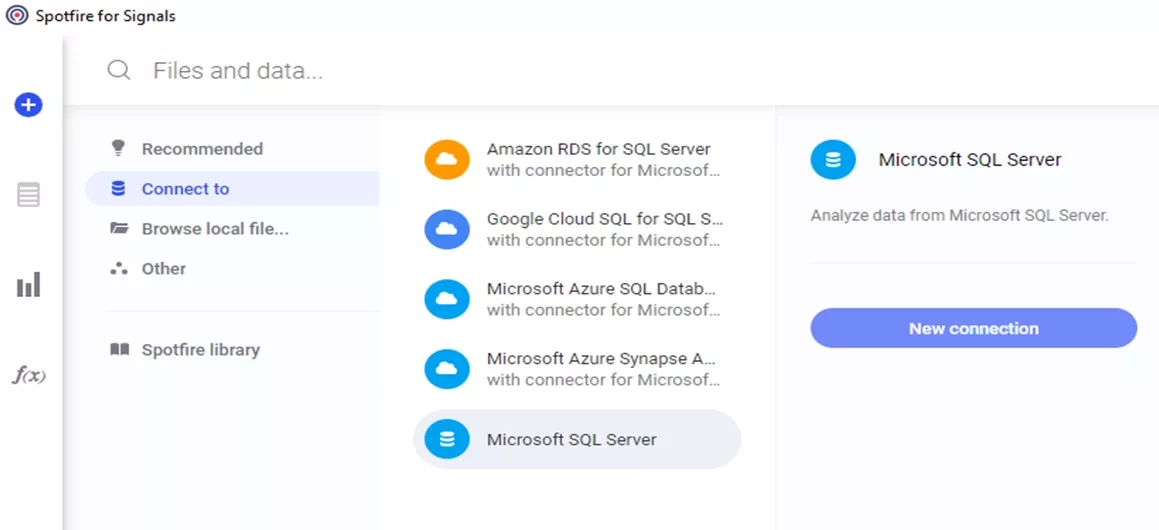
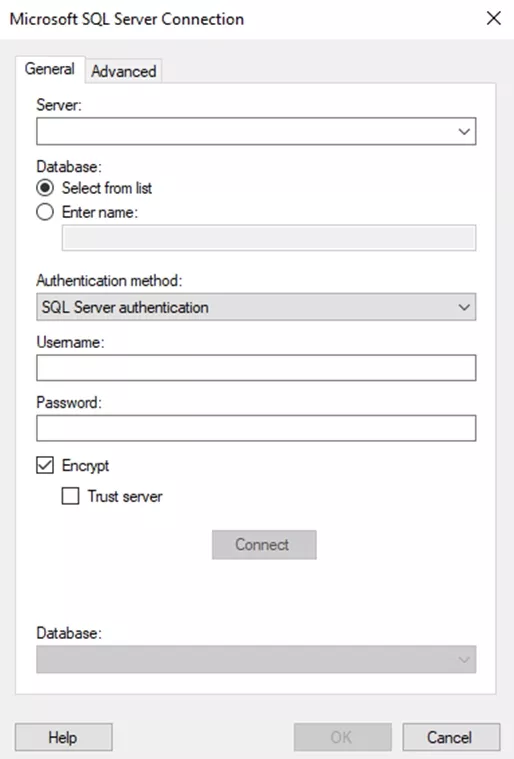
Spotfire Connector Microsoft SQL is available within Spotfire for Signals. Data Connection information must be embedded in analysis file. Authoring, editing, and creating new is supported in Spotfire for Signals Analyst while Spotfire for Signals Online can consume existing.
VitroVivo
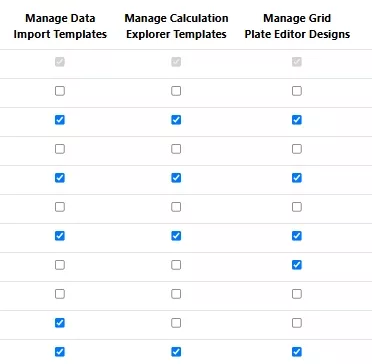
Administrators can grant Data Import Templates, Calculations Explorer Templates and Grid Plate Editor Designs management permissions to specific User Roles:
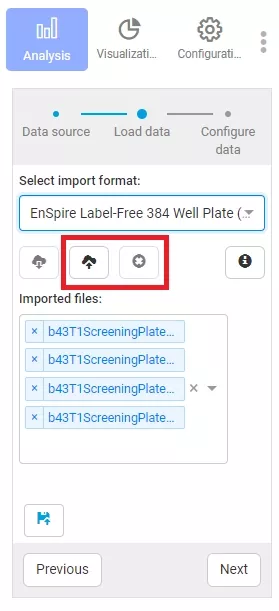
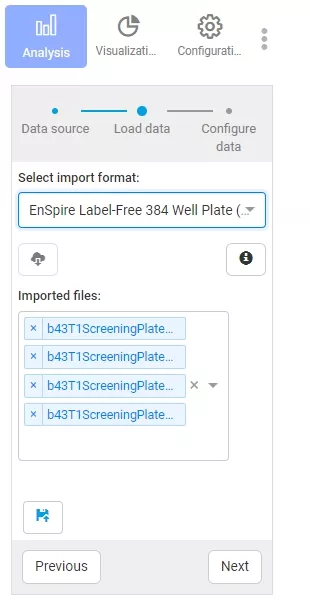
These management permissions allow publishing and deleting Templates or Designs shared in Signals. The users without these permissions will not be allowed to publish or delete Templates or Designs in Signals.
Users without these permissions will not see the buttons allowing them to publish or delete in the respective Apps, as illustrated below in the context of the Data Import App:

Administrators can also grant access, or not, to the Spotfire Screening Apps to specific User Roles:
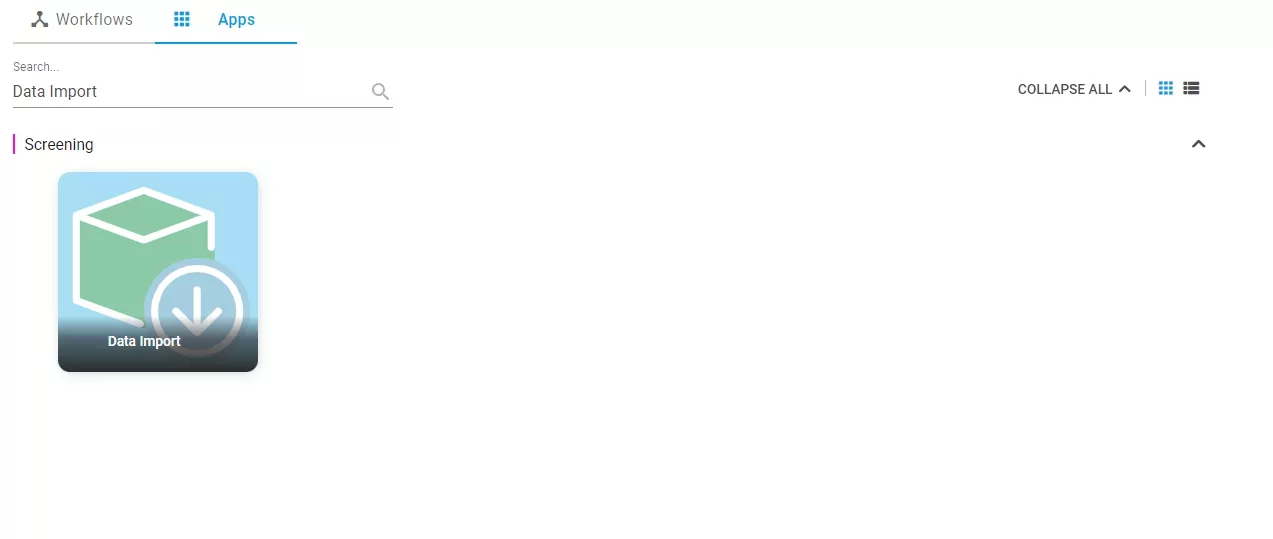
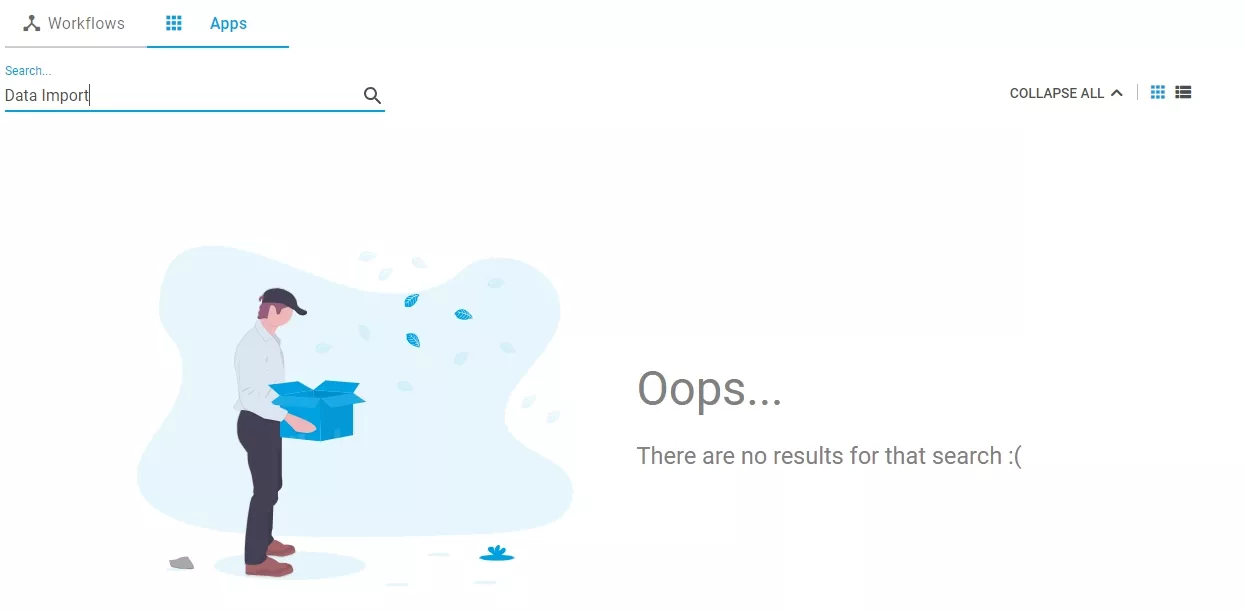
Users without this permission will not see the Apps in Spotfire for Signals, as shown below for the Data Import App.
Inventa
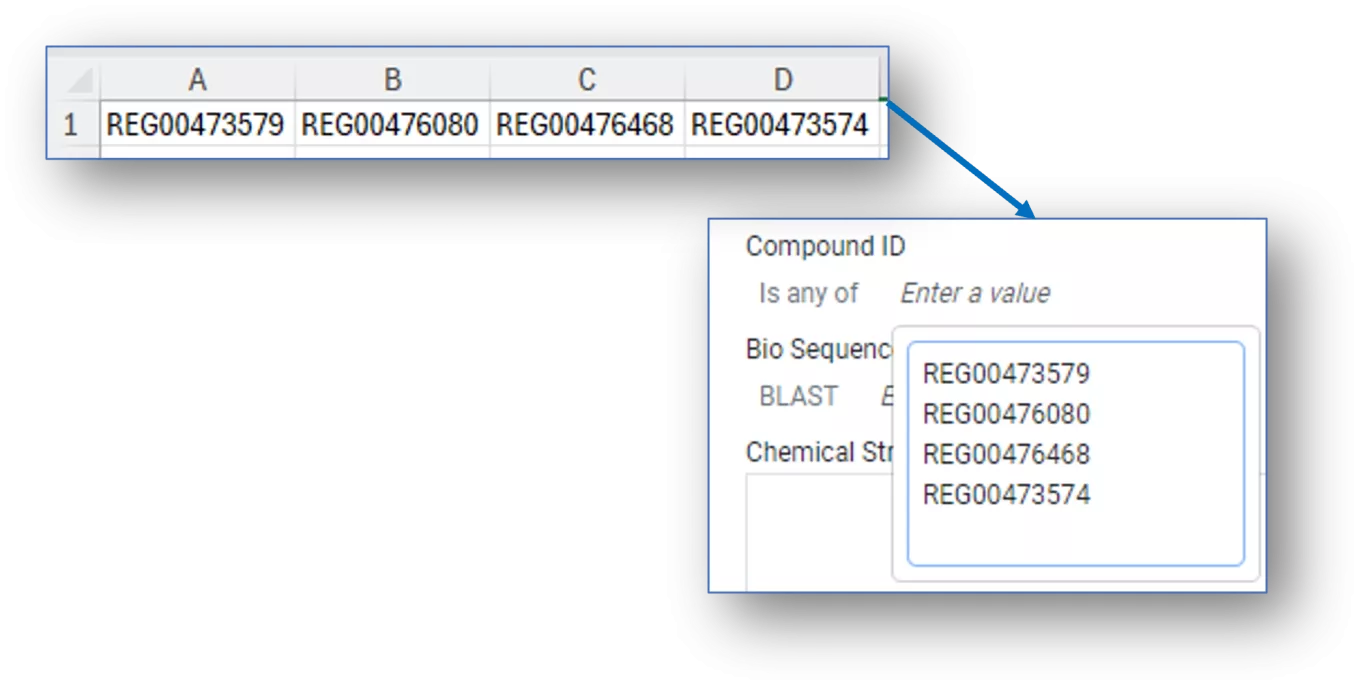
The Integrated Summary App now supports tabs, commas, and paste from Excel as inputs with the “Is Any Of” search criteria
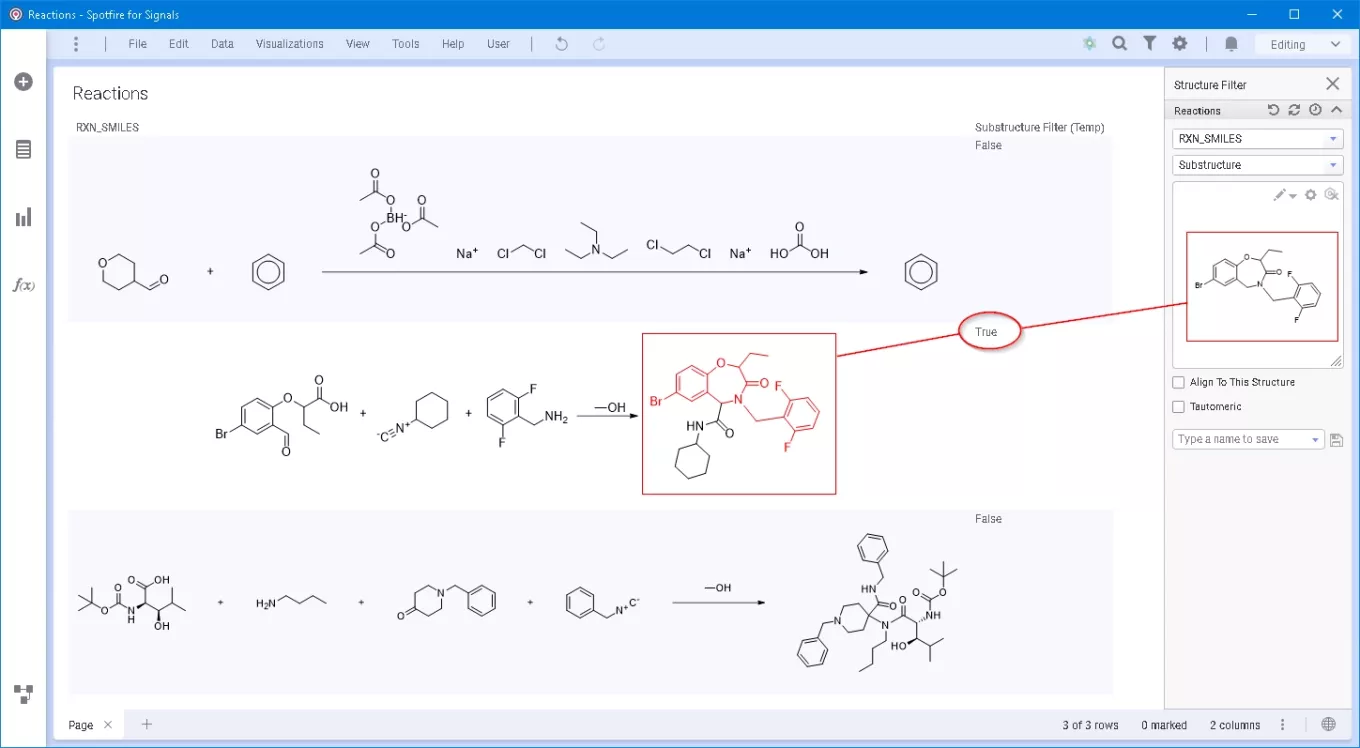
Inventa now has improved support for MDL RXN content, including compatibility with Structure Rendering, Structure Filtering, Structure Copying, and Exporting to ChemDraw for Excel
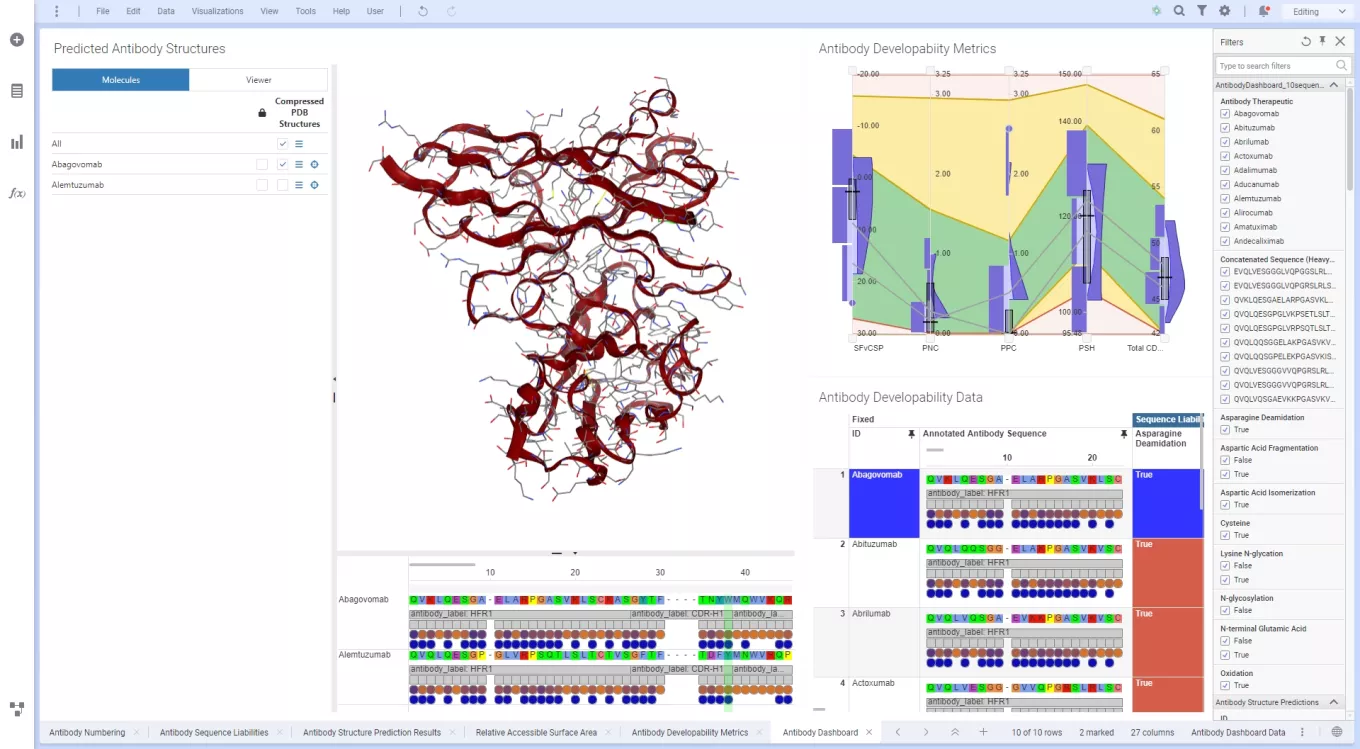
Inventa’s ChemCharts introduces a major upgrade including two new visualizations, new antibody data functions, enhancements to structure search, and new configuration options.
Multiple Antibody Data Functions have been added to ChemCharts, including Relative Accessible Surface Area, Developability Metrics, and Structure Prediction. An Antibody Dashboard Data Function automatically chains all of them, plus the Antibody Numbering and Sequence Liabilities Data Functions.
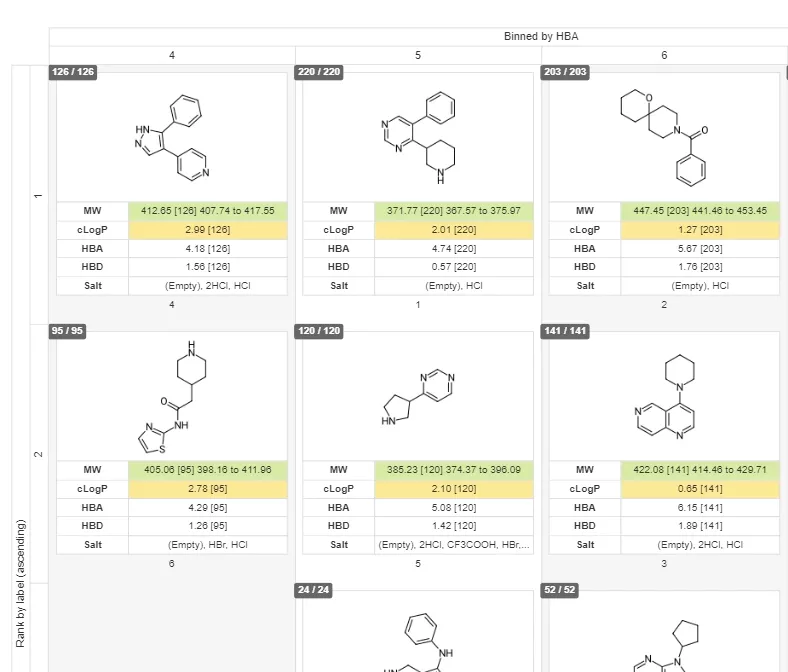
The Cluster Card Visualization in ChemCharts allows user to create groups of small molecules or other entities via interactive drag-and-drop. Clusters are represented in a hierarchical tree, with an optionally defined representative structure. Cluster information, like group statistics, is displayed in a form-based view with various organization options.
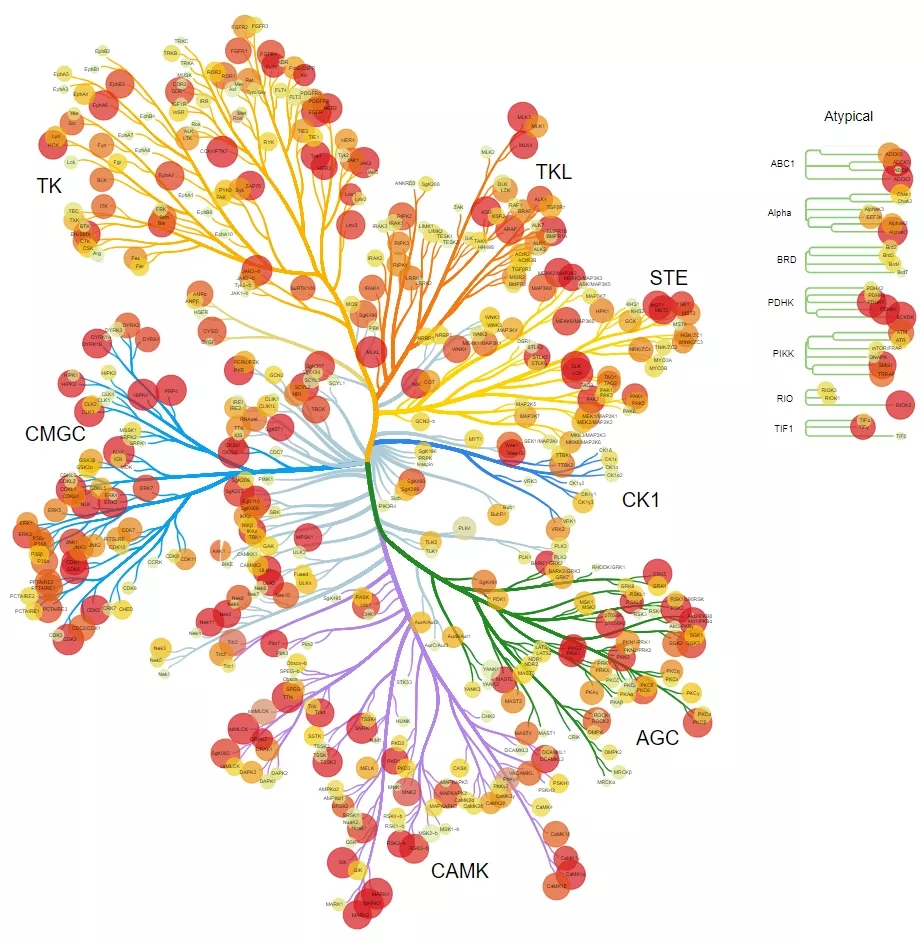
The Kinome Visualization in ChemCharts displays qualitative and quantitative data in a kinase phylogenetic tree, with extensive configuration options for branch and nodes.

ChemCharts Structure Search has been enhanced with a Quick Search method to allow searching directly from a Details, Gallery, or Table Visualization.
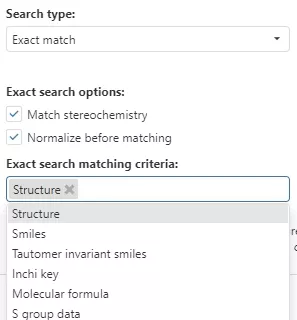
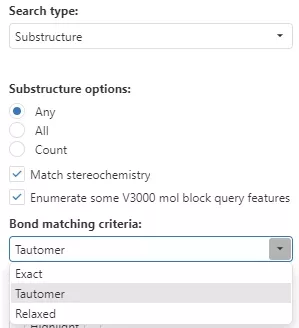
The Exact Match and Substructure Search options in ChemCharts now include additional configuration options. Exact Match supports normalization prior to matching, which will remove explicit Hydrogens, disconnect metal ions, standardize stereochemistry, etc. Users can also specify Exact Match criteria beyond just Structure (e.g.: SMILES, InChi key, Molecular Formula). Substructure Searching now supports additional Bond Matching criteria, including Exact, Tautomer, and Relaxed.
Newly introduced Configuration options for ChemCarts Visualizations include the ability to use Smart Cells as controls in From-Based Visualizations, an option to turn off atom labels in the RDKit renderer when the image is small, and the ability to export number and color formatting to Excel.
Synergy
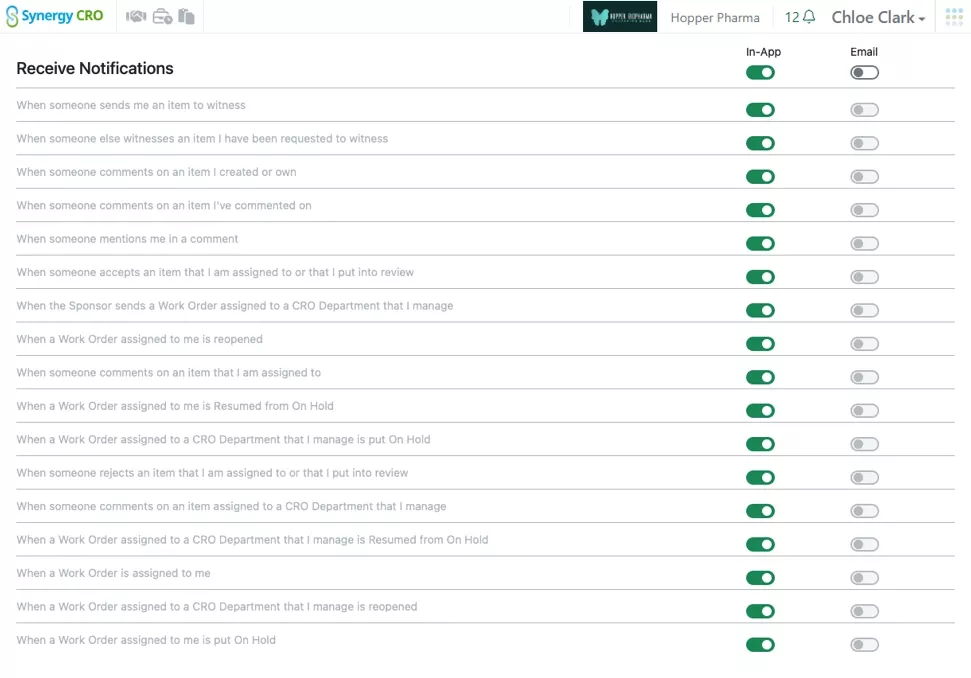
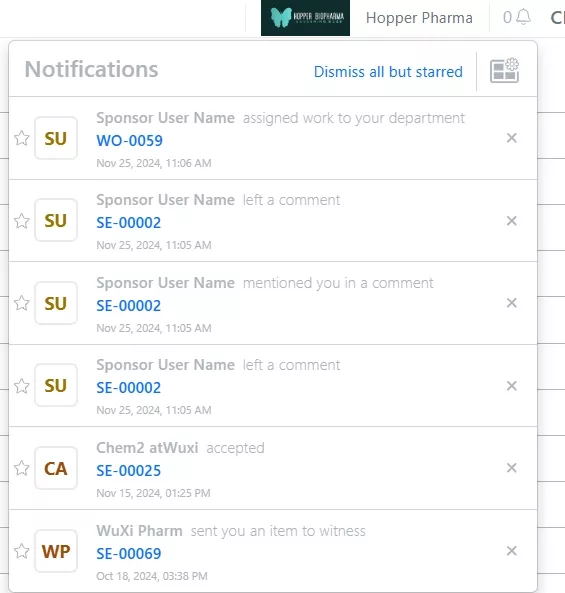
CRO users can now receive Notifications about Work Order assignment, Synergy Experiments, comments, and other relevant changes. CRO users can configure their notifications by clicking on Notifications in the User Menu. Email notifications will send an e-mail each time a selected event occurs. In-app notifications appear in the bell icon in the Synergy CRO application.
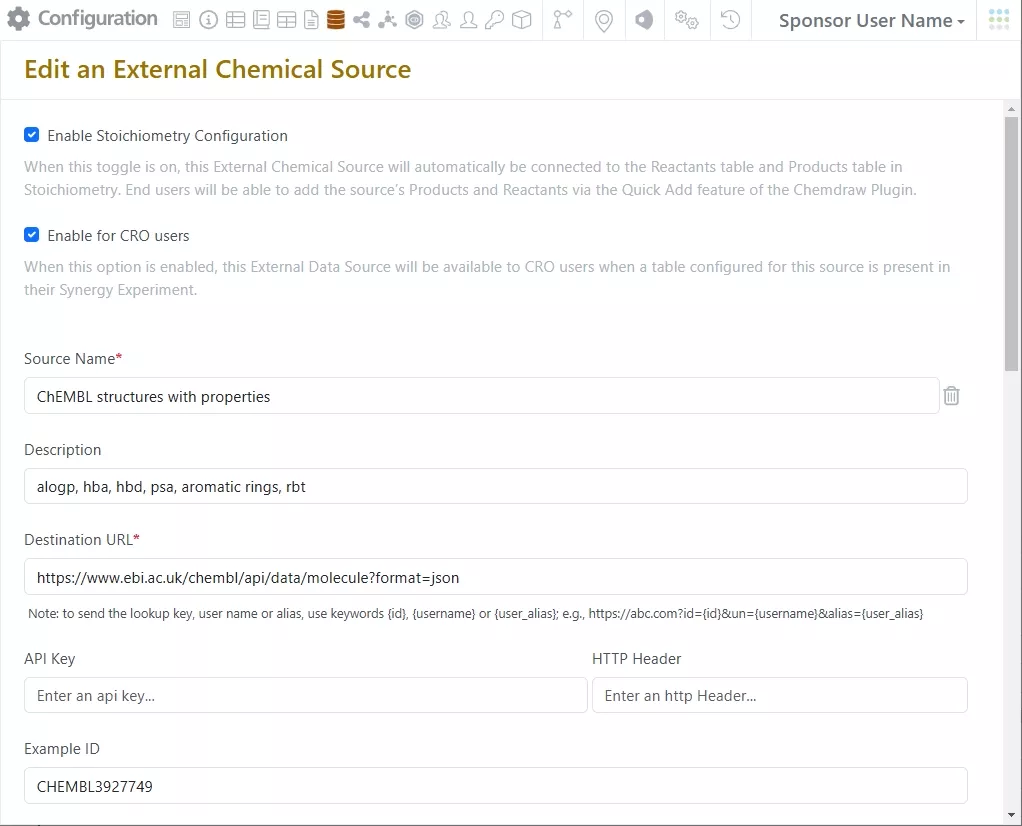
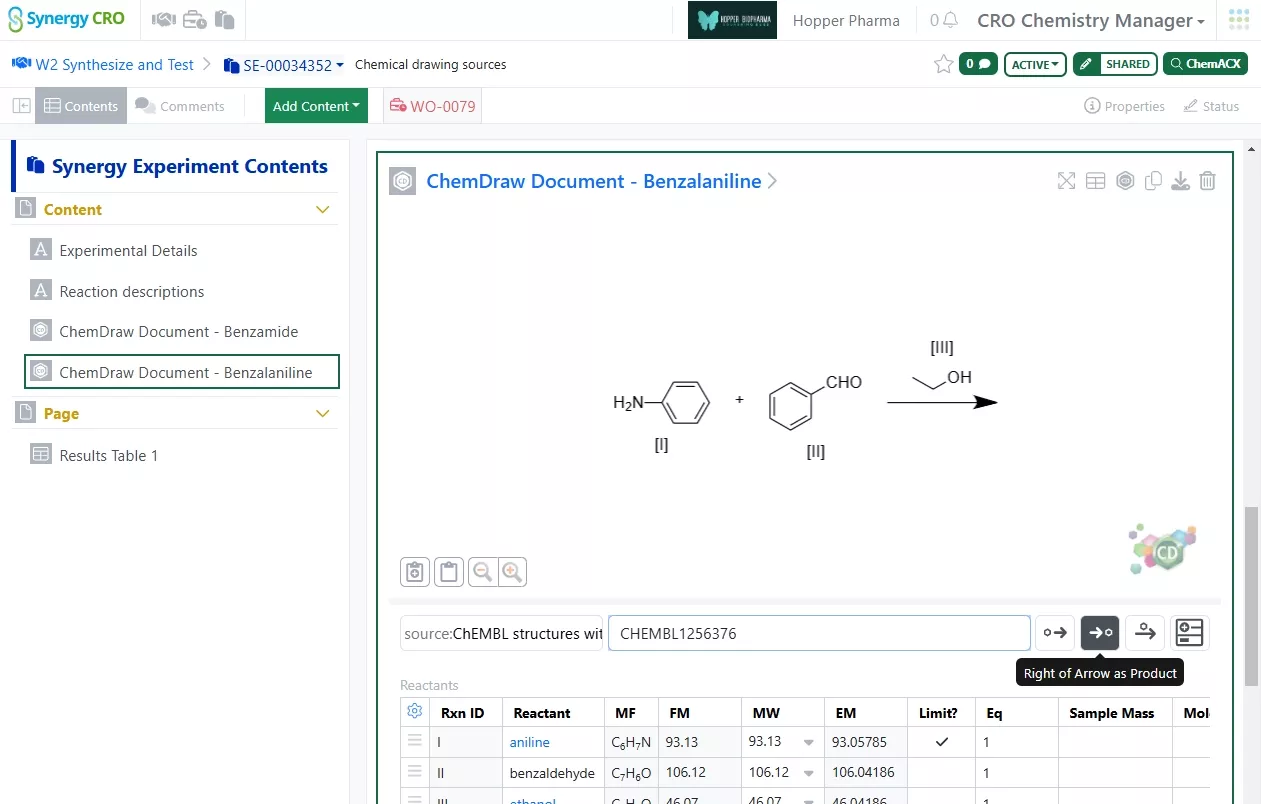
CRO users can now utilize Quick Add functionality in Chemical Drawings to easily add common chemicals (“generic add”), chemicals by CAS number from ChemACX, and chemicals from External Chemical Sources that are Enabled for CRO Users by the Admin. In Signals Configurations under Data Sources, the Admin can choose which External Chemical Sources to Enable for CRO Users. Enabled sources will appear for CRO users to the left of the Quick Add toolbar of Chemical Drawings in Synergy Experiments. Sources not enabled will not be accessible to CRO users.
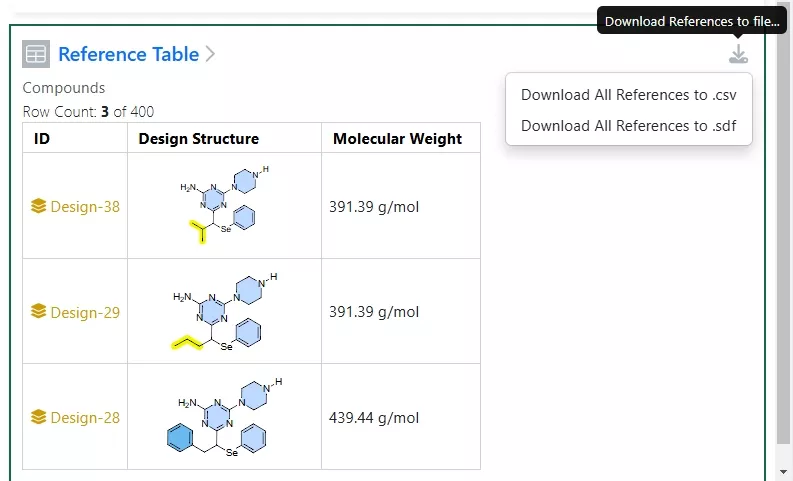
In Synergy Work Orders, both Sponsor and CRO users can now download Reference Tables to SDF or CSV files. If a Chemical Structure or Design Structure is included, the structure will be included in the downloaded SDF or CSV (as SMILES). For Reference Tables with Materials assets or batches, exported files will contain both the Material ID and ExID for the Sponsor, but only ExIDs for the CRO.
Finally, given the appropriate privileges by the Admin, Sponsor users can now Share their Work Orders and Synergy Experiments with other Sponsor users in the parent Collaboration, allowing them to elevate or reduce access level (e.g., from Write to Full Control) to a specific entity. Work Orders and Synergy Experiments can only be shared to other Sponsor users who already access, never to CRO users. This functionality allows Sponsor users to share amongst other Sponsor users without risking leakage outside the organization.
Admin Defined Tables & Variation Tables
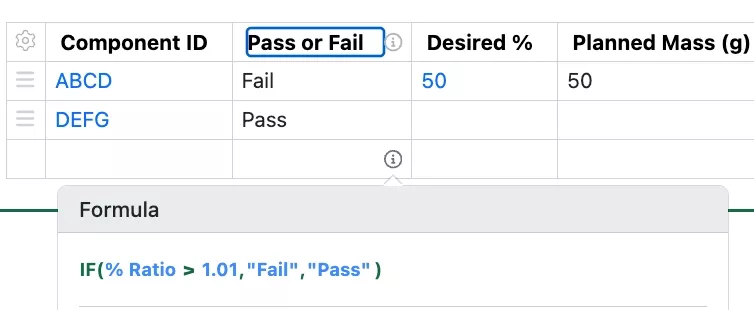
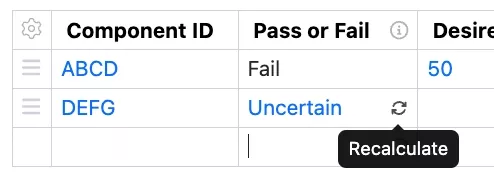
Configuration Admins can now define that calculated values in Admin Defined Tables and Variation Tables can be overwritten by the end user, by deselecting the “Read Only” setting. If the field is not set to Read Only, the end user can write in their own value. There is a reset option in order to reset to the calculated value.
Inventory
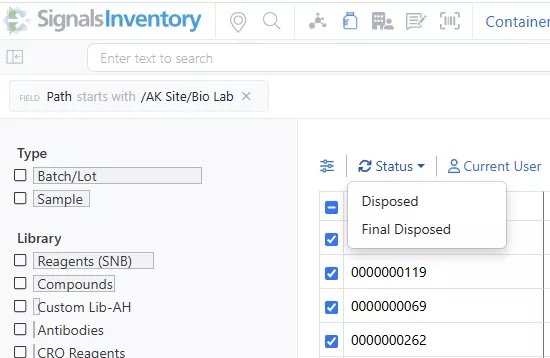
Status can now be updated via the Containers Search Table.
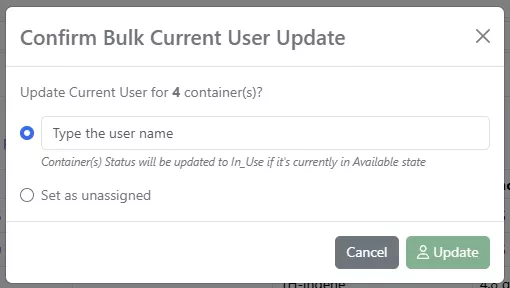
Users with privileges to Final Dispose will see the option, all others with appropriate privileges will see Dispose. To change container status to In Use, assign the container(s) a Current User. To change the container status to Available, set the Current User to unassigned:

To change the container status to Exhausted, update the Amount to zero.
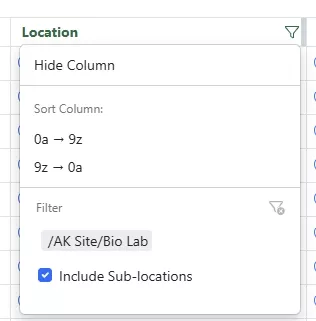
Sub-Location can be searched and exported from the Containers Search Table.
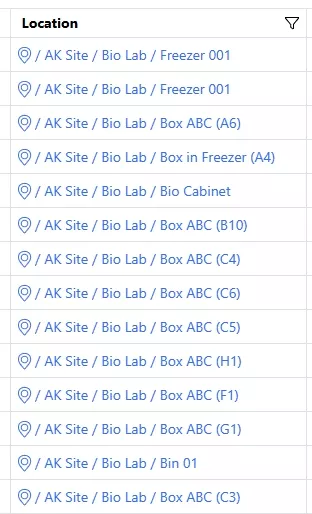
When searching for locations, users can automatically include sublocations by checking the box. The results will show the selected location and its sublocations, which can then be exported.
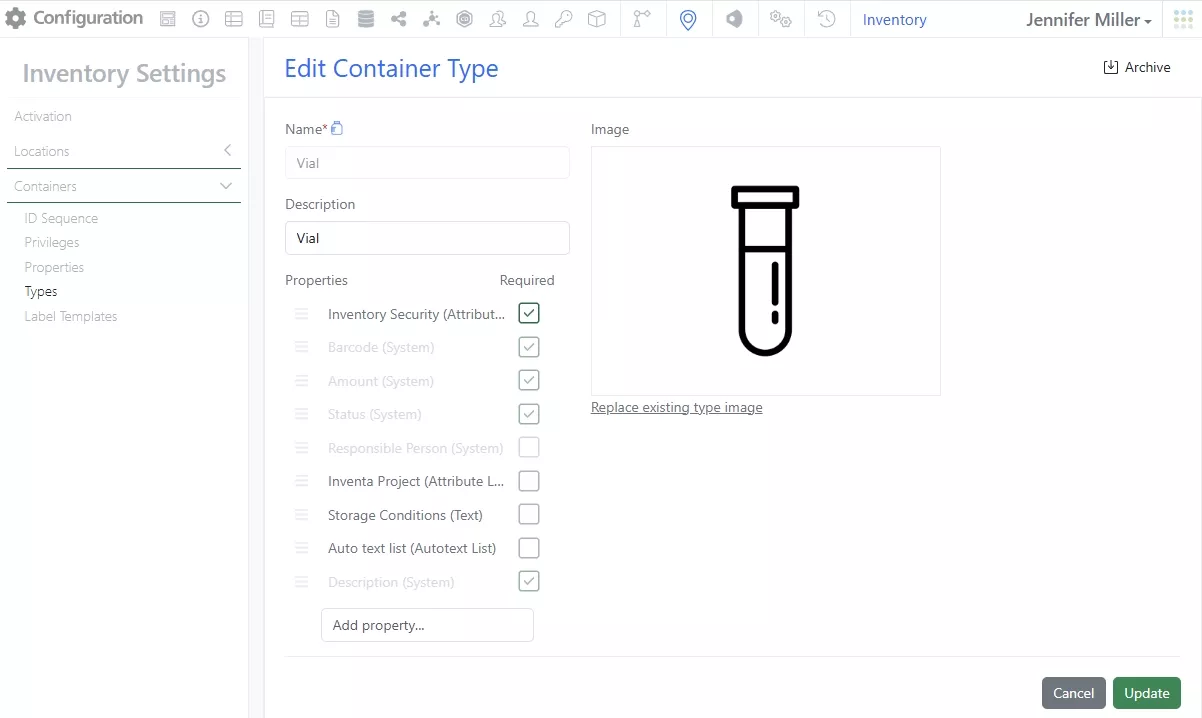
Descriptions can be added and printed on Labels.
Each container type has a system property called Description.
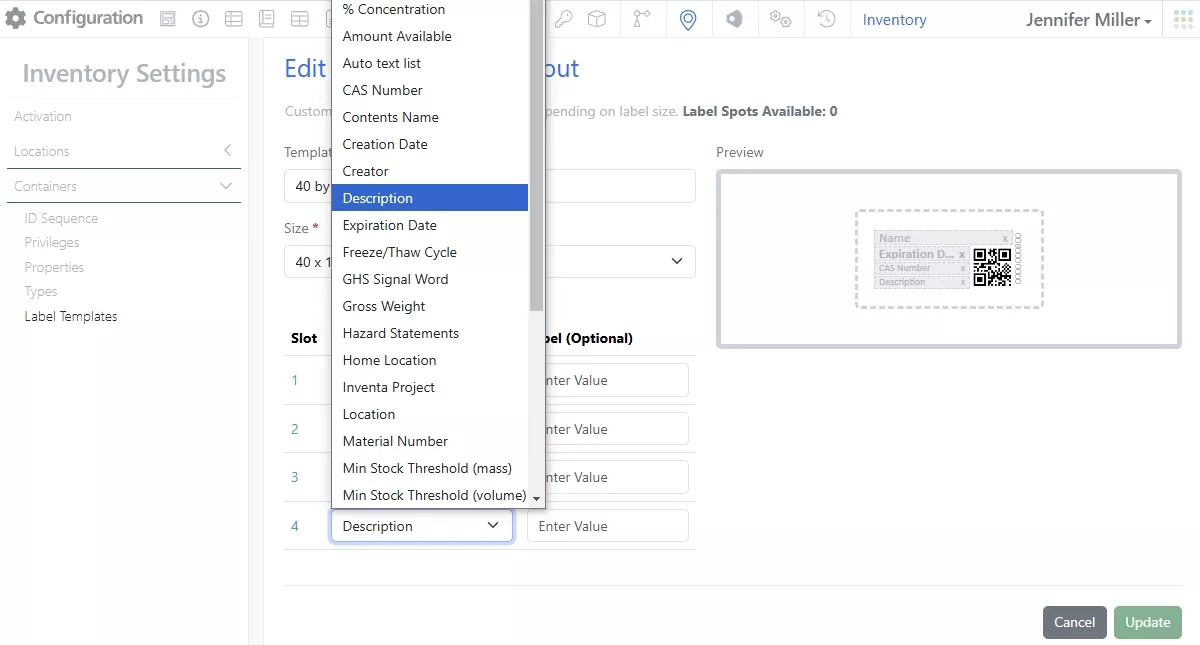
Administrators can choose to add the Description property to label templates.
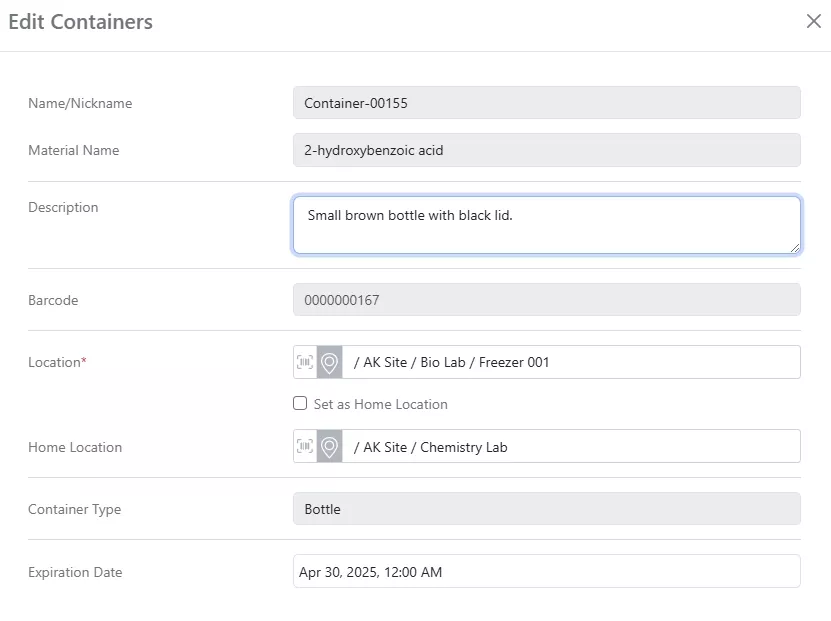
Creating, Copying or Editing a container will display the Description property.

If the Label Template has been configured to print the Description property, the users will see it on the label.
Administration
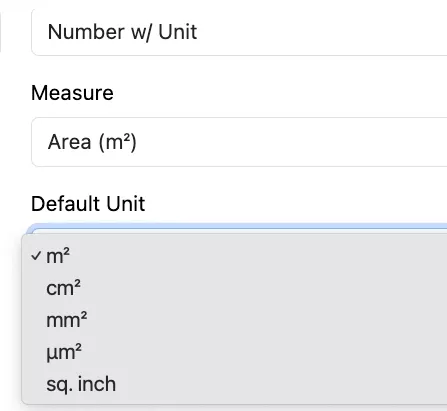
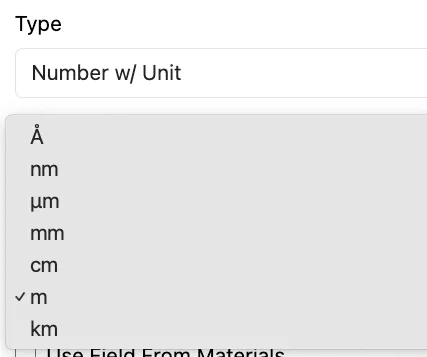
We have added new Measures for Length and Area. These Measures can be selected when adding new properties of type Number With Unit to Admin Defined Tables and other objects that support the Number With Unit property type.
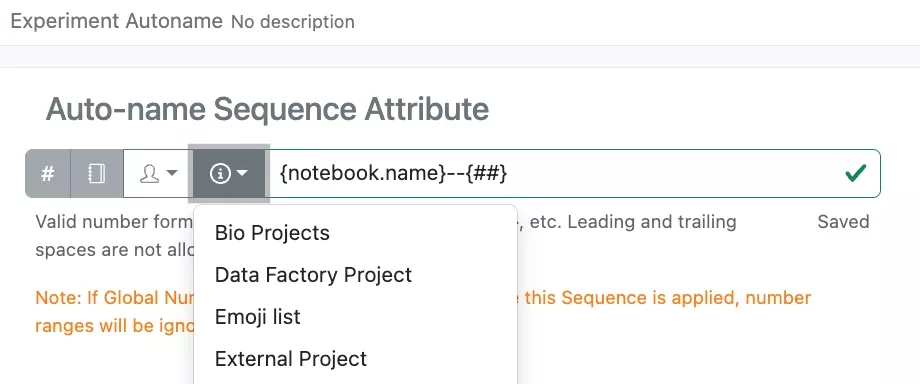
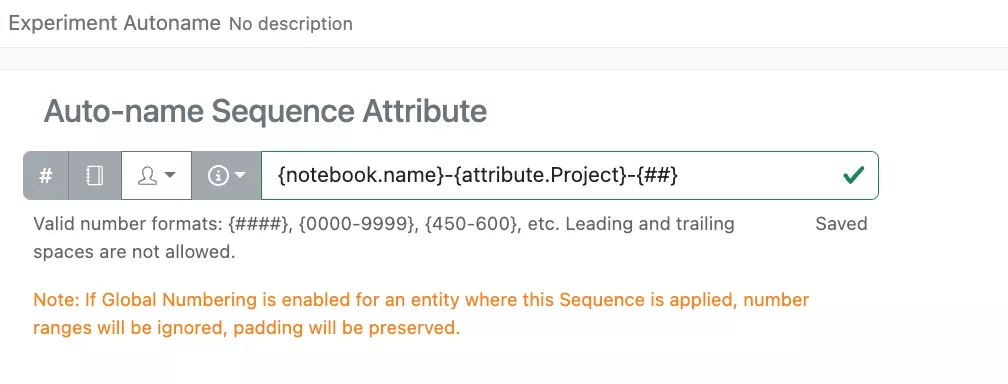
Admins can now also include Attribute List values into Naming Sequences, such as those used to autoname Experiments. The Admin chooses from the available Attribute Lists, whereby on Experiment creation, the value selected for that Attribute List is included within the Experiment Name.
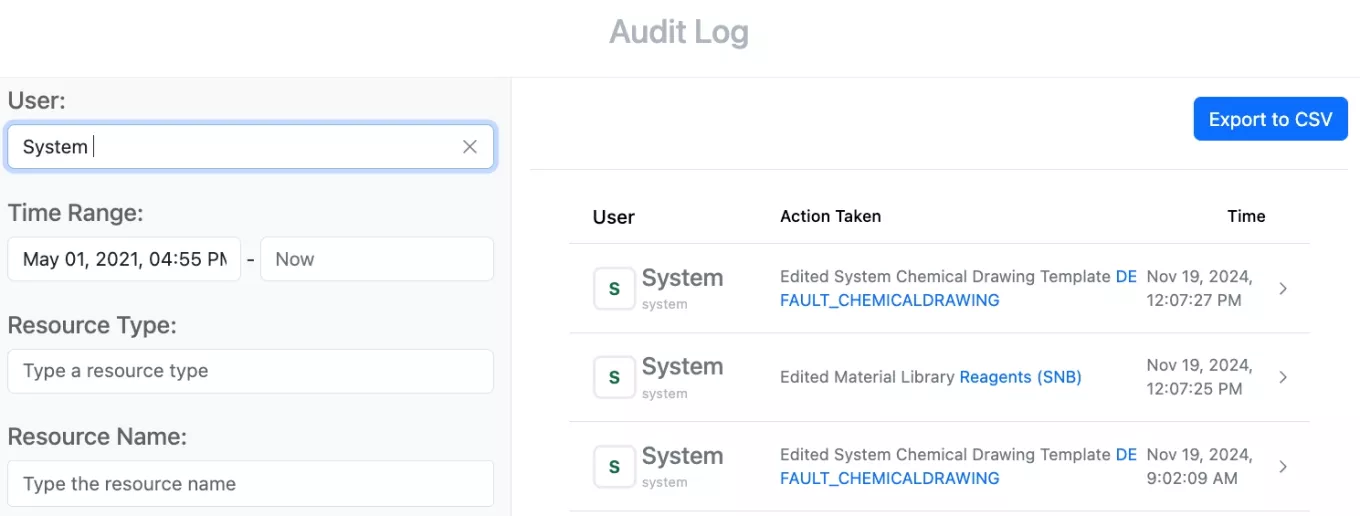
If the Attribute List is not present or doesn’t have a single value nothing is inserted into the name.
System Admins can now selectively view system managed events in the Admin Audit Trail.

User Roles VitroVivo section renamed Spotfire for Signals and includes an expanded set of privileges.
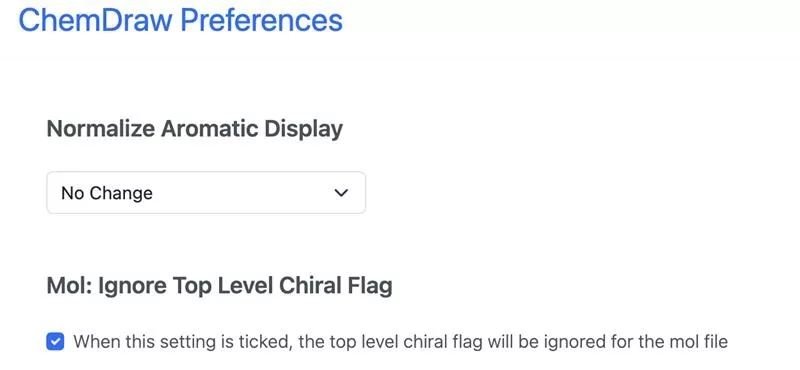
Access Spotfire for Signals Analyst privilege controls whether a user has access to the local Analyst installer within the Home App as well as the launcher. Users without this privilege will be limited to Spotfire for Signals Online use.
New manage privileges for Screening Apps include Manage Published Workflows, Manage Data Import Templates, Manage Calculation Explorer Templates, and Manage Grid Plate Editor Designs. The InVivo Data Model Designer App has a new Manage Data Model Designer Templates privilege. These privileges control which users can create, edit, and delete items that other users can access.
Additionally, new share privileges for Inventa include Share Inventa Search, Share SAR Groups, and Share SAR Layout.
Control which users can access and substantiate an App via new privileges, including Access Screening Apps, Access Surface Plasmon Resonance Apps, Access InVivo Apps, and Access Data Model Designer App. Users without these access privileges can still leverage the Apps within shared Workflows and DXPs.
Signals Research Suite Private Cloud environments now have the availability to manage and deploy Spotfire for Signals Custom Apps. Once enabled, a new privilege, Manage Spotfire for Signals Custom Apps, will be available in the tenant to control access to the new Spotfire for Signals Custom Apps Configuration available within Home. Also once enabled, all tenants within the environment will have a new Access Spotfire for Signals Custom Apps privilege that controls which users can substantiate Custom Apps.
The ChemDraw Preference setting for chirality is now observed in Inventa. When selected, the top-level chiral flag is ignored for mol files while using the ChemDraw (vNext) renderer in Inventa.
Integrations & APIs
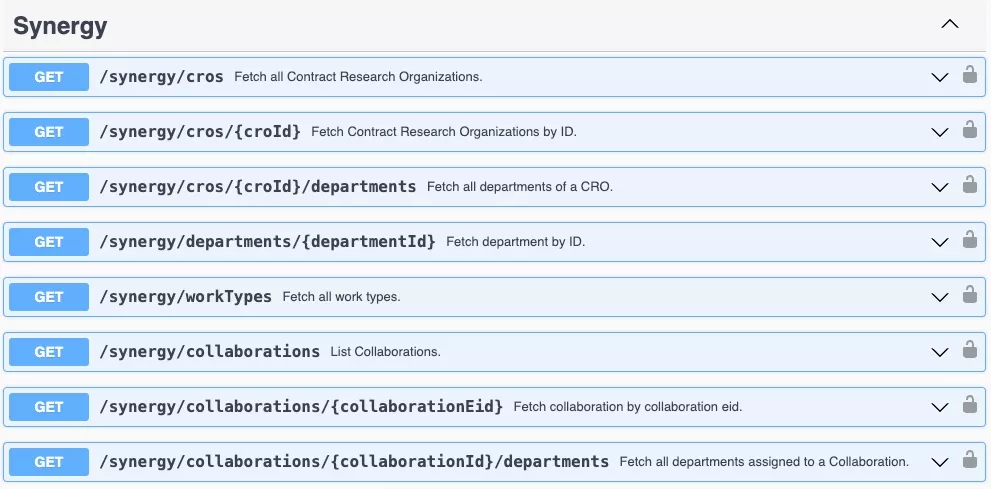
This update brings our first set of endpoints for Synergy customers. Only sponsors have access to APIs and configuration of external sources.
The initial set of API endpoints is focused on fetching of details about Synergy entities and work types. A new Synergy section has been added to Swagger that includes these endpoints.
Endpoints are available to fetch details about CROs, collaborations, departments, and work types.

External Notification for Synergy Experiment, Idea, and Work Order creation have been added to the “Top Level Entity Creation” notifications events. Signing events for Ideas and Synergy experiments have been added to “All Signing Events” notifications.
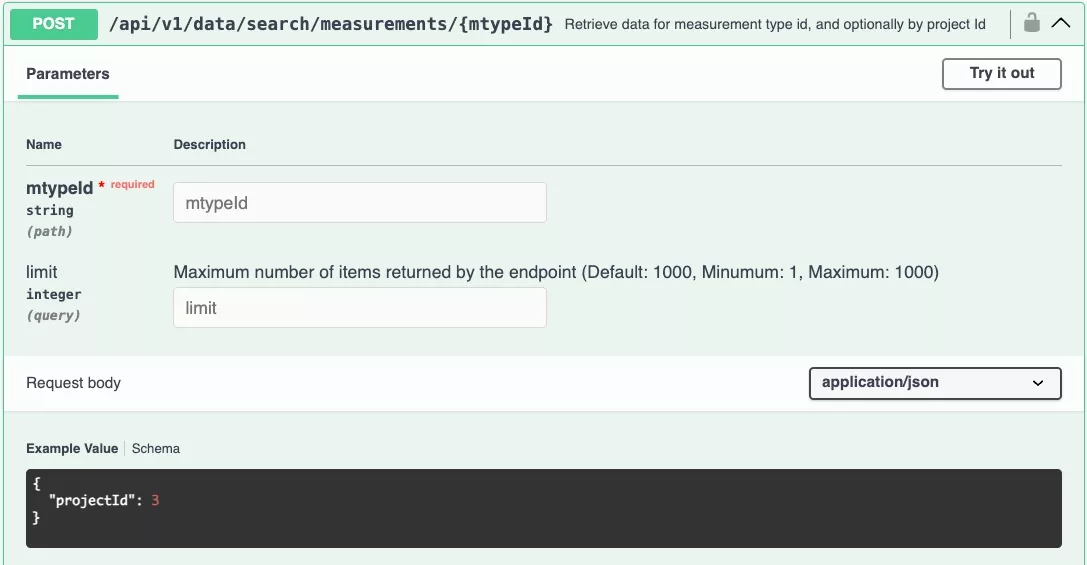
A new endpoint for the Signals Data Factory has been added for retrieving measurements data. You must specify the id of the measurement you are interested in and can optionally provide a projectId in the request body.
Note: To fetch mTypeId you can use: GET /api/v1/info-design/measurement-types. To fetch projectIds you can use: GET /api/v1/projects.
Further Details
The following capabilities are in beta and are available for users, administrators and developers on the Signals platform upon request. Please contact your account representative or our support team if you would like access to the following features.
VitroVivo
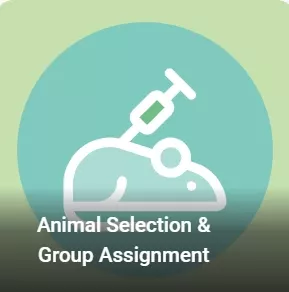
A new In Vivo Application called “Animal Selection & Group Assignment” is now available upon request. This multi-step application will allow users to capture baseline data, select animals according to study criteria and assign them to treatment groups using either manual or randomization methods.
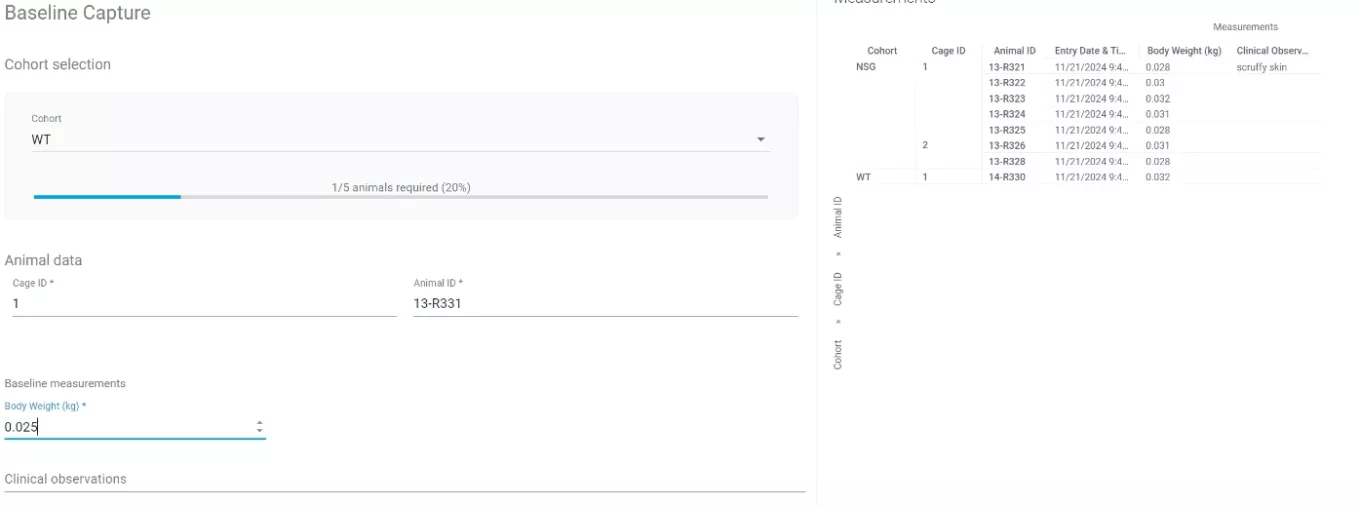
This new application is an enhanced alternative to the current Baseline Capture app. Administrators can configure new user workflows by replacing the existing Baseline Capture app with the new app.
The new application will allow users to capture baseline data from animal cohorts using a form-based approach.
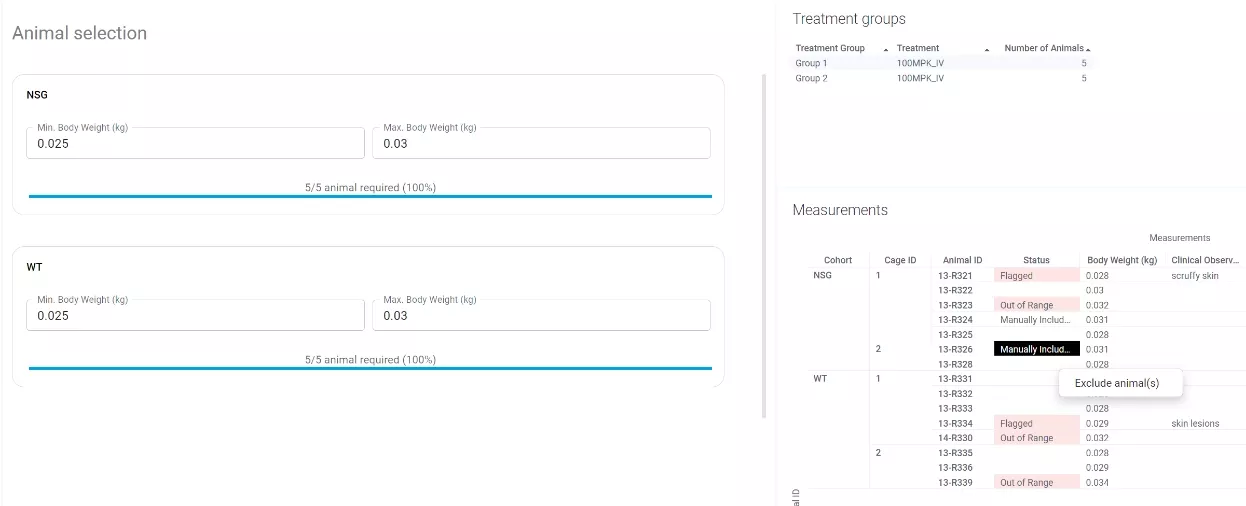
The application supports automatic selection of animals based on user-defined metric ranges. Built-in visualizations will inform the user about the list of animals excluded from the study and the reasons for exclusion. This is an interactive application that will allow users to manually include or exclude animals, if needed.
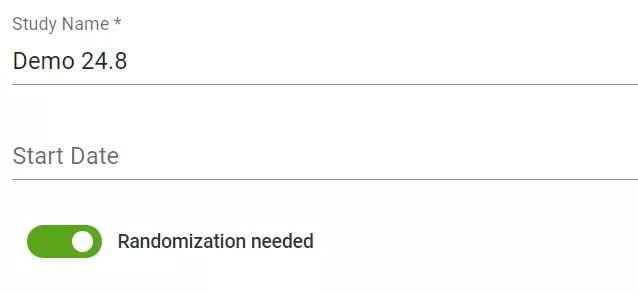

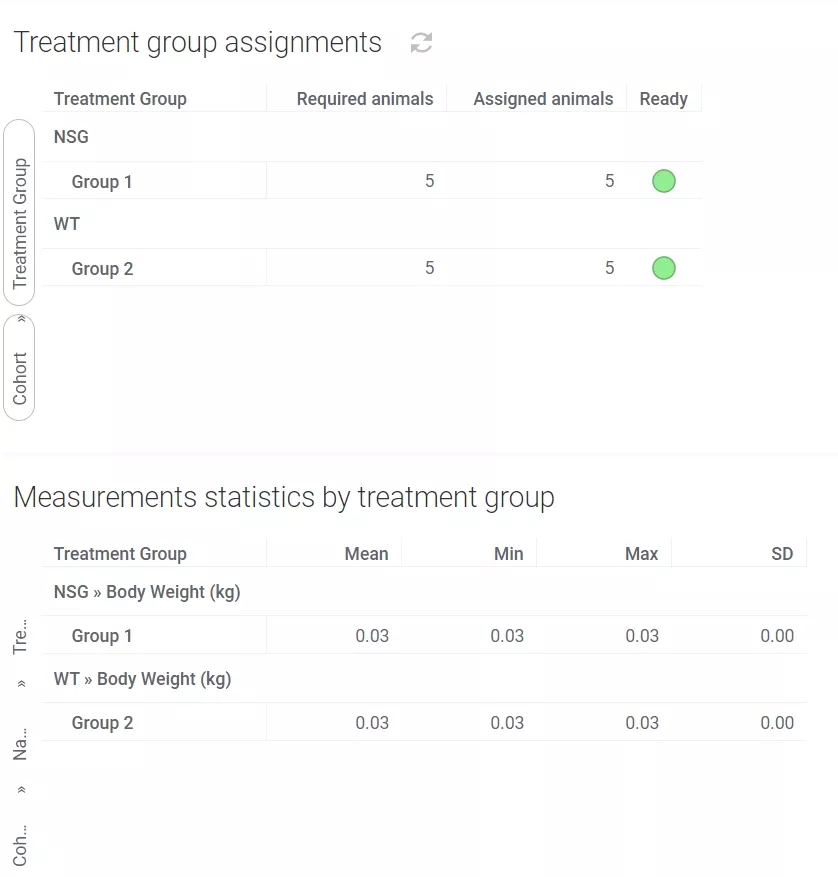
The application supports assignment of animals to treatment groups either manually or via randomization methods. If “Randomization needed” is selected in the Study Designer Application in the workflow, then the system will automatically present the Randomization options to the user in the Group Assignment step in this application. Based on the randomization criteria entered by user, the system will automatically assign animals to treatment groups.

Users can also assign new Cage IDs and Animal IDs to the grouped animals, if needed.
What's New
This version 24.9 release of Signals brings an enhancement to our External Actions to allow admins to specify which Experiment or other templates show the Action. We have also added enhancements to the Inventory Search Table, and to add calculations in Headers of Admin Defined Tables. Our beta capabilities around refreshing material properties and assigning Tasks to Groups are now available to all systems. We have also made improvements to the admin management of users, to materials, Inventa and VitroVivo. Finally, we have also fixed a number of small bugs.
The following improvements are available for users, administrators and developers on the Signals platform. Certain features may only be available with appropriate licensing and/or with enablement by an administrator.
- Fundamentals
– Clear Formatting in Text Elements and Worksheet Templates - VitroVivo
– Sequence of Events App now supports Dose Volume calculations according to Body Weight - Inventa
– Data Factory timeout obeys Signals Config timeout system setting - Synergy
– Creation of Work Order directly from selected Designs in an Idea
– Smart Folder and search capabilities for CRO users in Synergy
– Sponsor administrators can now decide whether to select a CRO Administrator for a CRO
– External Actions are now available in Synergy - Chemistry
– Definition line of a FASTA Peptide sequence added as an annotation when inserted or pasted into a Chemical Drawing - Admin Defined Tables & Variation Tables
– Calculations in Headers - Inventory
– Update to Location Search
– Internal Requests Initiated from Experiments, Admin Defined Objects
– Search via CAS in Containers Search Table
– Filter by Autotext List in Containers Search Table
– Bulk Update Responsible Person in Containers Search Table
– Autofill Grid Locations
– New privilege that allows users to aliquot containers - Materials
– Export batch/lots of a material from the Batch/Lot page
– Refresh of calculated material properties available to all systems - Tasks and Requests
– Bulk creation of tasks from Samples table now associates Sample and Container information
– Assignment of Tasks to Groups available to all systems - Administration
– Sort, filter and bulk actions on Users - Integrations & APIs
– Read-only Experiment properties can be updated via ExternalAPI
– Users endpoints for license management
– External actions by Template for all templated Entities
– Enhancement to Task External Actions
We also fixed several small bugs in this release. Details of the enhancements are described below.
The following OnDemand videos for Signals Notebook End Users are now available
- HELM Notation: Guide to Add and Edit Monomers & Polymers
Administrators are recommended to subscribe to the channels within our support news site found at https://support.revvitysignals.com/hc/en-us/categories/360004446171-Support-News which contains more information about releases and other pertinent product information.
This content is anticipated for release on our Production E3 environments, and for Private Cloud customers on our deferred release schedule, in March 2025.
Further Details
The following improvements are available for users, administrators and developers on the Signals platform. Certain features may only be available with appropriate licensing and/or with enablement by an administrator.
Fundamentals

There is now an option to clear formatting from the toolbar in Text Elements, and in the Worksheet definition view. On occasion, when content is copied from websites and other third party sources, it can carry formatting information that disrupts the display of the data written in the Text content. This option, which is also available in the Format menu bar, clears formatting and should alleviate such issues.
VitroVivo
The Sequence of Events app will now support the calculation of dose volume and pump rates for dose administration. Dose volume is automatically calculated based on each animal's body weight measurement.
Inventa
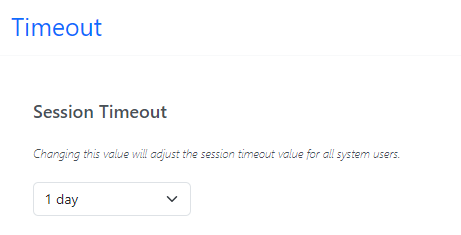
Session Timeout now controls both Signals and Data Factory. Previously, the Data Factory timeout was fixed at 30 minutes. Now, the Data Factory timeout will follow the System Setting in Signals Configuration and can be set for up 1 day.
Synergy
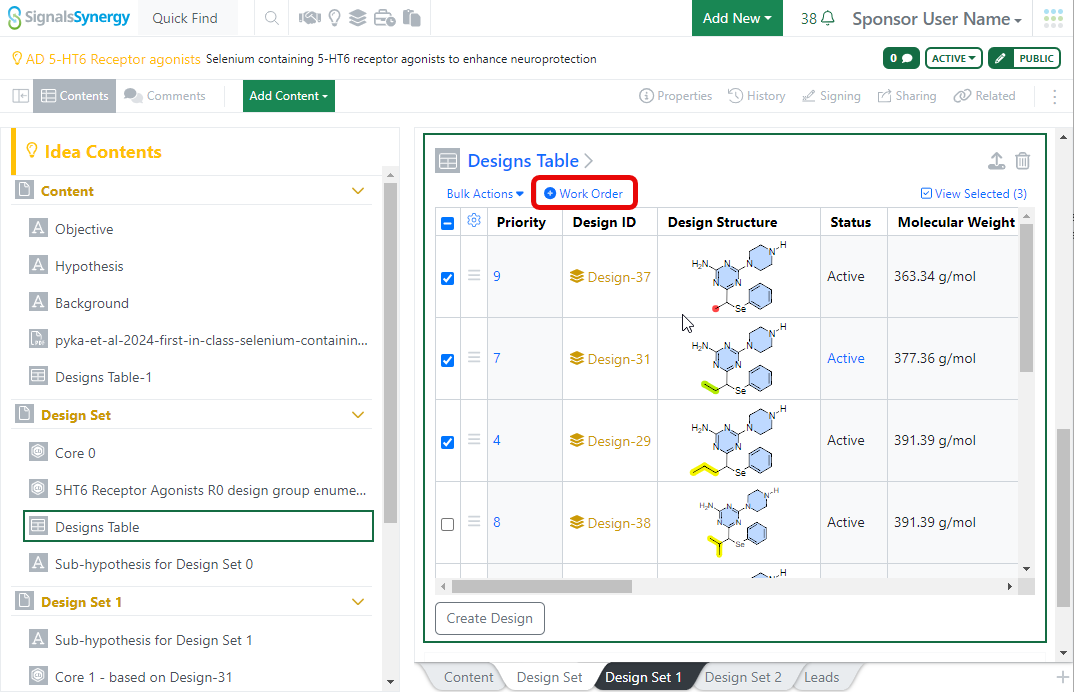
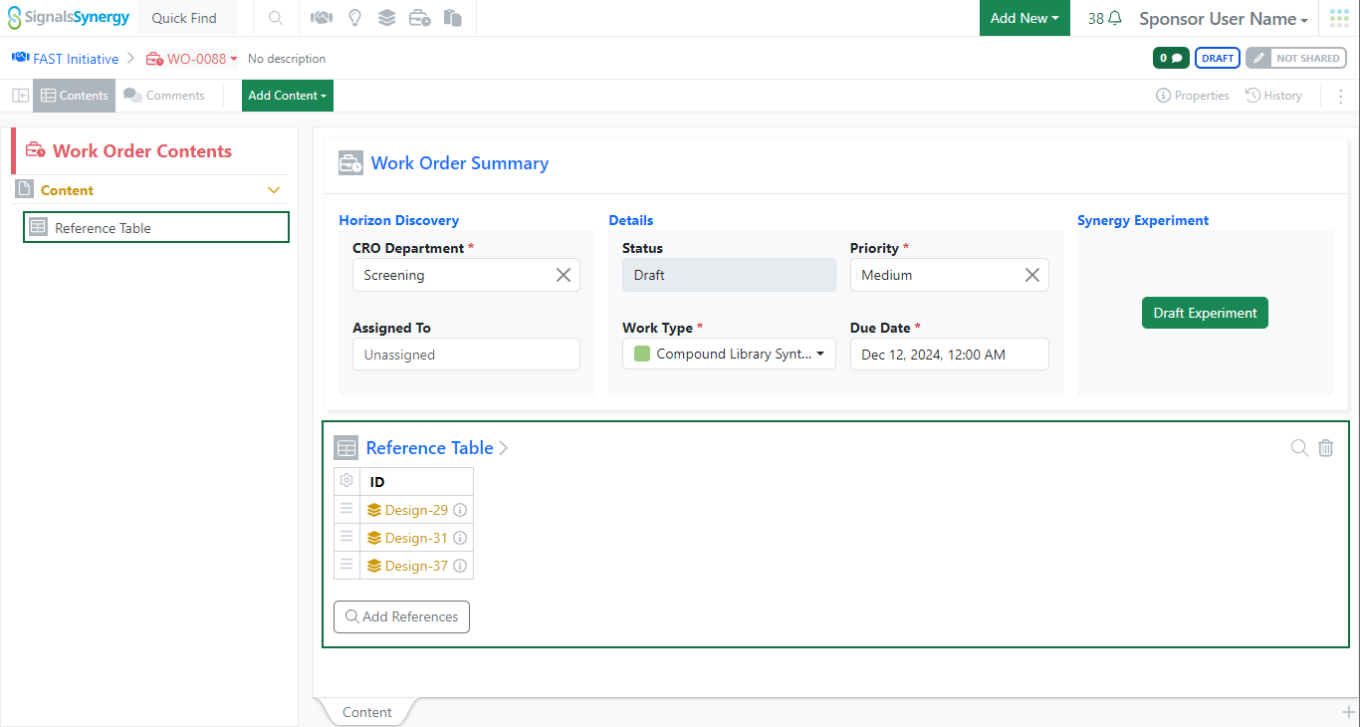
In Synergy, users can now create a Work Order from within an Idea. After selecting a set of Design(s) to send to a CRO, select the + Work Order button. The created Work Order will contain a Reference Table with the selected Designs.
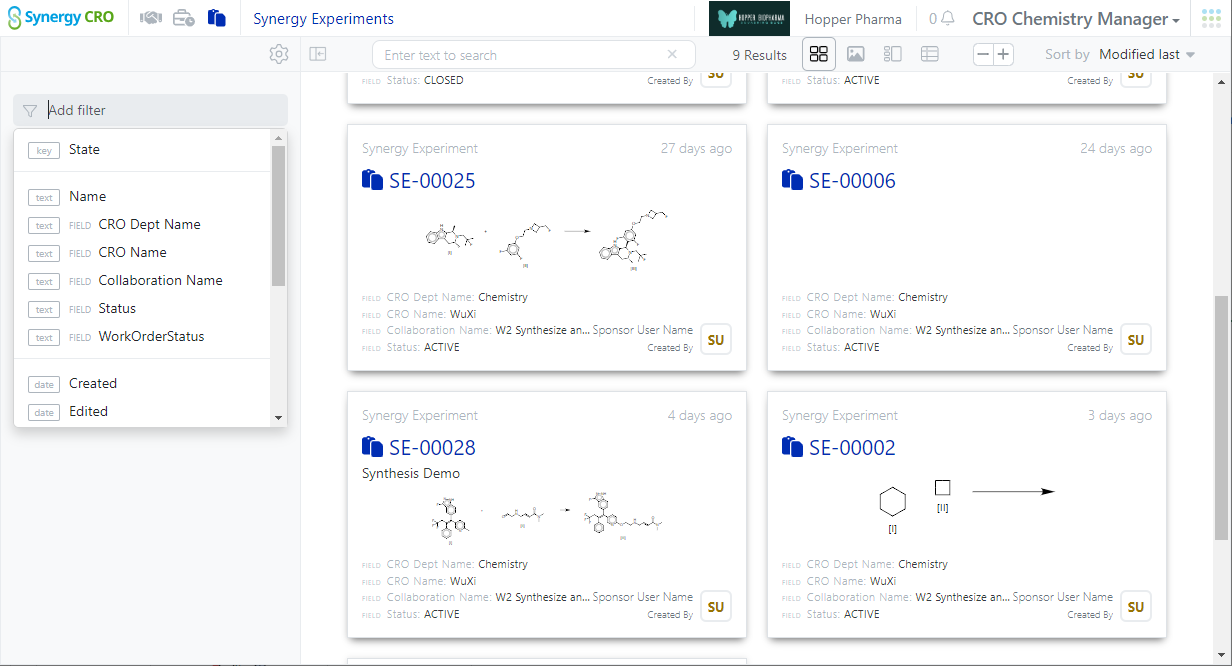
CRO users can now search for their Collaborations, Work Orders, and Synergy Experiments within their Smart Folders, allowing them to more easily find their experiments or filter their Kanban boards.

External actions can now be used in Signals Synergy, by both the Sponsor and CRO users. External actions configured for Samples, Samples Tables, PDFs, Microsoft documents, Chemical Drawings, and Worksheets are all available in Signals Synergy.
Finally, Sponsor System or Synergy Administrators can now choose whether to specify a CRO Administrator for a given CRO, allowing the Sponsor to choose whether a given CRO has a CRO Administrator with access to limited, self-service management of their CRO’s users.
Chemistry
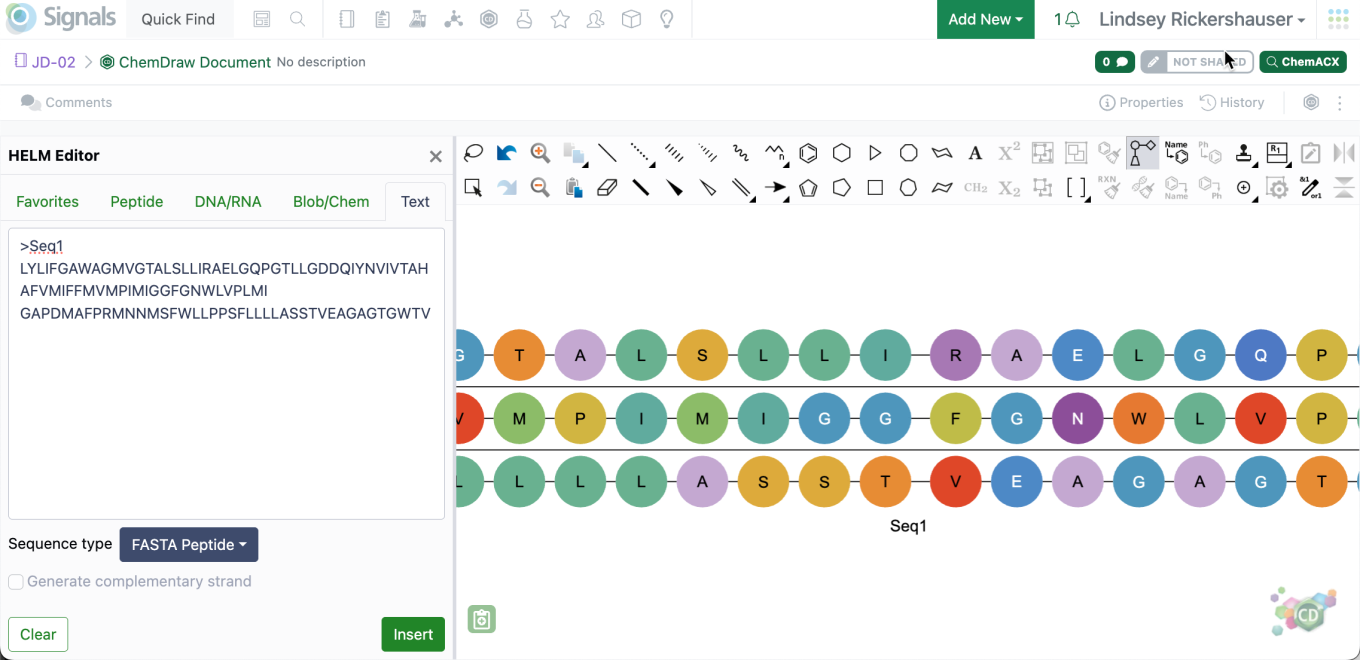
When pasting a peptide FASTA sequence with header information into a Chemical Drawing, either directly or via the text tool of the HELM Editor, the FASTA header will appear as an annotation.
Admin Defined Tables & Variation Tables
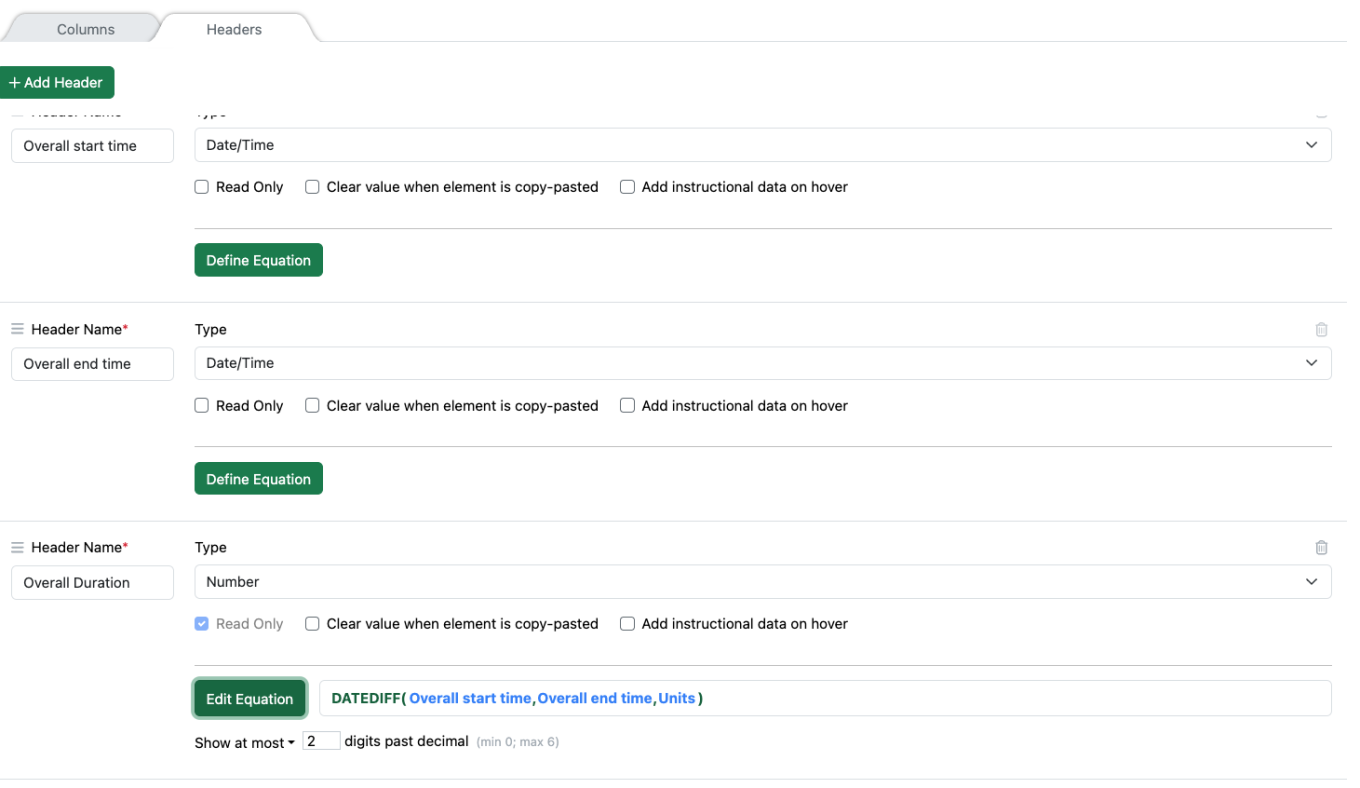
Headers in Admin Defined Tables and Variation Tables can now have their values calculated via an equation. Headers of type Date/Time, Number, Number with Unit and Text can be configured to use equations using entries from other Headers.
Inventory
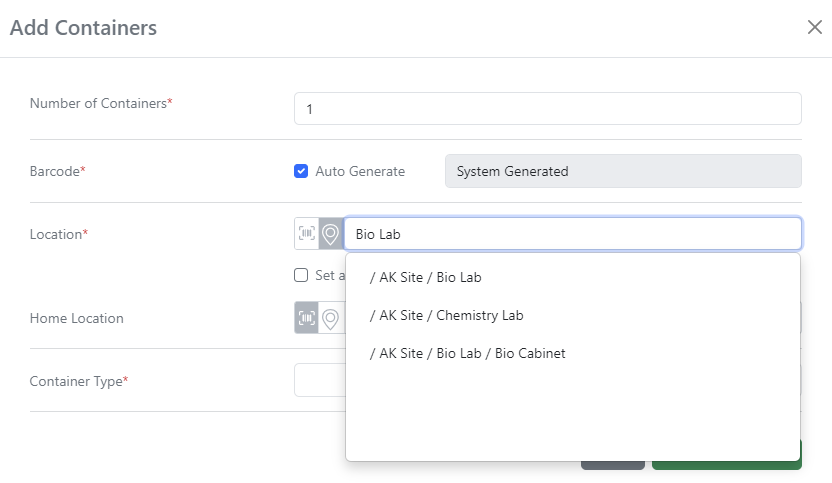
Update to Location Search is no longer alphabetized and instead will return the “best match” of the text entered without any additional filters:

Internal Request can be initiated from Experiments and Admin Defined Objects (ADO) by using the Internal Request option in the top right corner:
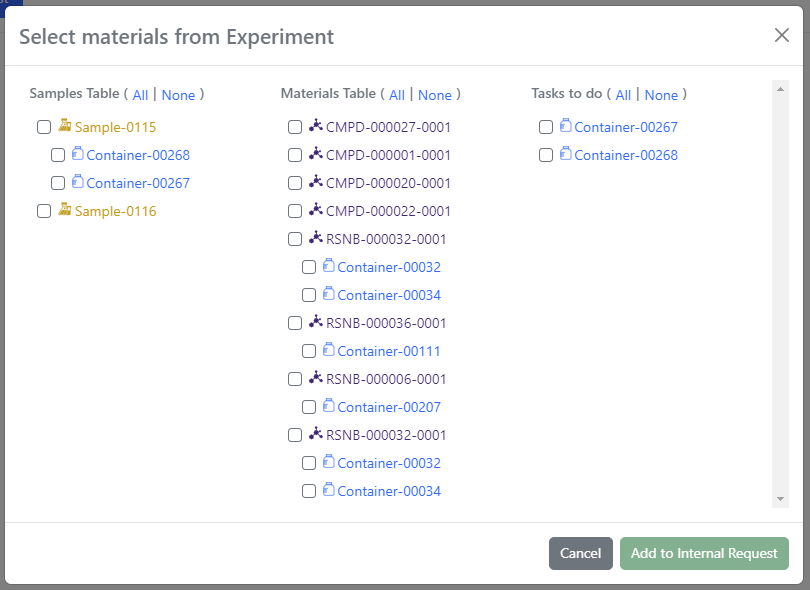
When creating an Internal Request, a modal will open with the Sample, Material and Containers that are in the Samples Table, Material Tables and Task to do Table in an experiment or ADO:
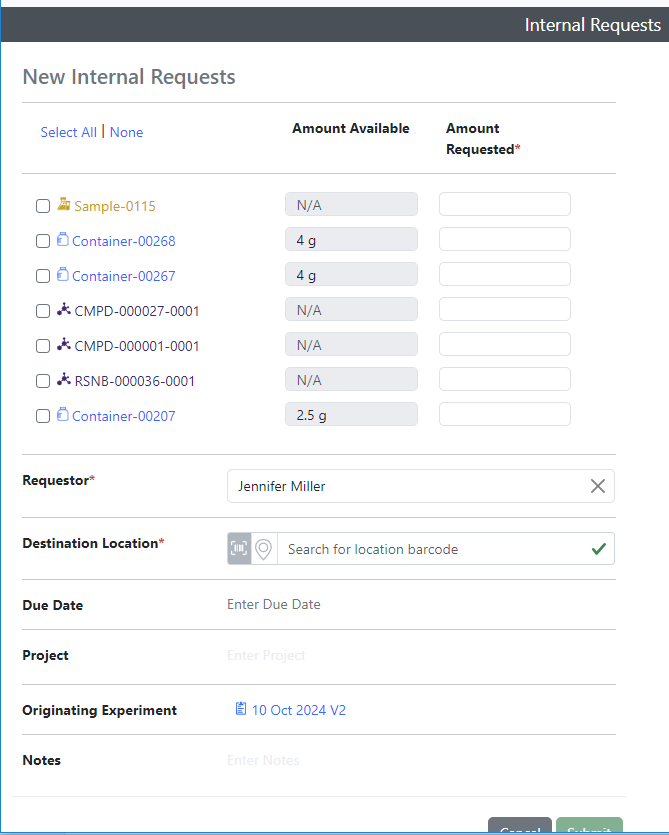
User should select the Sample, Material or Containers they would like to request and fill in the amount and location:
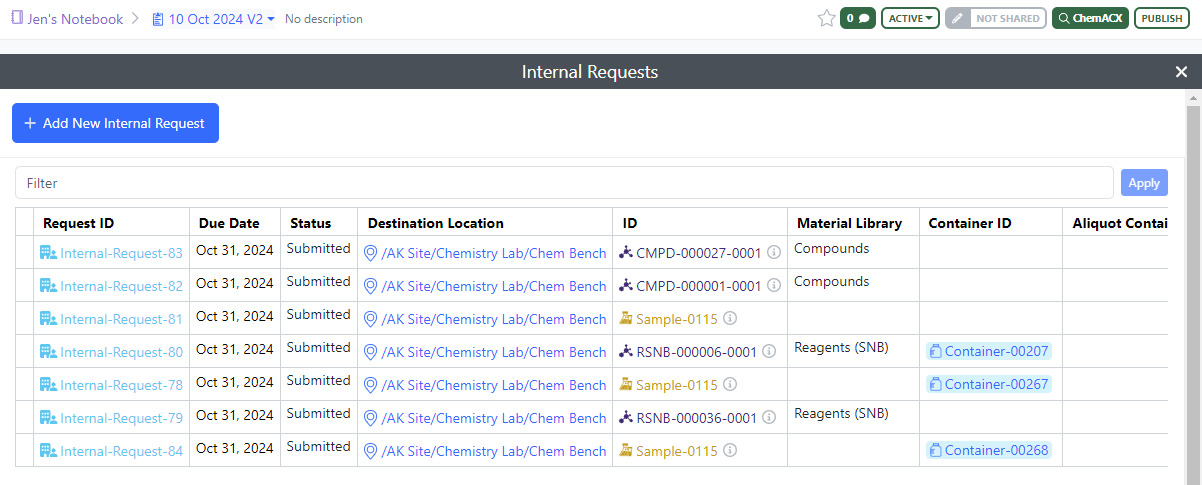
Additional Internal Requests can be made and users will see the status of the current Internal Requests:
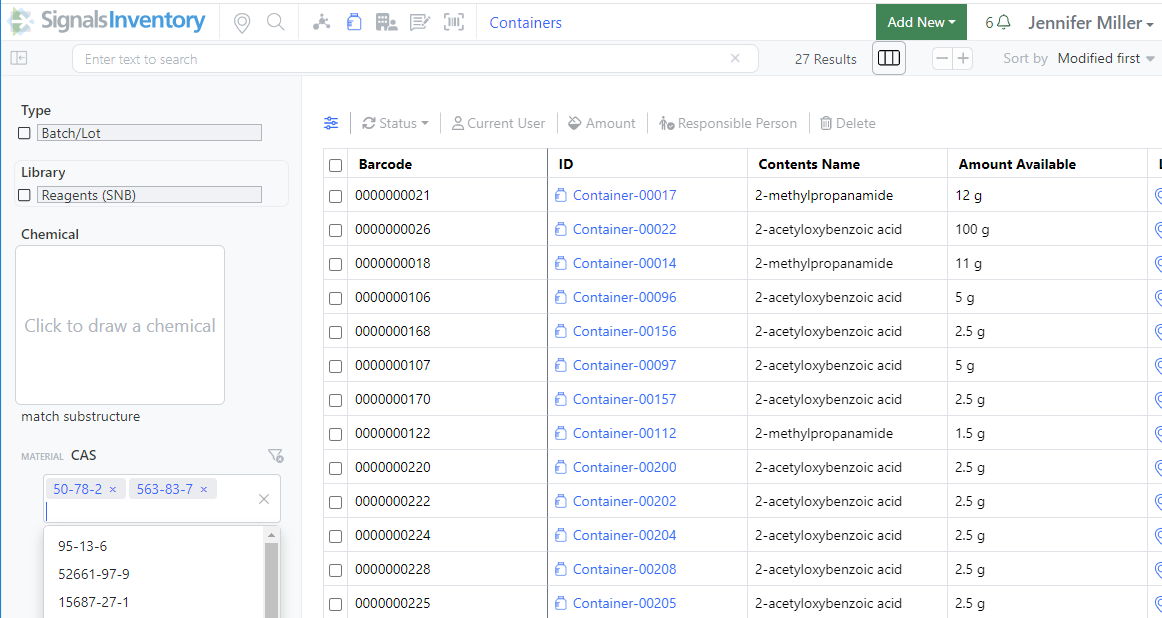
Search via CAS in Containers Search Table:
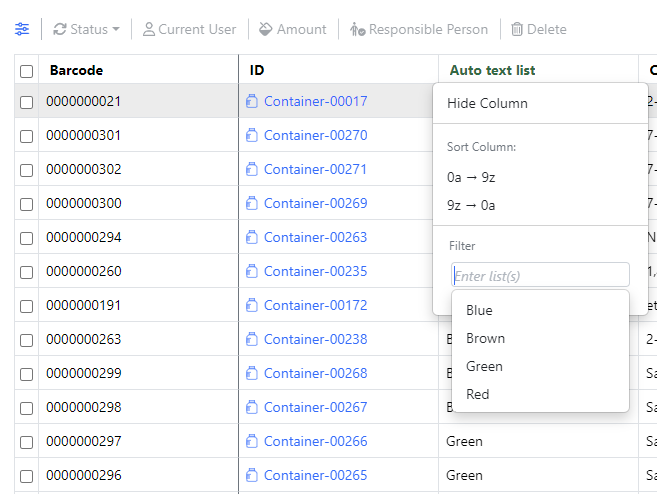
Filter by Autotext List in Containers Search Table:
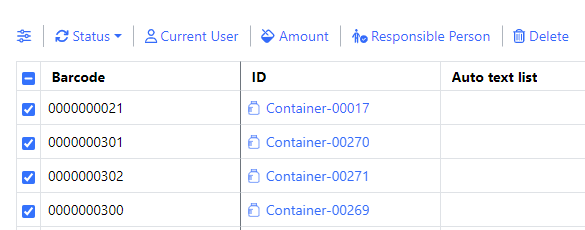
Bulk Update Responsible Person in Containers Search Table:
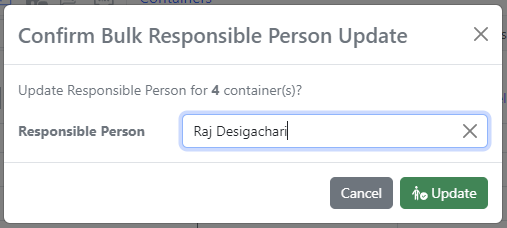
Select a current Signals Notebook user to be the new Responsible Person:

After the update, a report will be generated:
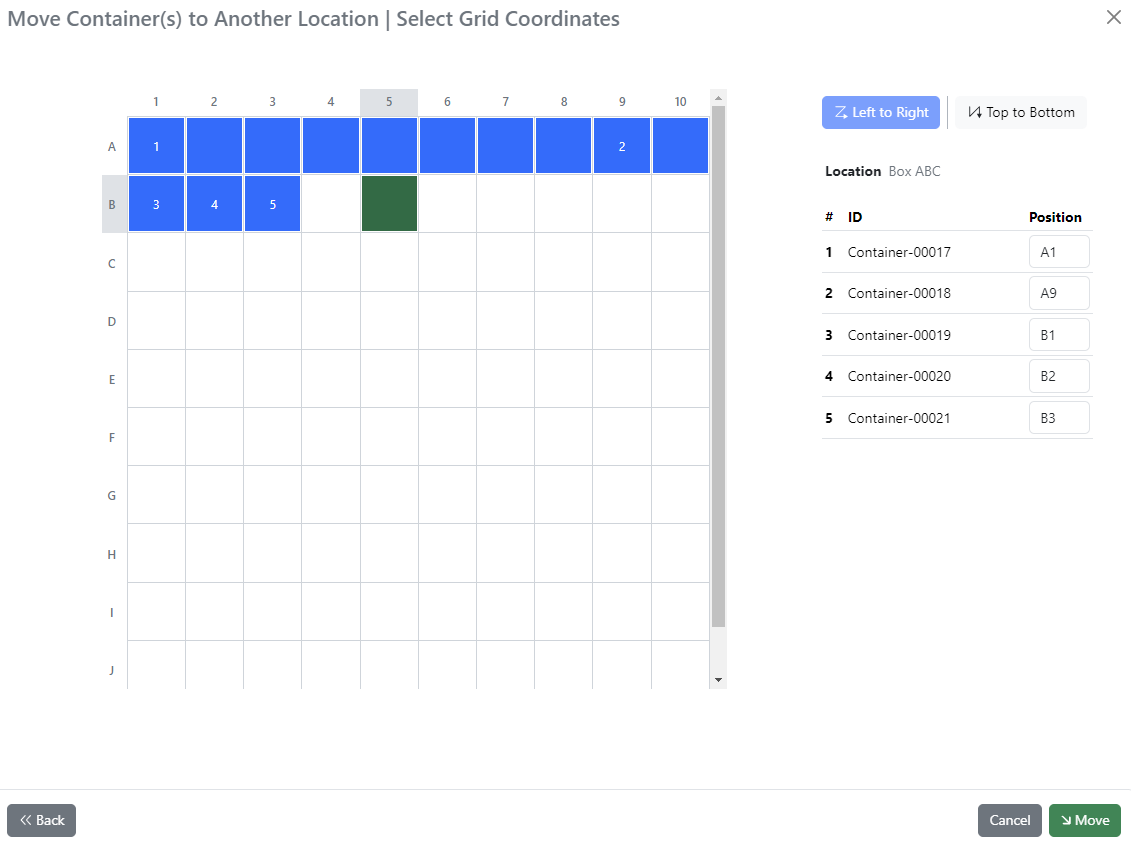
Autofill grid Locations If users have a series of containers that need to be placed in a gridded location, they can autofill the location with either a “Z” or “N” pattern. The Position column is available for any additional adjustments. The pattern will fill from Left to Right or from Top to Botton starting with A1 and will skip currently filled coordinates:
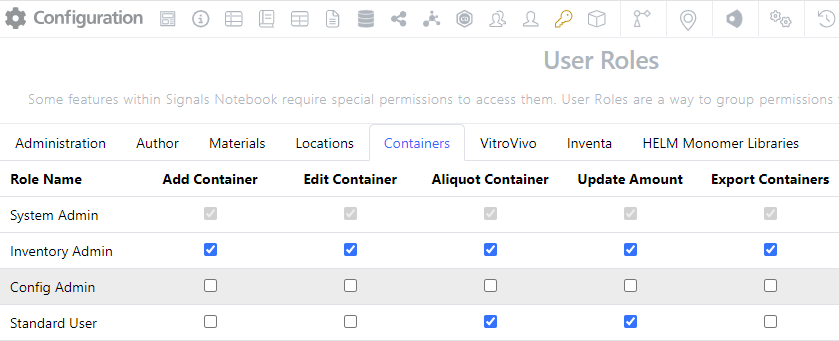
New Privilege that allows user to Aliquot Containers:
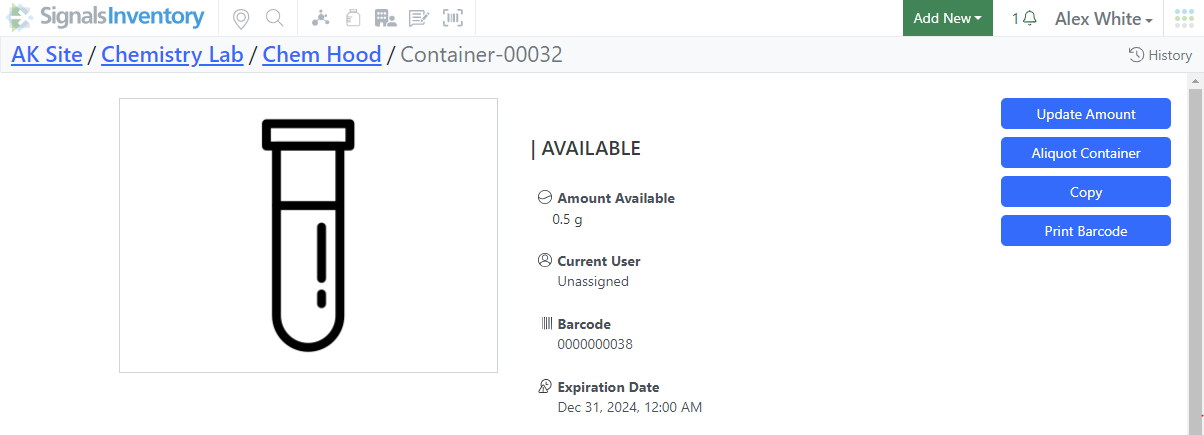
Users will need both the ability to Add Containers and the Aliquot Container to see the Aliquot Container button the Container Page:
Materials

Export batch/lots of material from the Batch/Lot page. Users with the privilege to Export Materials will also be able to export batches/lots:
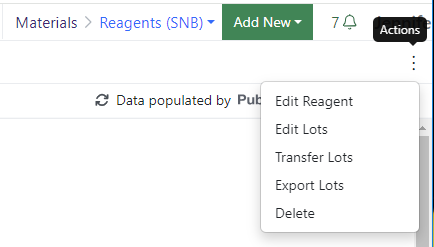
In the top right corner will be an Actions area where the Export Lots options will appear:
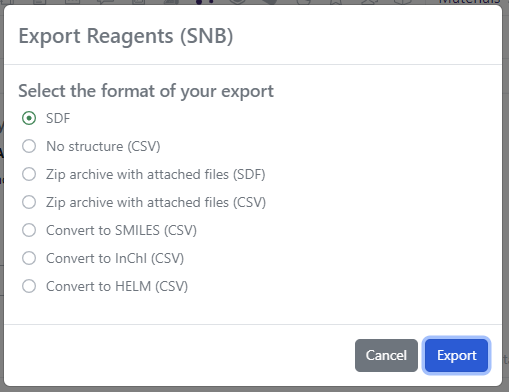
Users need to choose the format for the export:

The export may take a few minutes, when finished, the user will get a notification and a download option:

Administrator controlled refresh of calculated Material properties is now available to all systems. This feature re-runs calculated properties for chemical and protein Materials, including calculated chemical names. The setting is available under Advanced Settings on the Materials Configuration page. Once the process is complete, the last update and number of Materials updated will be displayed. At this point the Administrator can update additional Material types if desired.
Tasks and Requests
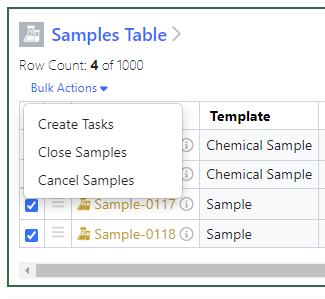
Bulk creation of tasks from the Samples table now provides Sample and Container Information:
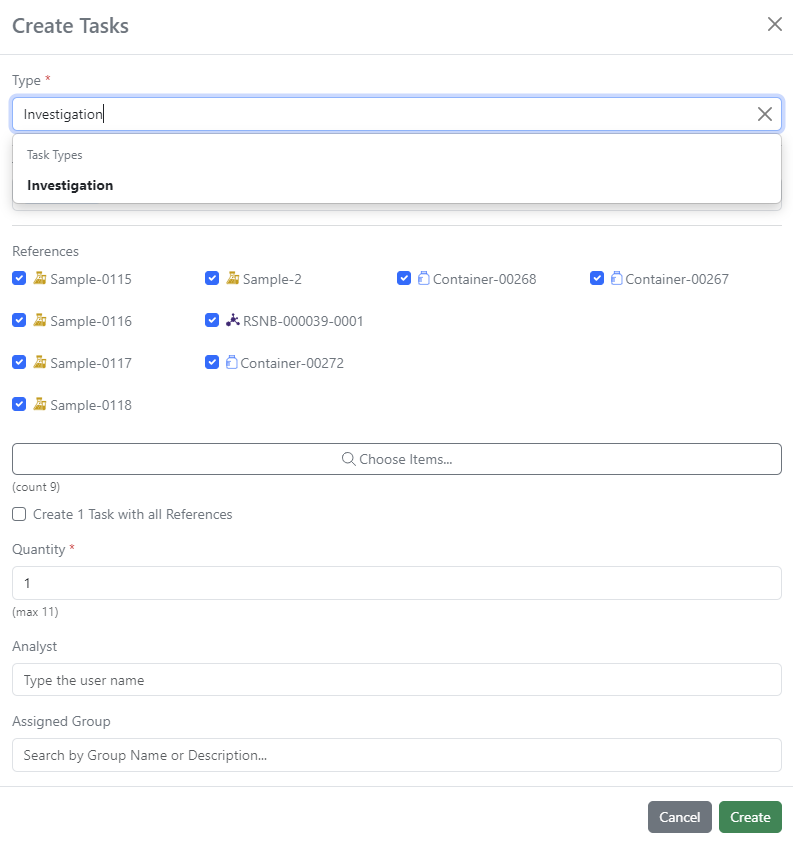
If the row has a reference to a Sample, Material ID, or Container, it will show in the row for the user to choose to associate with the Task:
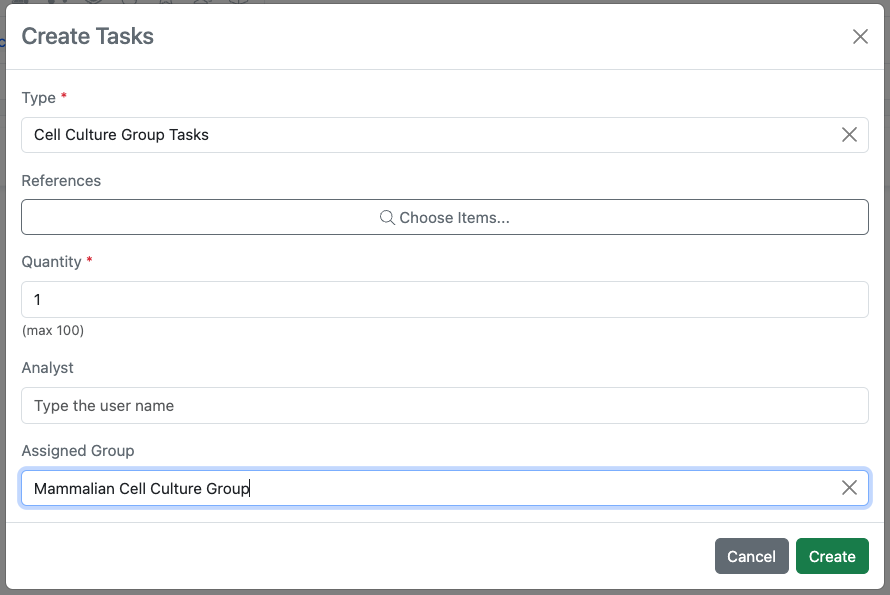
The option to assign Tasks to groups is now available to all systems. Groups can be assigned during or after creation of a task or tasks. Only a single group can be assigned to a given task. If enabled in their user settings, members of the assigned group will be notified of a Task Assignment.
Administration
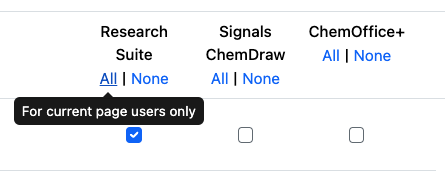
System Administrators can now make more easily bulk changes to users, managing Licenses, System Groups, Roles and Deactivation.
Licenses can be added or removed to all displayed users via an option in the license view.
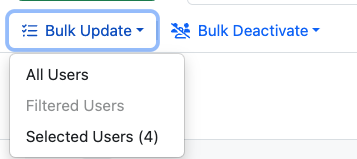
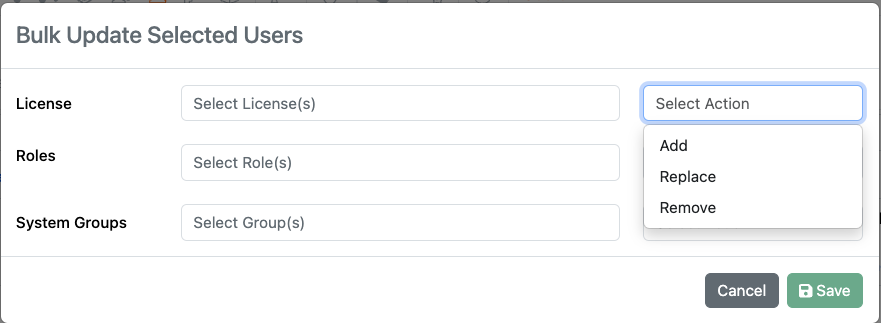
Users can also be selected and changes made to the selected users, either deactivation, or changes to Licenses, System Groups and/or Roles. Bulk changes can be made to add, remove or update to the selected Licenses, Roles and/or System groups.
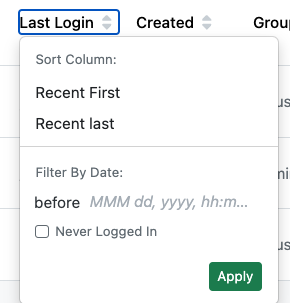
The System Admin can also sort by UserID, Last Login or Created, or filter to certain time ranges of Last LogIn or Created, to better narrow down on the users to select for bulk actions.
Integrations & APIs

The definition of “readOnly” an experiment type object (ie. Experiments, Parallel Experiments, ADOs, Requests, etc) has been updated to allow these properties to be updated by ExternalAPI but still be Read Only for users via the UI.
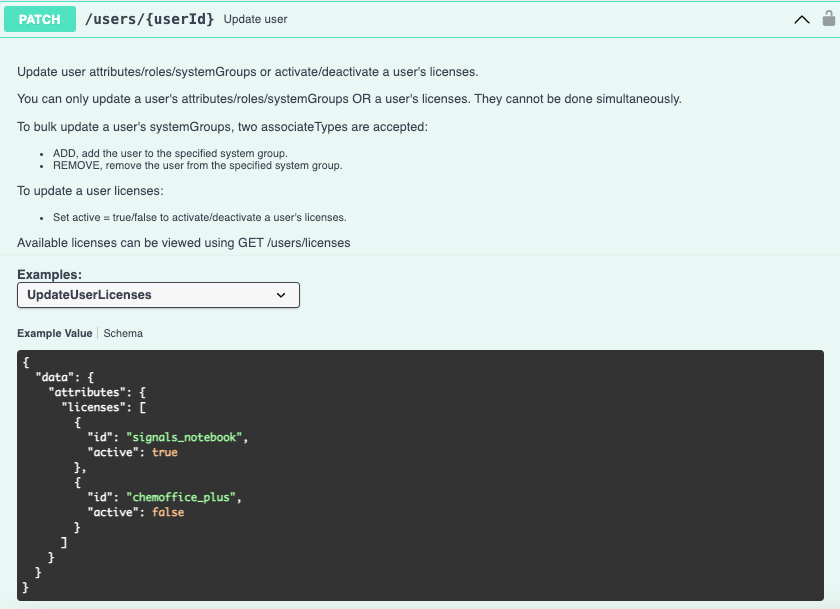
The Users endpoint PATCH /users/{userId} has been enhanced to allow activation/deactivation of a user’s license.
Note that you can only update a User’s attributes/roles/systemGroups OR their licenses, you cannot combine both operations in one API call.
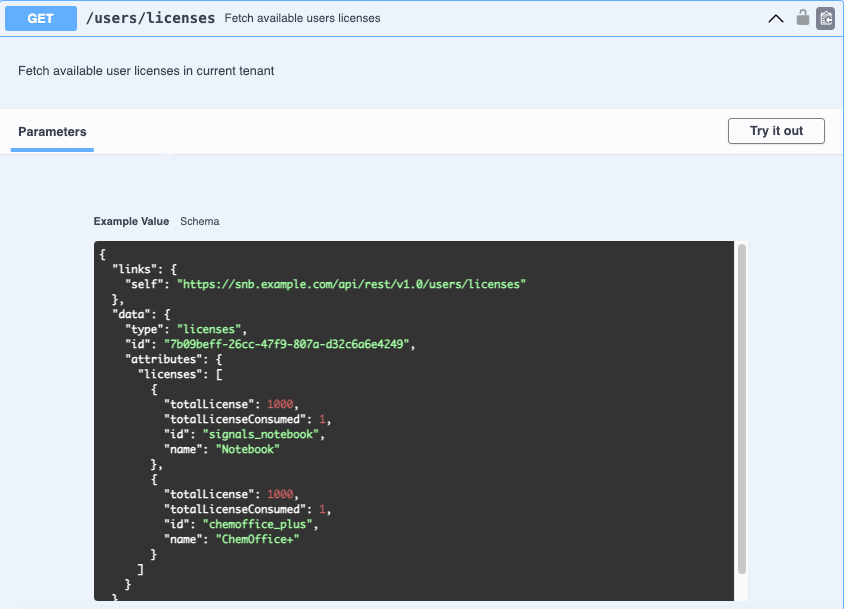
GET /users/licenses is a new endpoint for fetching your tenants’ licenses information and their id’s for use when updating users.
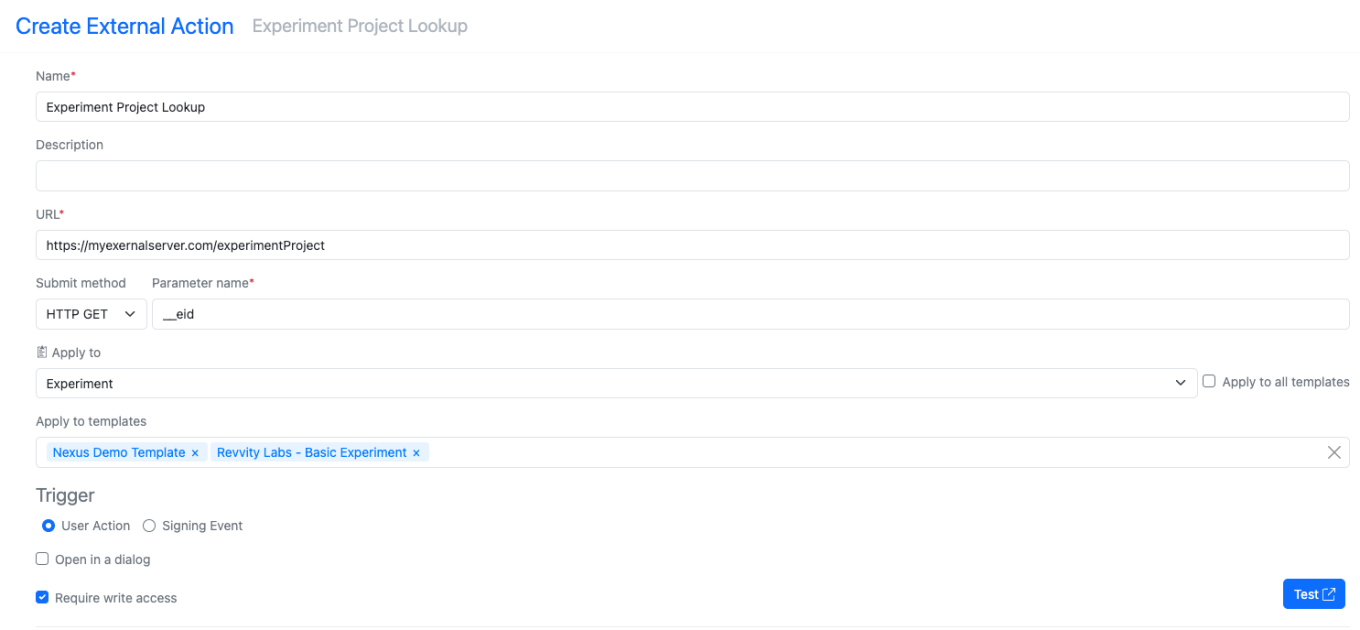
External actions are now able to be set to only specific templates, similar to Admin Defined Tables, for all Entities that use templates such as Experiments and Plates.
Note that any existing External Actions for these Entities are set to "Apply to all templates" to maintain current functionality.
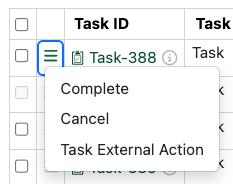
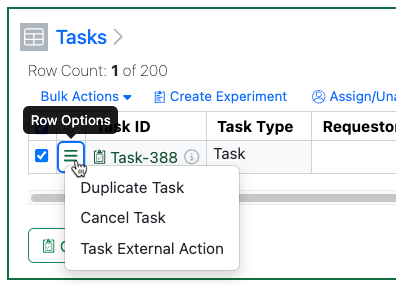
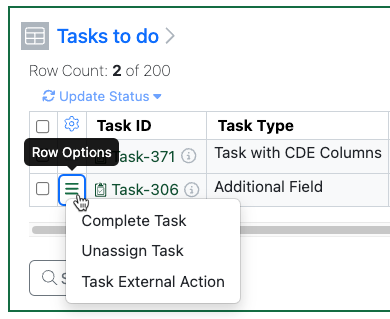
External actions are now able to be set to only specific templates, similar to Admin Defined Tables, for all Entities that use templates such as Experiments and Plates.
What's New
This version 24.8 release of Signals brings a full release of the integrated summary app in Signals Inventa along with a host of additional improvements. We have also fully released the ability to add monomers to custom HELM libraries. We have extended our Materials and Inventory capabilities including adding a Mixtures Library under a beta release. We have also released other beta capabilities around assigning Groups to Tasks, and publishing data from tables to Signals Inventa. We have also extended capabilities in Signals VitroVivo, Synergy and around the export of data in grid views. Finally, we have also fixed a number of small bugs.
The following improvements are available for users, administrators and developers on the Signals platform. Certain features may only be available with appropriate licensing and/or with enablement by an administrator.
• Fundamentals
– Export the grid view to CSV
• VitroVivo
– Simplified and more consistent user experience in the Calculations Explorer
– Remembering form information in the Study Designer App
– Enabling autosave of the dxp file after adding or deleting Treatment Groups
• Inventa
– New query and data summarization tool, the Integrated Summary App available to all systems
– Reorder material selection attributes in Integrated Summary App available to all systems
– Bio Sequence querying in Integrated Summary App available to all systems
– Reorder measurement selections in Integrated Summary available to all systems
– Quick Query mode in Integrated Summary App available to all systems
– Criteria Summary captures split summarizations in Integrated Summary App available to all systems
– Integrated Summary App now supports multiple structures Quick Query mode available to all systems
– Additional options to split summarization in the Integrated Summary App (ISA), including defining layout and specifying relevant experimental factors or attributes.
– Option to run ISA query with only material criteria
– Perform bulk selection on measurement attributes in ISA
– Publish Measurement App is now compatible with measurement types designed for ISA
– Preview biological sequences in the ISA Quick Query
– Reorder SAR Analysis columns based on column groups
– Shortcut to summarization methods and create new tags directly from a Measurement Type
– Material Sync now supports synonyms
• Synergy
– Bulk Import of Designs from SDF or CSV files
– Configuration Transfer for Synergy Data Exchange Transformations and Designs and Reference Table settings
• Chemistry
– Add new monomer to custom HELM libraries available to all systems
– BILN support for peptides
– HELM hotkeys for editing biopolymers
• Admin Defined Tables & Variation Tables
– Calculations on properties of type Number with Unit
– Publish Admin Defined Tables to Inventa (beta)
• Samples
– Read Only Sample Properties
• Inventory
– Internal Request of Materials with Aliquot available to all systems
– Bulk actions from the Container Search Table: Update Current User
– Update to the Inventory Bulk Report page
– Scan or paste list of barcodes into the Container Search Table
– User Notifications
• Materials
– Show More on batch/lot page
– Refresh of calculated material properties (beta)
– Improved reporting for Bulk Import tasks
– Increased file size limits for Bulk Import/Update tasks
– Mixtures library (beta)
• Tasks and Requests
– Assignment of Tasks to Groups (beta)
• ELN Archive
– BioAssay/Structured Data content
• Integrations & APIs
– External Notifications for Task Status changes
– External Notifications for Material edit, transfer, and delete
– API Endpoints for Material Bulk Update
– API Endpoints for Normalized Compound Registration
– SDF APIs for creating, retrieving, and modifying SDF measurement types
Administrators should be aware that the dependency between Inventa Analysis privileges has changed, and they may need to update their User Roles accordingly. All users with “Create Analysis” must also have “Edit Analysis” privileges, and all users with “Trash Analysis” must also have “Edit Analysis” privileges.
Administrators should be aware that attribute names are now available alongside the attribute ID in the SDF audit log.
Administrators are recommended to subscribe to the channels within our support news site found at https://support.revvitysignals.com/hc/en-us/categories/360004446171-Support-News which contains more information about releases and other pertinent product information.
This content is anticipated for release on our Production E3 environments, and for Private Cloud customers on our deferred release schedule, in March 2025.
Further Details
The following improvements are available for users, administrators and developers on the Signals platform. Certain features may only be available with appropriate licensing and/or with enablement by an administrator.
Fundamentals
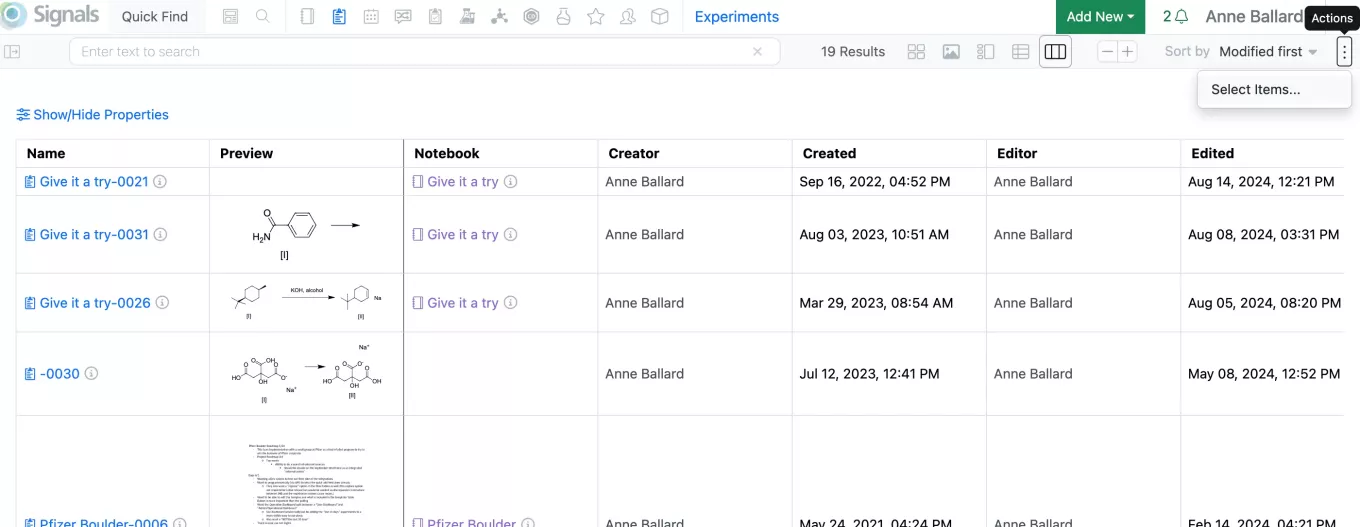
Users are now able to export their grid view searches in Smartfolders to csv. To export the search list to csv, a user should enter selection mode by clicking “Select Items” from the Actions menu.
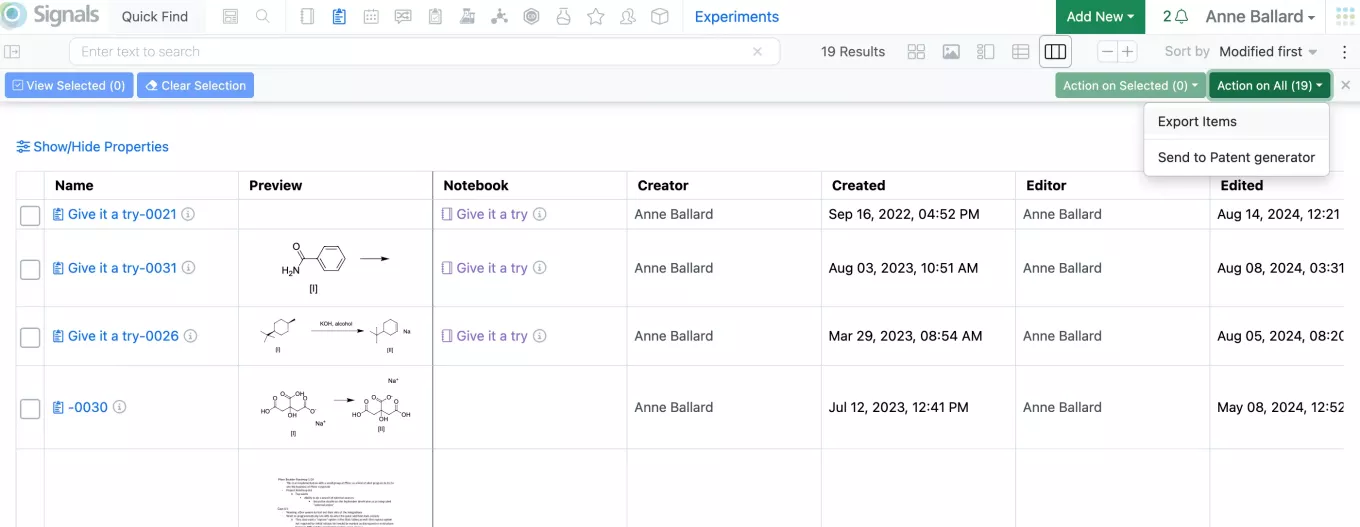
The user can then select items or pick “Export Items” from the Action on All option to generate a csv export.

Once the export is complete, a bulk report is also available.
VitroVivo
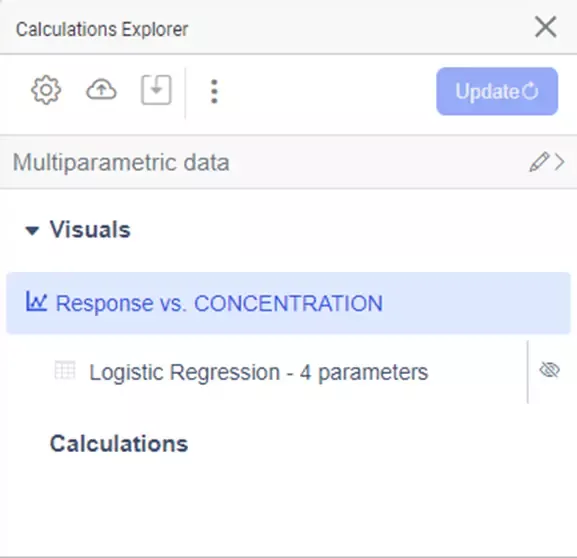
The Calculations Explorer main panel now shows two simple and clearly identified groups for the visualizations and the calculations. Visualizations can be switched on or off using the eye icon and the formulas of the calculations are presented in the Details tab of the right panel.

The Calculations Explorer right panel has been updated at the level of the QA tab, which now contains clearly identified sections for manual or automated QA. Moreover, the information in the Details panel is now strictly read-only.
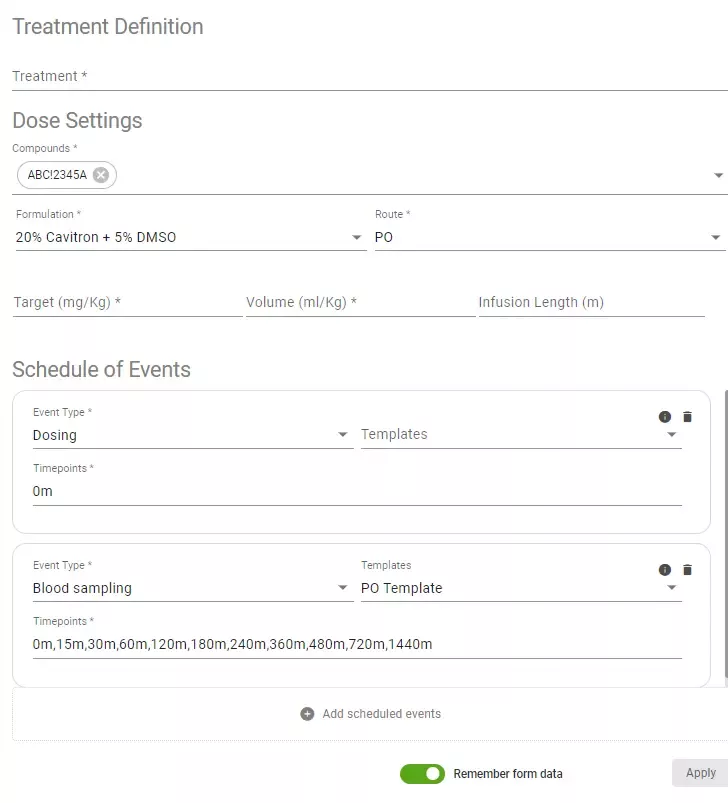
The Study Designer app now has a new feature, "Remember Form Data," that allows users to preserve form data by enabling a toggle switch. Once activated, this feature automatically retains the information entered in any form, thereby reducing the need for repetitive data entry. This functionality extends to all key forms within the Study Designer, including cohort definition, treatment definition, and treatment group definition forms.
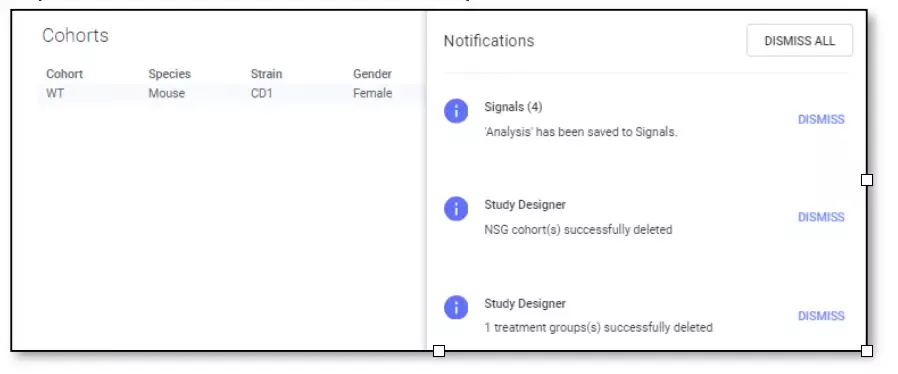
Autosave is now enabled in the Study Designer app, ensuring that any added or deleted information is automatically saved if the application is closed without manual saving. This feature helps maintain data consistency and prevents the loss of data after an unexpected shutdown.
Inventa
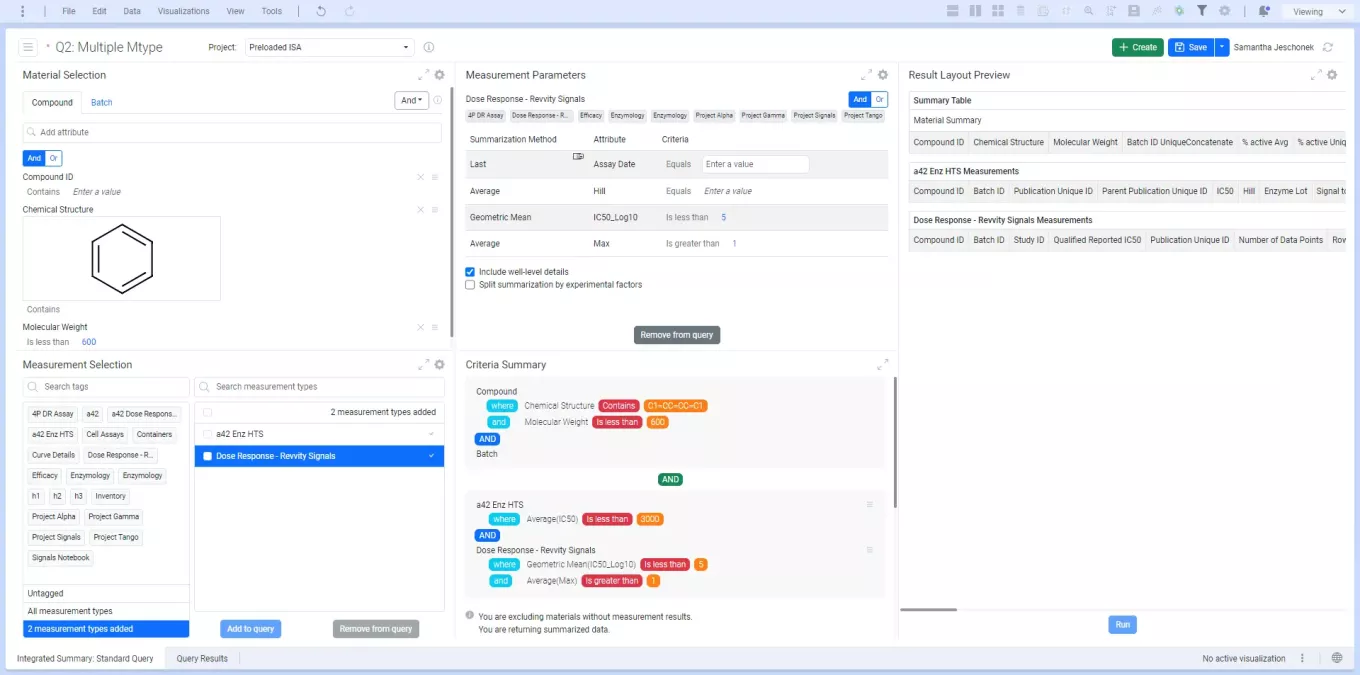
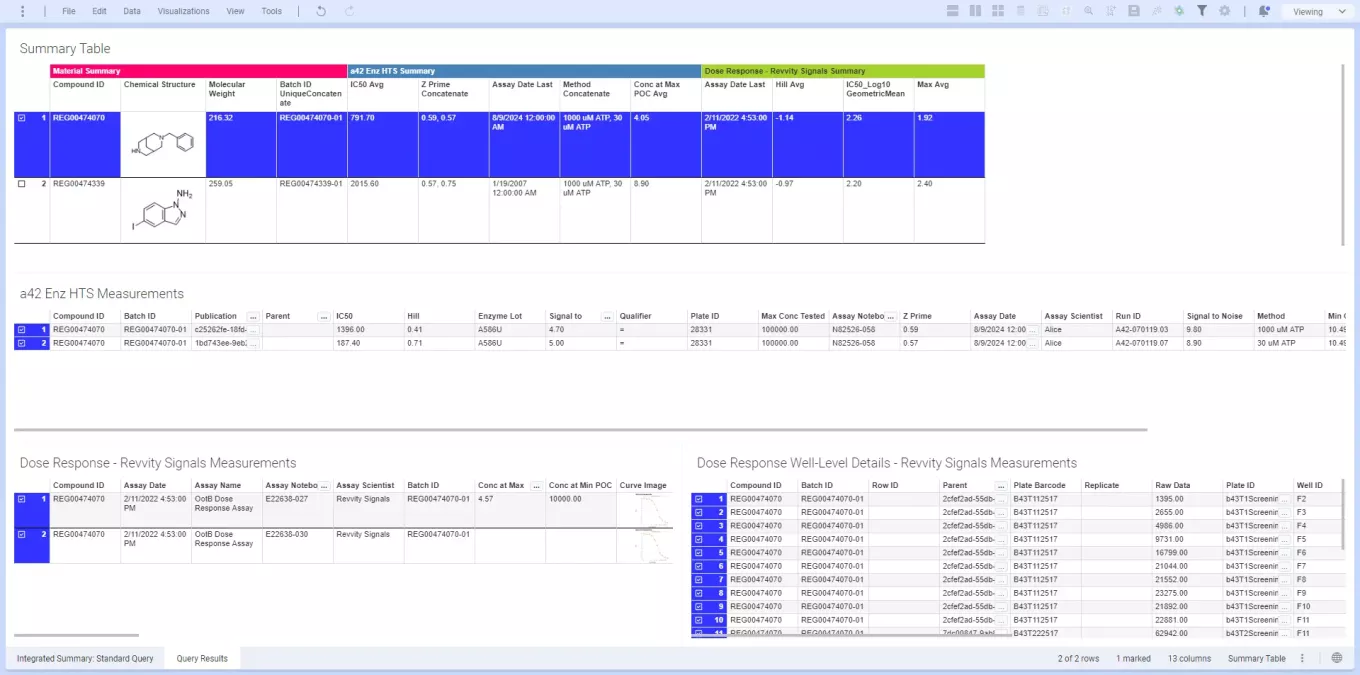

The Integrated Summary App (ISA) offers a new query and data summarization experience. All previous ISA capabilities are now available to all systems. ISA is an alternative to the Global Search + SAR Analysis Apps. The Standard Query mode uses admin-defined settings to create a more streamline, templated search experience and allows for aggregation of any attribute (not just endpoints). The Quick Query mode returns all known information about a particular entity or measurement type with a single click.
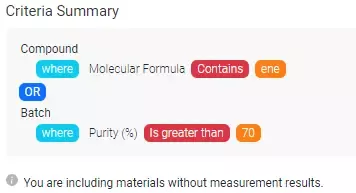
Users can now run an ISA Standard Query using only material criteria
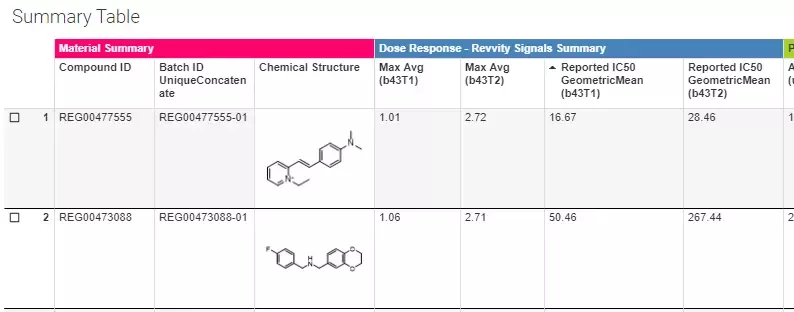
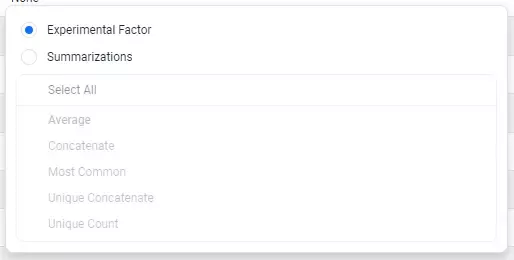
Users can specify which experimental factors are used to split aggregations. They can also specify whether the split aggregations be organized as columns instead of rows.
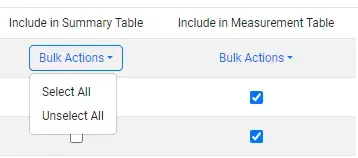
When defining measurement parameters, users can now take advantage of bulk attribute selection.
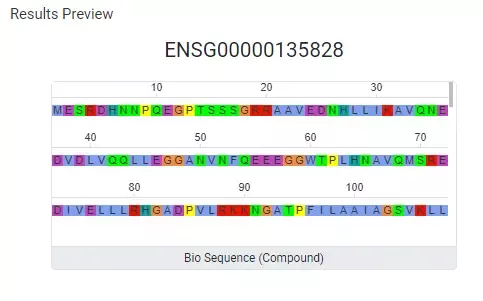
Quick Query mode now supports previews of sequences
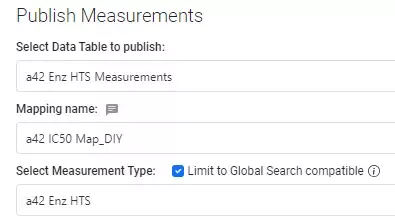
The Publish Measurement App is now compatible with measurement types designed for either Global Search or the Integrated Summary App
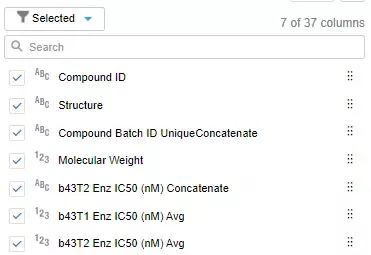

In the SAR Analysis App, columns can now be reordered into different ChemCharts column groups.

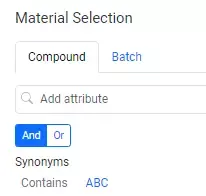
Material Sync now supports synonyms
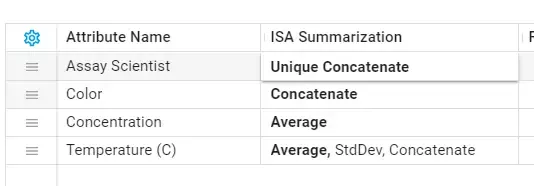
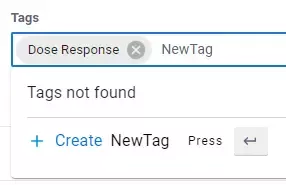
For Data Factory administrators, shortcuts within a Measurement Type Definition page allow admins to quickly update attributes or create new tags.
Synergy

In Synergy, users can now bulk import Designs from SDF and CSV files with SMILES or InChl structure info (UTF8 encoding). On a Designs Table, select Import Designs.
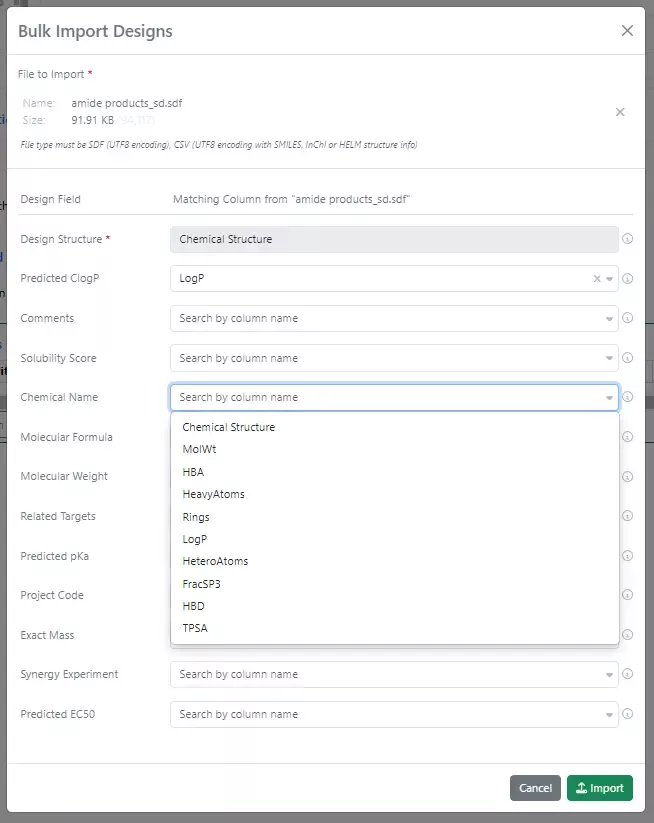
The user can then upload an SDF or CSV file and map the columns to the Design fields.
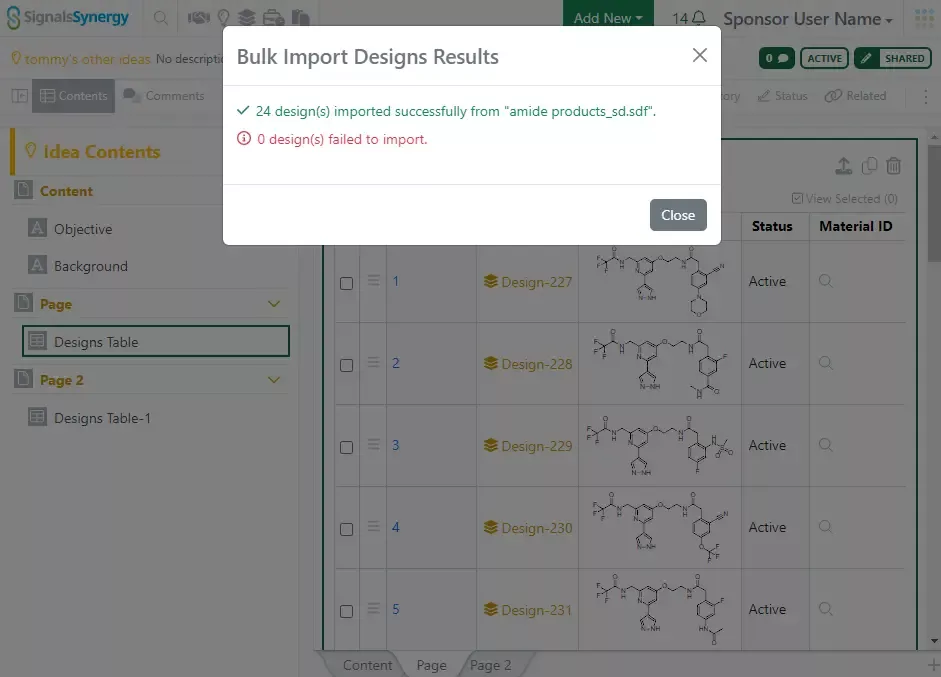
When import completes, the user can view the results, including the number of successful and/or failed designs, in the modal. Designs will be added to the Designs Table and the Designs Smart Folder.
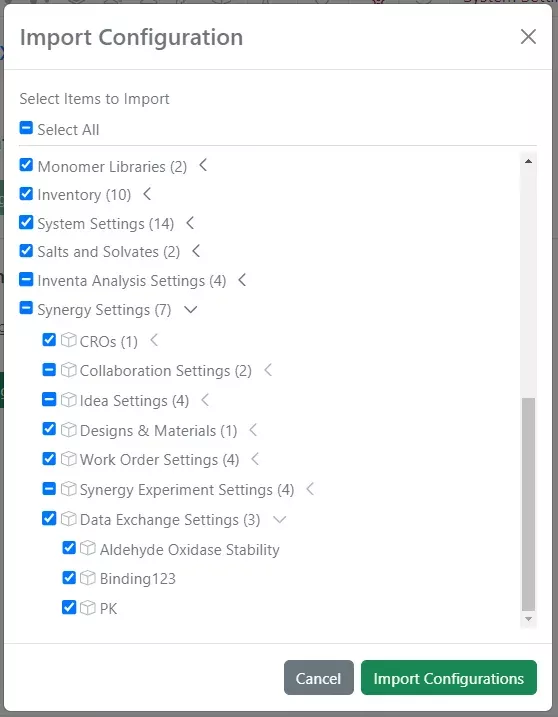
On the administrative side, Transformations from the Synergy Data Exchange Library, as well Designs and Reference Table definitions, can now be transferred from one tenant to another using Configuration Transfer in Signals Configuration. After uploading a Configuration File, available Data Exchange Transformations from the source tenant Data Exchange Library will be shown under Synergy Settings > Data Exchange Settings. Selecting a Transformation will transfer the Details, Examples, Attachments, and other configuration settings for that Transformation. In addition, under Synergy Settings > Designs & Materials, selecting a Material Type will transfer the Design Definition, Designs Table settings, and Reference Table settings for Designs, Material Assets, and Material Batches for the selected Material Type. (Note that the Material Record Definition, Material Table settings, and other non-Synergy settings for the Material Type will not be impacted by this selection. Those settings can be transferred by selecting the Material Type under the general Materials section above the Synergy Settings.)
Chemistry
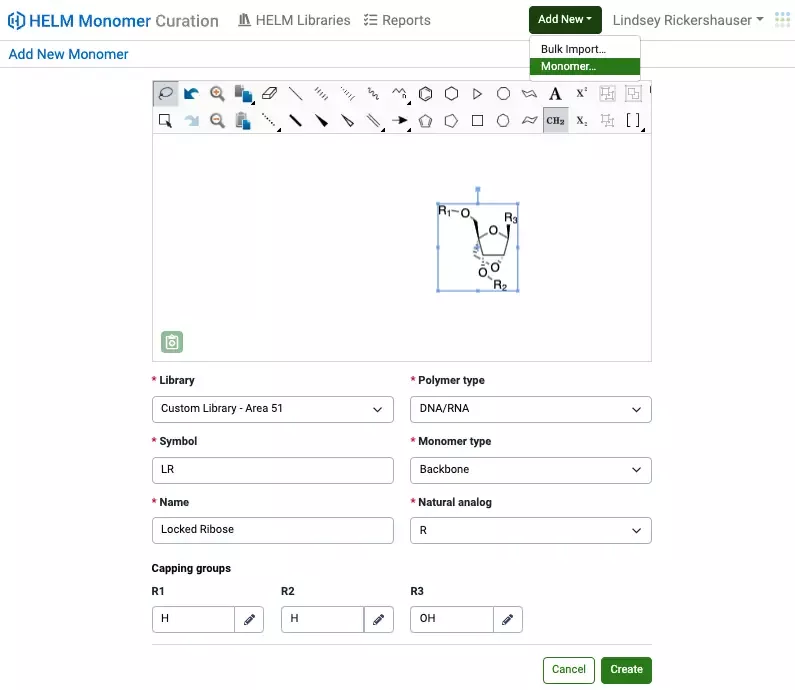
Adding a single monomer at a time to a custom monomer library in the HELM Monomer Curation (HMC) application, previously available in beta, is now available to all systems. Monomer structures can be drawn and edited directly within HMC, and all monomer properties defined in the ‘Add New Monomer’ form.
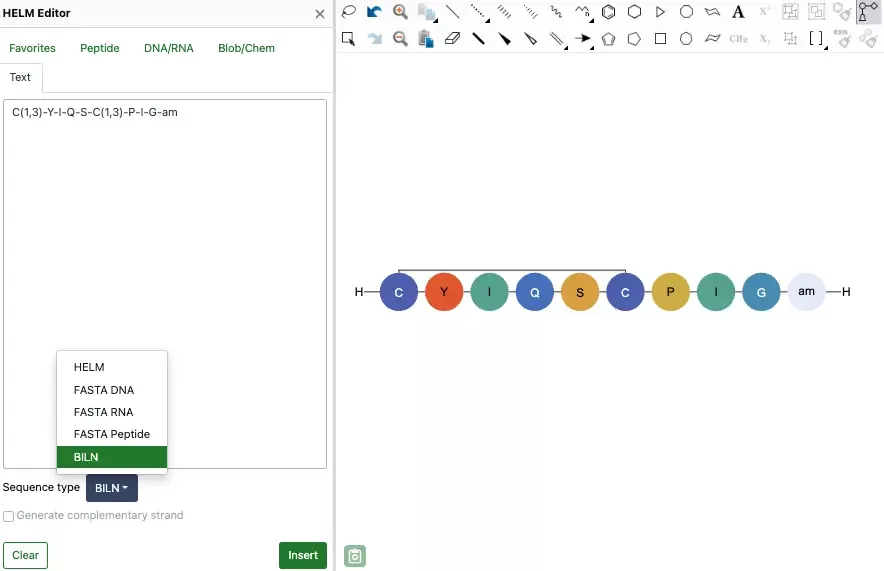
BILN format, a human readable line notation for complex peptides, is now supported. Users can create complex peptides by pasting a BILN string to the ChemDraw canvas or by inserting a BILN string using the text tab in the HELM editor. Additionally, ‘Copy As’ support has also been added allowing users to generate a BILN string from a peptide sequence drawn on the canvas.
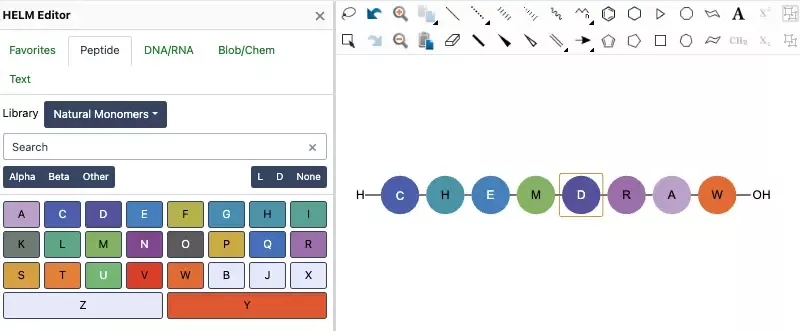
Hotkeys are now supported when using the HELM editor. When editing a sequence on the canvas, any monomer from the selected monomer library with a single-letter symbol can be inserted by pressing the corresponding key on the keyboard. Similarly, any selected monomer while in HELM edit mode can be replaced by pressing a valid single-letter monomer from the selected library. For example, when the 'Peptide' tab is active in the HELM Editor and the 'Natural Monomers' library is selected, pressing 'a' will either insert monomer A (Alanine) or replace existing monomer with A (Alanine). HELM hotkey support is available in the Peptide, DNA/RNA and Blob/Chem tabs of the HELM editor.
Admin Defined Tables & Variation Tables
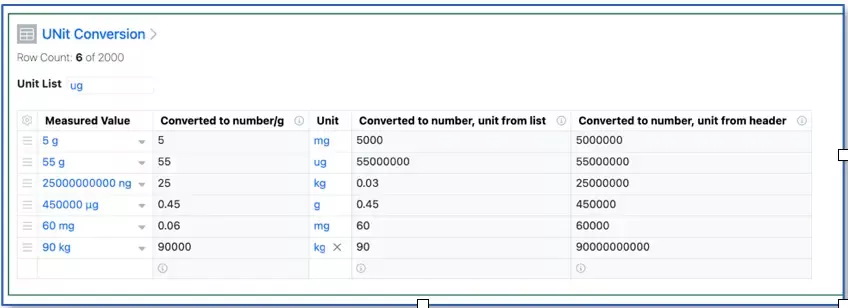
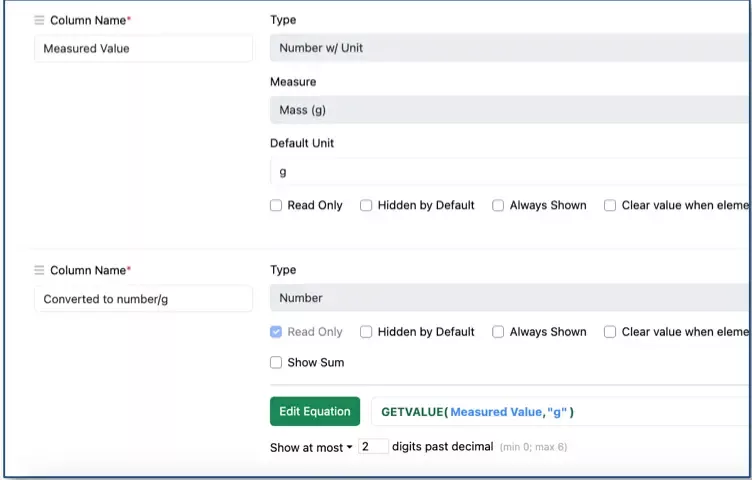
Configuration admins can now define new calculations incorporating properties of type Number With Unit. The function GETVALUE allows for the conversion of a Number with Unit into a Number which can be used in subsequent calculations. The function has two arguments. The first argument is used to identify the property of type Number with Unit. The second argument is used to identify the unit used for the conversion.
Samples
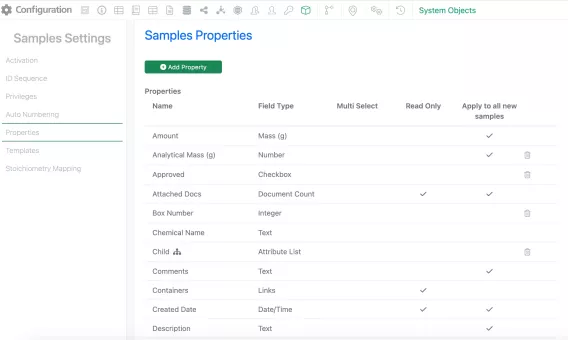
Admins can now make properties Read-Only for users in the UI. It is important to note that these Read-Only properties can still be updated systematically via the APIs. Under Sample Settings a new option is available.
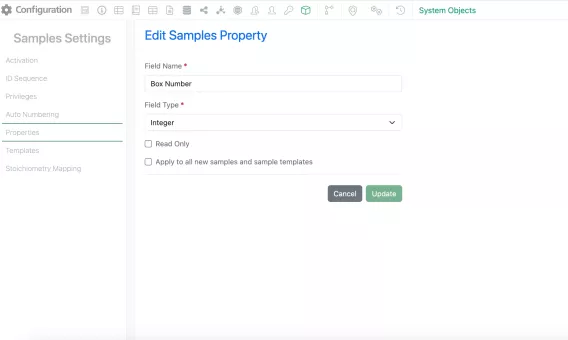
Admins can simply select the Read Only Option on a property. For existing properties, the Read Only selection would make that property Read Only for all live samples.
Inventory
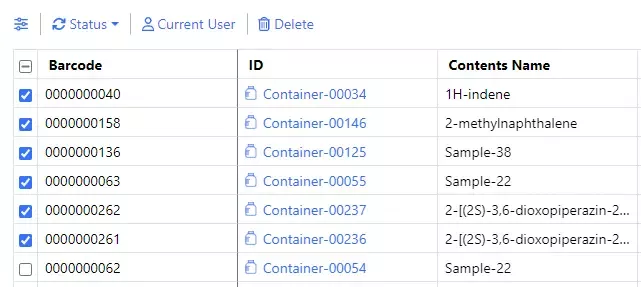
The Internal Request of Materials with Aliquot is now available to all systems.
We have added Update Current User to the Bulk actions from the Container Search Table.
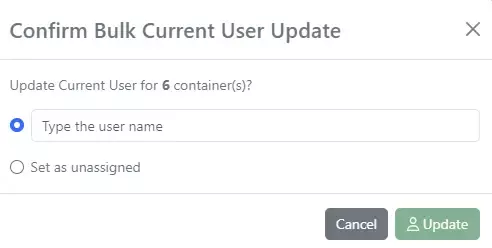
When updating the Current User, the name of a Signals Notebook user can be typed in or set to unassigned:

Once completed, a report will be created:
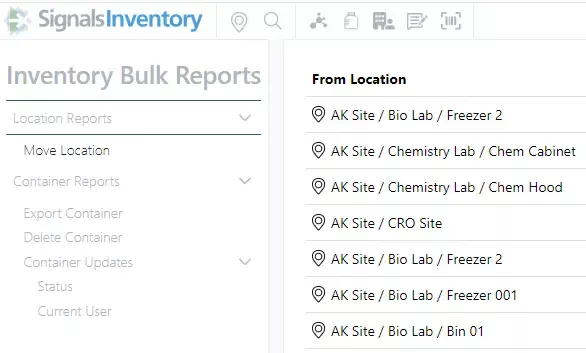
The Inventory Bulk Report page has been updated to show the reports on the left side panel instead of across the top of the screen to make room for more bulk actions.
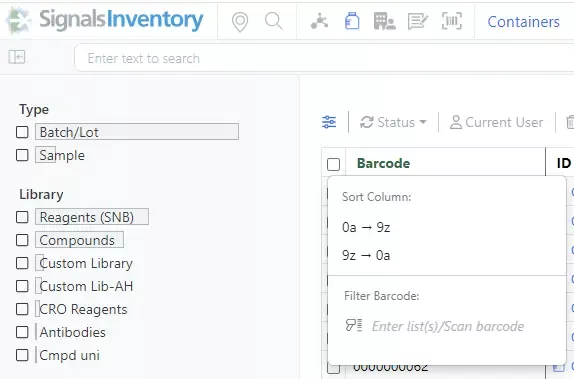
You can Scan or paste list of barcodes into the Container Search Table.
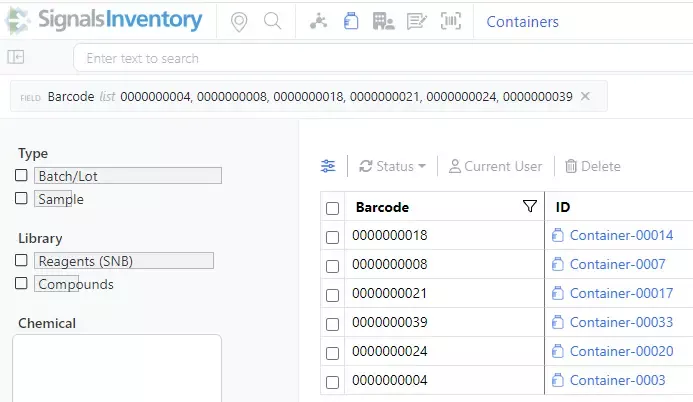
The search will update to return results on the specified barcodes.

User Notifications for Inventory can be found in the User Settings/Notifications/Inventory.
Materials
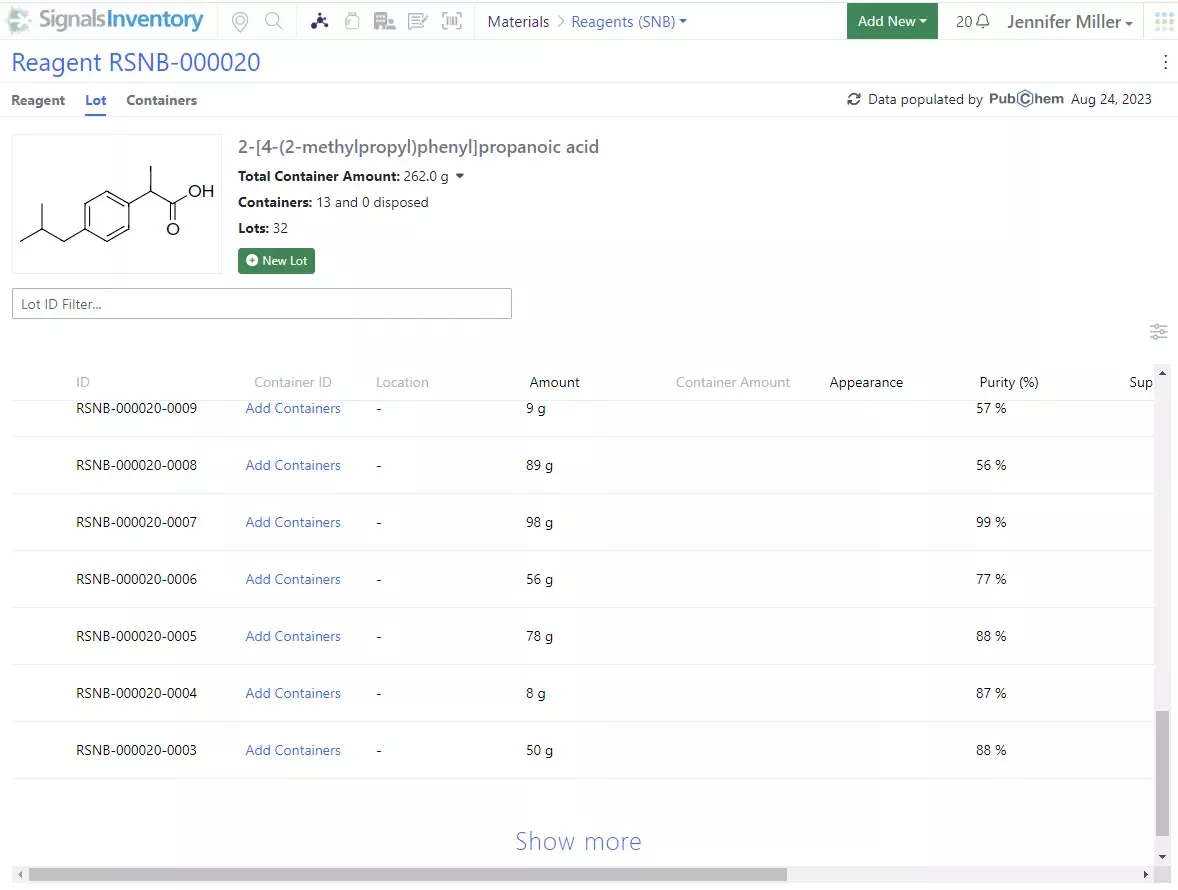
When there are more than 30 batches/lots a Show More option will appear at the bottom of the screen so that the additional batches/lots may be displayed.
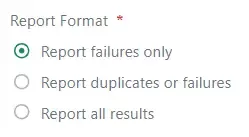
Three options are now provided for materials library Bulk Import reports – one containing information only for registration failures, one for failures and/or duplicates, and one containing information for all outcomes. A new ID column in the report now contains the Material ID for items successfully registered to the library. For duplicates identified during a bulk import, a Duplicate ID column references the registered material ID that was considered a match.

Bulk import and bulk update tasks now allow for a file with maximum size of 300MB.
ELN Archive
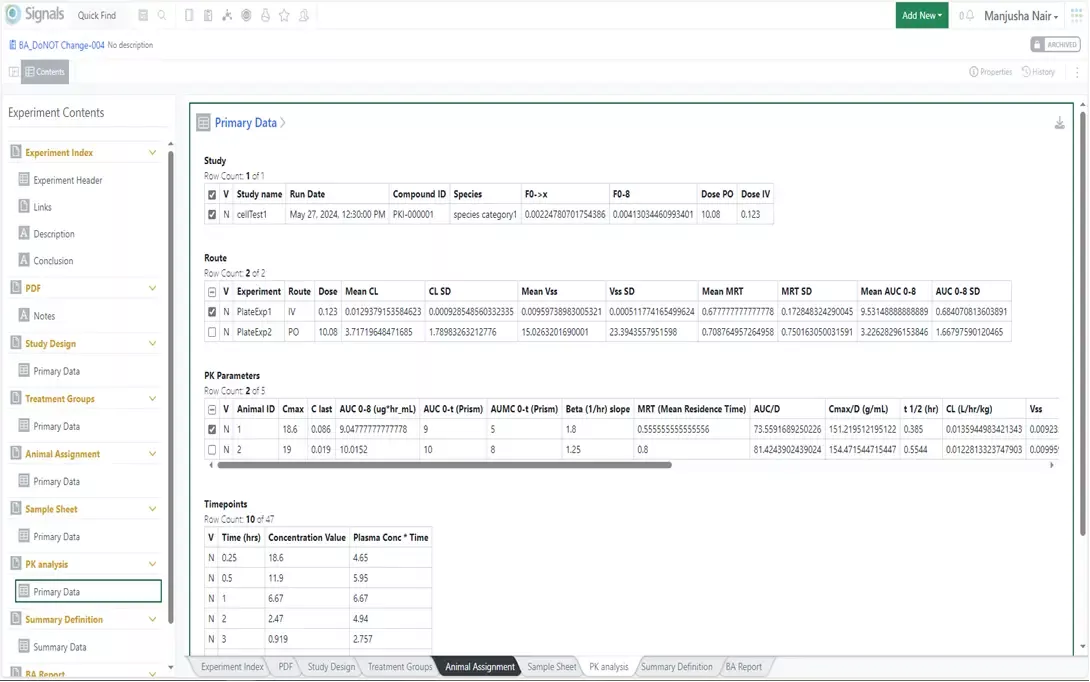
The ELN Archive is a capability to import data from E-Notebook as archived content within Signals Notebook. Note that ELN archive required additional licensing and setup. The following enhancements require data extraction from E-Notebook using EN Data 2.8.
BioAssay/Structured Data is an application that helps biologist store, analyze and create reports on biological assay data. BioAssay/Structured Data is optimized for handling data related to high throughput screening. However, it can be effectively used to manage data related to low throughput and in vivo studies. Bioassay data in E-Notebook can now be fully displayed in the ELN Archive, and the original content downloaded as .csv.
Integrations & APIs
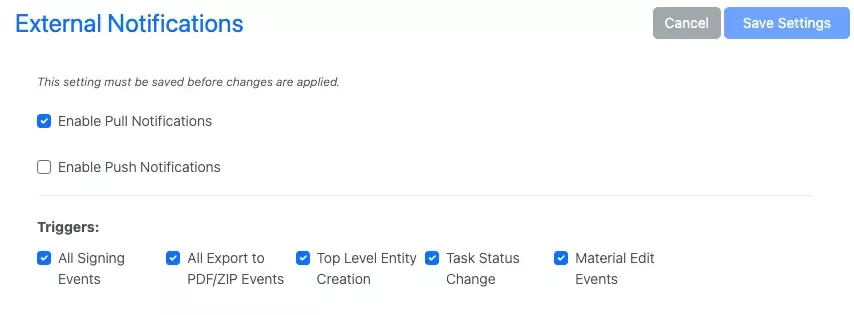
This update brings two new External Notification triggers, Task status changes and Material edit/transfer/delete.
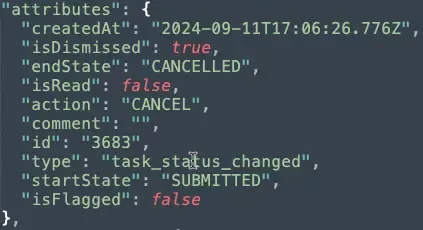
For Task status changes you will see the “startState” and “endState” in the “properties” object.
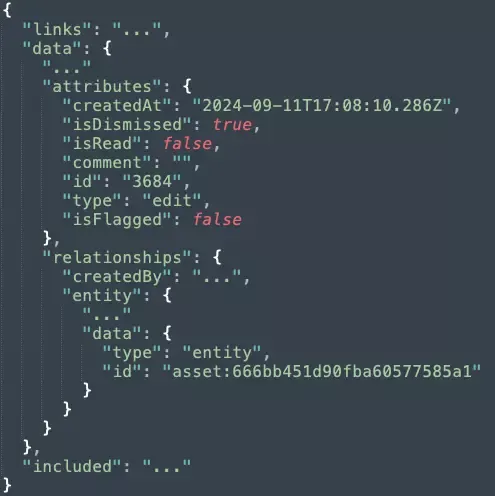
For edits or deletes to Assets or Batches you will see a “type” of “edit” or “trash” respectively. The “included” object will include the entity.
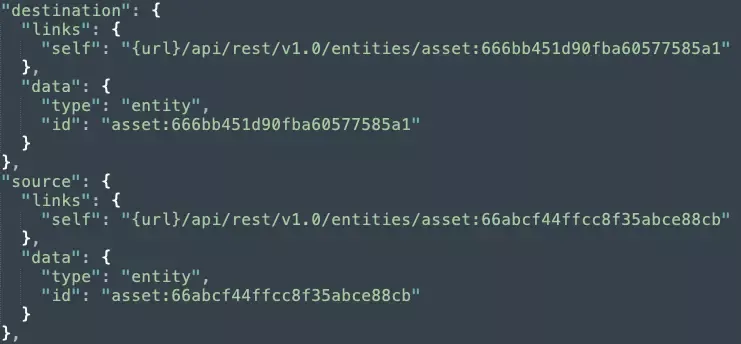
Batch transfer notifications will be of type “move” and will include the source asset and destination asset in the “included” object.

New endpoints to mimic the Bulk Update functionality of the UI have been added.

This is an asynchronous API which is started with “POST /materials/{libraryName}/bulkUpdate”. This API supports update data in a ZIP file. The ZIP file should contain a summary SDF file or CSV file and attachments.
The response from the POST will contain a jobId for checking, delete, and viewing failures of a bulk update job.
An API to download an example ZIP has also been added.
The bulkImport API for materials has been enhanced to handle Normalized Compounds.

A new rule is available as a parameter:
“USE_ASSET_AND_BATCH_MATCHES”
Using this rule the server will check the item with uniqueness check, if duplicated will imported as new batch with existing batch type of an existing asset.
This update includes APIs for managing measurement types in Signals Data Factory.
The APIs are used to fetch existing measurement types, create new ones, fetch details of a specific measurement type, and update an existing measurement type.
The following capabilities are in beta and are available for users, administrators and developers on the Signals platform upon request. Please contact your account representative or our support team if you would like access to the following features.
Admin Defined Tables & Variation Tables
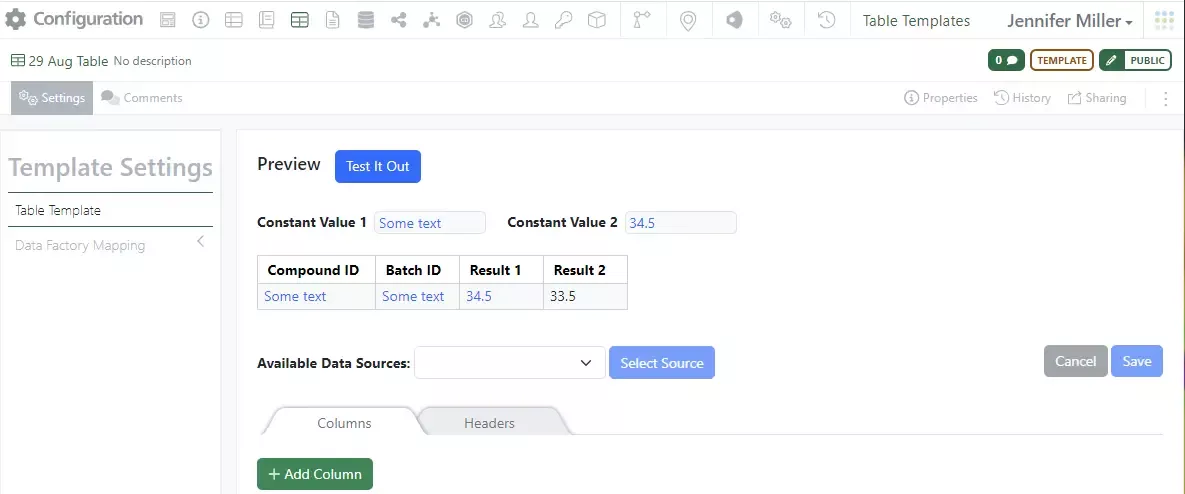
Users can publish data from Signals Notebook experiments to Inventa. To enable the data push there is administrative set up that will need to be done for both Inventa and Signals Notebook. Prerequisites for Inventa are a Project and defined Measurement Type. Prerequisites for Signals Notebook are an Admin Defined Table (ADT) and either (or both) an Admin Defined Object (ADO) or Experiment Template. Navigate to the ADT to be published. Click the Settings in the top left corner to expose the Template Settings menu:
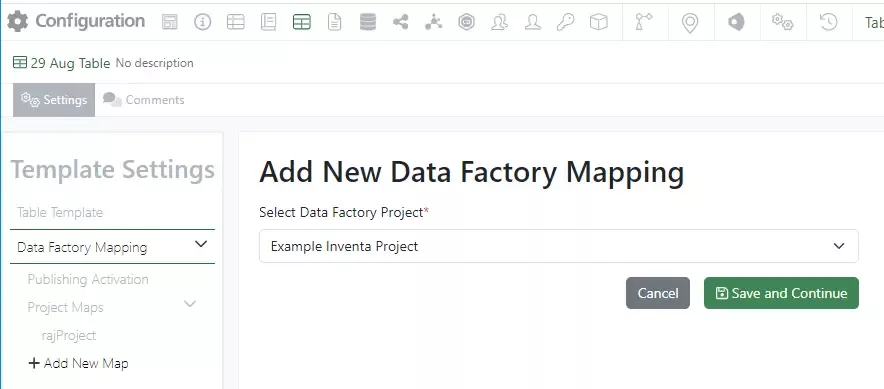
Under the Data Factory Mapping header, choose + Add New Map. Associate the map with the Inventa Project:
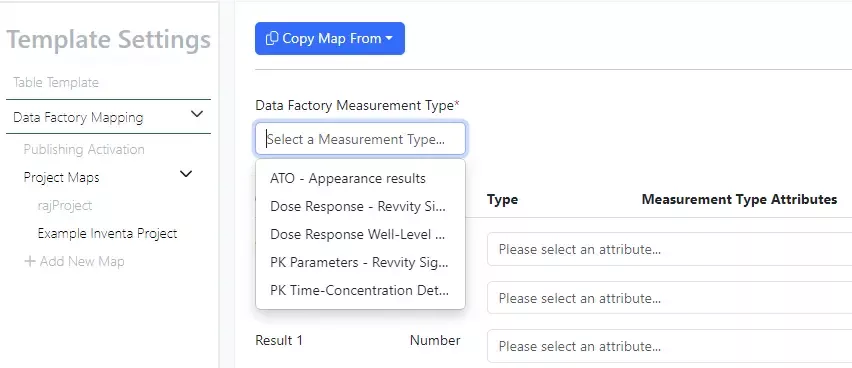
Select a Data Factory Measurement Type or if previous maps exist, the Copy Map From button will be available:

Map the ADT Column Name to the correct Measurement Type Attribute. The Column Type will match with the Measurement Type Attribute automatically. If the Batch ID is required by the Measurement Type Attribute, there will be a warning. The Batch ID can be set on the ADT or from the ADO/Experiment Template.
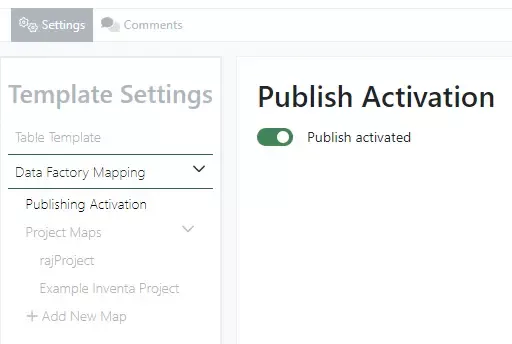
Save the map. Additional maps can be created, on a per Inventa project basis. As each project is selected, the list of available projects will be updated. Once all maps have been created, activate the publishing by selecting the Publish Activation page:

Before users can Publish from the ADO/Experiment, a corresponding Project Map needs to be created. Navigate to the ADO/Experiment template. In the top right corner, click on Data Factory Maps:

Choose + Add New Map and select desired project. Click Save and Continue:
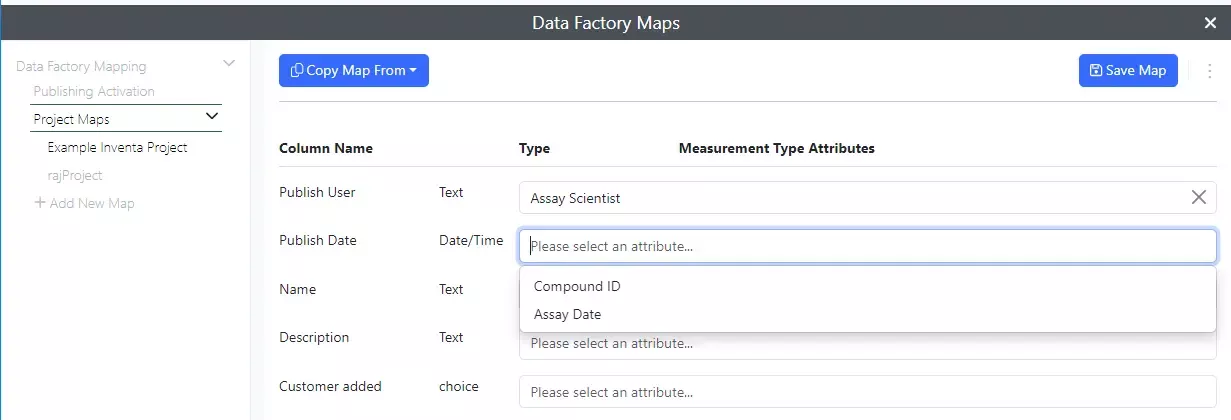
If desired (not required) additional fields from the ADO/Experiment Template can be mapped to the Measurement Type Attribute. This additional data will be appended to the ADT data when published:

Save Map. Additional maps can be created on a per project basis. Navigate to Publishing Activation to select when the user must fill in the Project:
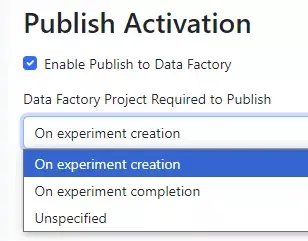
There are 3 options. Unspecified means that users can navigate to the properties in the ADO/Experiment and select the project at any time. Click the Enable Publish to Data Factory when finished to allow users to publish from an ADO/Experiment:

Users will be prompted to fill in the Project if the selection is set to On experiment creation:

Users will see a Publish button in the top right corner of the ADO/Experiment when the configuration is correctly enabled:
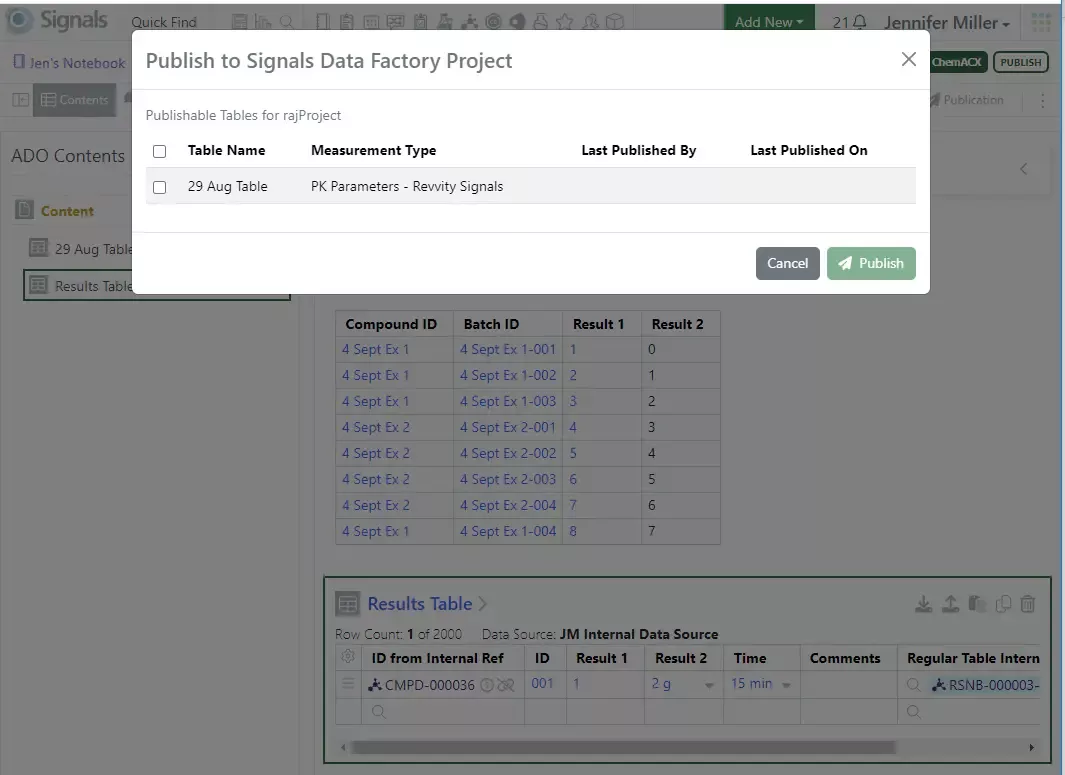
User can add as many ADTs as needed to the ADO/Experiment. Only the ADTs that have been mapped to the same project as the ADO/Experiment will show in the screen for selection to be published. The first time the table(s) is/are published, the Last Published… will be blank:

Click on the grey Publication button to see if there are any errors:

If there are errors, a report will be available for download:

If no errors occurred, the Status will show as green:
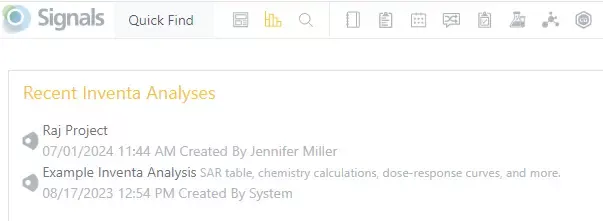
Once the data is published, users can navigate to the Inventa Analysis to view the data:
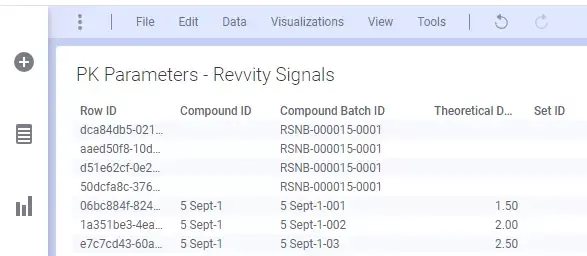
Compounds that do not exist, will be created automatically. Batches with Compounds will be created automatically if they have not been created. Batches without Compounds will not be created and will show in the error report.
Materials

Administrators can now automatically refresh the calculated properties for a selected type of Materials. This will run calculated properties for chemical and protein libraries, including calculated chemical names. The setting is available under Advanced Settings on the Materials Configuration page. Administrators can designate the library and confirm that they wish to recalculate the fields of that set of Materials. Once the process is complete the last update and number of Materials updated will be displayed. At this point the Administrator can update additional Materials.
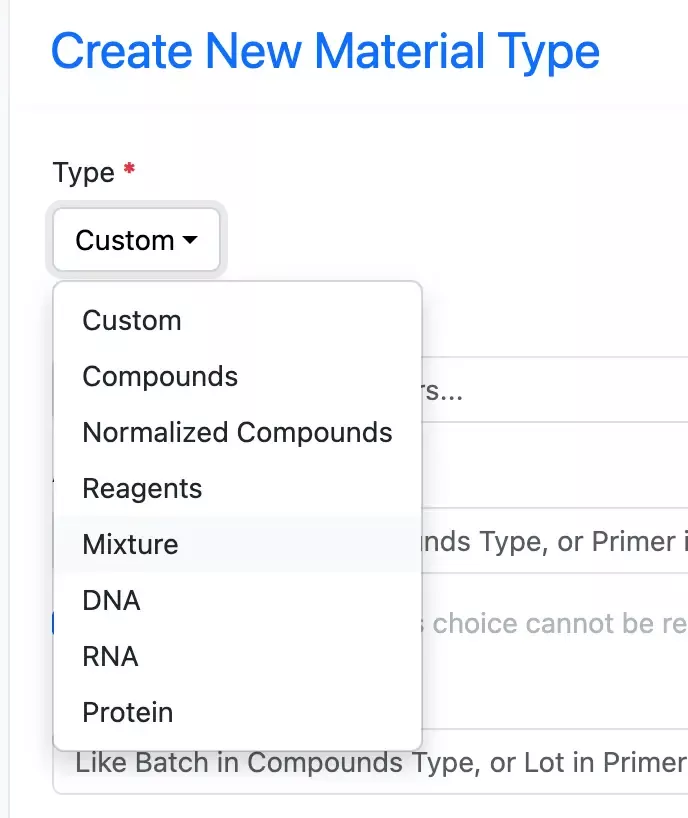
Administrators can now set of libraries to describe Mixtures. The Mixtures Library type can be selected when setting up a new library.
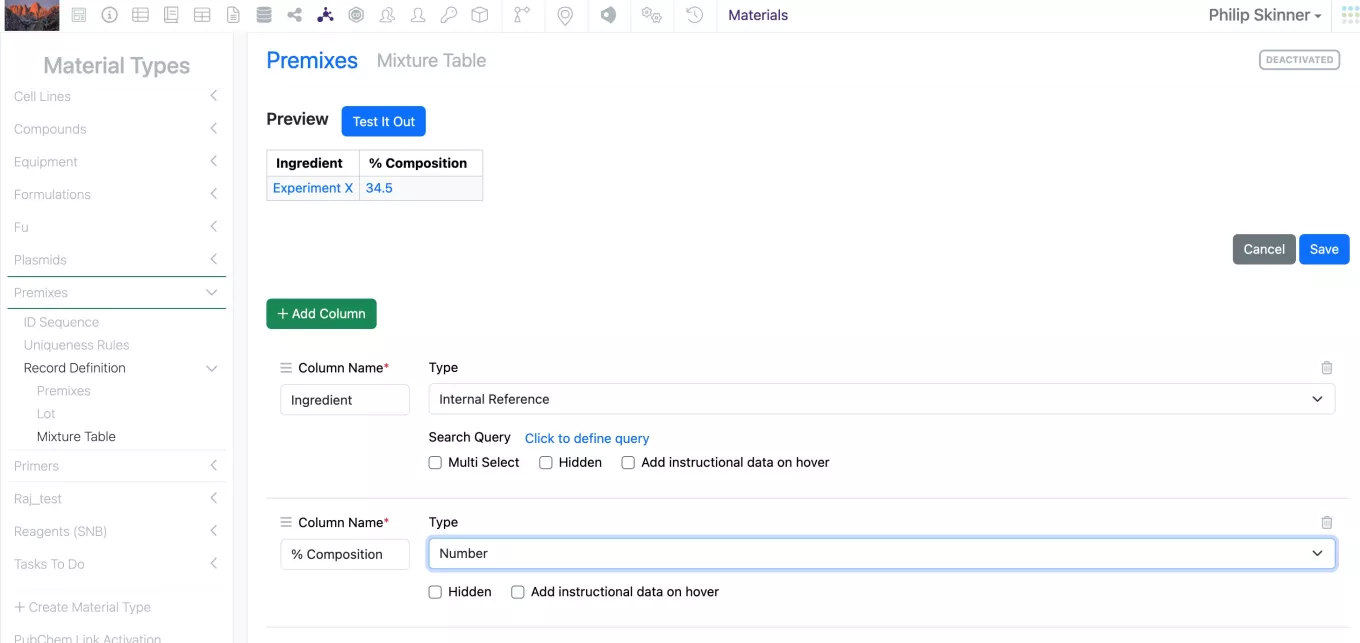
The library allows the administrator to define properties, uniqueness rules, activation as they do for other custom libraries. The admin can also define a table for the compositional data for the Mixture.
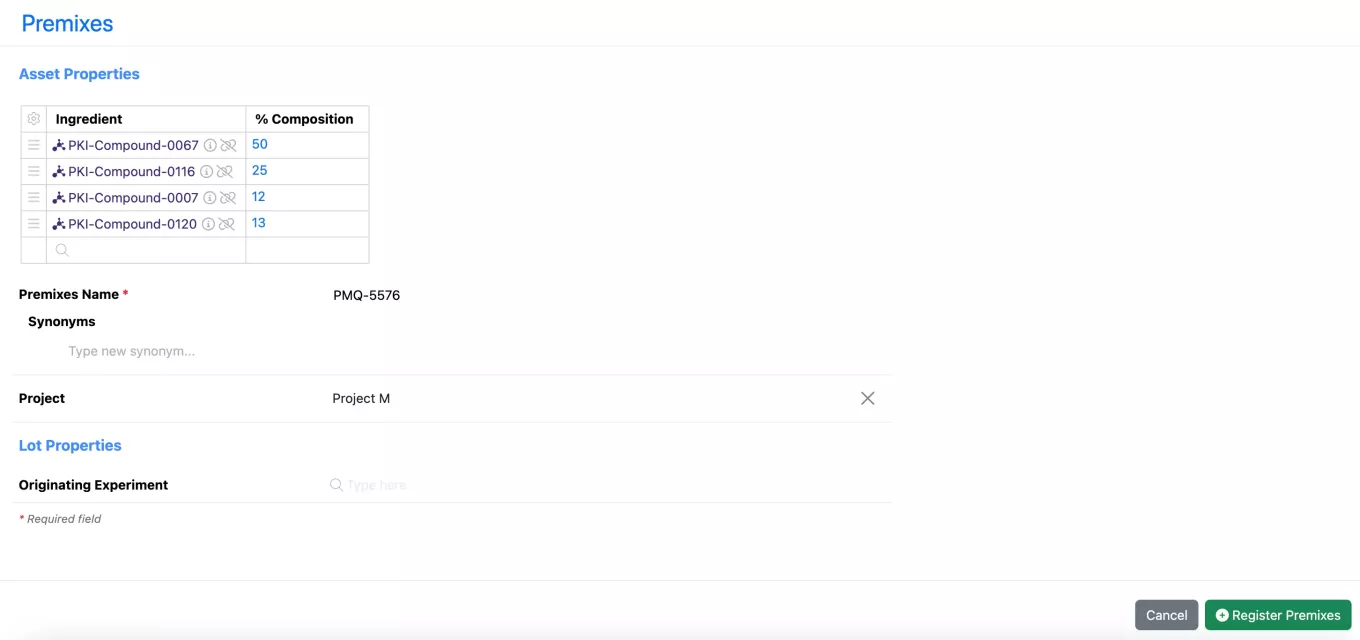
Once the library has been defined and activated, users can create new entries, completing both asset and batch level properties, in addition to populating the table based compositional data.
Tasks and Requests
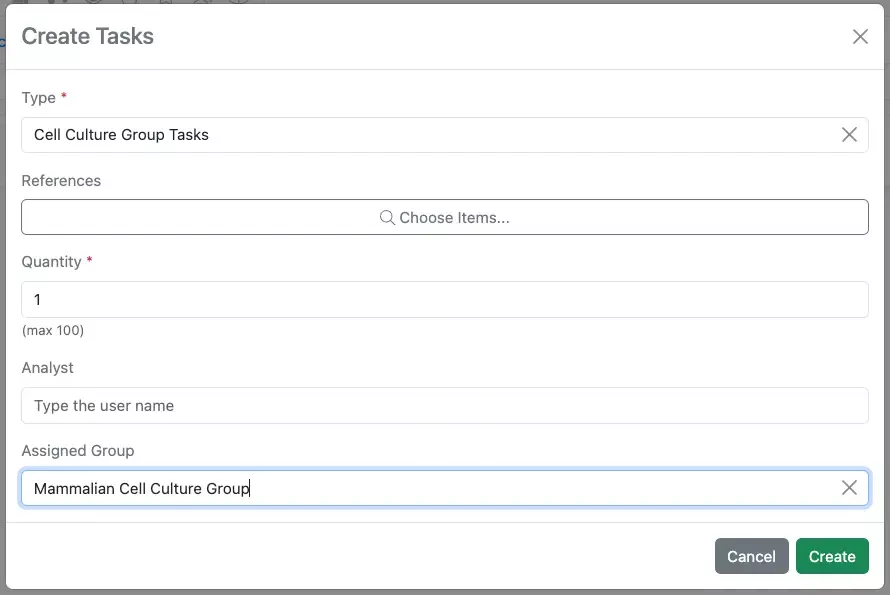
It is now possible to assign Tasks to User or System Groups using the system reserved field, Assigned Group. Groups can be assigned during or after creation of a task or tasks. Only a single group can be assigned to a given task. If enabled in their user settings, members of the assigned group will be notified of a Task Assignment.

It is also possible to unassign an analyst or group from a Task in the Submitted, Canceled, or New states. This action can be taken from the Task table or the Task Smart Folder. Tasks that are In Progress must be unassigned from the Task-to-do table.
What's New
This version 24.7 release of Signals brings improvements to Signals Synergy, Inventory and new Spotfire file handling. We have also added a new aggregate calculation into Variation Tables, and enabled the addition of internal references into Text elements. We have continued to work on our ongoing beta capabilities for the Integrated Summary App in Signals Inventa, the prior beta capabilities around Inventory linked ADTs and Variation Tables in now available to all systems. Finally, we have also fixed a number of small bugs.
The following improvements are available for users, administrators and developers on the Signals platform. Certain features may only be available with appropriate licensing and/or with enablement by an administrator.
• Fundamentals
– New Spotfire for Signals Information Item
– Spotfire File removed from Add Content menu
– Insert Internal Reference into the Text Element
• Inventa
– Criteria Summary captures split summarizations in Integrated Summary App (beta)
– Integrated Summary App now supports multiple structures Quick Query mode (beta)
• Synergy
– Configuration Transfer for Synergy templates
– On Hold status for Work Orders
– References from Work Order Reference Tables can be referenced by CRO users in ADTs
• Chemistry
– Improved HELM sequence navigation
• Admin Defined Tables & Variation Tables
– Inventory linked properties in ADTs and Variation Tables available to all systems
– Aggregate calculations from Variations to Components
• Inventory
– Inventory Bulk Results page displays 20 reports at a time
– Home Location shows grid coordinates
– Location page sublocations sorted alphabetically
– New 40 x 18 label template
– Grid Locations displays available spaces
– Bulk actions from the Container Search Table: Delete and Update Status
• Materials
– Reverse order of batch/lots
• Administration
– Spotfire Setting to select Spotfire File opener, on-prem or Spotfire for Signals included with Signals Research Suite
– Privilege to add Spotfire for Signals opener option to Spotfire Files (when Spotfire Setting set to on-prem)
• Integrations & APIs
– New PUT endpoint to replace uploaded files
– New endpoint to trigger "Update from PubChem"
– New endpoints to allow usage of Parallel experiments Enumerator
We also fixed several small bugs in this release. Details of the enhancements are described below.
The following OnDemand videos for Signals Notebook End Users are now available
- Understanding Variation Tables - Basics of Chemical Formulations
The following OnDemand videos for Signals Notebook Administrators are now available
- Enabling HELM Libraries & Creating Custom Libraries
Developers in Signals Notebook and Signals Research Suite should note that the behavior of endpoint PATCH /adt/{eid} has been updated. This update is to align the API behavior to match that of the UI, specifically regarding the display data in the key/ID value column for Tables utilizing an internal data source. The value of the column will now always be the name of the referenced entity, as in the UI, for update/create actions via the API.
Administrators should be aware that the legacy feature ‘Attachments’ in SDF has been deprecated.
Administrators should be aware that the “Project” and “Sample” tabs have been removed from the SDF interfaces.
Developers should note that we have published a new Developers Guide, found at https://revvitysignals.com/revvity-signals-developer-guide-overview
Administrators are recommended to subscribe to the channels within our support news site found at https://support.revvitysignals.com/hc/en-us/categories/360004446171-Support-News which contains more information about releases and other pertinent product information.
This content is anticipated for release on our Production E3 environments, and for Private Cloud customers on our deferred release schedule, in November 2024.
Further Details
The following improvements are available for users, administrators and developers on the Signals platform. Certain features may only be available with appropriate licensing and/or with enablement by an administrator.
Fundamentals
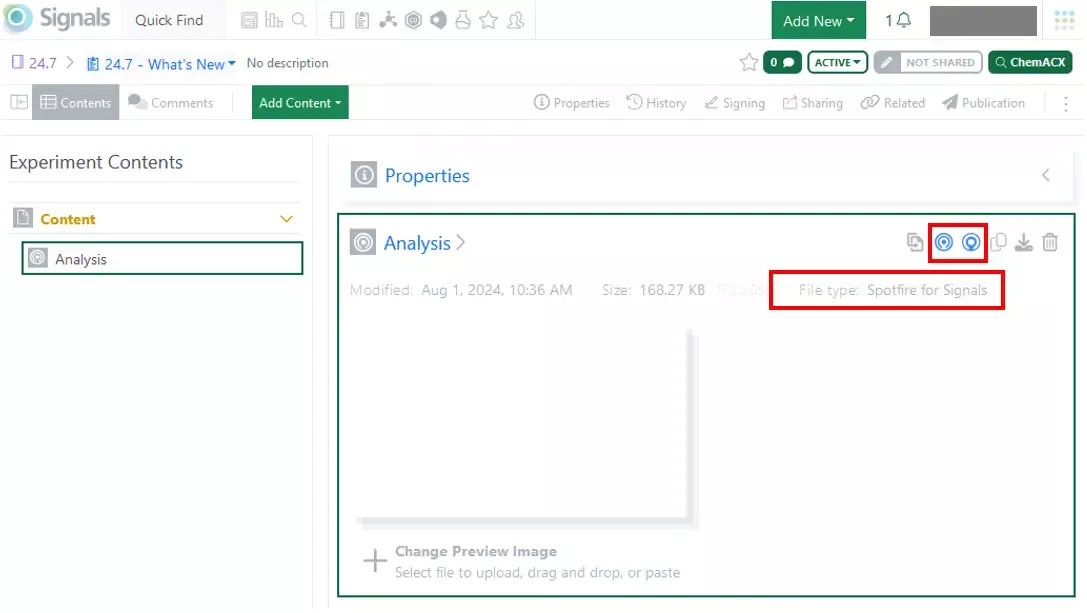
New Spotfire for Signals available for Signals Research Suite licensed users for exclusive use with the Spotfire included with Signals Research Suite. Spotfire for Signals is the new default and is available in the Add Content menu (creates a blank Analysis file).

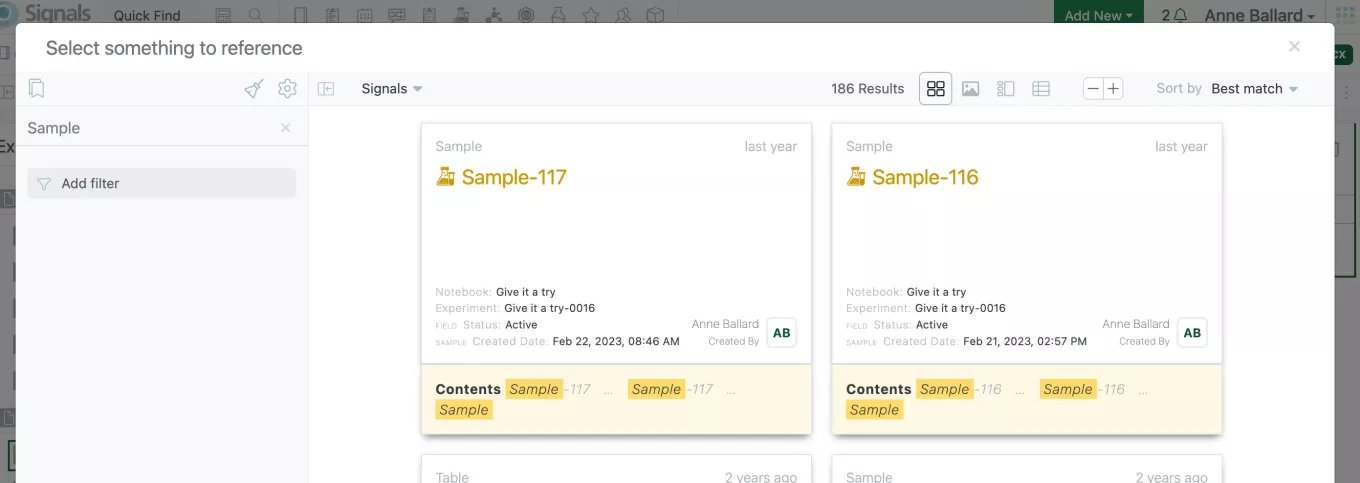
Spotfire File is no longer in the Add Content menu. Spotfire File can still be created with Drag and Drop or File Upload depending on licensing and/or Admin Setting.
Users should now be able to insert an internal reference into the text element using two methods. First, a new text element toolbar option allows users to search for and insert an internal reference buy clicking the magnifying glass icon.
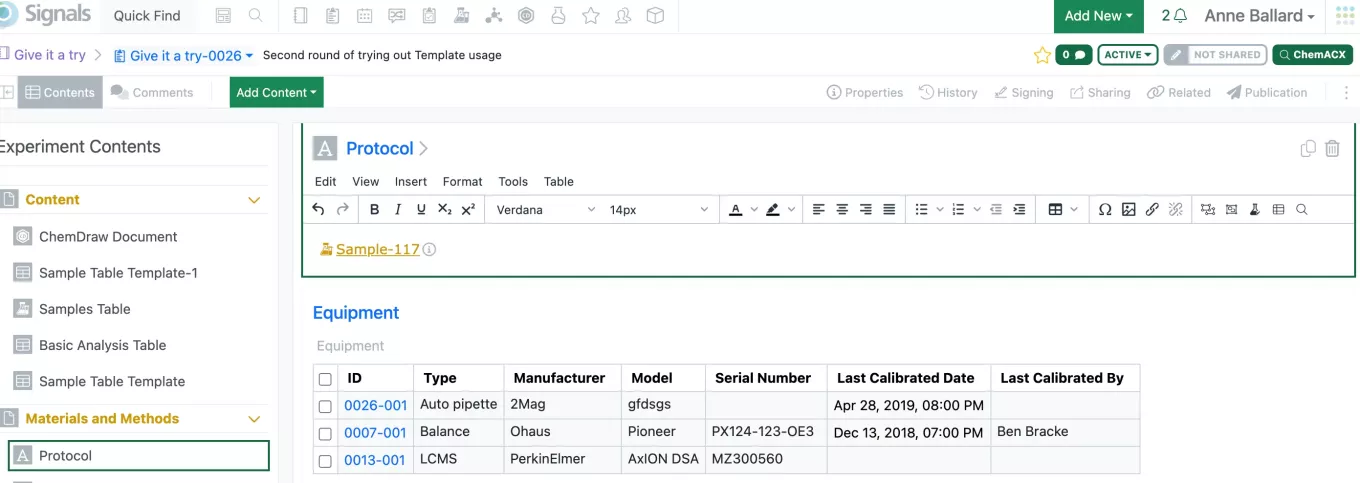
Users are now also able to insert an internal reference into a text element by copy/pasting the url for an SNB entity.
Synergy
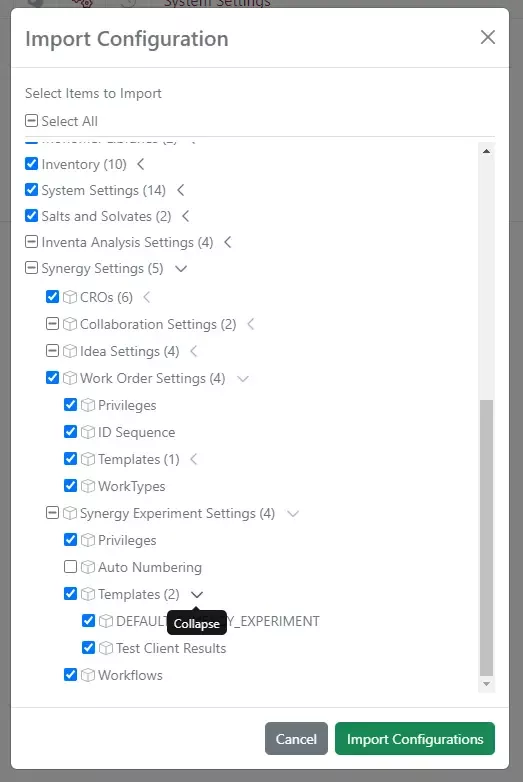
On the administrative side, Synergy templates for Ideas, Work Orders, and Synergy Experiments can now be transferred from one tenant to another using Configuration Transfer.
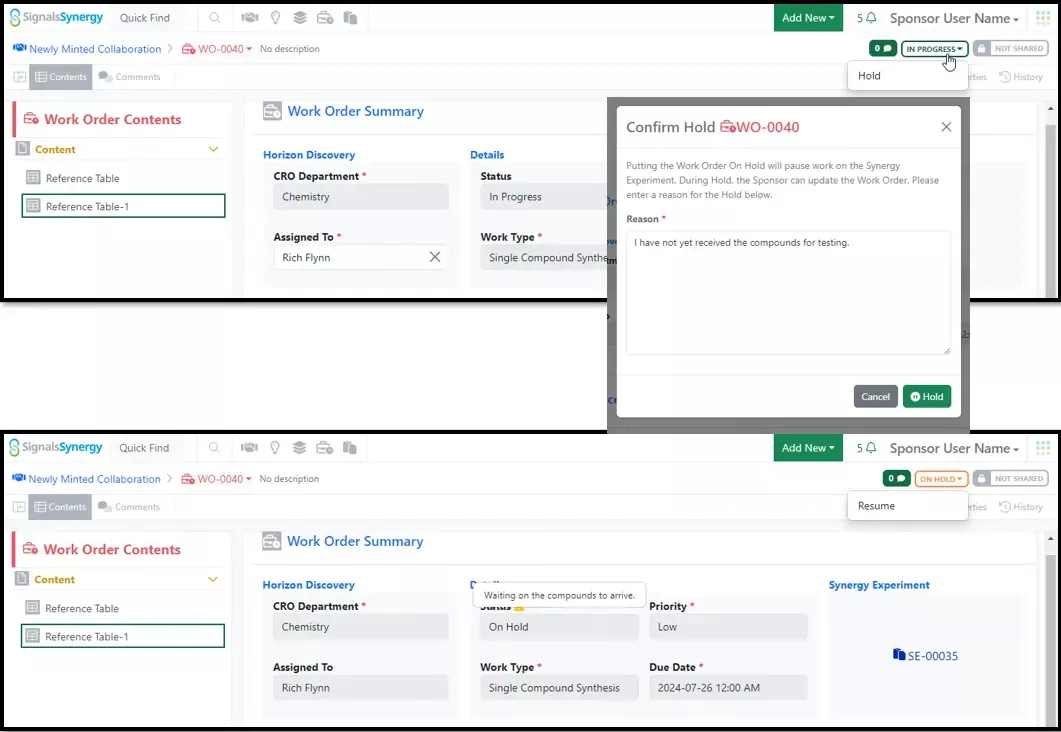
In Synergy, both the Sponsor user and the CRO user can put a Work Order On Hold. When placing the Work Order On Hold, the user can enter a reason. While On Hold, the Sponsor can edit the Work Order as required to provide additional information and resume when (if) the issue has been resolved.
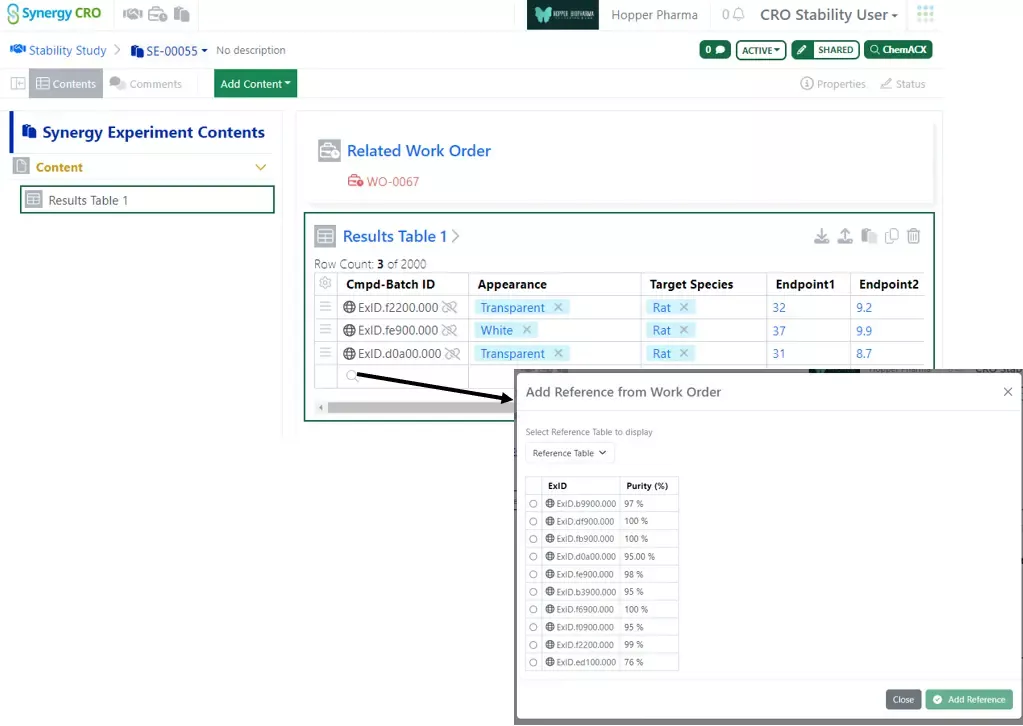
In addition, CRO users can now pull external identifiers (ExIDs) for shared materials from the associated Work Order into internal reference fields in admin defined tables (ADTs). This avoids the error-prone process of copying and pasting identifiers into tables for capturing results. CRO users can report results related to the ExID, while the Sponsor can view and use both the ExID or internal material IDs.
Chemistry

Usability enhancements are available for working with biopolymer structures. When editing a HELM structure, a click selection of a monomer will select it for replacement. Similarly, a click selection of the bond will select if as an insertion point for a new monomer to be added. The buttons at the bottom of the HELM Editor have been removed and replaced with a badge that indicates ‘Insert’ or ‘Replace’ mode. Additionally, it is now possible to traverse a HELM structure by using keyboard arrow navigation. Once a monomer or bond is selected, directional arrows on the keyboard can be used to alternate between monomer and bond selection through the entirety of the sequence.
Admin Defined Tables & Variation Tables
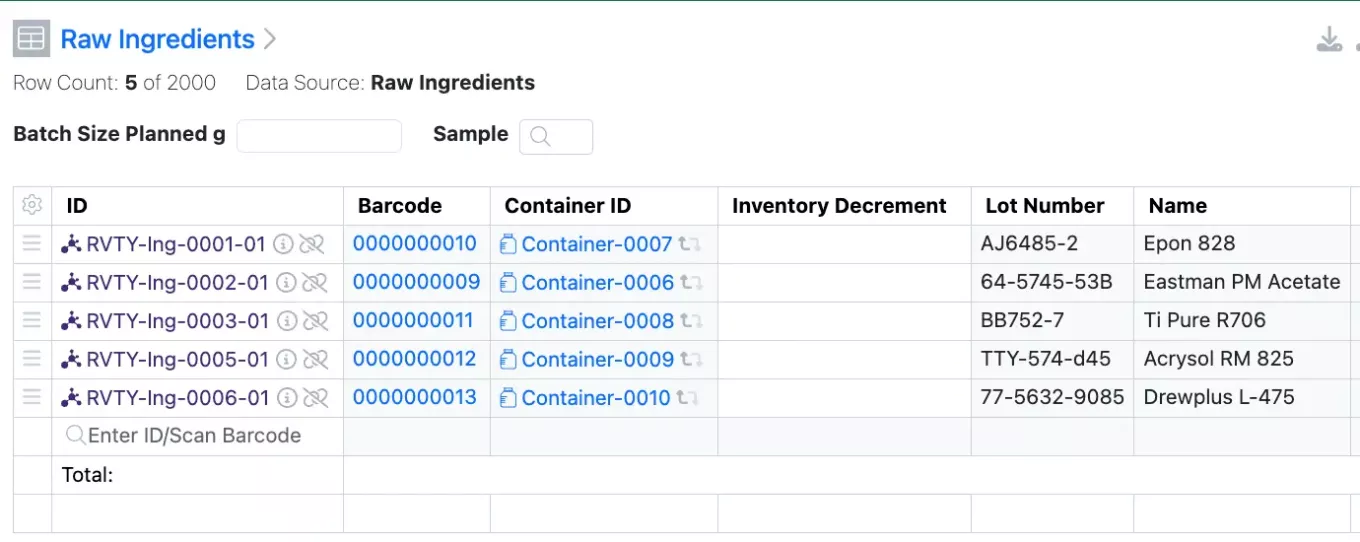
The ability to add Inventory related columns to Admin Defined Tables and Variation Tables, previously available in beta, is now available to all systems.

We have also added the ability to calculate a SUM of values in the Variants in the Components. The SUM function calculates the sum of a given row across all the Variants, displayed in that row in the Components.
Inventory
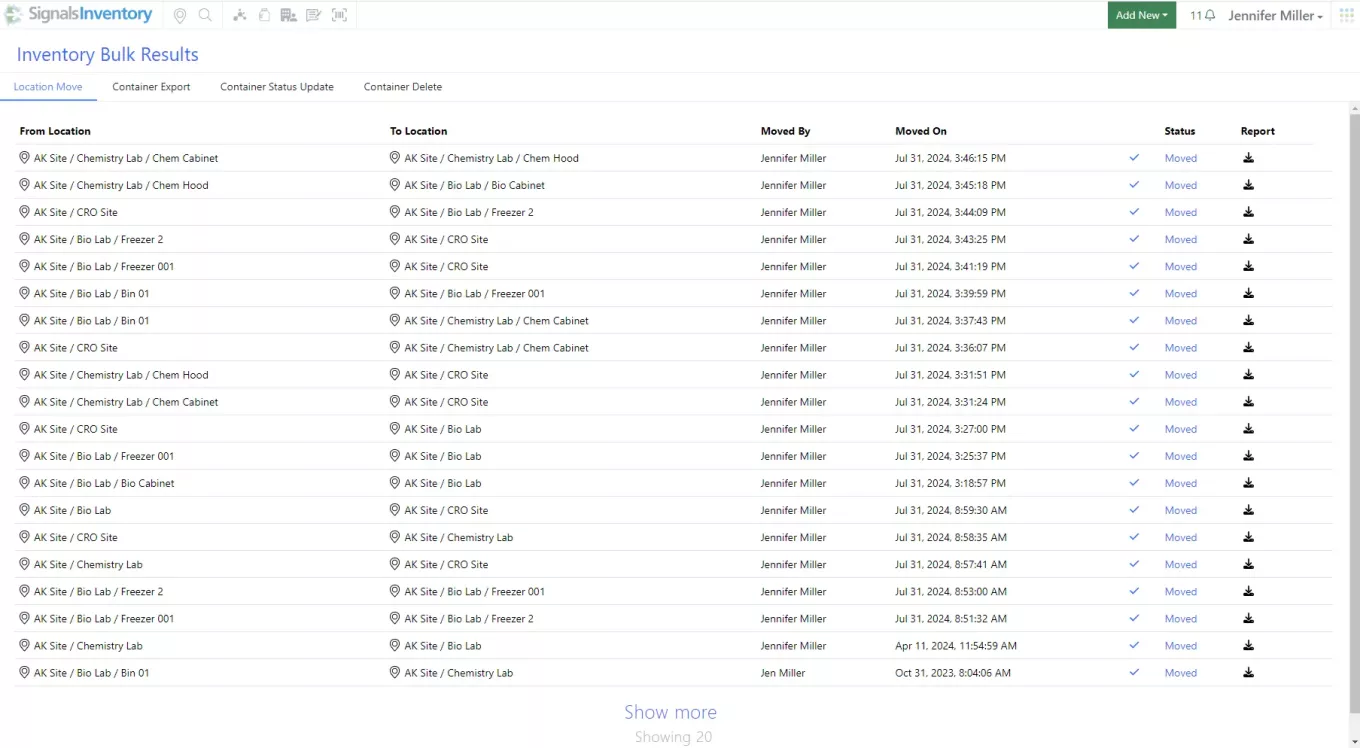
Inventory Bulk Results page displays 20 reports at a time with a Show more option:
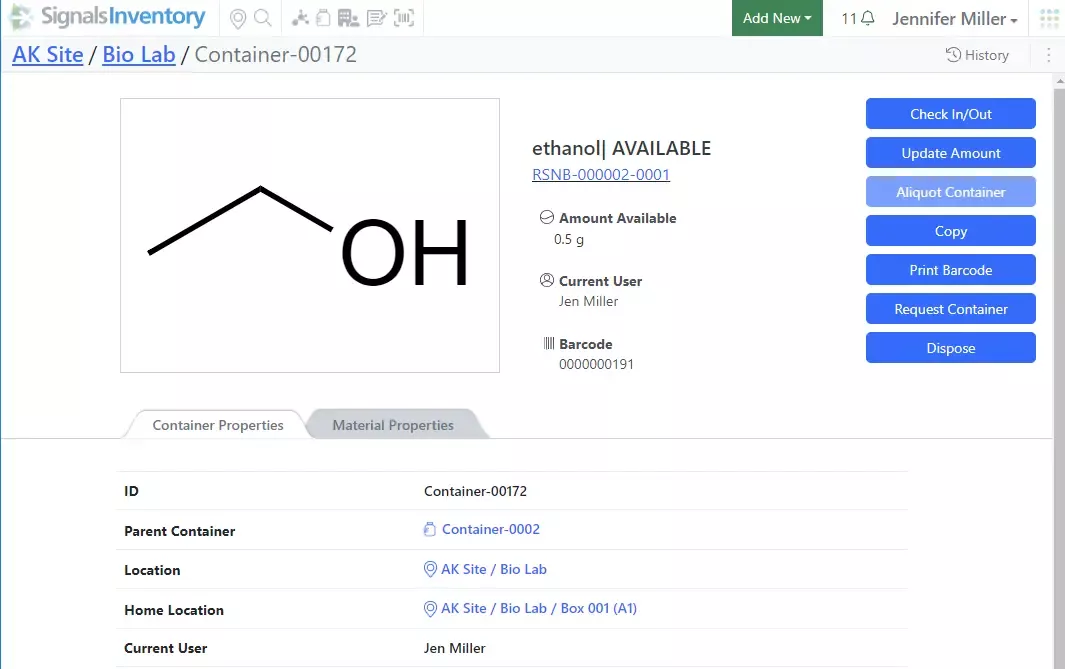
Home Location shows grid coordinates in Container Details page:
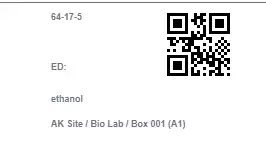
The Home Location grid coordinates print on the labels:

Home Location grid coordinates appear in Containers Search Table:
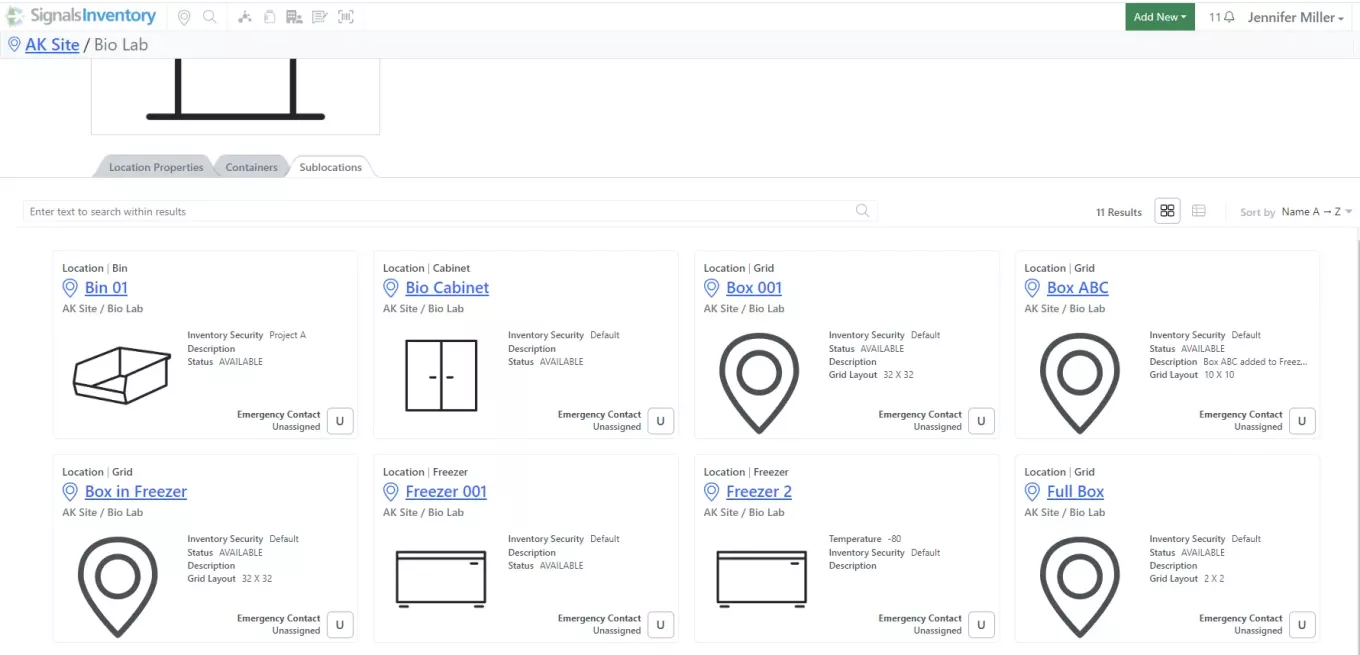
Location page sublocations sorted alphabetically:
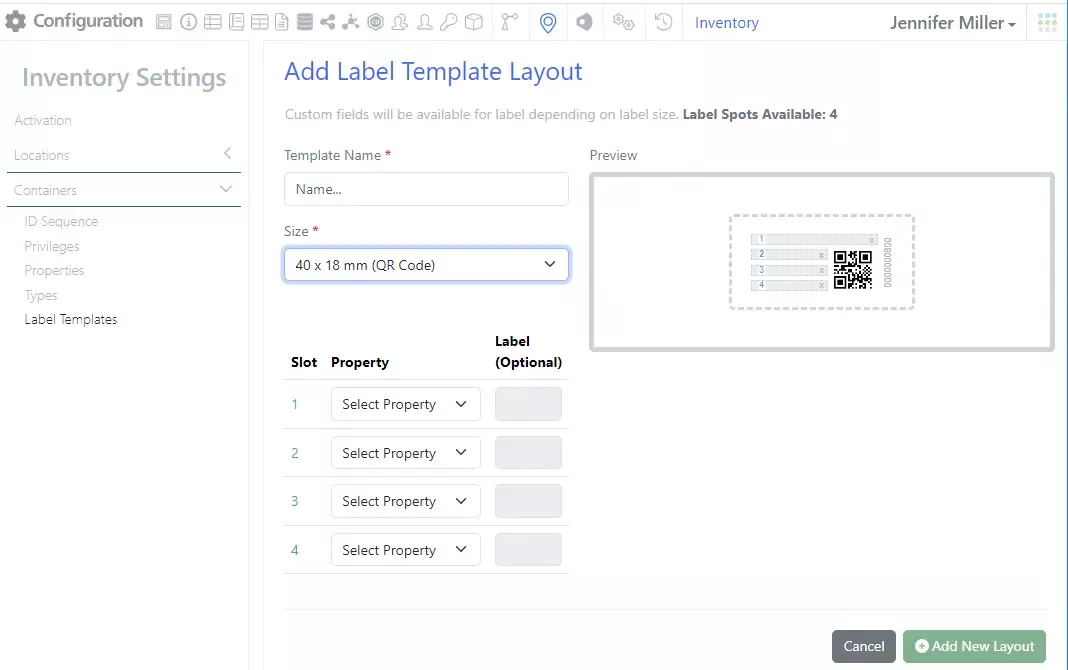

New 40 x 18 label template:
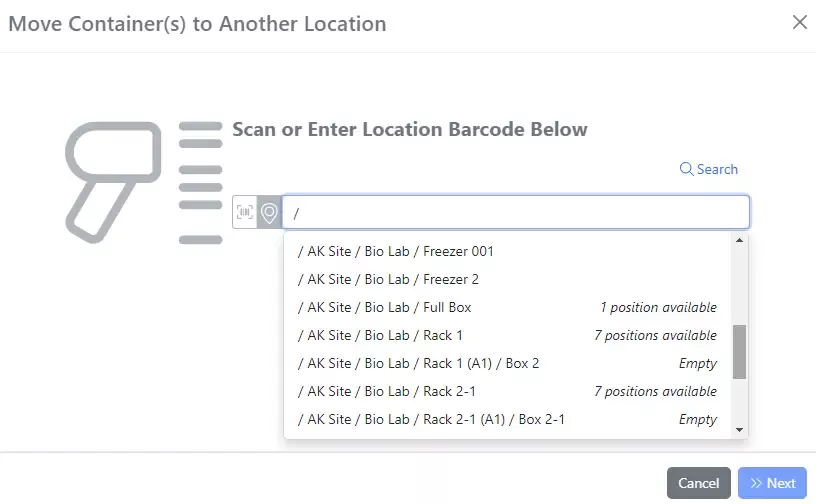
When selecting a Grid Location, the drop down will display available spaces when doing a move:
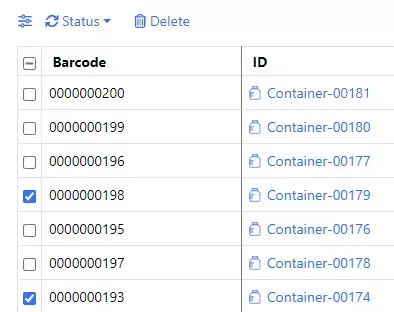
User with Delete Container privileges will be able to bulk delete containers from the Containers Search Table:

Deleted containers cannot be restored. A toast will appear at the bottom of the screen, followed by a notification under the bell after the delete is completed. A report can be found in the Inventory Bulk Results - Container Delete:
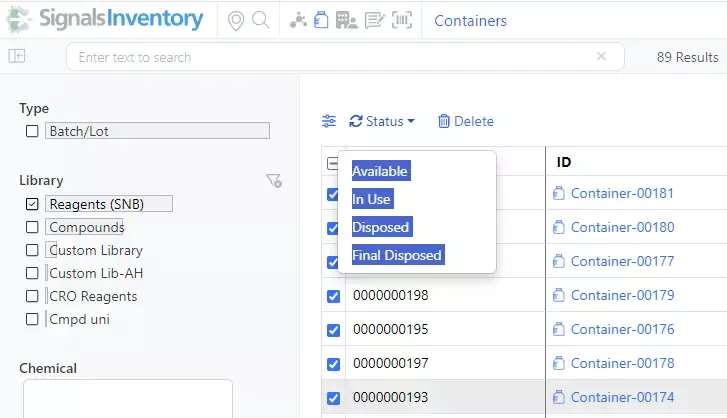
Users with the appropriate privileges will be able to bulk update the status of containers from the Container Search Table:
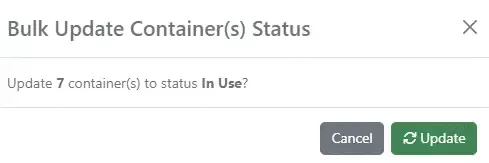
Containers in the Final Disposed Status will not be updated as Final Disposed Status is a Read Only status that can not be restored. Disposed containers can be restored on an individual basis.
Once a selection has been made, a confirmation screen will appear:
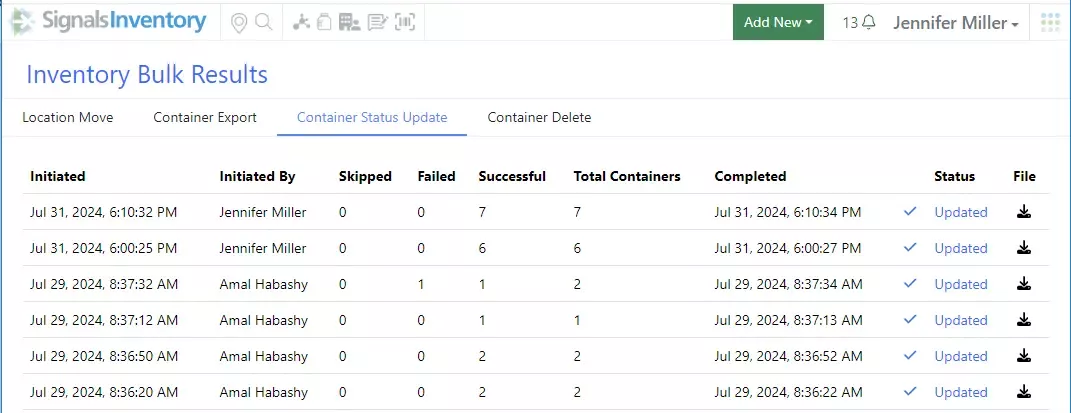
A toast will appear at the bottom of the screen. A report will be generated, and a notification can be found under the bell icon. The report can be found in the Inventory Bulk Results Container Status Update:
Reports are removed after 30 days.
Materials
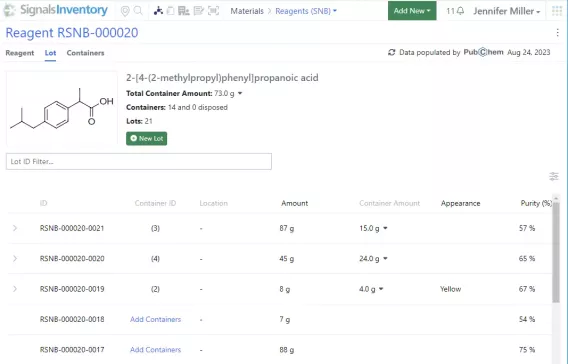
The Batch/Lot page of a material shows the batches/lots in the reversed order with the most recent batch displaying in the list first:
Administration
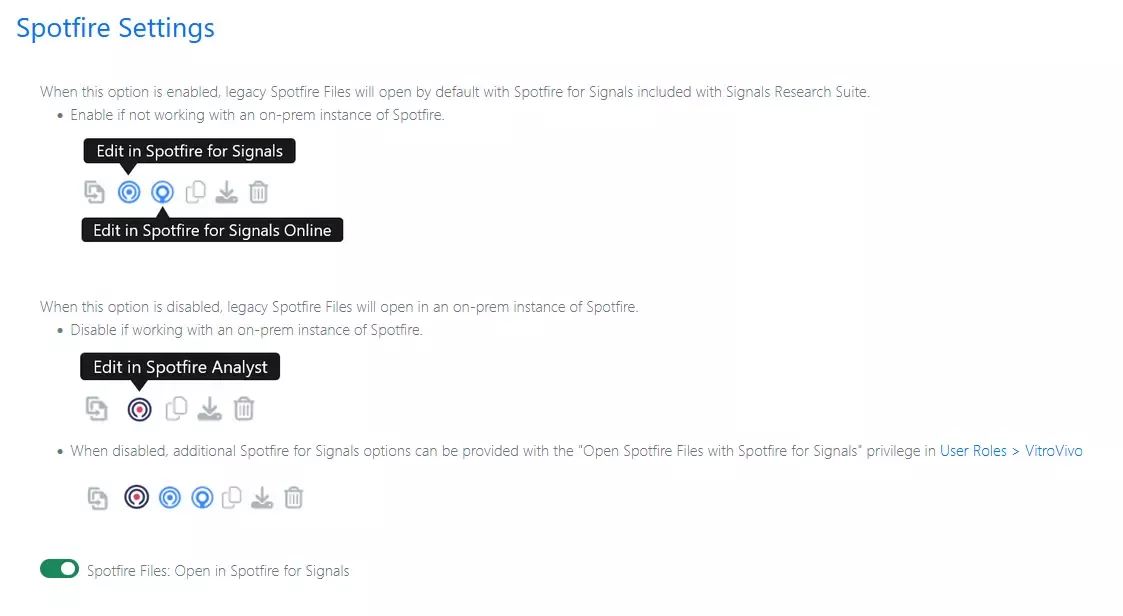
A new Spotfire Setting allows the use of hybrid Spotfire, both OnPrem Spotfire and Spotfire for Signals, within Spotfire File Information Items. These settings do not affect the new default Spotfire for Signals information item that is for exclusive use with the Spotfire included with Signals Research Suite.
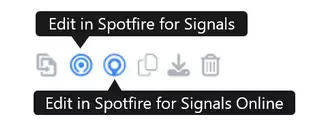
Note that if the tenant has never been licensed for Signals Research Suite, Spotfire Settings are unavailable and only OnPrem Spotfire is available within Spotfire File. The creation of new Spotfire Files is available with Drag and Drop or File Upload.
When the Spotfire Setting is enabled (default), legacy Spotfire Files open with Spotfire for Signals included with Signals Research Suite. The creation of legacy Spotfire Files is blocked and defaults to the newly available Spotfire for Signals. Users not licensed to Signals Research Suite will have no openers available.

By disabling the Spotfire Setting, Spotfire Files will open with OnPrem Spotfire for all users. The creation of legacy Spotfire Files is available with Drag and Drop or File Upload for all users.

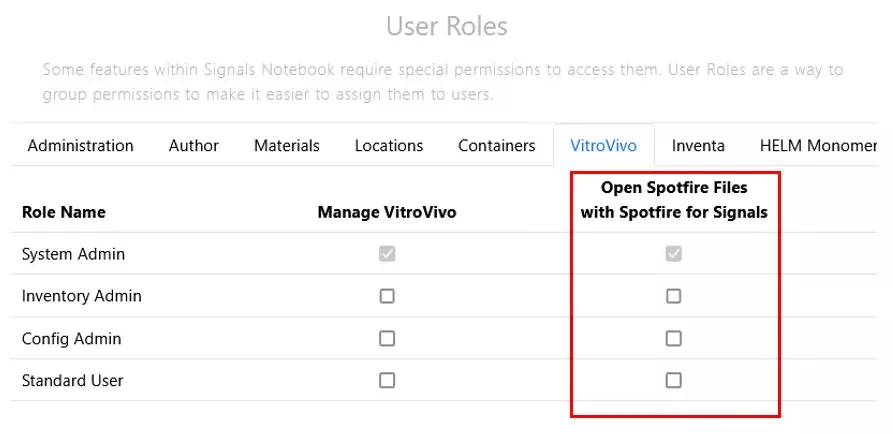
If the Spotfire Setting is disabled, additional Spotfire for Signals options are available if Open Spotfire File with Spotfire for Signals privilege is granted. This privilege is useful during the transition from OnPrem Spotfire to Spotfire for Signals included with Signals Research Suite as the user will have all opener options available.
Integrations & APIs

There is a new endpoint available to replace uploaded entities with new files.

This endpoint can be used to replace an uploaded file, as you can via the UI, while preserving the entity id for Microsoft Office Files, Images, Generic Files, PDFs and Spotfire Files.
The Content-Type should be set in the header when utilizing this request to define the type of entity/the file type you are replacing. Full details can be found on the Swagger page.
There is also a new endpoint available to trigger the “Update from PubChem” functionality on a material within a Reagents material library.

The material must be part of a Reagents material library with “Import from PubChem” enabled in System Configuration. Additionally, the material must have a valid CAS number.
A new set of endpoints have been created to allow for usage of a Parallel experiment’s enumerator programmatically.
These endpoints allow for:
- Fetching of an enumerators content.
- Adding a compound to an enumerator. Single compounds can be added via: cdxml, mol, smiles, or InChI. multiple compounds can be added via a sdf file. Column fields are mapped by the exact name match, using appropriate Content-Type (see Swagger page for more details)
- Refreshing an enumerators group.
- Kicking off an enumeration job to generate sub experiments, where the parallel experiment requires a chemical drawing to use as the Generic Reaction, the chemical drawing requires at least one Reaction, and only one reaction can be enumerated at a time. To use the enumerator again you must delete all existing sub experiments.
- Checking the status of an enumeration, where IN_PROGRESS: Enumerator is attempting to create sub experiments; COMPLETED: Enumerator successfully created sub experiments; and FAILURE: Enumerator failed to create sub experiments. The API Response will return details on the failure/errorThe enumeration job is asynchronous and requires that no existing sub experiments exist. Parallel experiments sub experiments can be reset with pre-existing endpoints:
The following capabilities are in beta and are available for users, administrators and developers on the Signals platform upon request. Please contact your account representative or our support team if you would like access to the following features.
Inventa

The Integrated Summary App (ISA) allows users to split their results based on experimental factors. Now, the Criteria Summary also these reflects these search settings.
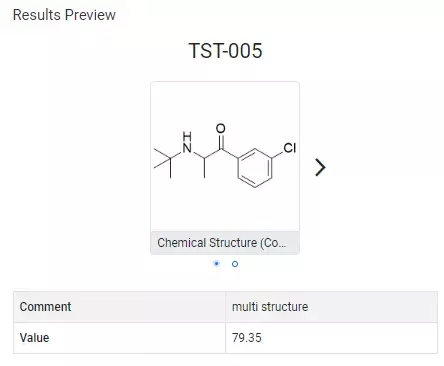
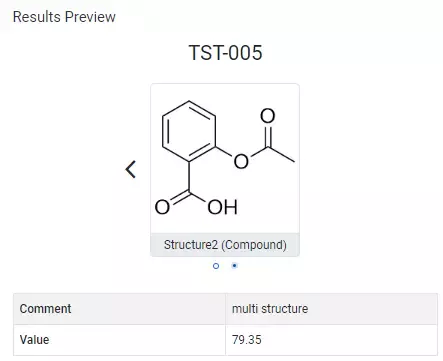
The Results Preview section of ISA’s Quick Query mode now supports multiple structures, which users can navigate between.
What's New
This version 24.6 release of Signals brings a series of calculations to Admin Defined Tables and Variation tables. We have also improved Inventory with a display of the history of Containers and an archiving process, plus made some improvements. We have made a series of improvements to our Signals VitroVivo, Inventa and Synergy products. The recent beta capabilities on stereochemical annotation and web based Spotfire analyses are now available to all systems. We have continued working on our beta capabilities in the Integrated Summary App, and added a new beta capability to link Admin Defined Tables and Variation Tables to Inventory. Finally, we have also fixed a number of small bugs.
The following improvements are available for users of Signals Notebook Standard, Signals Synergy, Signals Notebook Private Cloud, Signals Research Suite Standard and Signals Research Suite Private Cloud. Certain features may only be available with appropriate licensing and/or with enablement by an administrator.
• Fundamentals
– Allowing selection and export for Grid view
– Option to remove page breaks in PDF printing
– Option to edit and view Spotfire Files and Inventa Analysis Objects in your web browser available to all systems
– Adding a Spotfire File creates a blank Analysis file available to all systems
• VitroVivo
– Enhancements to the Editable Data Grid handling of tables selected in the Notebook Experiment
– Better row sorting for 1536 wells plates
• Inventa
– Add Inventa Analyses directly to a Notebook
– Multi-select measurement attributes when defining Measurement Types
– Reorder measurement selections in Integrated Summary App (beta)
– Quick Query mode in Integrated Summary App (beta)
• Synergy
– License allocation per CRO for Synergy CRO user licenses
– Configuration Transfer for Synergy Roles and Privilege and CROs and CRO users
– Reopen and Recall Work Orders
– Improvements to tracking of Work Orders on Designs
• Chemistry
– Enhanced Stereochemical Annotation tool available to all systems
– Complimentary Strand Generation
• Admin Defined Tables & Variation Tables
– DateAdd function
– Concatenate function
– Round Up/Down function
– Row offset function
– Limit External References selection in Variation Tables to entities in the same experiment
– Inventory linked properties in ADTs and Variation Tables (beta)
• Inventory
– History on Containers page
– Archive a Location or Container type
• Administration
– Signed SAML response for external IdP authentication workflows
• Integrations & APIs
– New endpoints for deprecating and restoring deprecated monomers
– New endpoints for creating and managing Plate annotation layers
– Enhanced export API to allow Plates to be exported as CSV
We also fixed several small bugs in this release. Details of the enhancements are described below.
The following OnDemand videos for Signals Notebook End Users are now available or updated
- Using Hierarchical Attributes on Experiments and Tables
- ELN Archive Deeper Dive – Finding Collections
The following OnDemand videos for Signals Notebook Administrators are now available or updated
- First Time Administrators - Where to Start
- Enabling Chemistry Settings
Due to a change to a third party component used in Signals Notebook, image editing capabilities in our Text Editor are no longer available. All images will need to be appropriately formatted prior to addition to such elements.
Developers in Signals Notebook and Signals Research Suite should note that the behavior of endpoint PATCH /adt/{eid} is being updated. This update is to align the API behavior to match that of the UI, specifically regarding the display data in the key/ID value column for Tables utilizing an internal data source. The value of the column will now always be the name of the referenced entity, as in the UI, for update/create actions via the API. This change will be made in a future release.
Administrators should note that our updated licensing service, previously only made available on tenants with licenses to Signals Research Suite and/or ChemOffice+, is now being applied to all tenants. Although this change is being rolled out in the same approximate timeline to the current release it does not involve changes to the underlying code and is not release dependent. Once this change is applied to a given tenant, license assignment can be set on the main user page, on the create and edit user pages, as well as with the bulk update.
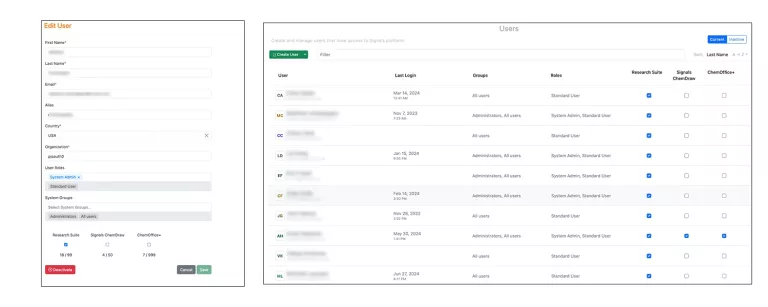
Administrators are recommended to subscribe to the channels within our support news site found at https://support.revvitysignals.com/hc/en-us/categories/360004446171-Support-News which contains more information about releases and other pertinent product information.
This content is anticipated for release on our Production E3 environments, and for Private Cloud customers on our deferred release schedule, in November 2024.
Further Details
The following improvements are available for users, administrators and developers on the Signals platform. Certain features may only be available with appropriate licensing and/or with enablement by an administrator.
Fundamentals
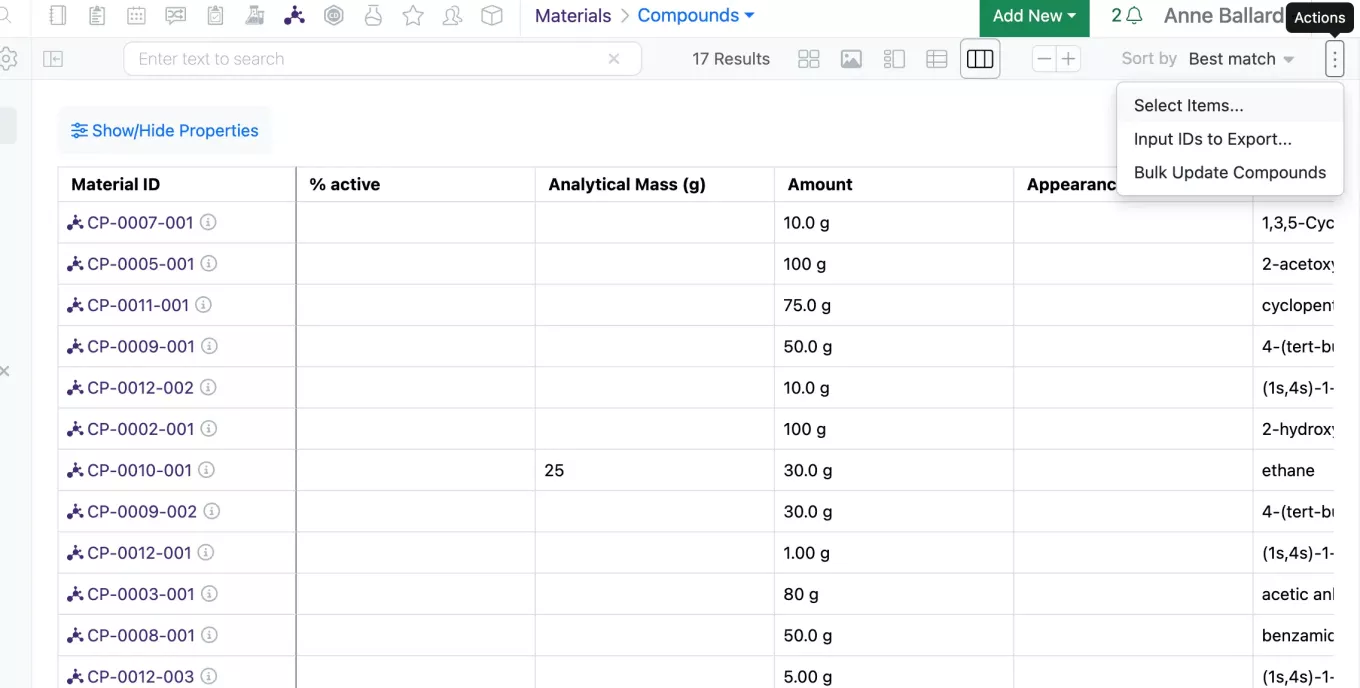
Existing export functionalities in the Search Smartfolders Card view are now available in the grid view. Exactly as is currently available in the Card view, users can enter selection mode using the right side Actions icon and selecting “Select Items”
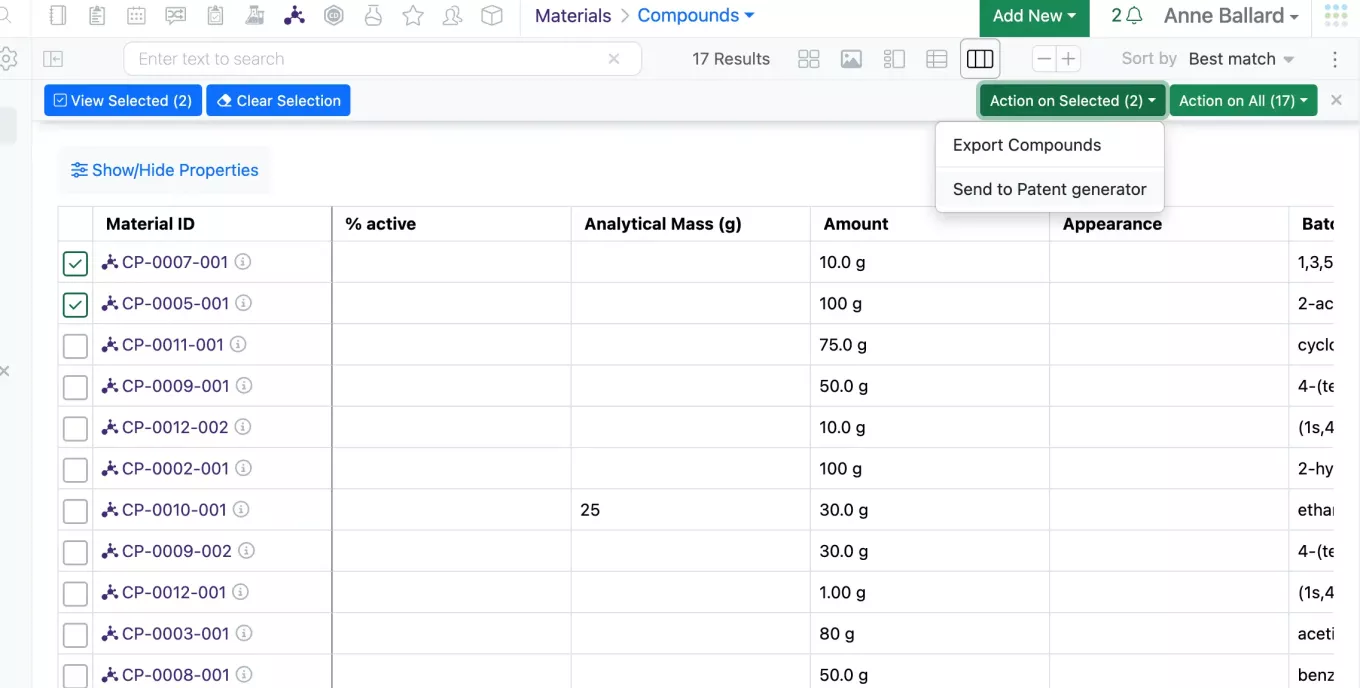
Once in selection mode, the user can execute available External Actions in the available Smartfolders or other additional currently available export options in Materials.
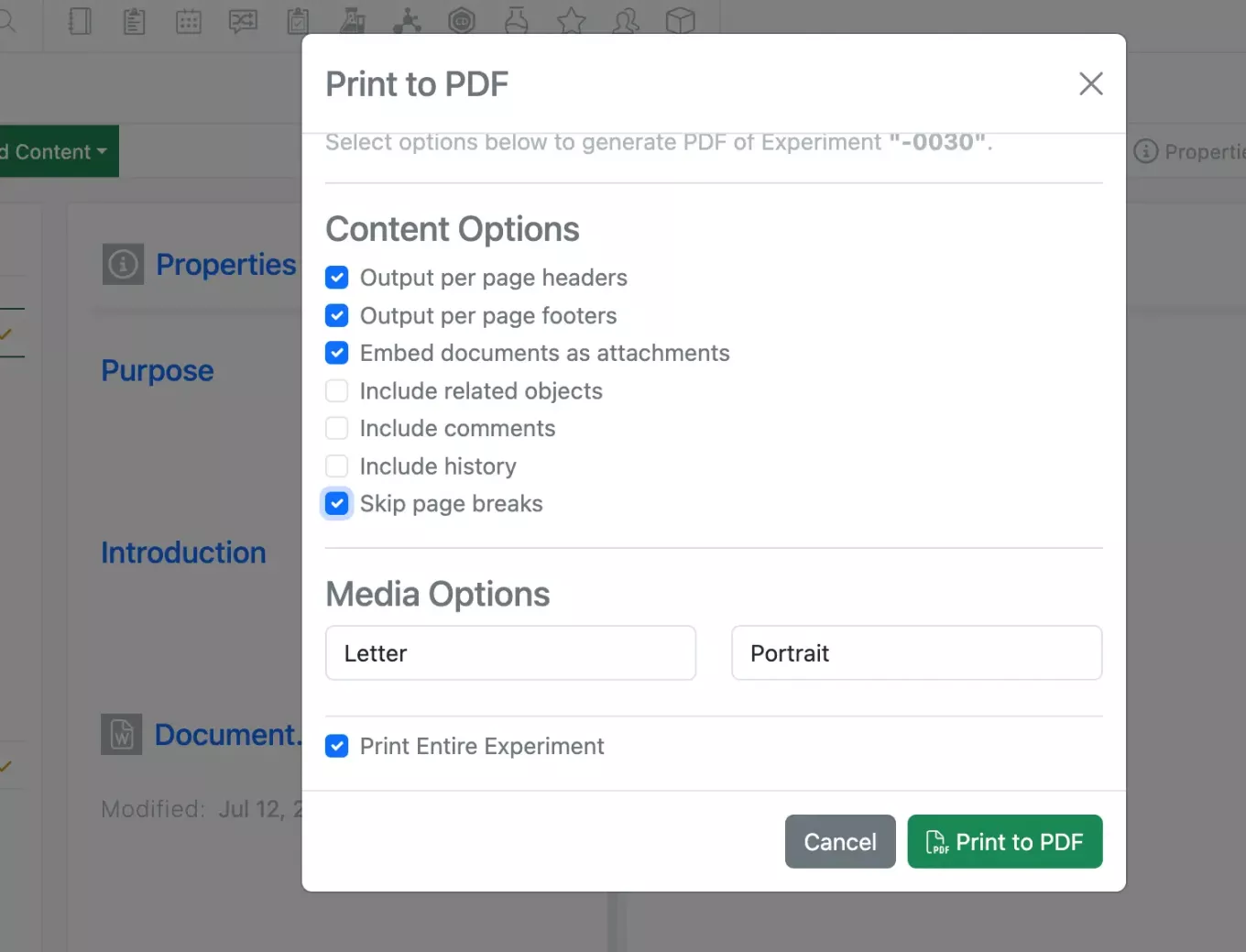
When printing an experiment to PDF, users now have the option to skip page breaks for a shorter report view.

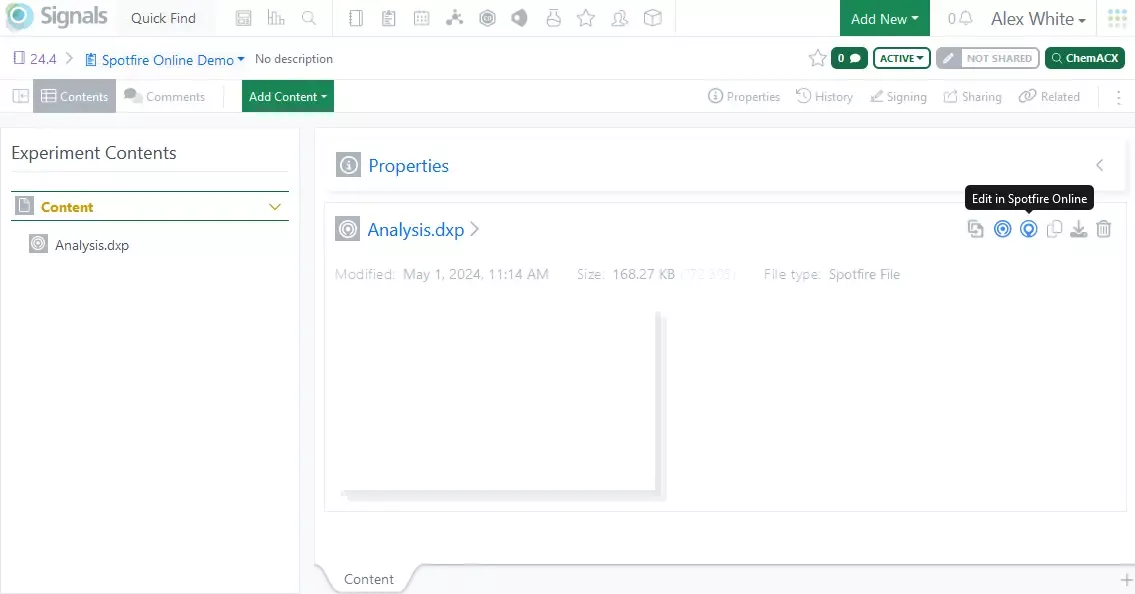
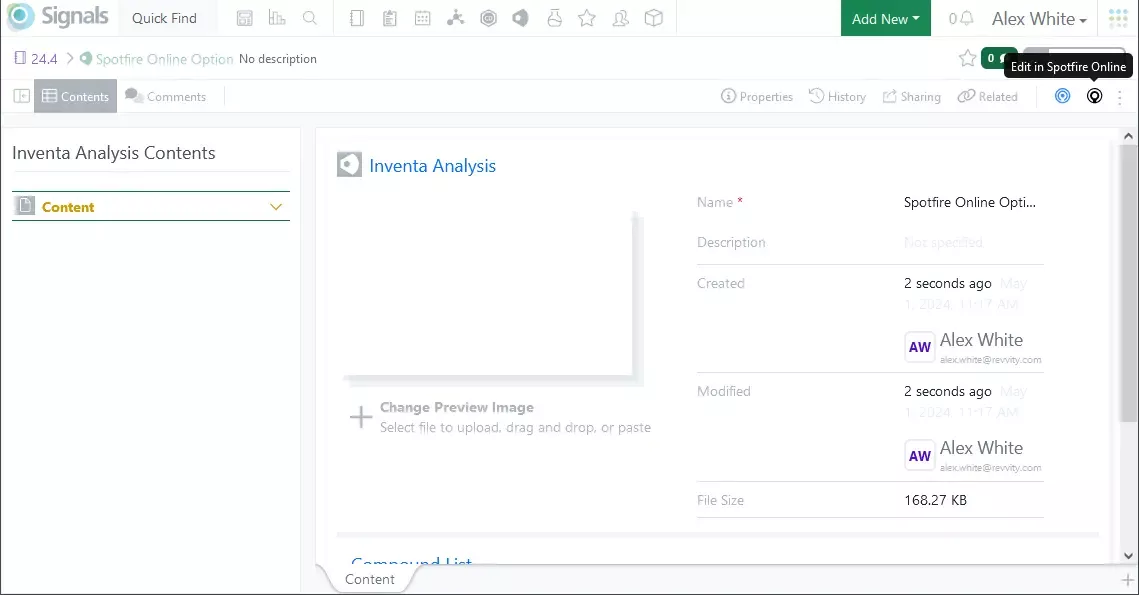
Users now have the option to edit and view Spotfire Files and Inventa Analysis Objects within their web browser, previously available in beta, is now available to all systems. Spotfire Online requires no installation, is Mac compatible, and opens in a new browser tab.
Adding a Spotfire File creates a blank Analysis file (previously loaded a local file), previously available in beta, is now available to all systems. Inventa Analysis Object now allows the option of choosing the opening method on creation (previously opened automatically in the locally installed Analyst).
The locally installed Spotfire for Signals Analyst is still available and is the suggested option for designing & creating advanced dashboards & workflows from scratch.
VitroVivo
To improve the user experience, and reduce the number of clicks: Signals VitroVivo workflows containing an Editable Data Grid App pulling data from an ADT in a Notebook Experiment will see the content of the data grid refreshed automatically when the name of the ADT selected in the workflow matches.
The default Spotfire alphabetical ordering was inadequate for labelling rows of 1536 wells plates and has been replaced in the Data Import App by the order corresponding to the plates labels expected by the scientific community (A -> Z followed by AA -> AF).
Inventa
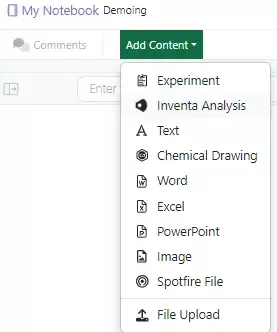
Users can now directly add a new Inventa Analysis to a Notebook via the Add Content menu.
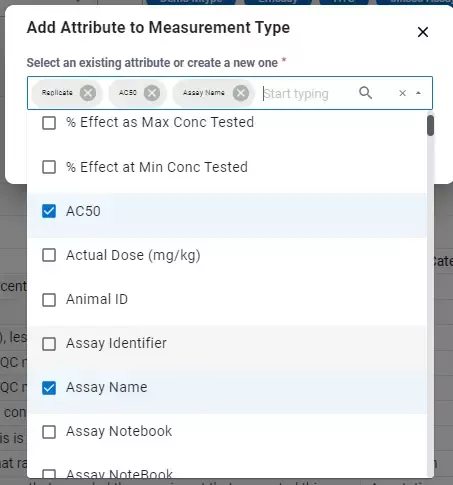
Admins can add multiple measurement attributes at once when modifying measurement types.
Synergy
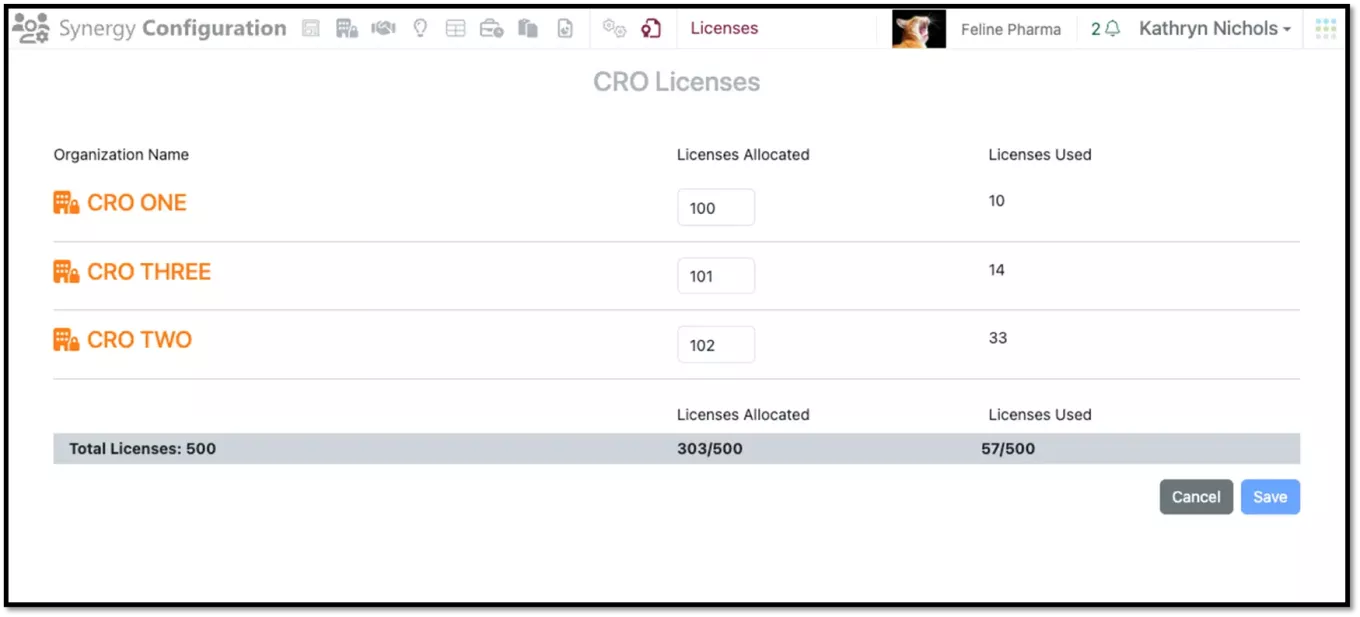
On the Administrative side, System and Synergy Administrators (Sponsors) can now allocate Synergy CRO licenses on a per CRO basis. As a result, a given CRO (or other external partner) cannot license more users than their assigned allocation, allowing the Sponsor to reduce the administrative burden of managing user turnover and dynamic business needs often experienced when working with external partners.
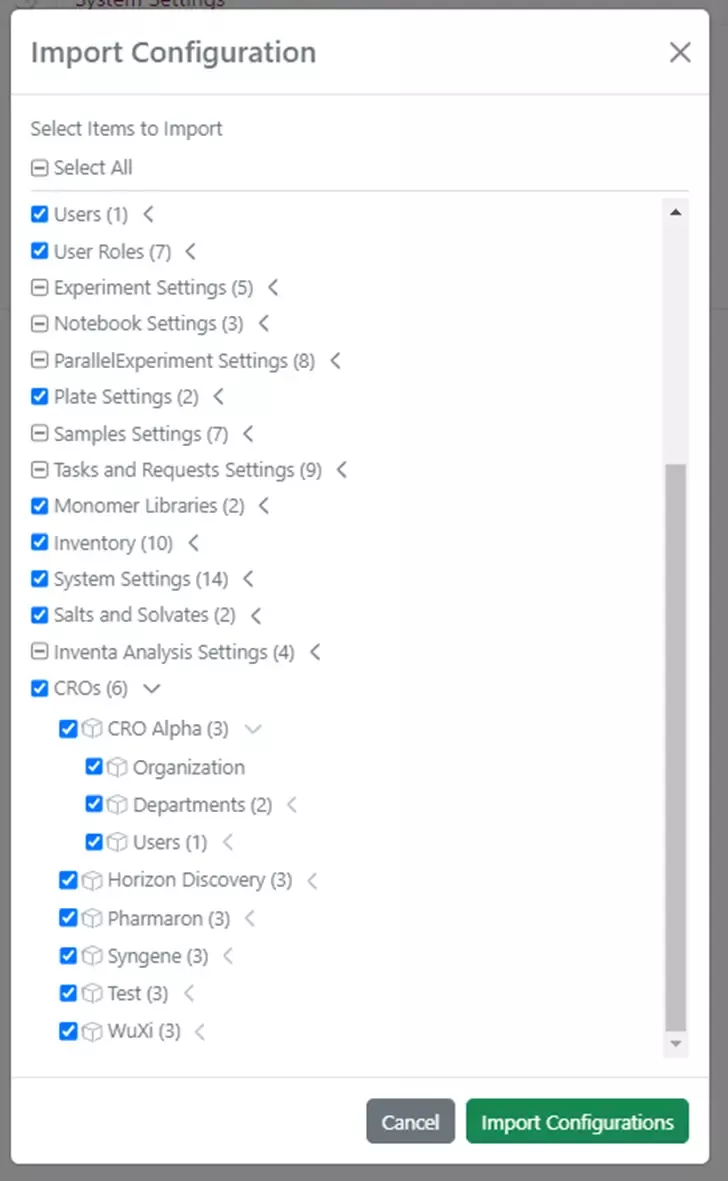
In addition, Synergy-related Roles and Privileges, as well as CROs and CRO users can now be transferred from one tenant to another using Configuration Transfer.

In Synergy, the Sponsor user can now recall a Work Order that has been sent to a CRO as well as Reopen a Rejected Work Order.
Chemistry
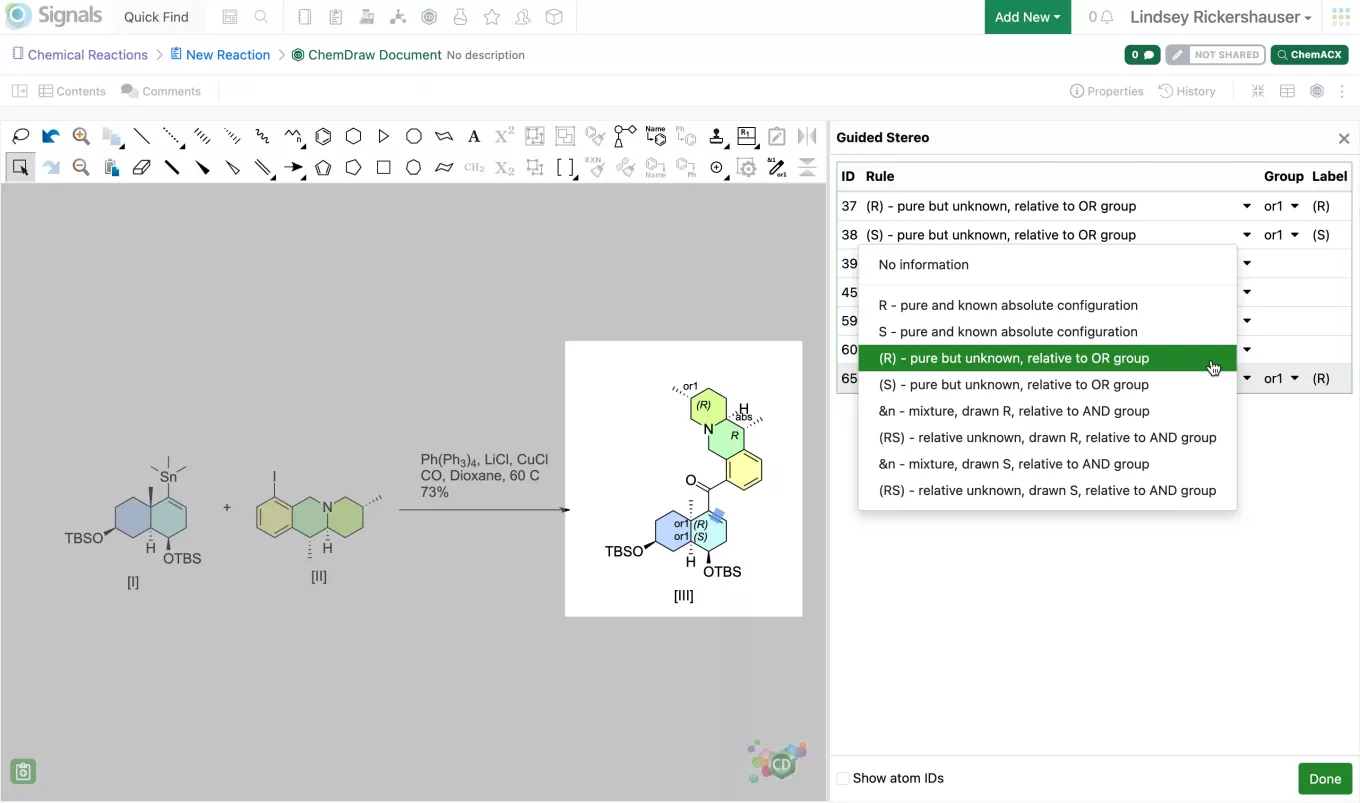
The “Enhanced Stereo Annotation” tool is now available to all systems.
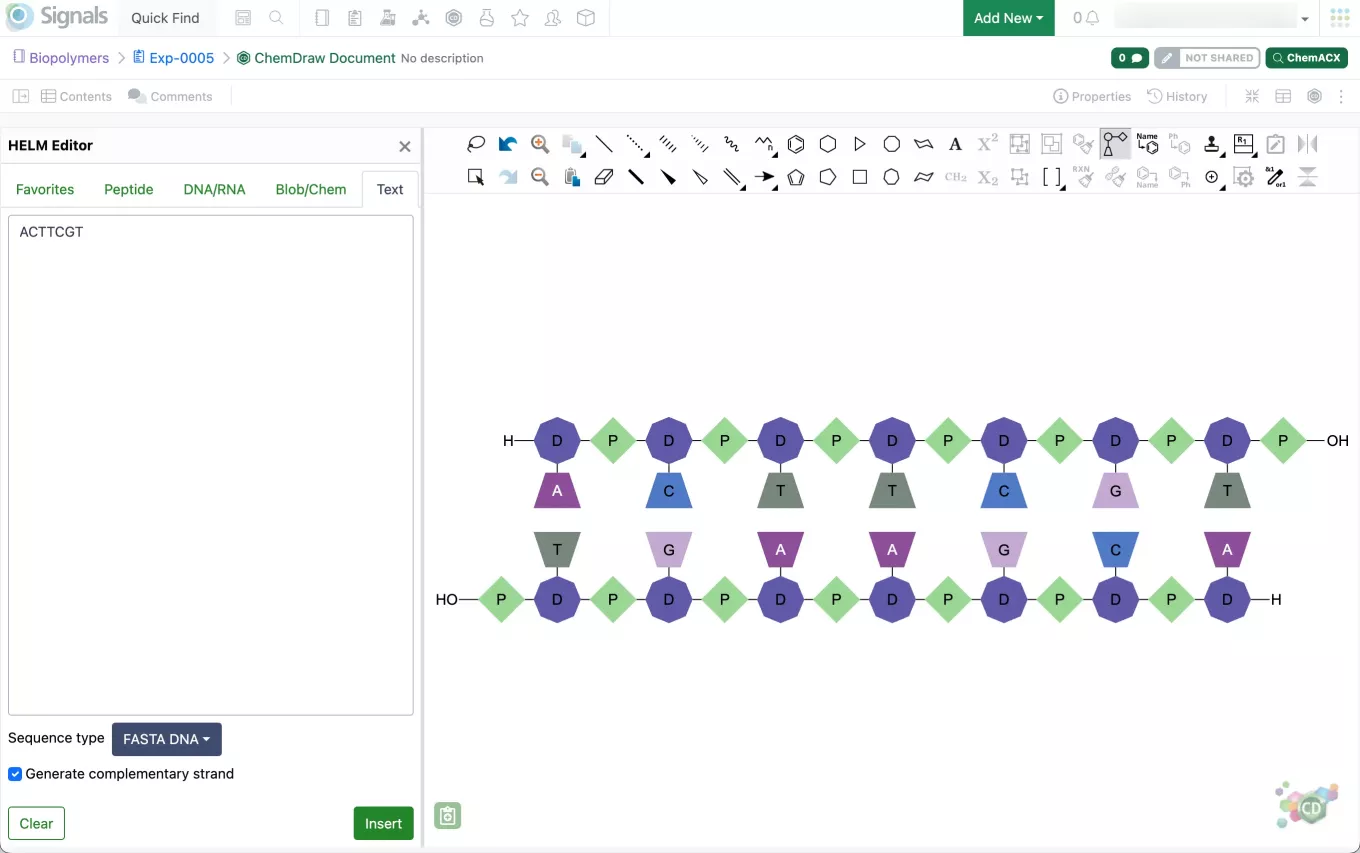
Complimentary strands of DNA/RNA can now be generated in ChemDraw via the HELM editor Text tab with sequence types FASTA DNA and FASTA RNA. The template strand will be inserted in the 5’ to 3’ direction on the canvas, with the compliment being aligned underneath in the 3’ to 5’ direction.
Admin Defined Tables & Variation Tables

The new function DATEADD allows addition of a time duration to a Date/Time. A statement such as TIMEADD([Start], [Duration], “unit”) is used, supported units include “Millisecond”, “Second’, “Minute”, “Hour”, “Day” and “Week”. The function must be set up on a Date/Time property, likewise the Start Time must be of type Time/Date. The duration must be of type Number, alternatively a property of type Number with Unit, with the Duration “measure” can be used in place of both the duration and units, following the format TIMEADD([Start], [Duration].
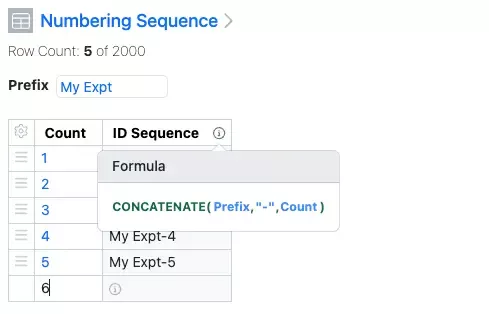
A CONCATENATE function allows multiple strings to be combined in a column of type Text. A statement such as CONCATENATE([ColumnA], “text”, [ColumnB]) will provide a results string with the relevant column values and strings as a single text string.
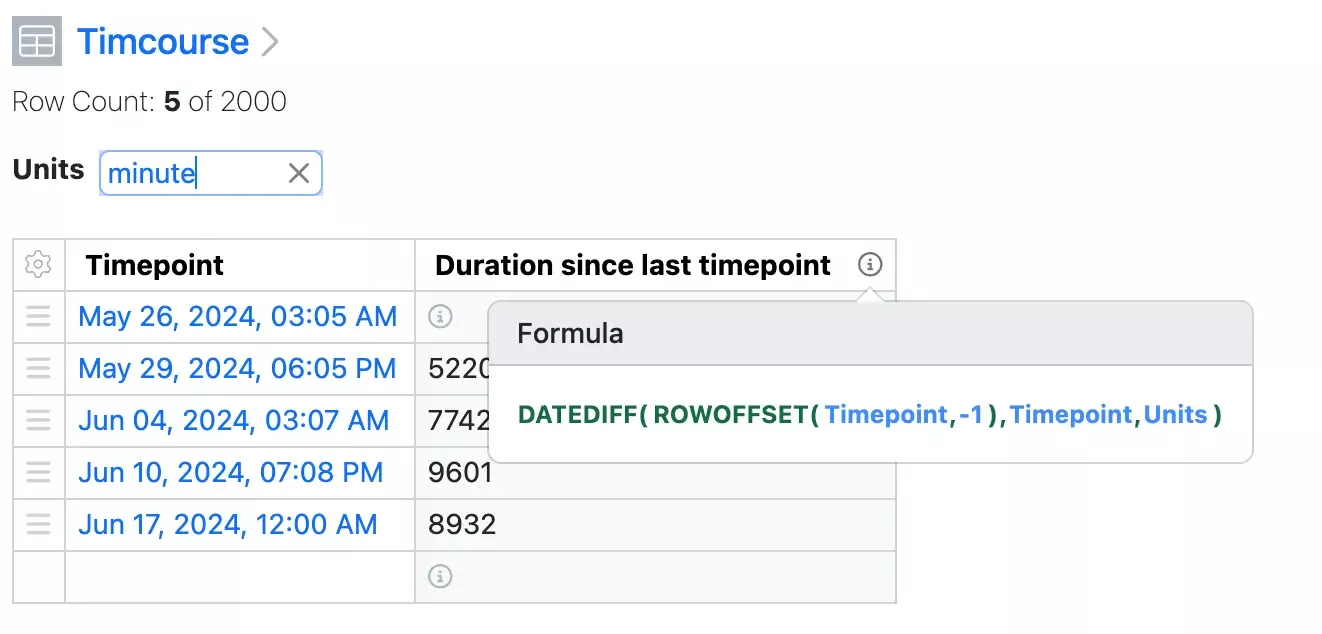
A ROWOFFSET function allows values from a differing row to be used in a given row based calculation. A statement such as ROWOFFSET([Column], offset) will provide the value from a previous or following row for the stated column, where an offset of -1 is the previous row.
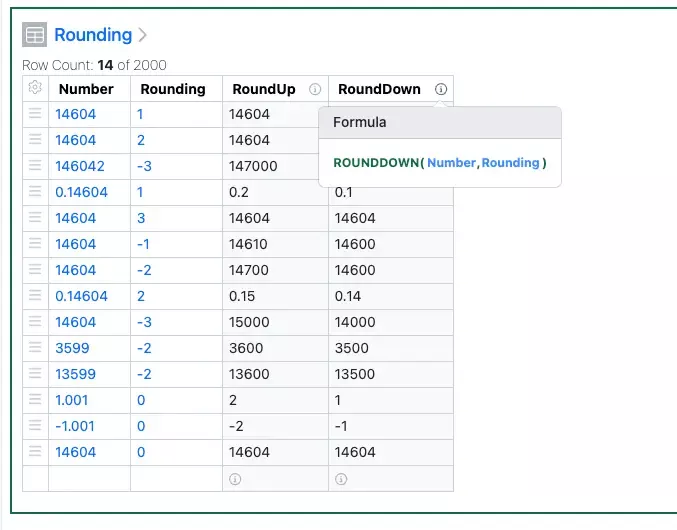
ROUNDUP and ROUNDDOWN functions allows numbers to be rounded to the nearest unit, either Up (away from zero) or Down (towards zero). A statement such as ROUNDUP([Column], rounding), whereby the Column is a number and rounding is an integer, will round the number to the relevant unit A rounding of 0 rounds to ones, -1 to tens, -2 to hundred, 1 to tenths, 2 to hundredths etc.
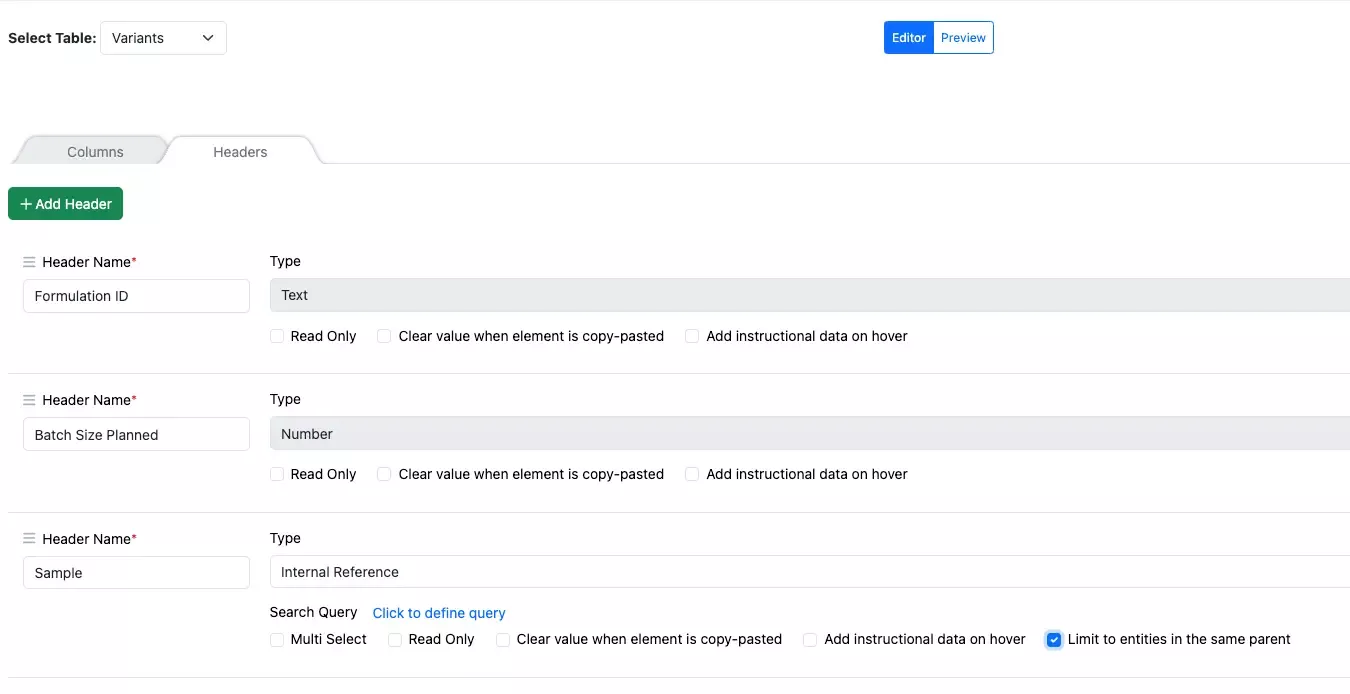
Properties of type Internal Reference in Variation Tables can also now be limited to only return entities in the same Experiment.
Inventory
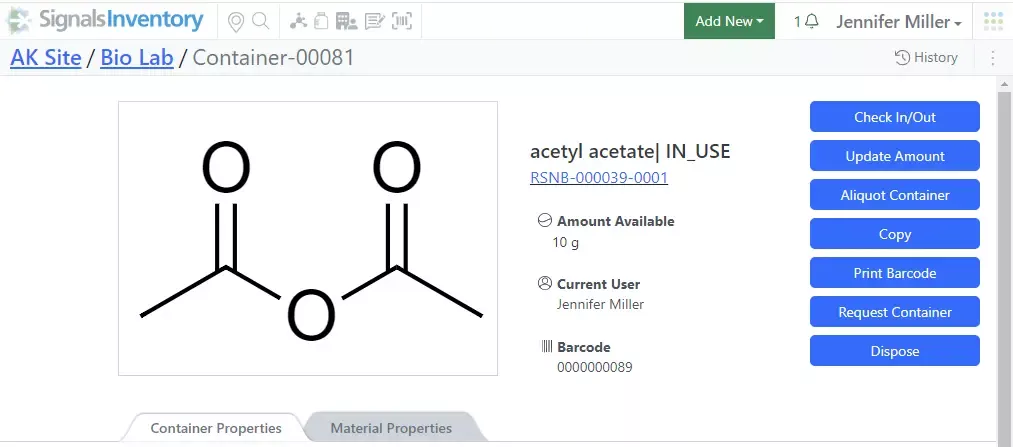
Users with access to containers will be able to see the history of the container by clicking on the History button in the top right corner:
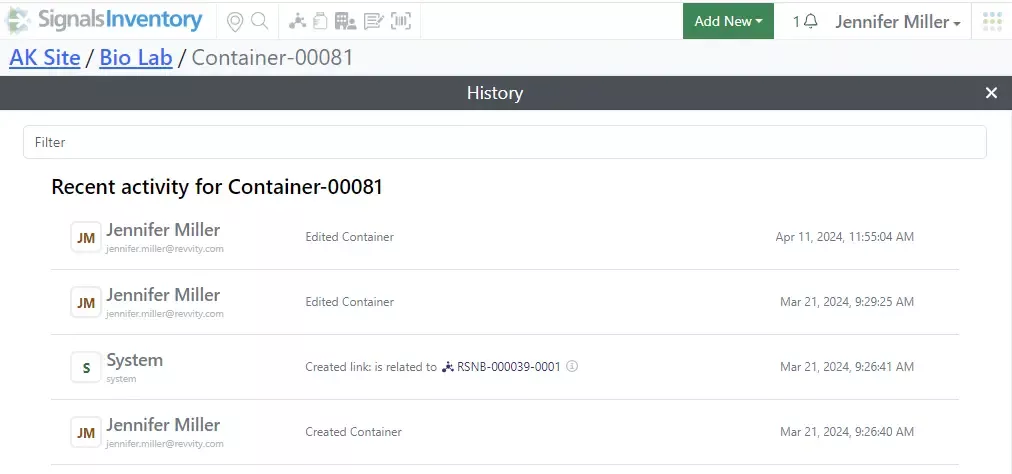
A new page will open with the latest changes to the container. Users do not need access to the audit trail to see the history:
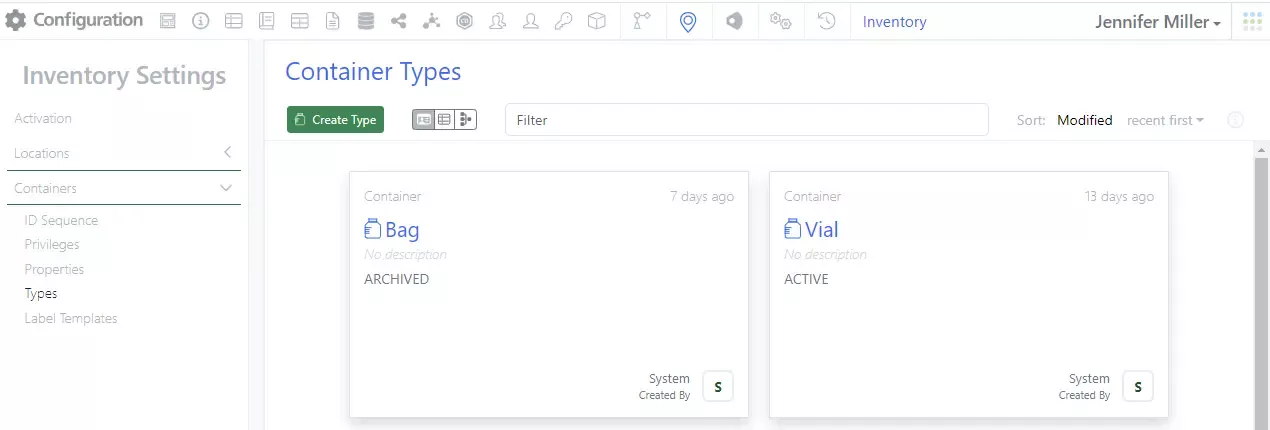
Administrators can now archive a location or container type. To archive a location or container type, navigate to the type and open the details view:
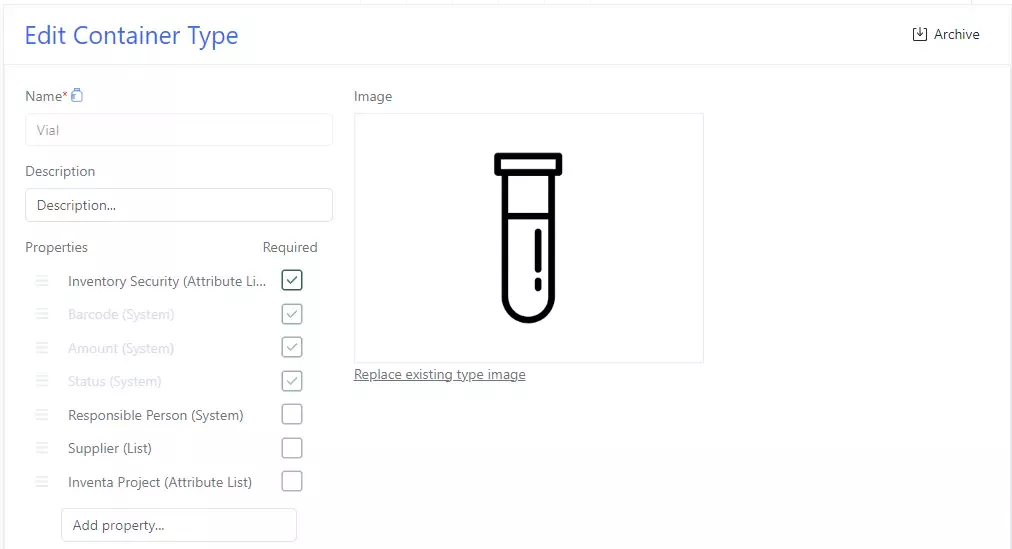
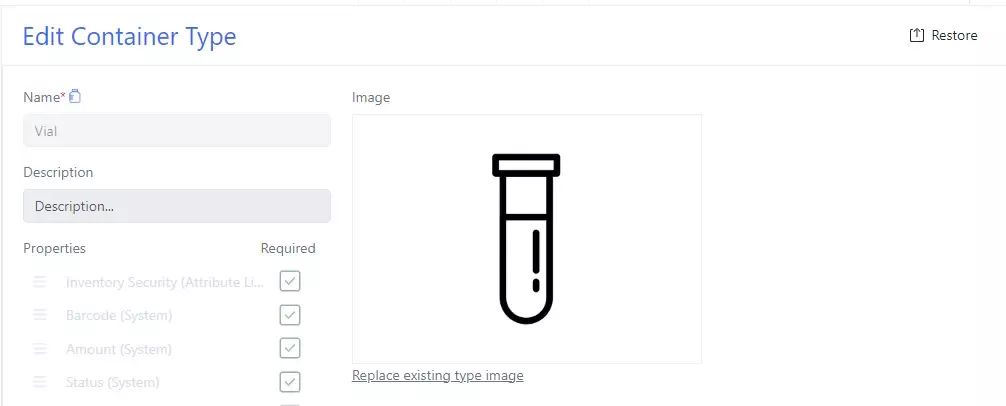
In the upper right corner will be the Archive option. If the type has already been archived, a Restore option will be available instead:
Archived types will prevent users from creating more instances. The Properties will be greyed out on the details view and will no longer be available for editing. The card view will display the archived status.
Administration
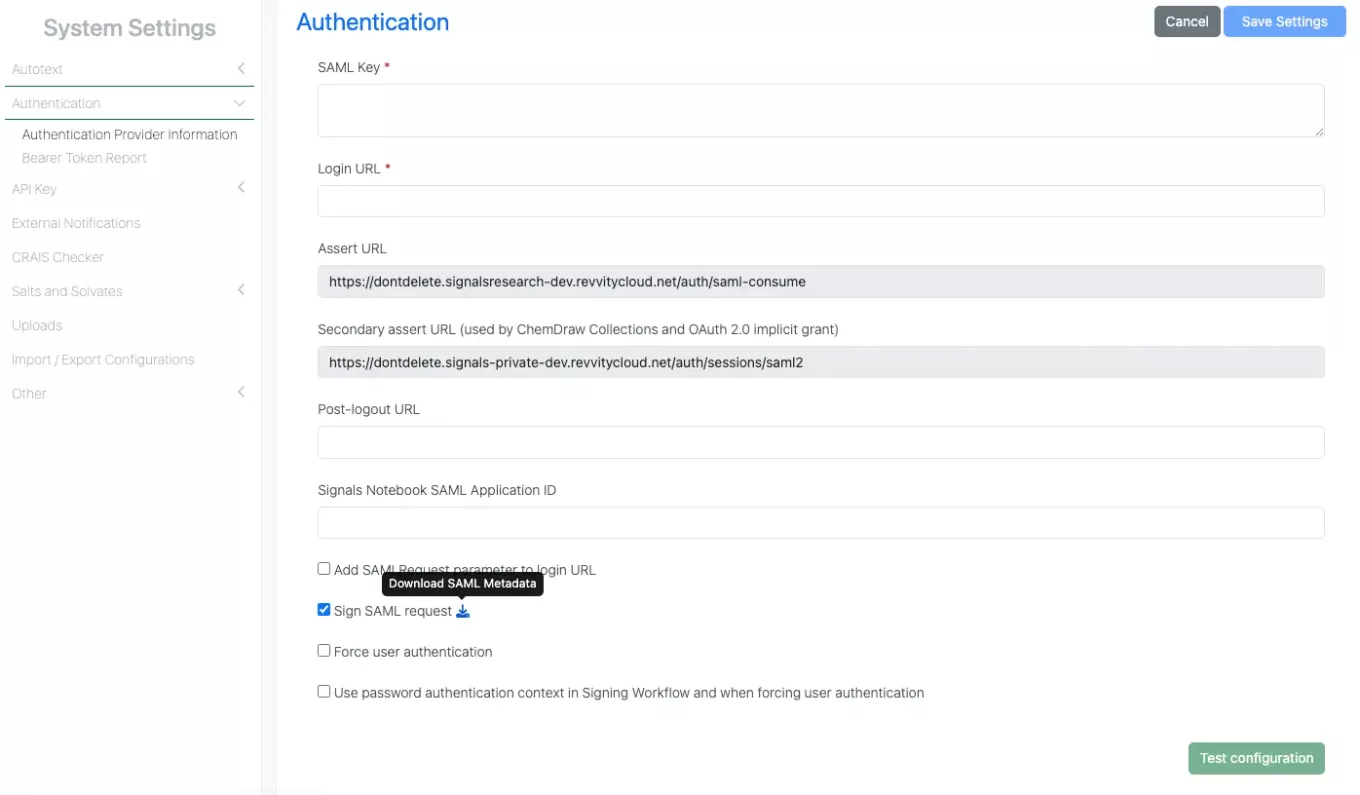
Organizations are now able to require that during authentication using an external Identity Provider (IdP, that the SAML request is signed. The administrator can configure their external IdP authentication workflow by selecting the “Sign SAML request” option, where a current Revvity certificate, to validate the request can also be downloaded.
Integrations & APIs

Monomers can now be deprecated and restored via the API. There is one new endpoint for each action.

A set of endpoints has been added to manage annotation layers on plates. There are endpoints for fetching, creating, updating, and deleting annotation layers of a plate container.
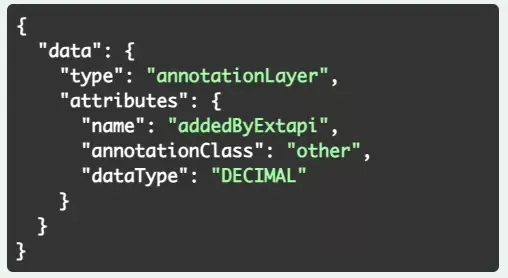
When creating a new annotation layer an annotation class must be specified in the POST body. The available classes are wellformat, concentration, material, amount, replicate, deviation, and other. When using “other” you must specify a data type of DECIMAL, TEXT, or INTEGER.
We enhanced the /entities/{eid}/export to allow for Plates to be exported as CSV, as opposed to .json by default, when specified in the “format” url parameter.
The following capabilities are in beta and are available for users, administrators and developers on the Signals platform upon request. Please contact your account representative or our support team if you would like access to the following features.
Inventa

The Integrated Summary App introduces two new enhancements. Users can now reorder measurement selections using the handles in the Criteria Summary panel.
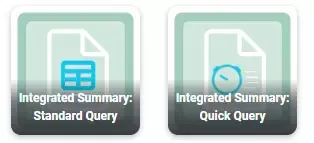
Users can take advantage of the new Quick Query mode to retrieve data even faster. Quick Query mode can be accessed directly from the Inventa Dashboard or as an option when creating a new Inventa Analysis
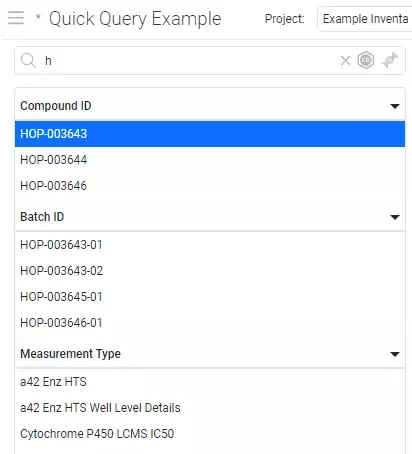
Integrated Summary’s Quick Query allows you to quickly drill down into a particular set of data focused on a single asset, a batch/lot, or a measurement type. Use the type ahead to find an entity or measurement type of interest

Further limit your results based on a custom date range or use one of the convenient date shortcuts (today, last week, this year, all time, etc)

Retrieve an instant summary of your selected data
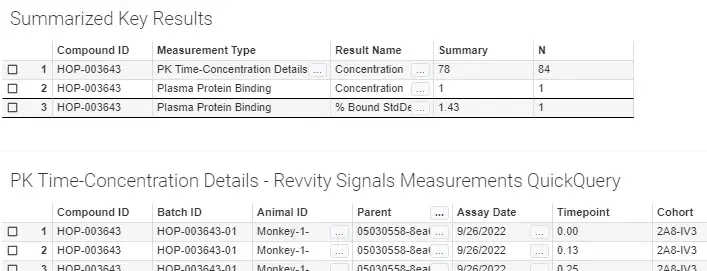
And the download the full set of results, complete with a Summarized Key Results table and individual measurement tables.
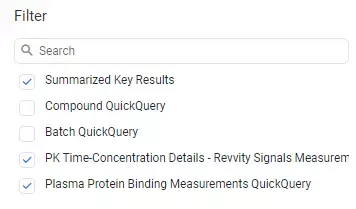
Tables can be conveniently toggled to best leverage viewing space.
Admin Defined Tables & Variation Tables
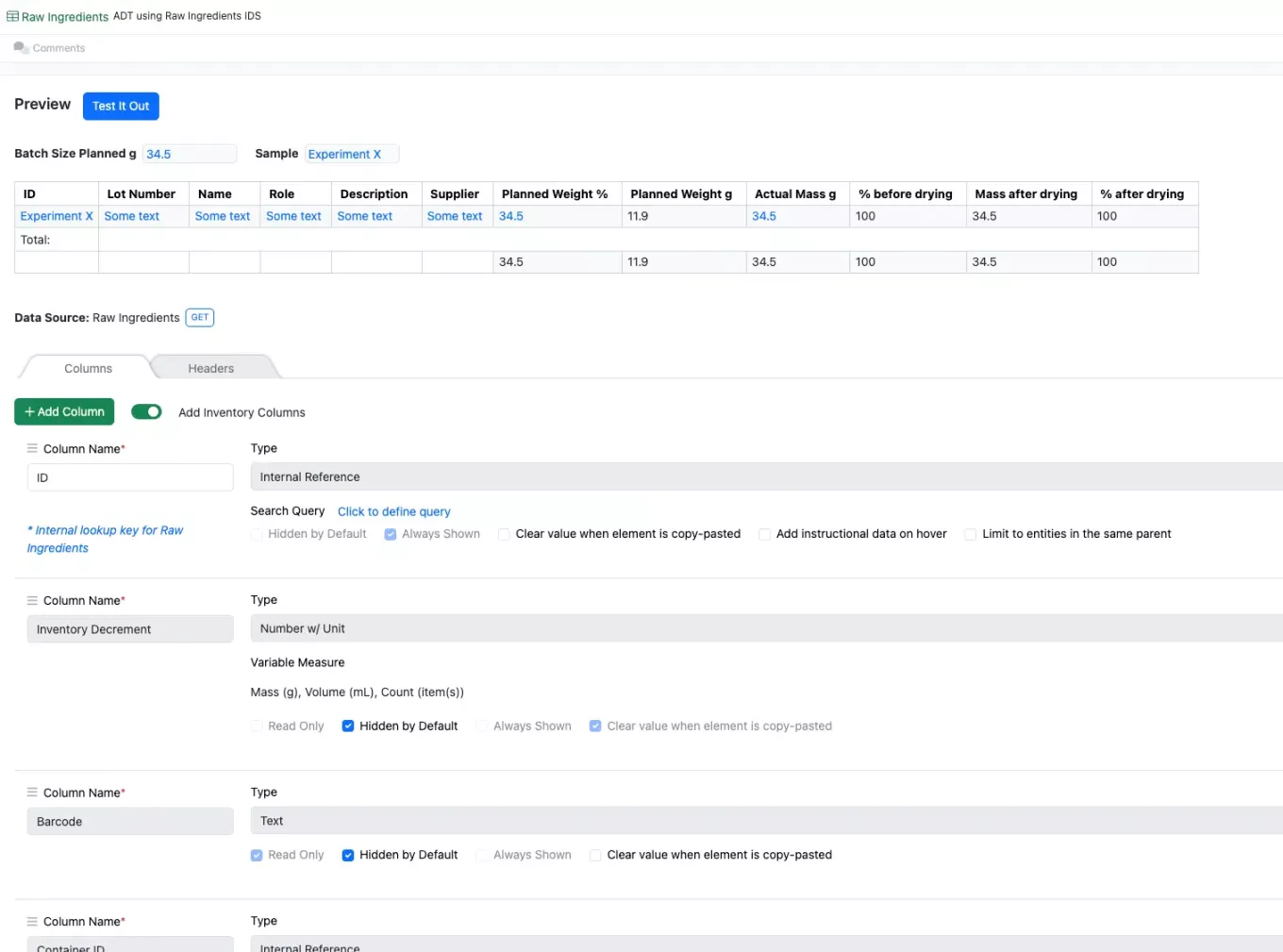
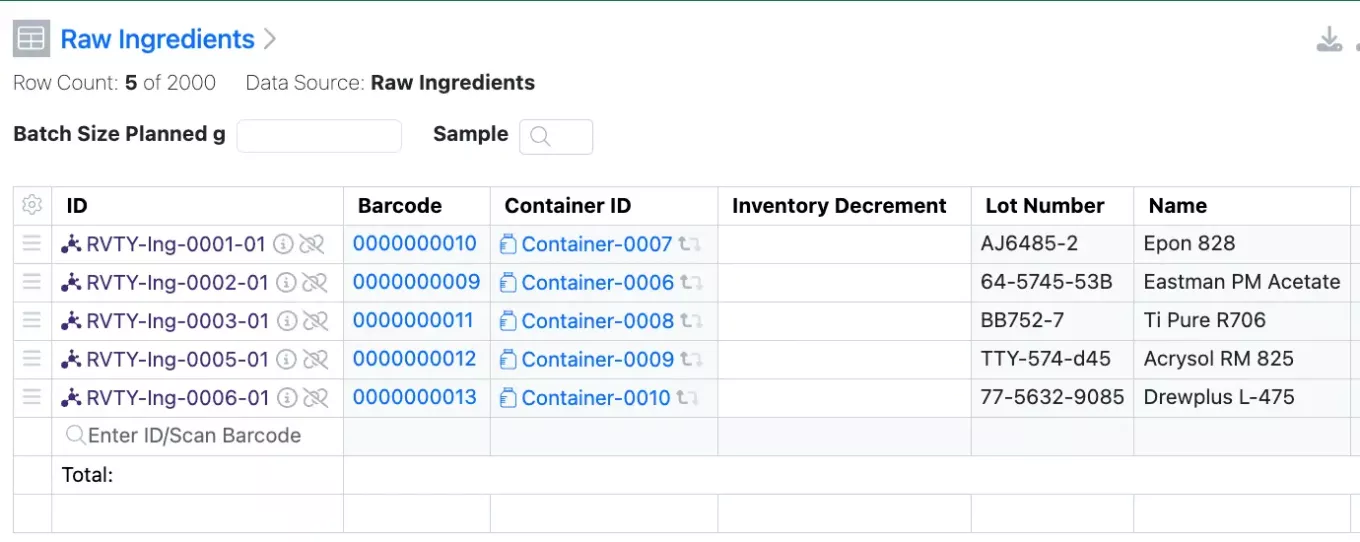
Admin Defined Tables and Variation Tables can now be linked to Inventory if the table template uses an Internal Data Source. The admin can choose to add inventory columns, which adds Barcode, Inventory Decrement and Container columns to the ADT, or Components. The scientist can then enter a barcode into the ID column and the related Material will be imported into the table along with associated data. The user can also change the container to another container with the same material.
What's New
In this version 24.5 release we are excited to announce the release of SaaS Signals Synergy, a new product offering with Signals Notebook or Signals Research Suite for efficient and effective management of collaboration with contract partners. Signals Synergy provides simplified administration setup of CROs, powerful automated security features, kanban-style project management, Ideas and Designs for drug ideation, and the Synergy Data Exchange for parsing unstructured CRO reports into structured columnar data tables. Signals Synergy is built on the same platform as Signals Notebook and Suite for seamless integration of internal and external data.
Further, 24.5 delivers an improved ability to see the template that content was created from, and to export data from the Materials grid view. We have improved curve fitting in VitroVivo and improved the Material library integration in Signals Inventa. We have extended our calculation used in Admin Defined Tables and Variation Tables to include a time difference and improve our existing IF calculations. We have continued to work on our ongoing beta capabilities for the Integrated Summary App, and for Normalized Compounds, our prior beta capabilities around Tasks and Requests are now available for all systems. We have new beta capabilities around stereochemical annotation in ChemDraw Documents, and to add monomers to custom HELM libraries. Finally, we have also fixed a number of small bugs.
The following improvements are available for users of Signals Notebook Individual Edition, Signals Notebook Standard, Signals Notebook Private Cloud, Signals Research Suite Standard, Signals Research Suite Private Cloud and Signals Synergy. Certain features may only be available with appropriate licensing and/or with enablement by an administrator.
• Fundamentals
– Origin Template displayed in Properties
• VitroVivo
– Include Multiparametric curve fitting constraints to the Calculations Explorer
– Goodness-of-fit R-squared (R^2) measure is now available in all the fits, not only in the logistic fits
• Inventa
– Create measurement types using an example file
– Material Library as source of truth in Data Factory
– Reorder material selection attributes in Integrated Summary App (beta)
– Bio Sequence querying in Integrated Summary App (beta)
• Synergy
– Synergy and Synergy Configuration are new applications for managing collaborations with contract partners (e.g., CROs). Available only to licensed systems.
– Creation of CROs, CRO users, CRO Departments, and Collaborations with automatic security
– New licensed user type “Synergy CRO User” with controlled access through Synergy CRO application
– Security and IP protection features built-in for CRO users, such as automated CRO ring fencing, Hidden from CRO properties visible only to Sponsor users, and ExIDs for masking Material IDs
– Ideas and Designs for gathering newly proposed structure designs prior to synthesis or registration
– Work Orders creation and management via kanban-style boards for both internal (Sponsor) users and CRO users
– Reference Tables within Work Orders allow for partial sharing of Material or Design properties and masking Material IDs
– Synergy Experiments allow the CRO user to record their experimental record in response to Work Orders with dedicated workflows and security features
– Synergy Experiment initially support the following content: Text, Chemical Drawings, Word, Excel, Powerpoint, Samples, Tables, Biological Sequence, Image, Spotfire File, Worksheets, and File Upload
– Synergy Data Exchange provides excel-based CRO report parsing into structured data tables
• Chemistry
– Enhanced Stereochemical Annotation tool (beta)
– Add new monomer to custom HELM libraries (beta)
• Admin Defined Tables
– Time duration calculations
– IF calculations support empty values
• Materials
– Administrators can include internal reference properties in uniqueness check rules for Materials
– Normalized Compounds (Beta)
• Tasks and Requests
– Assign an Analyst during Task Creation and from the Task Container available to all systems
– Create Tasks from Materials in Experiments available to all systems
– Notification for Task creator regarding assigned analyst access available to all systems
– Notification for Analysts when assigned a Task available to all systems
– Create an Experiment from a Task Container available to all systems
• Integrations & APIs
– POST/ endpoint for bulk import of monomers to custom libraries
– GET/ endpoint to obtain an example file for importing monomers in batches
– GET/ endpoint to get a report of a monomer bulk import job status
– GET/ endpoint to obtain report of failed monomer bulk import jobs
– New Endpoint for syncing entities with updated Template
– Templates included in API Responses
– New Endpoint for Batch/Lot transfer
– Expanded Character set for Material/Lot naming via API
We also fixed several small bugs in this release. Details of the enhancements are described below.
Developers in Signals Notebook and Signals Research Suite should note that Inventory is now updated to give more meaningful error codes, the error codes provided via the External API now align with the user interface, specifically regarding 4xx (400, 409 and 412) error codes. The following codes are now returned: 456 (BARCODE_IN_USE), 457 (INVALID_COORDINATES), 458 (NAME_IN_USE), 459 (TYPE_NOT_EDITABLE), 460 (ANCESTOR_NOT_EDITABLE), 461 (PROPERTY_OR_FIELD_NOT_EDITABLE), 462 (ENTITY_IN_USE), 463 (NOT_A_GRID),464 (INVALID_TYPE), 465 (CONTAINER_NOT_DISPOSED), 466 (CONTAINER_DISPOSED_OR_FINAL_DISPOSED), 467 (TYPE_NOT_SUPPORTED), and 468 (VALUE_OUT_OF_BOUND).
Due to a change to a third party component used in Signals Notebook, image editing capabilities in our Text Editor will no longer be available. All images will need to be appropriately formatted prior to addition to such elements. This change will take effect in a future release.
Administrators are recommended to subscribe to the channels within our support news site found at https://support.revvitysignals.com/hc/en-us/categories/360004446171-Support-News which contains more information about releases and other pertinent product information.
This content is anticipated for release on our Production E3 environments, and for Private Cloud customers on our deferred release schedule, in November 2024.
Further Details
The following improvements are available for users of Signals Notebook Individual Edition, Signals Notebook Standard, Signals Notebook Private Cloud, Signals Research Suite Standard and Signals Research Suite Private Cloud. Certain features may only be available with appropriate licensing and/or with enablement by an administrator.
Fundamentals
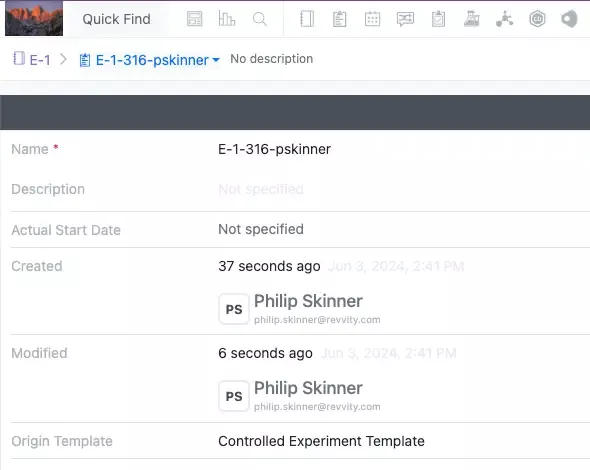
The Origin Template is now displayed for objects derived from a System Template, including Experiments, Admin Defined Tables, Variation Tables and Worksheet. The Origin Template is displayed in the Properties and reflects the current name of the System Template used.
VitroVivo

The new multiparametric analysis is particularly important to simultaneously analyze data from instruments producing multiple readouts (e.g. multimodal plate readers or flow cytometry instruments). The settings of the fits can be edited, under the “Manage Fittings” tab of the Calculations Explorer Controls, based on names (parameters) included in a specific column of the data and the impacted curves are listed. Furthermore, the Calculations Explorer templates can now be saved in this new modality.
The goodness-of-fit R-squared (R^2) measure is now available in all the fits, not only in the logistic fits.
Until now, the R^2 measure could be added using the add coefficient toggle. However, this toggle was only present in the logistic fittings. Thus, in the rest of the fittings, the R^2 could not be added to the raw table. Adding the R^2 measure is now possible for all fits.
Inventa
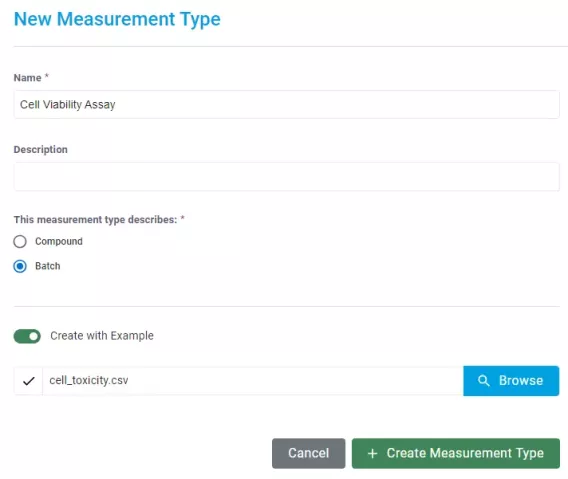
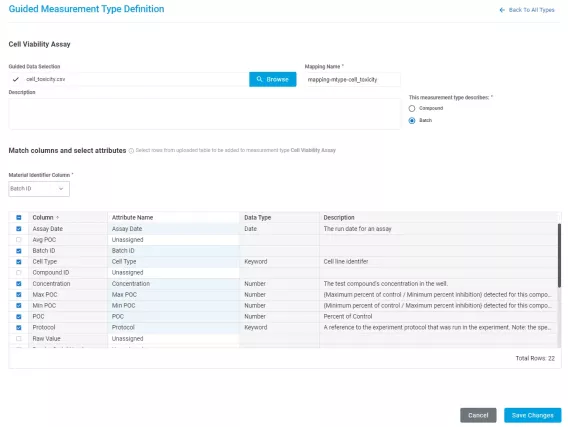
Administrators now have the option to use an example file as a guide for simultaneously creating a new measurement type and a corresponding map.

When a Material Library has Inventa Sync enabled, it serves as the source of truth in Data Factory. Updates to synced materials must originate directly from the Material Library and cannot be overridden by user-added files. Mapped entity attributes will always reflect the most current material record definitions, even if the value is blank.
Synergy
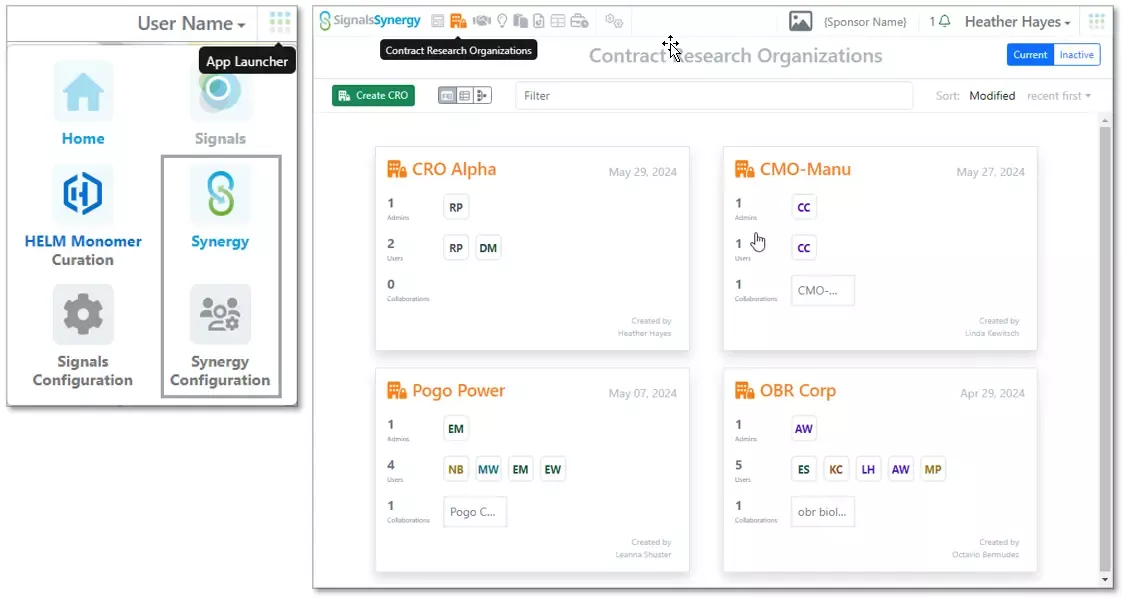
Signals Synergy has a dedicated Synergy Configuration application for setting up Contract Research Organizations (CROs; or other contract partners), creating and licensing of Synergy CRO Users, and configuring Synergy related entities.
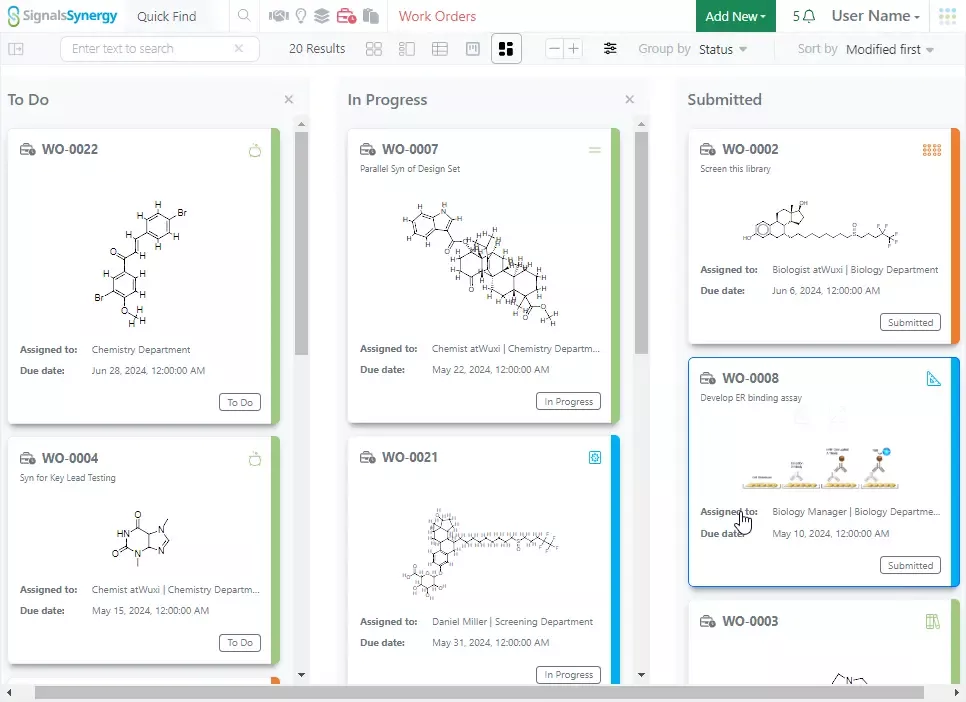
Inside the new Synergy app, Sponsor users can manage collaborative work with their CROs. First, users can request work from a CRO using a new system object, Work Orders. Work Orders are prioritizable, group assignable to CRO Departments, and contain traditional content elements such as Chemical Drawings. Progress of Work Orders can be tracked using built-in project management tools, such as Kanban-style Work Order boards.
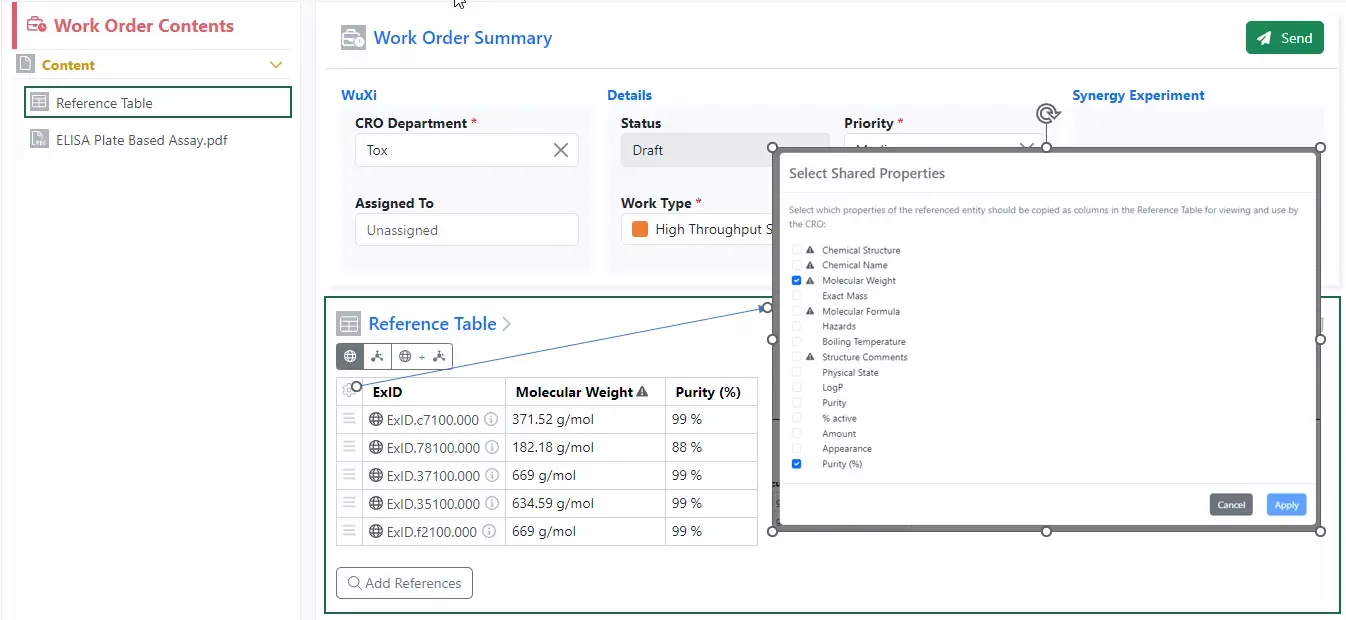
Work Orders can also contain Reference Tables. Reference Tables allow the user to selectively share properties of Materials or Designs required for the requested work. Reference Tables allow the user to automatically mask the Material IDs using ExIDs and select only a subset of material properties to be seen by the CRO.
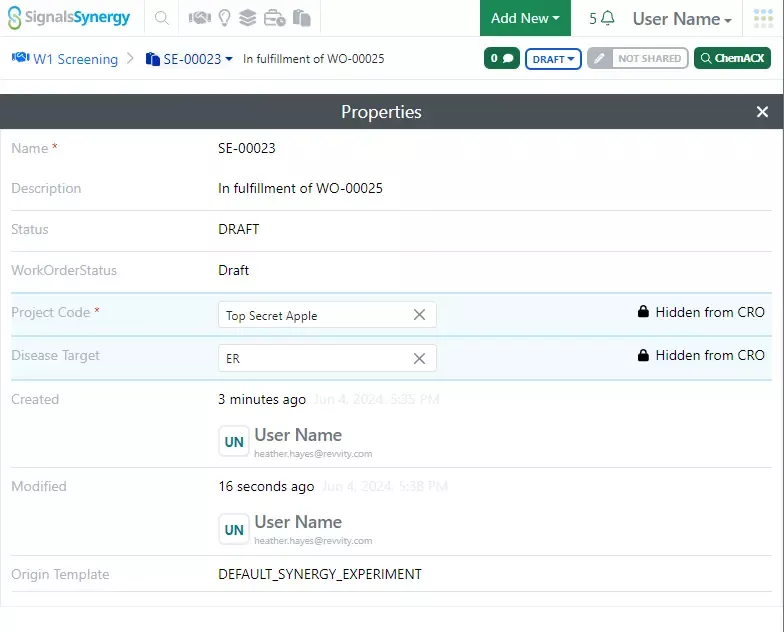
To fulfill a Work Order, Synergy Experiments allow CRO users to capture their experimental record and submit their work back to the Sponsor for review. Synergy Experiments are very similar to existing Experiments, supporting content such as Text, Chemical Drawings, Word, Excel, Powerpoint, Samples, Tables, Biological Sequence, Image, Spotfire File, Worksheets, and File Upload, but provide dedicated workflows for Sponsor users and CRO users, as well as specialized IP security features.
Synergy Experiments and Collaborations support a new property type, Hidden from CRO properties. Hidden from CRO properties (configured as Hidden from the CRO at the template level) are available for internal Sponsor users to organize and search for objects, but are always hidden from CRO users.
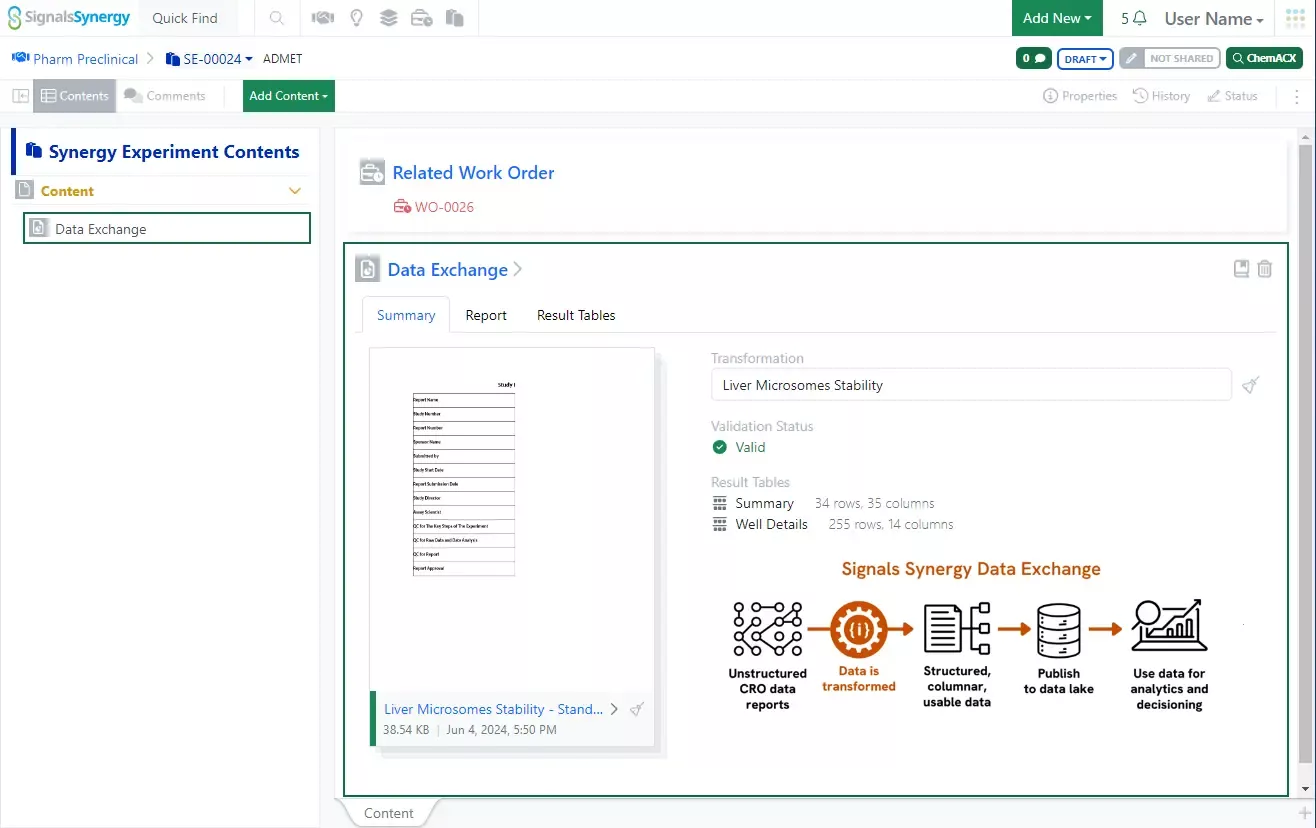
Synergy Experiments also support the new Synergy Data Exchange element, which automatically transforms excel-based CRO reports into structured data tables ready for publication to Inventa or download as CSV.
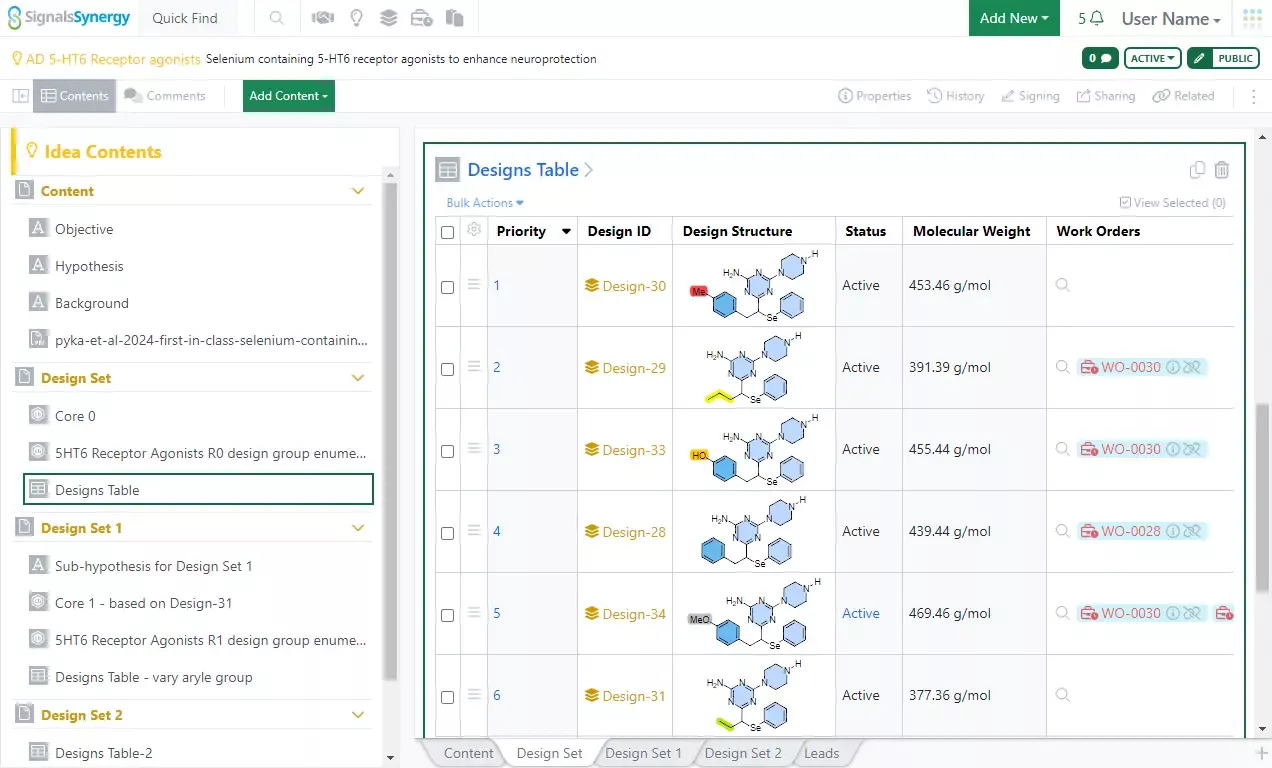
In addition, Ideas and Designs are new system objects for capturing drug ideas. Ideas contain Designs Tables, which allow the user to create, capture, and prioritize drug designs. Work Orders requested for each Designs are also captured at the Design level for track-ability.
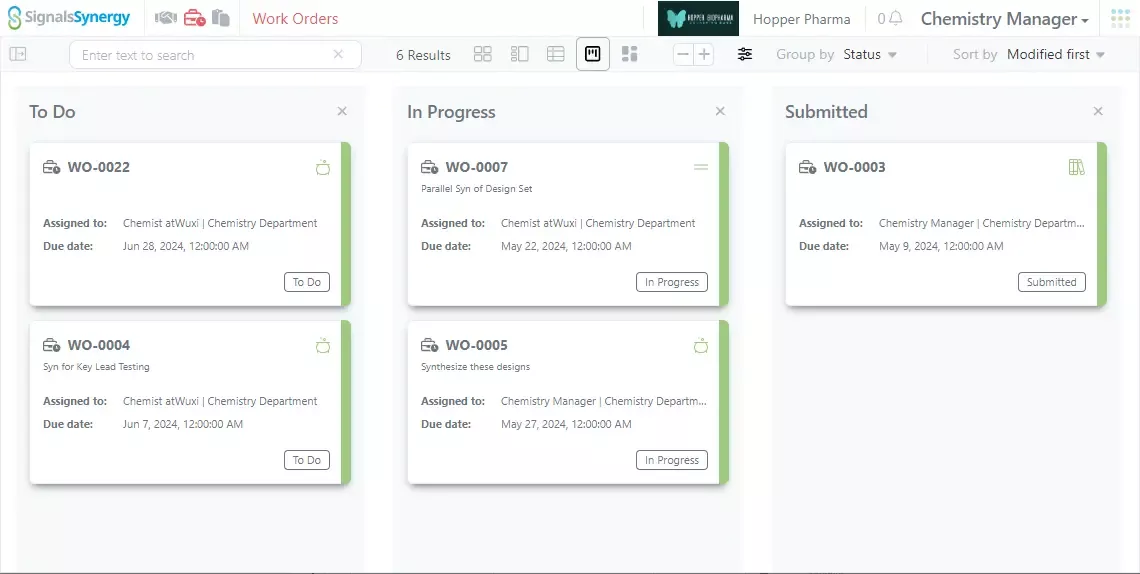
Finally, CRO Users access and easily manage their Work Orders and Synergy Experiments through the dedicated Synergy CRO application. The distinct Synergy CRO User type and dedicated application allows us to provide automated ring fencing of CROs, filtering of proprietary information such as Material IDs and Hidden from CRO properties, and easy work prioritization through the Kanban Boards.
Admin Defined Tables
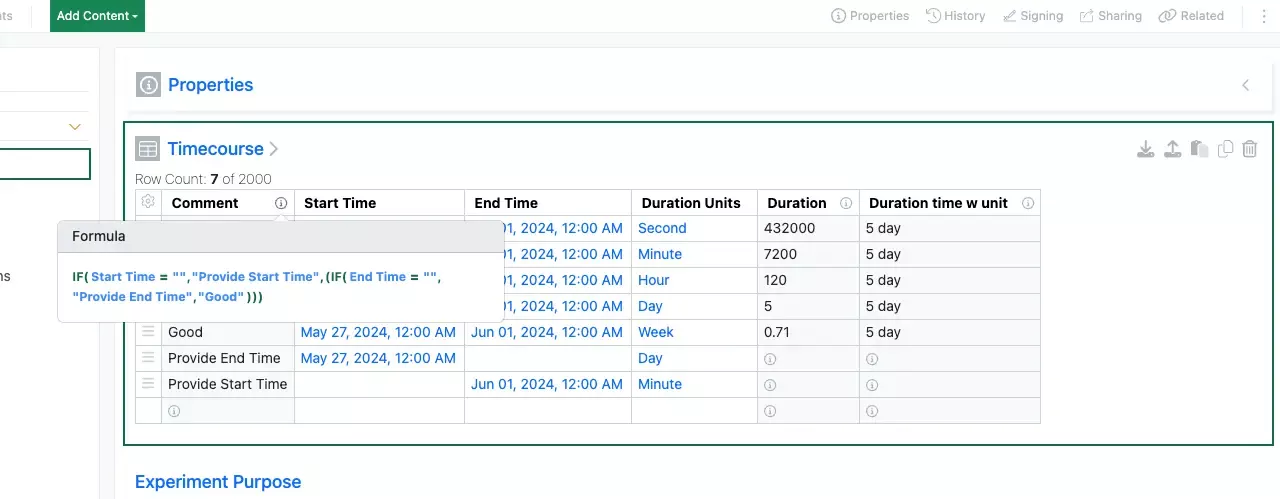
Admin Defined tables now support a time duration function and IF functions support definition of behavior when a referenced cell does not contain a value.
Reference of a cell in an IF function in an Admin Defined Table now allow the admin to define behavior if the referenced cell has no value. A statement such as [Column] = “” is used to refer to the condition whereby Column has no value in that row.
The new function DATEDIFF allows calculation of a duration between two Date/Time properties. A statement such as DATEDIFF([Start], [End], “unit”) is used, supported units include “Millisecond”, “Second’, “Minute”, “Hour”, “Day” and “Week”. The function can be set up on a Number property, alternatively a Number with Unit, with the Duration measure can be used. In such cases the units are not specified and the most logical unit is presented by the system.
These functions are also enabled in Variation Tables.
Materials
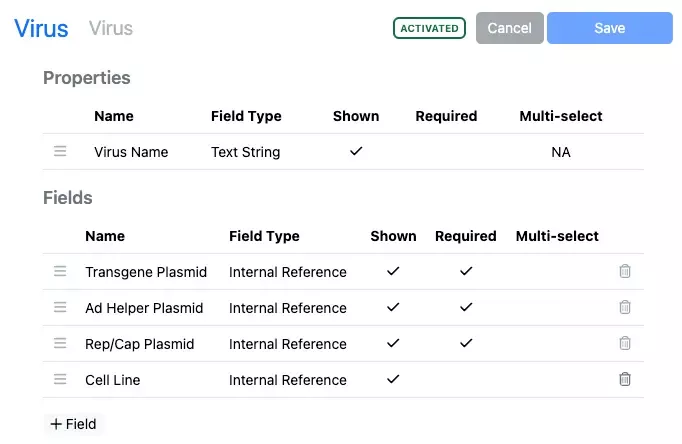
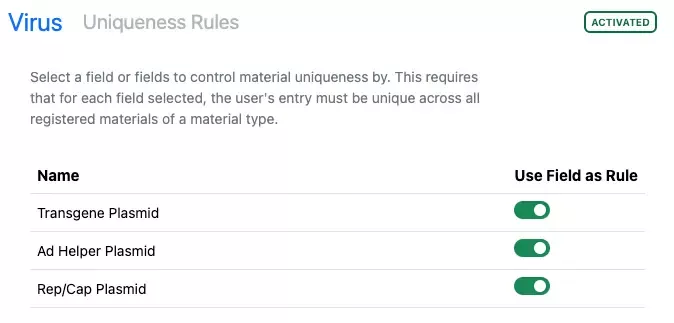
Administrators now have the option to include internal reference values in uniqueness check rules. To include an internal reference field in uniqueness check rules, the field must be set as single-select and required. The value of the internal reference name will be used in the uniqueness check rules once set:
Tasks and Requests
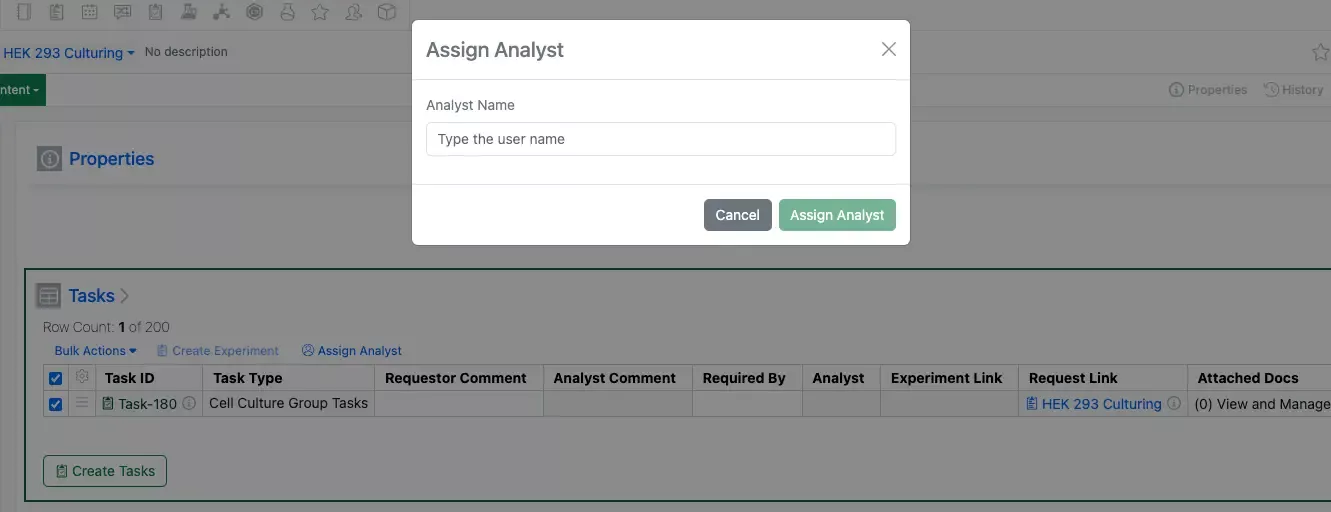

Several new Task functions, previously in beta, are now available to all systems. Analysts may be assigned during Task creation and from the Task Table. Tasks may be created from Materials Tables. Analysts have a new notification both in app and via email to inform them of when they are assigned a Task. Analysts may create an experiment directly from a Task table.
Integrations & APIs

Monomer libraries can now be bulk imported via the API. This is an asynchronous job and will bulk import monomers into an existing Monomer Library.

To begin the bulk import job, specify the .json file to bulk upload, and how to handle duplicates and use the endpoint POST /monomers/libraries/{libraryEid}/bulkImport. The response contains a Job ID. There are options for both symbol/polymer type/monomer type and structural duplicates to be treated as new monomers. These are the same options in the UI.
You can check the status of the job based on its ID using the endpoint GET/monomers/libraries/{libraryEid}/bulkImport/jobs/{jobId}. The status will be one of: READY, the job is ready to run; IMPORTING, the job is running; FAILED, the job is failed to run; or COMPLETED, the job is completed. If there is a failure you can get a report for the details via the endpoint: GET /monomers/libraries/{libraryEid}/bulkImport/jobs/{jobId}/failures.
Additionally, an example of a well formed .json file for importing is available via the endpoint GET /monomers/libraries/{libraryEid}/bulkImport/example.
For admin defined tables, worksheets, and variations tables who are out of date with the template they were created from can now be refreshed via the endpoint POST/entities/{eid}/syncWithTemplate.

Note that this will DELETE all existing content in the entity when updating to the new template version. This is same behavior as updating via the UI.
For entities that utilize templates the “systemTemplate” and the “template” are now returned in the “relationships” object for an entity in API responses.
The “systemTemplate” property returns the eid for the closest system template used in the creation of the object. The “template” returns the eid of the entity used to create the object.
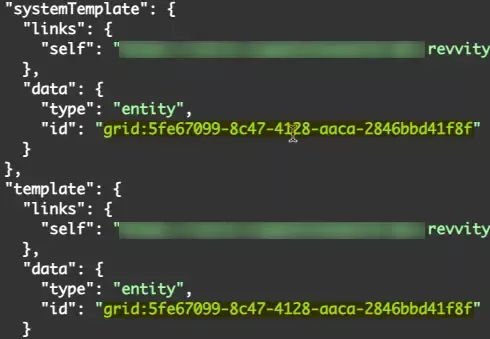
The object “Test Table Template” shows the eid for the System Template “Test Table Template” for both “systemTemplate” and “template”
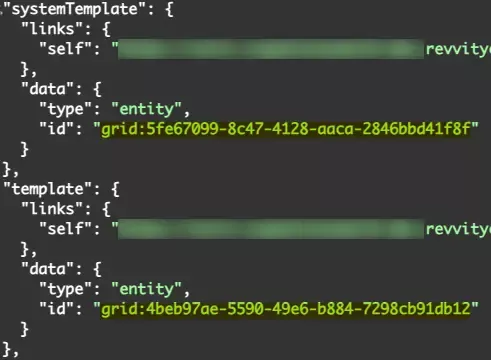
Whereby the object “copy of Test Table Template” shows the eid for the System Template “Test Table Template” for “systemTemplate” and the eid for the object “Test Table Template” for “template”

A new endpoint has been created to allow batches/lots to be transferred between assets as is currently possible via the UI, POST /materials/{eid}/transfer.
The originating asset and the target asset should be in same material library. When transferring the final batch of an asset to a new asset the originating asset will be deleted.
A restriction on special characters, except for “/”, for material Batch/Lot naming during creation via API has been removed.
The following capabilities are in beta and are only available to users and administrators of Signals Notebook Standard, Signals Notebook Private Cloud, Signals Research Suite Standard and Signals Research Suite Private Cloud upon request. Please contact your account representative or our support team if you would like access to the following features. They are unavailable as part of Signals Notebook Individual Edition.
Inventa
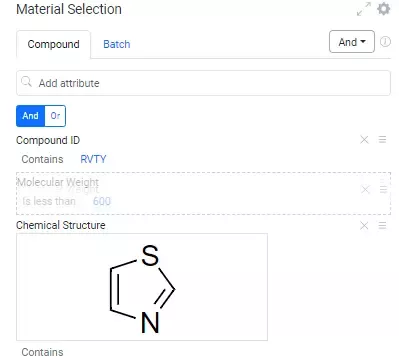
Integrated Summary App users can now rearrange material criteria, affecting the search order and resulting table layout
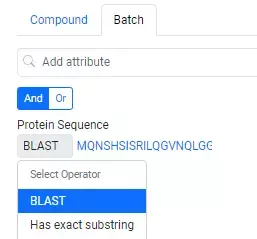

In the Integrated Summary App, users can now perform protein and nucleic acid sequence queries using BLAST or exact substring matching. Beyond the standard query output, these biosequence searches also provide alignment and annotation results.
Chemistry
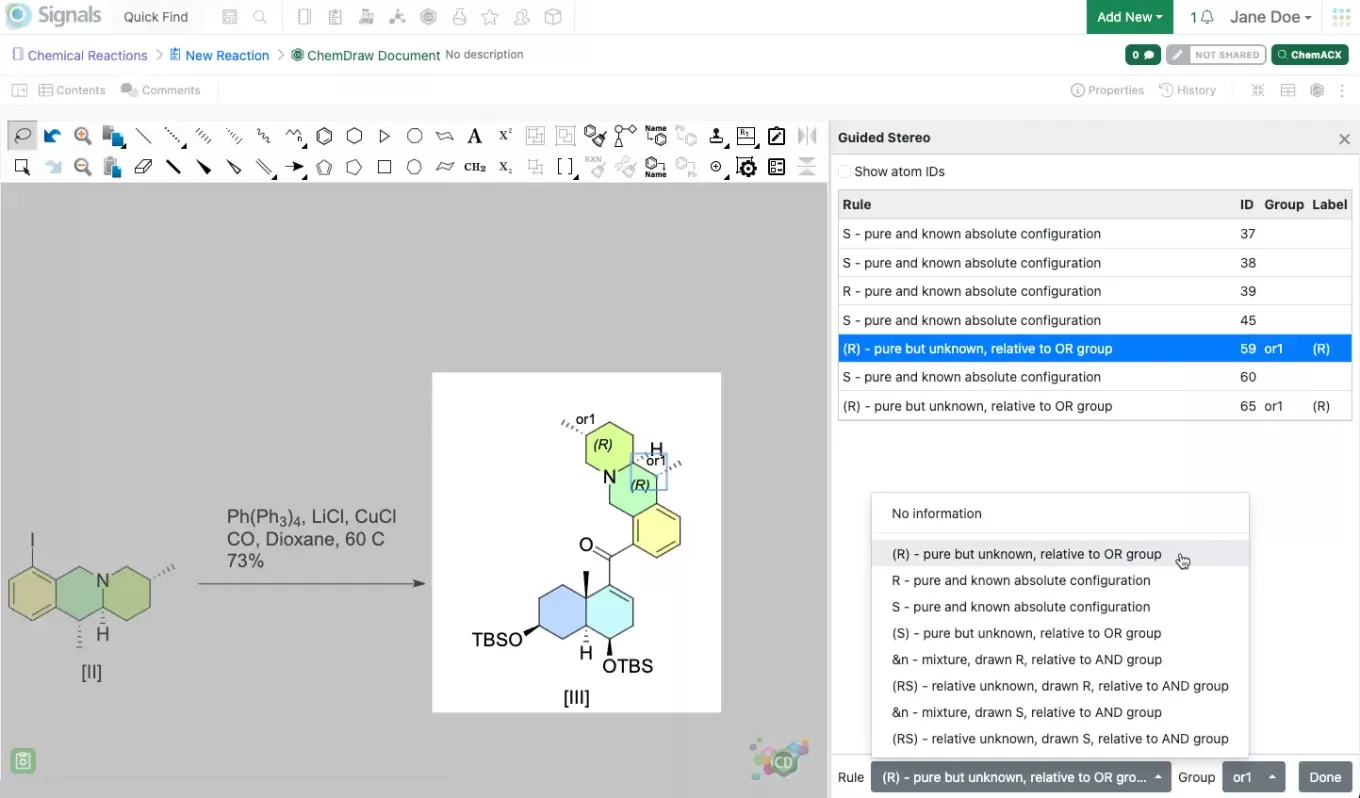
Chemists can now view and annotate stereochemical information contained within their molecule using the “Enhanced Stereo Annotation” tool. This tool enables the assignment of enhanced stereo properties and the addition of chemically significant labels to stereocenters by applying rules that describe the stereochemical composition of each atom or bond. The chemically significant labels are recognized and honored in chemical searches, and if exported as a mol file, the labels will be included in the SGROUP portion of the file.
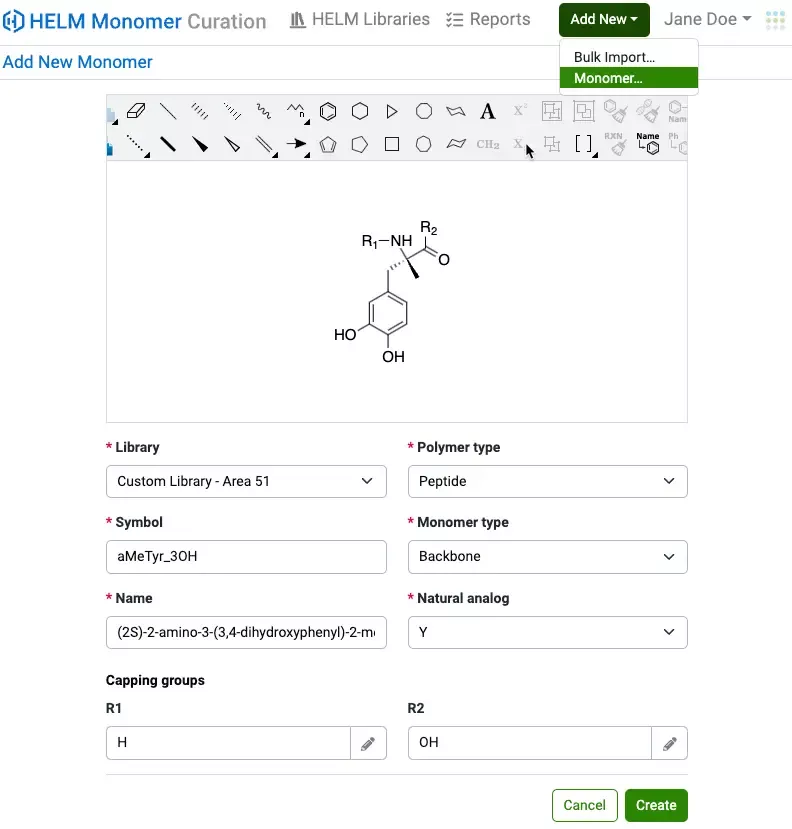
Users can now add a single monomer at a time to a custom monomer library in the HELM Monomer Curation (HMC) application. Monomer structures can be drawn and edited directly within the application, and all monomer properties defined in the ‘Add New Monomer’ form.
Materials
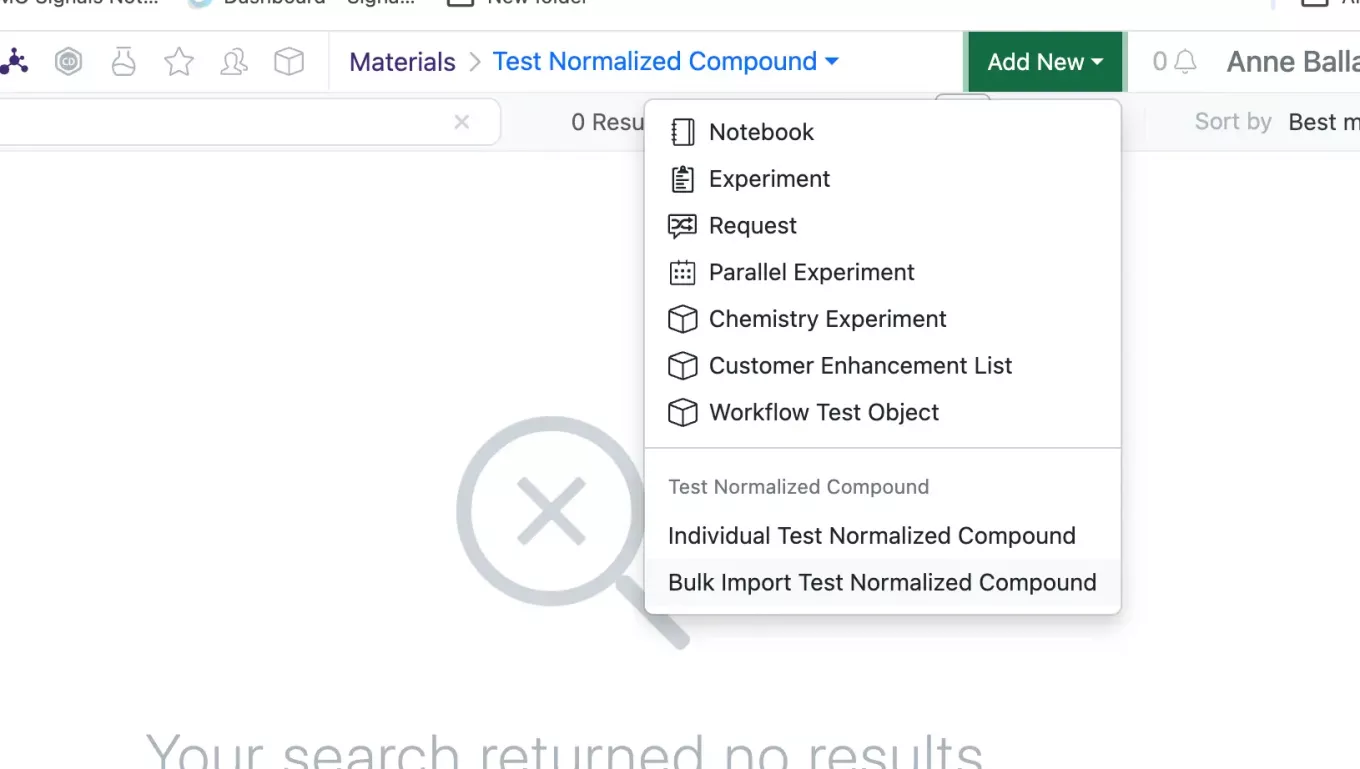
Normalized Compounds type libraries can be imported using the same method that is currently available for Compounds type libraries.
The user can select the bulk import option from the “Add New” menu.
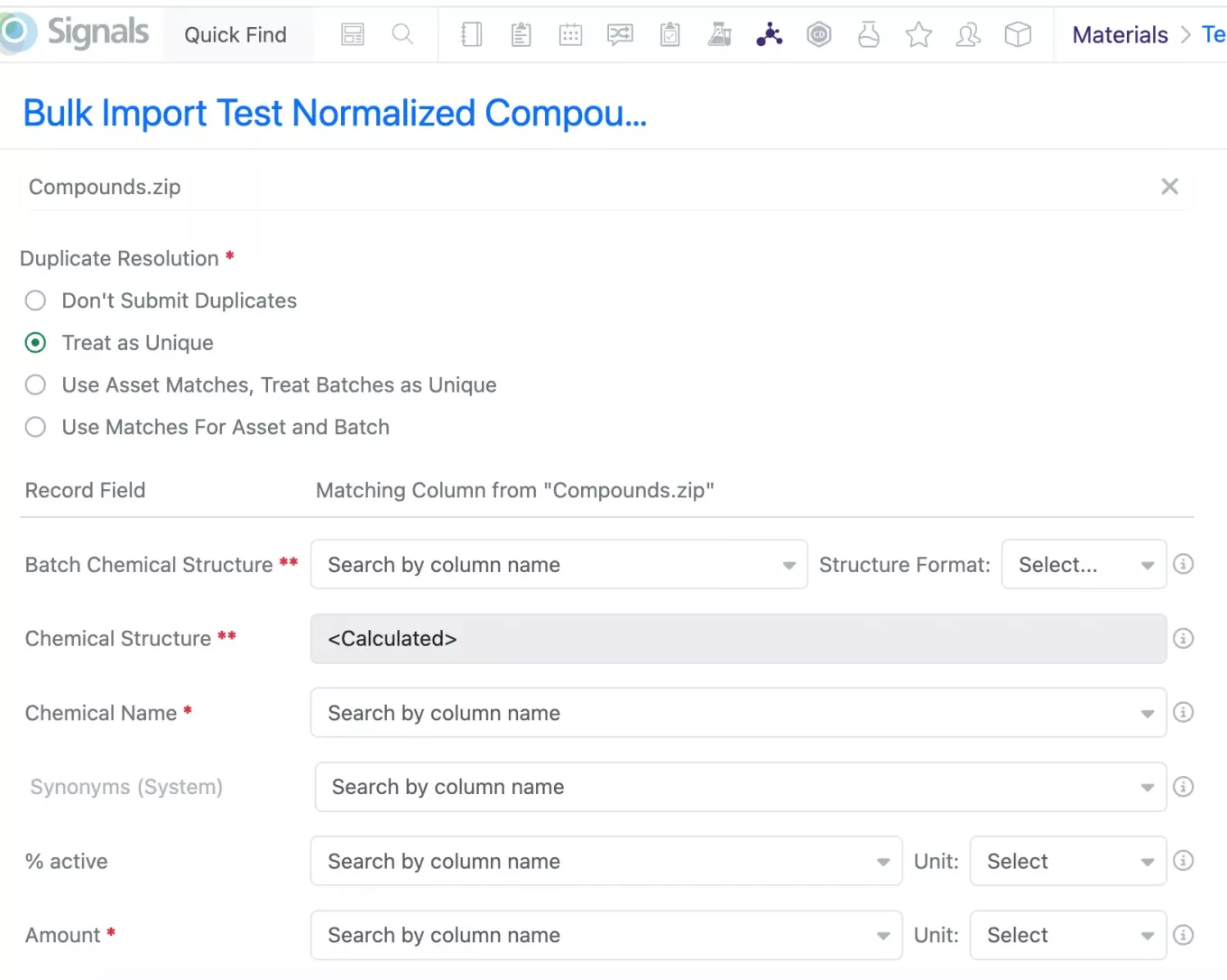
Once a file is selected the user can map fields for import and select the duplicate resolution options. New for this library are the option to “Use Asset Matches, Treat Batches as Unique” which allows the imported compounds to match based on the normalized asset but still retain a unique batch type for each batch and “Use Matches for Asset and Batch” performs uniqueness checking on the Asset and Batch level allowing for duplicate batches to be registered with the same batch type.

The Import report is the same as what is currently available for Compounds library.
What's New
This version 24.4 release of Signals brings new ways to find content, including new smart folder views to enable organization and recovery, and a new search facet to retrieve content by the system template used in creation. We have improved chemistry handling in ChemDraw documents especially around biomolecules drawn using the HELM notation standard. Administrators can now add a new “Sign and Keep Open” option that requests reviewers, and define External Actions on Plate Containers. Our previously beta capabilities around plate templates, container search tables and child materials are now available to all systems. We have added new beta capabilities for around Normalized Compounds, Internal requests and web based Spotfire access, the latter is only available under licenses of Signals Research Suite. Finally, we have also fixed a number of small bugs.
The following improvements are available for users of Signals Notebook Individual Edition, Signals Notebook Standard, Signals Notebook Private Cloud, Signals Research Suite Standard and Signals Research Suite Private Cloud. Certain features may only be available with appropriate licensing and/or with enablement by an administrator.
• Fundamentals
– Now” option added to calendar picker for Date/time properties and search
– Option to edit and view Spotfire Files and Inventa Analysis Objects in your web browser (beta)
– Adding a Spotfire File creates a blank Analysis file (beta)
– Smartfolder Table View
• VitroVivo
– Revised Cohort Definition Step in Study Designer
• Chemistry
– Labels are now hidden when monomers are expanded
– A cursor displays where a new structure will be drawn when in HELM editing mode
– Improved click selection behaviors for expanded monomer structures
– Definition line of a FASTA DNA/RNA sequence added as an annotation when pasted into a Chemical Drawing
– Flip structure
• Variation Tables
– Improved data entry in Horizontal and vertical summary views
• Plates
– Plate Templates available to all systems
• Inventory
– Container Search Table available to all systems
– Container Search Table export and update to column widths
– Internal Request of Materials with Aliquot (beta)
– Bulk Print Container Barcode
• Materials
– Creation of Child Replicate Materials available to all systems
– Creation of Child Materials from Materials Smart Folder available to all systems
– Calculated properties for Protein Materials
– Normalized Compounds (Beta)
• Search
– Search for objects by System Template used
• Administration
– “Sign and Keep Open” option for Reviewers
• Integrations & APIs
– POST /entities/{eid}/children/{filename} now allows you to specify a layout page to attach to
– GET /plates/{plateContainerId}/plates/{id} now contains the PlateID as an attribute
– PATCH /plates/{plateContainerId}/plates/{id} allows for updating of PlateID attribute
– A new endpoint has been added to update the status of a Container
– External Actions can now be created for Plate Containers
We also fixed several small bugs in this release. Details of the enhancements are described below.
The following OnDemand videos for Signals Notebook Administrators are now available:
• Variation Tables – Building initial formulation or mixture template
Developers in Signals Research Suite should note that a pagination limit has been added to the Signals Data Factory public and primary APIs.
Developers in Signals Research Suite should note that the Data Factory endpoints GET /maps and POST maps/search have changed the “created” and “updated” metadata fields to “createdBy” and “updatedBy”, respectively. Two new metadata fields, “createdAt” and “updatedAt” have also been added.
Administrators should note that we have changed the requirements around the unique naming of notebooks in a future release. Notebook name uniqueness is now case sensitive, and hence names differing only in case will be allowed. This behavior only applies for when Global Numbering is not enabled for notebooks.
Developers in Signals Notebook and Signals Research Suite should note that the endpoints GET /attributes/{eid} and PATCH /attributes/{eid} will now only return the "counts" object in the "attributes" object if a new query parameter is specified.
Developers in Signals Notebook and Signals Research Suite should note that Inventory will be updated to give more meaningful error codes, the error codes provided via the External API will now better align the API with the user interface, specifically regarding 4xx (400, 409 and 412) error codes. This change will be made in a future release. The following codes will now be returned: 456 (BARCODE_IN_USE), 457 (INVALID_COORDINATES), 458 (NAME_IN_USE), 459 (TYPE_NOT_EDITABLE), 460 (ANCESTOR_NOT_EDITABLE), 461 (PROPERTY_OR_FIELD_NOT_EDITABLE), 462 (ENTITY_IN_USE), 463 (NOT_A_GRID),464 (INVALID_TYPE), 465 (CONTAINER_NOT_DISPOSED), 466 (CONTAINER_DISPOSED_OR_FINAL_DISPOSED), 467 (TYPE_NOT_SUPPORTED), and 468 (VALUE_OUT_OF_BOUND).
Administrators are recommended to subscribe to the channels within our support news site found at https://support.revvitysignals.com/hc/en-us/categories/360004446171-Support-News which contains more information about releases and other pertinent product information.
This content is anticipated for release on our Production E3 environments, and for Private Cloud customers on our deferred release schedule, in November 2024.
Further Details
The following improvements are available for users of Signals Notebook Individual Edition, Signals Notebook Standard, Signals Notebook Private Cloud, Signals Research Suite Standard and Signals Research Suite Private Cloud. Certain features may only be available with appropriate licensing and/or with enablement by an administrator.
Fundamentals

The calendar picker used for Date/Time properties now contains a “Now” option to facilitate the entry of the current time/date into the field. This option is also available in the calendar entry screen for search queries on time/date based properties.
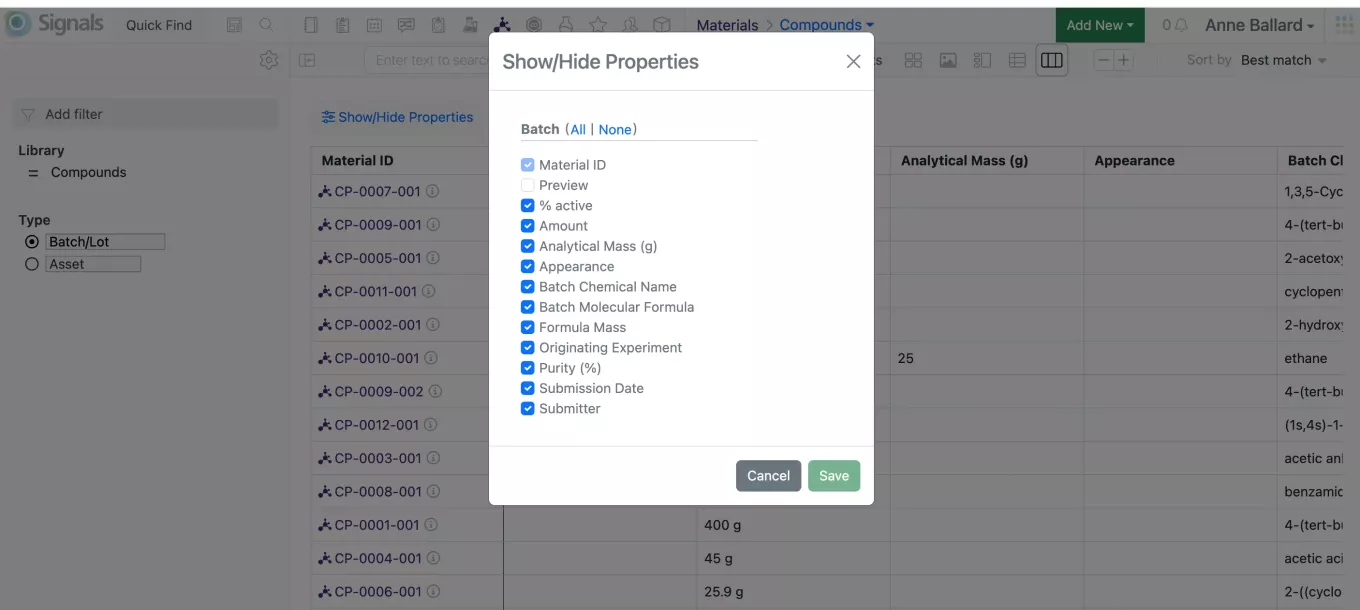
The new Grid view option from Inventory Containers is being expanded to the Smartfolders in Signals Notebook. To utilize the new grid view users can select the new view icon. Users can select which properties are shown using the “Show/Hide” property picker.
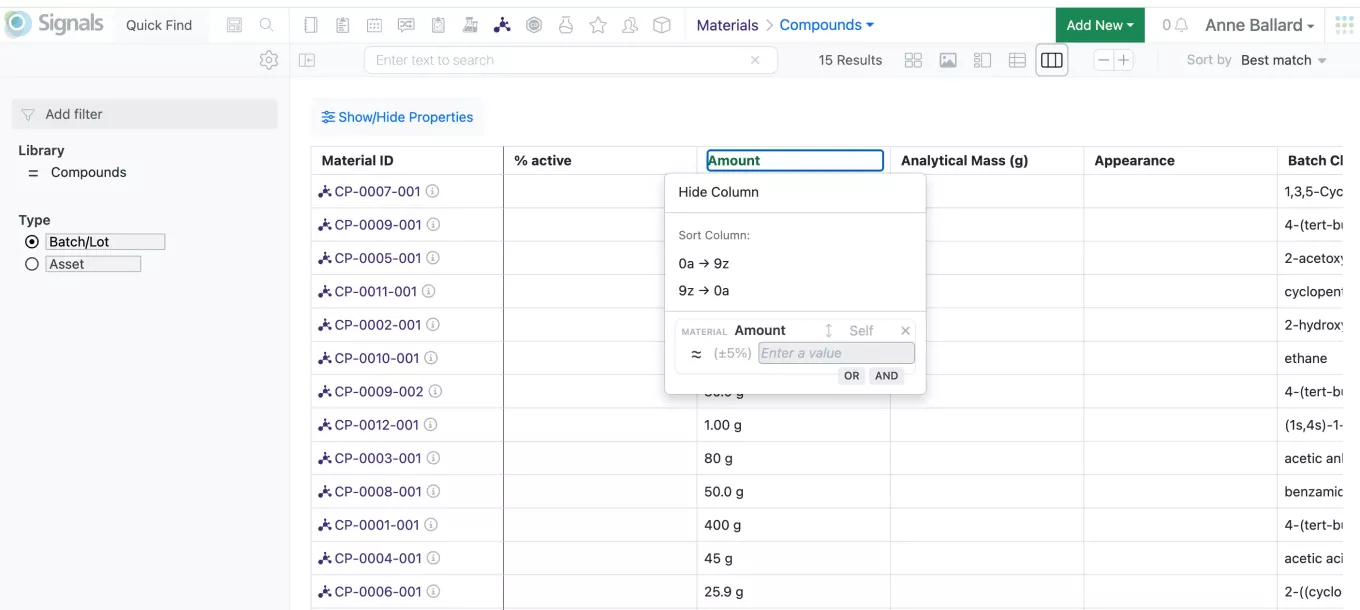
Filters can be added to the side bar as normal or columns can be filtered by selecting the column and entering the filter value. Once added the filter will also appear on the side “Filter” bar.
Columns can be reordered by drag and drop. As with the card view the first 20 items are loaded with the option to “Show More” available at the bottom.
The grid view will now be available for Materials, Samples, Experiments, and Parallel Experiment Smartfolders.
VitroVivo
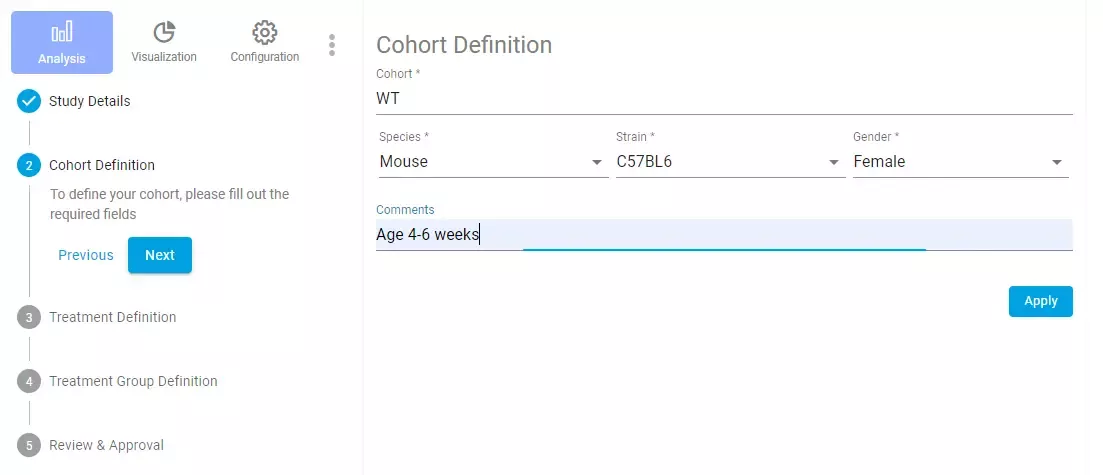
Strain and Gender information for animals must now be entered in the Cohort Definition step within the Study Designer. Regarding Strain, users can either select a value from a drop-down list or input a new value directly into the field. Gender can be selected from pre-configured options available in a drop-down menu. These updates eliminate the need to predefine Gender and Strain values in study templates.
Chemistry
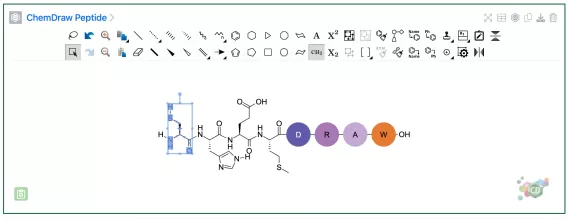
Several usability enhancements are available for working with HELM structures. When monomers are expanded, the expanded monomer labels will now be hidden. In addition, when monomers are expanded there is improved click selection behavior. Double clicking on a bond or atom in a monomer will select that monomer. An additional double click will select the entire sequence.
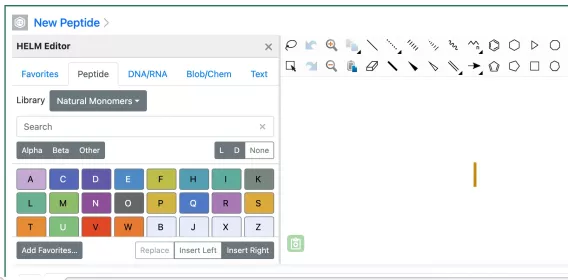
When using the HELM editing tools, a cursor now indicates where a structure will be drawn prior to adding any monomers.
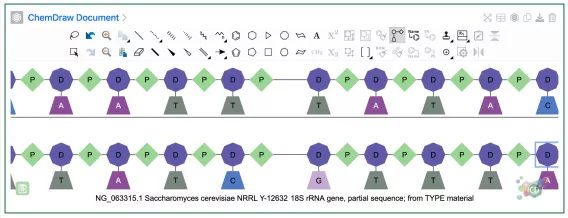
When pasting a DNA or RNA FASTA sequence with header into a Chemical Drawing, either directly or via the Text tool of the HELM Editor, the FASTA header will appear as an annotation.

There are two new tools available that allow users to flip structures horizontally or vertically.
Variation Tables

“Tab” can now be used to navigate around the Horizontal and Vertical Summary views to aid in systematic data entry. “Tab” will move to the equivalent field for the next Variant, or if the final Variant, to the next row in the first Variant. Shift-Tab will reverse the behavior.
Plates
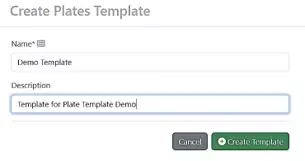
Plate Templates is now available to all systems.
Inventory
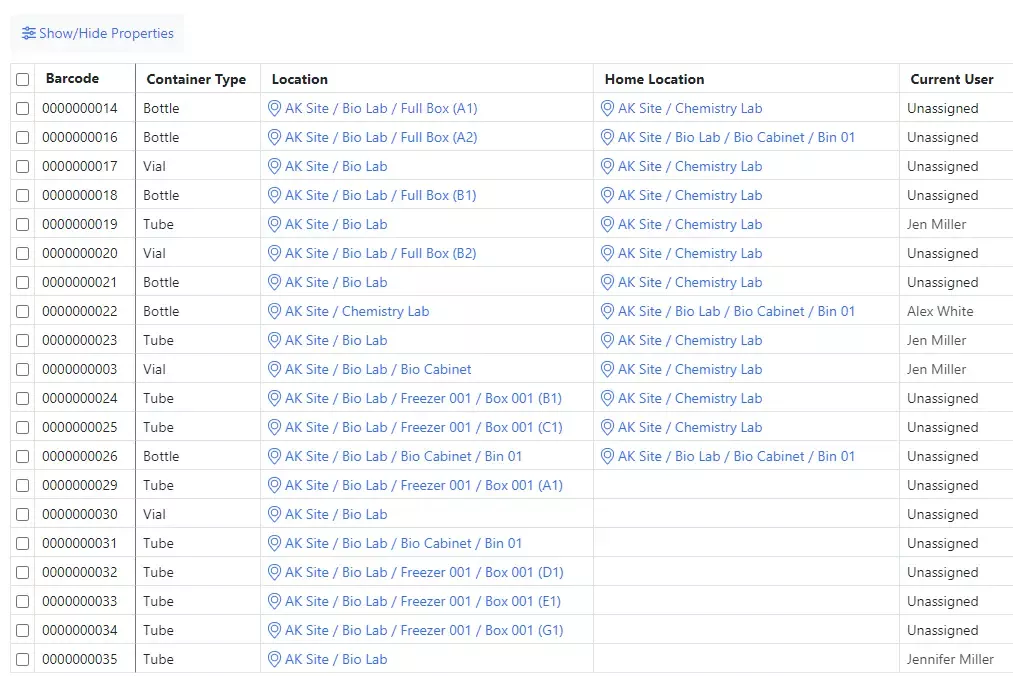
The Container Search Table is now available to all systems.
Container Search Table update to column widths, users can hover over the line between the column headers to adjust the size of the column to fit the data:

The Container Search Table also now supports export. For users to export containers, they need to have a User Role that allows for the Export Containers privilege.
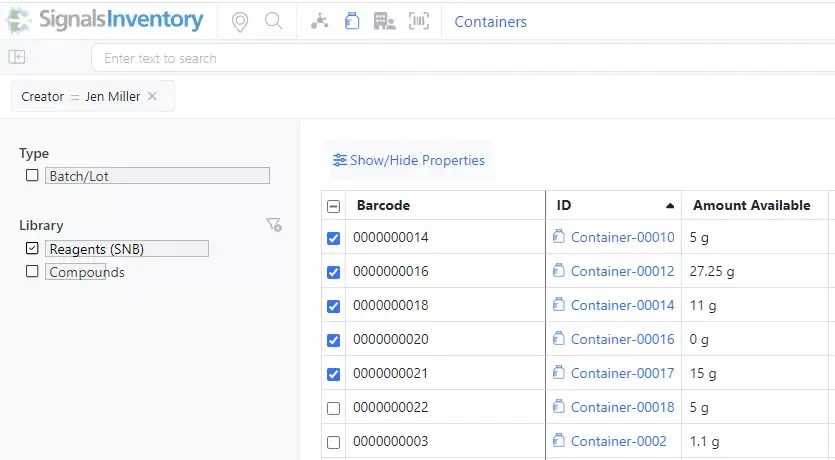
When exporting, if only a subset of containers are selected, only those rows will be exported. The export will only include the columns selected to be shown in the table.
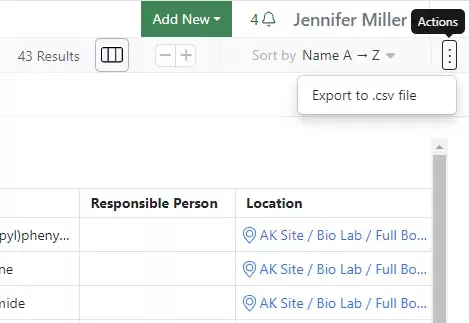
If no rows are selected, the export will include all containers up to 600K, and only the selected/shown columns:

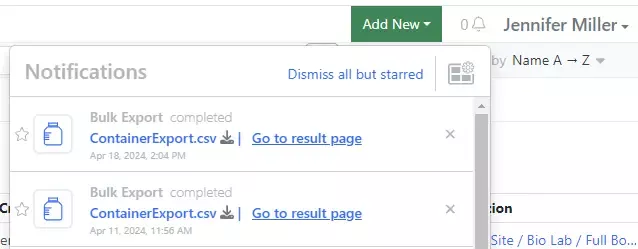
When the export is done, a notification will appear at the bottom of the screen and in the bell near the user name:

If the report is needed later, it can be found under the user name/Inventory Bulk Results/ Bulk Container Export. Files are saved for 30 days and then removed from the list.
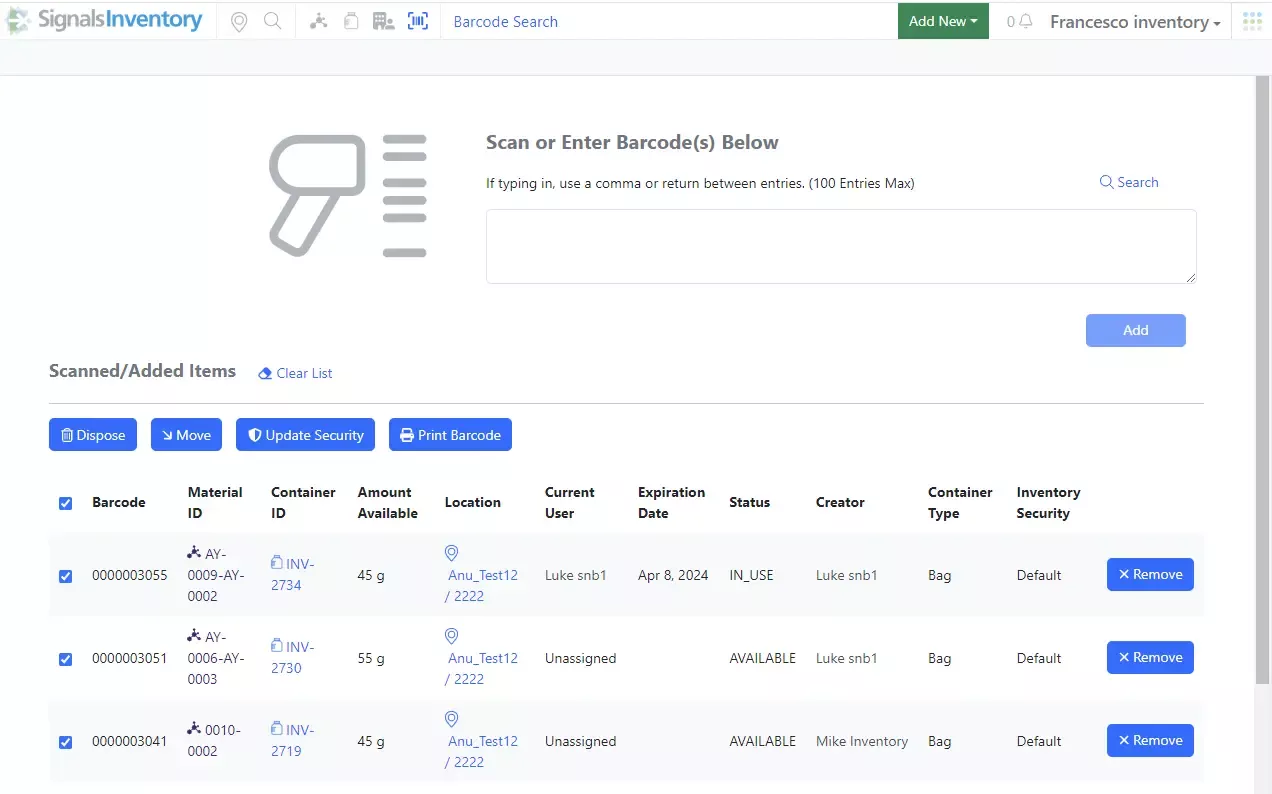
Bulk Print container barcodes option is available on the bulk action Inventory page:
Materials
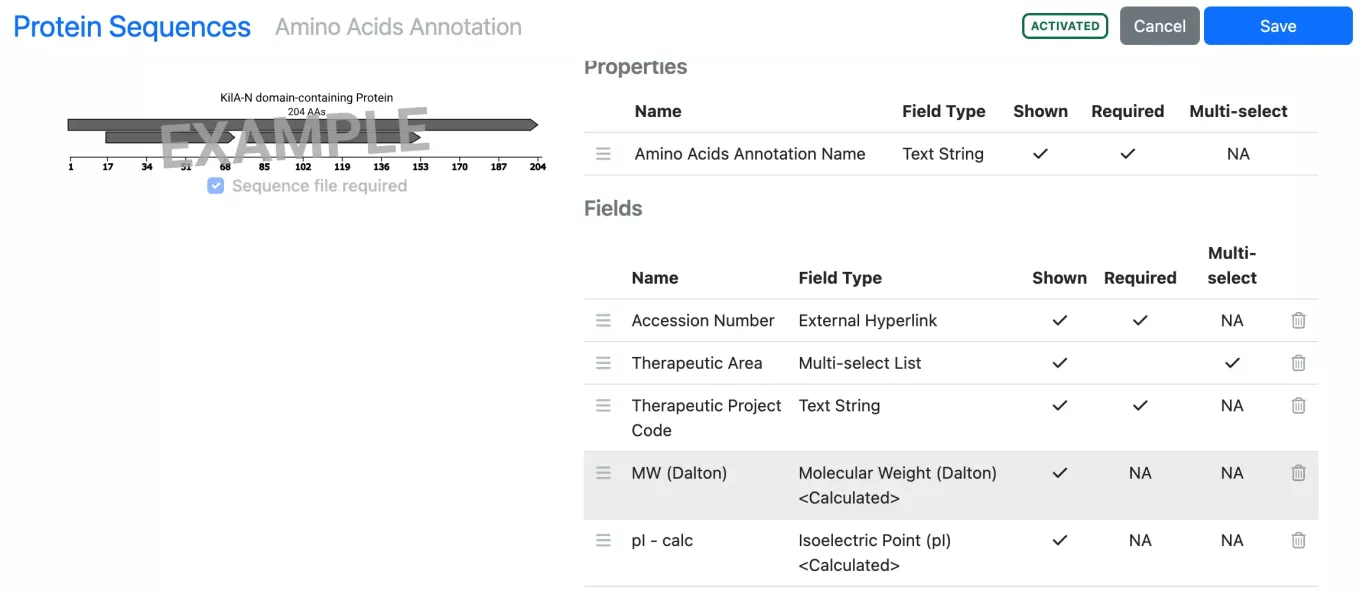
Admins may now configure calculated property fields for protein type Materials. The values will appear on the Material focus pages and can be added to Materials tables once configured. The values will be associated with the Asset level of the Material and calculated from the Materials amino acids.
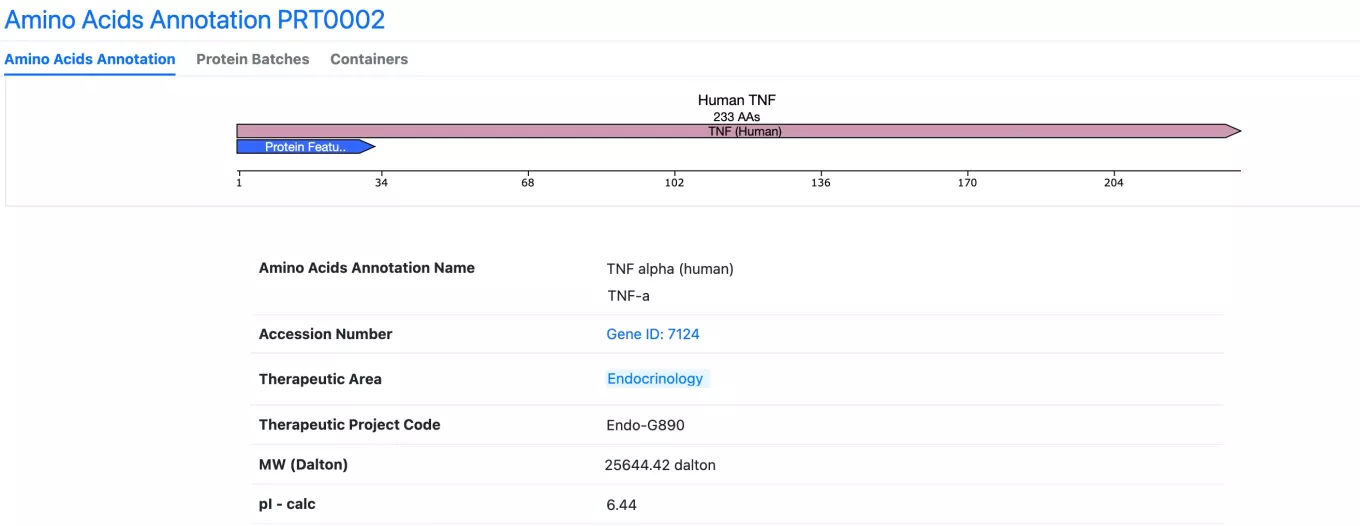
Values are calculated when a Protein Material is registered or edited.

The creation of child replicate materials, previously available in beta, is now available to all systems.

The creation of child materials from the focus page of a parent material, previously available in beta, is now available to all systems.
Search
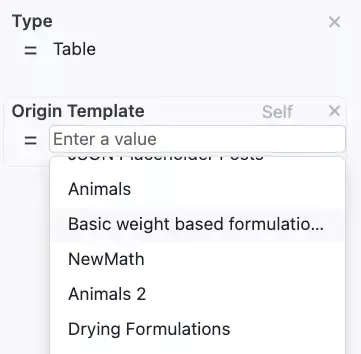
Objects can now be found by specifying the System Template used to create them. An “Origin Template” facet has been added to search. This will allow the user to search for an object by the name of the system template used to create it.
Administration
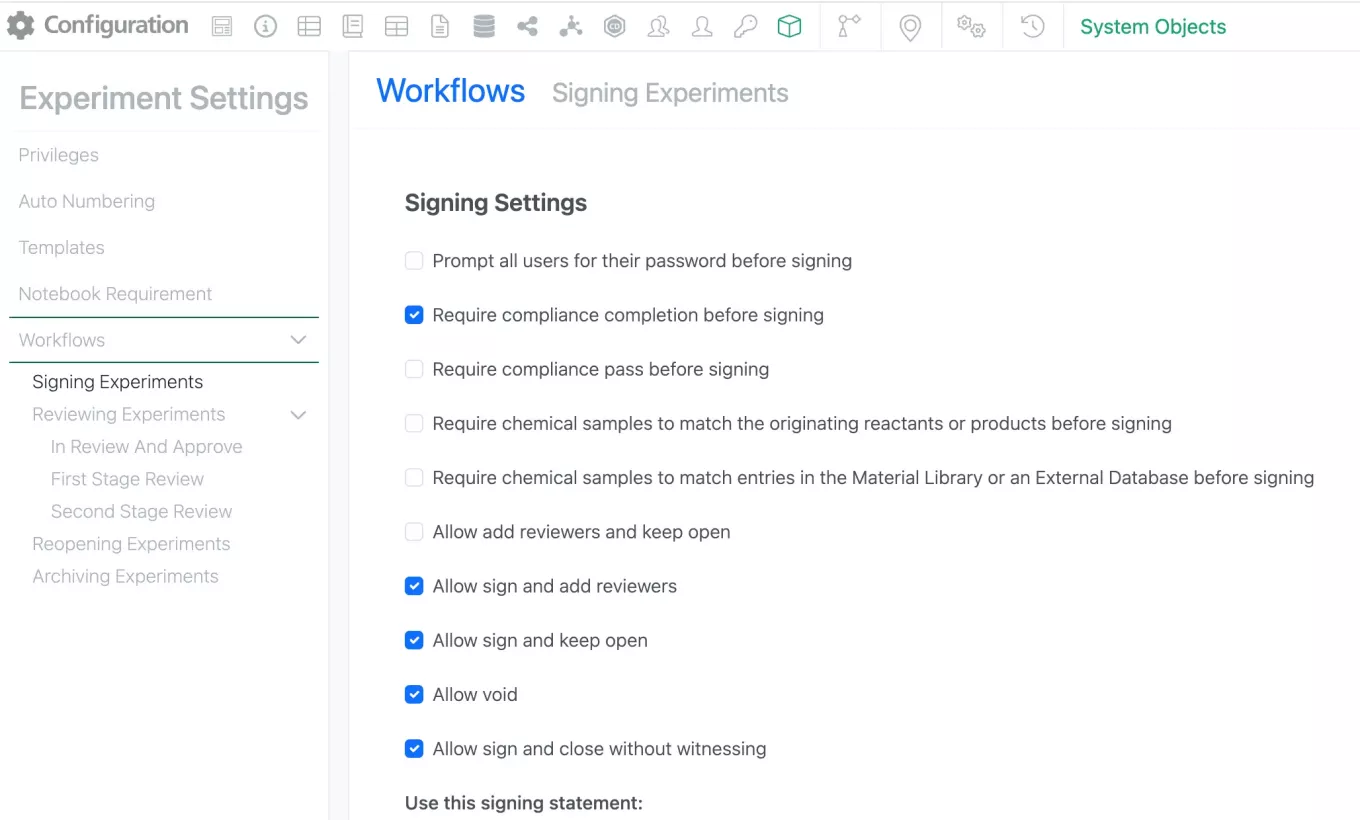
A new workflow option call “Allow add Reviewers and Keep Open” is now available. This option allows for a user to add reviewers without changing the state of the experiment type object (experiment, parallel experiment, or ADO).
The option can be enabled by selecting the new checkbox under Signing Settings and enabling the associated privilege.
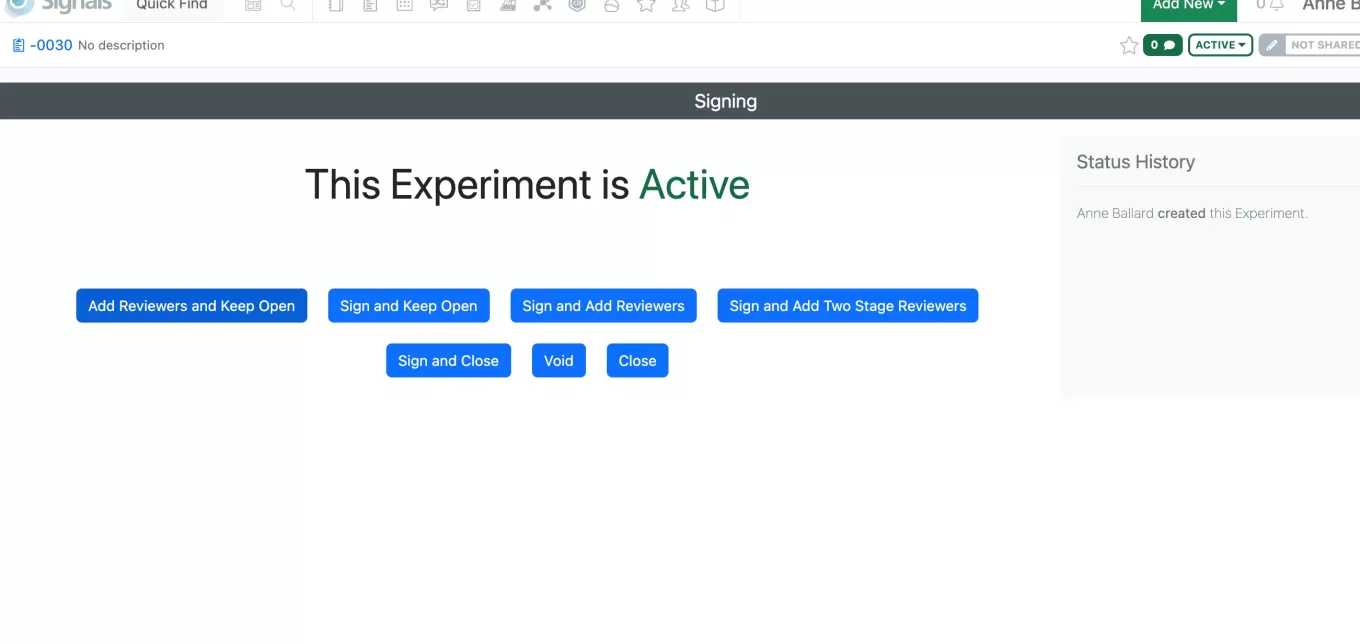
Once enabled a user will be able select “Add Reviewers and Keep Open” under the Signing page. Users can add reviewers and continue working.
Integrations & APIs
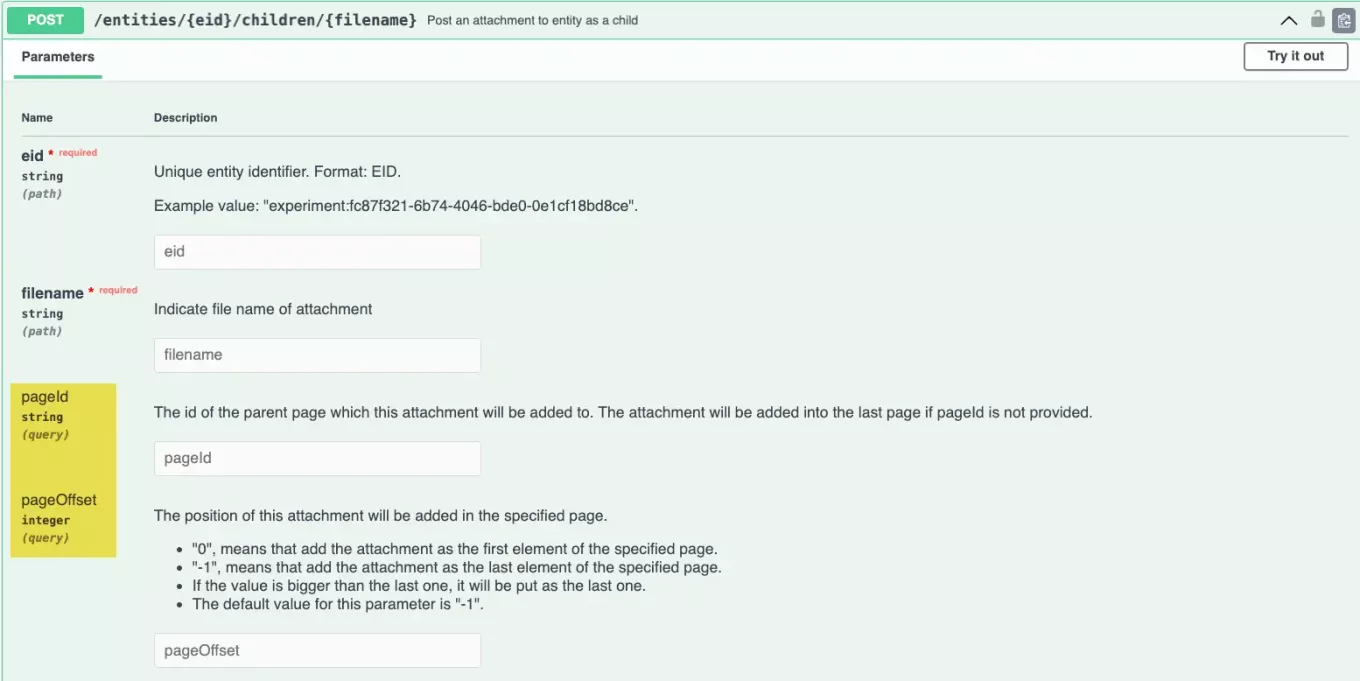
The POST /entities/{eid}/children/{filename} endpoint has been enhanced to allow posting an attachment to a specific layout page.
Entity pages pageId’s are accessible through the following endpoint: GET /entities/{eid}/layout/pages

Endpoints for Plates have been enhanced to provide programmatic access to each plates “Plate ID” field.
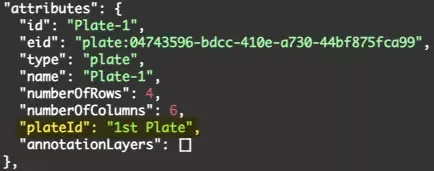
The GET /plates/{plateContainerId}/plates/{id} and /plates/{plateContainerId}/plates now contain the “plateId” as an attribute of an individual Plate in the API response.
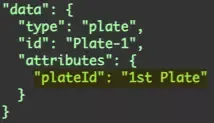
The PATCH /plates/{plateContainerId}/plates/{id} has been enhanced to allow updating of the “plateId” attribute as part of the request body. Example body below:
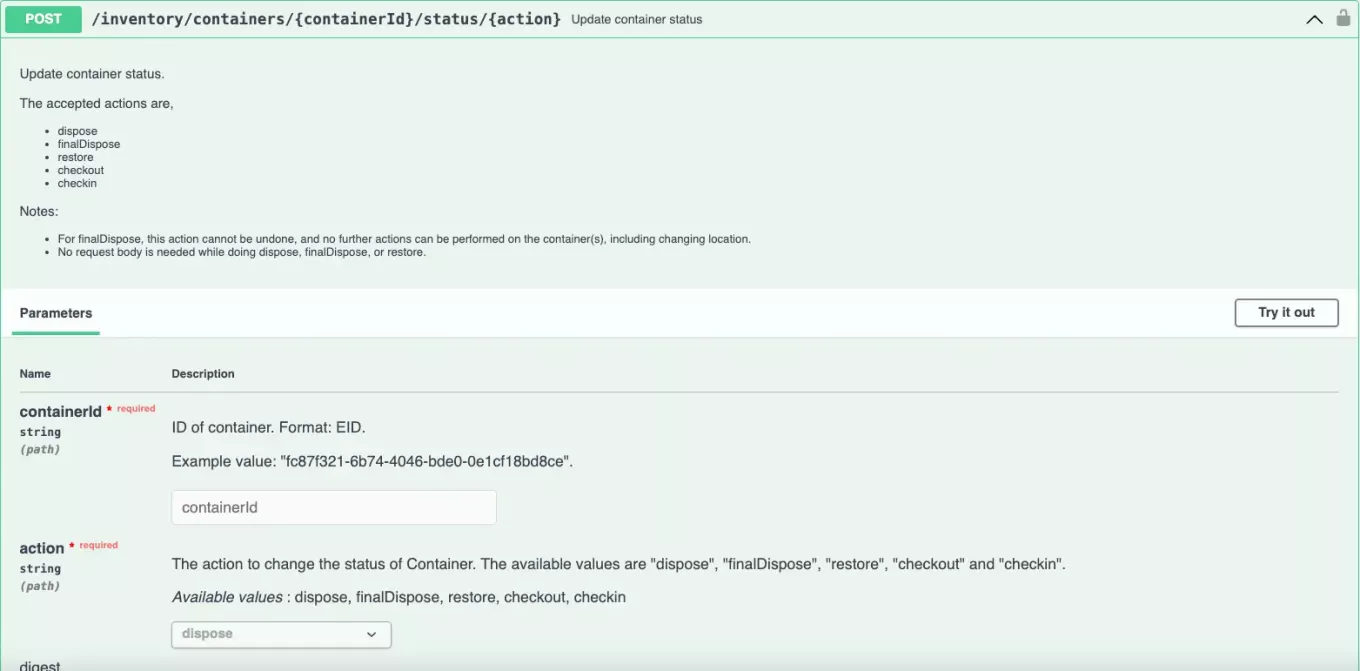
A new endpoint, POST /inventory/containers/{containerId}/status/{action} has been added to change the status of a Container. The accepted actions are dispose, finalDispose, restore, checkout and checkin.
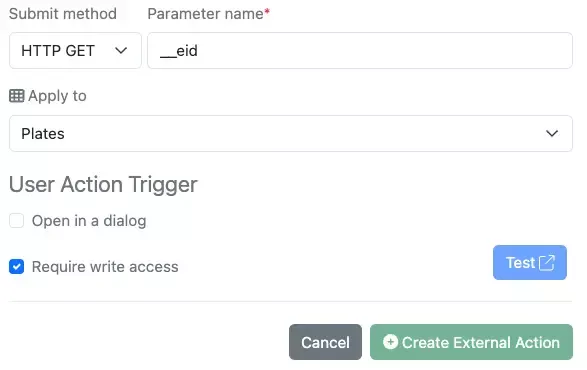
External Actions can now be created for Plate Containers. For GET submit methods the URL parameter will contain the PlateContainers entity ID. For a POST the body will include basic details of the Plate Container.
The following capabilities are in beta and are only available to users and administrators of Signals Notebook Standard, Signals Notebook Private Cloud, Signals Research Suite Standard and Signals Research Suite Private Cloud upon request. Please contact your account representative or our support team if you would like access to the following features. They are unavailable as part of Signals Notebook Individual Edition.
Fundamentals


Users now have the option to edit and view Spotfire Files and Inventa Analysis Objects within their web browser. Spotfire Online requires no installation, is Mac compatible, and opens in a new browser tab.
Adding a Spotfire File creates a blank Analysis file (previously loaded a local file). Inventa Analysis Object now allows the option of choosing the opening method on creation (previously opened automatically in the locally installed Analyst).
The locally installed Spotfire for Signals Analyst is still available and is the suggested option for designing & creating advanced dashboards & workflows from scratch.
Inventory
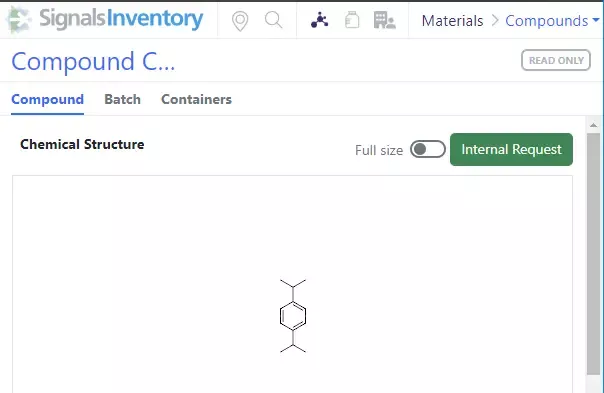
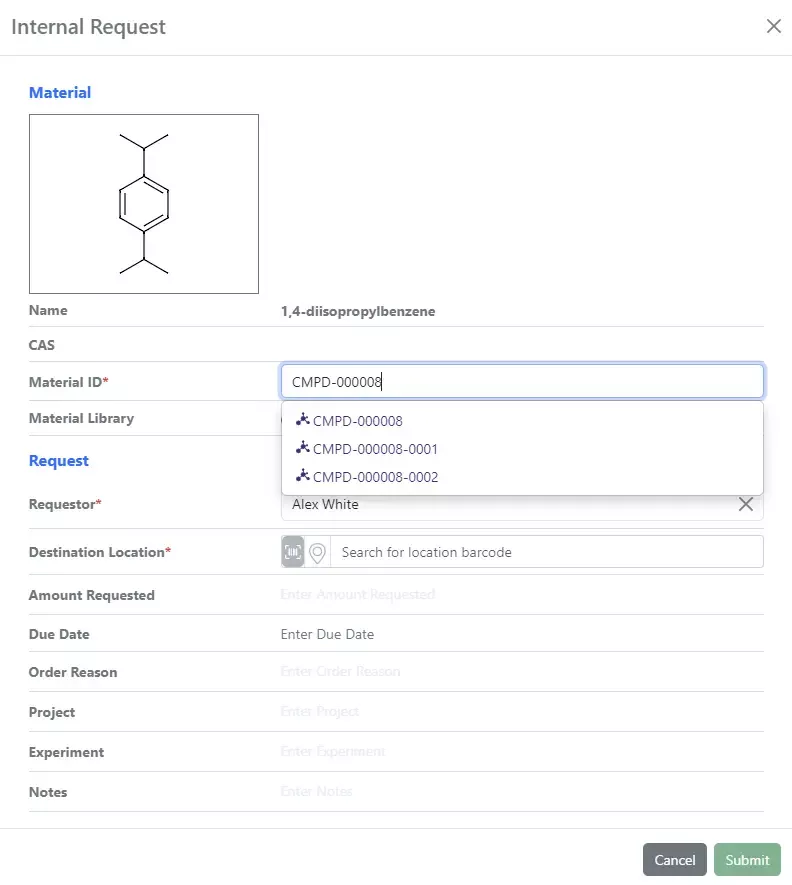
Users with View access to Materials can make Internal Requests for a Material or a Material with the Batch/Lot specified.
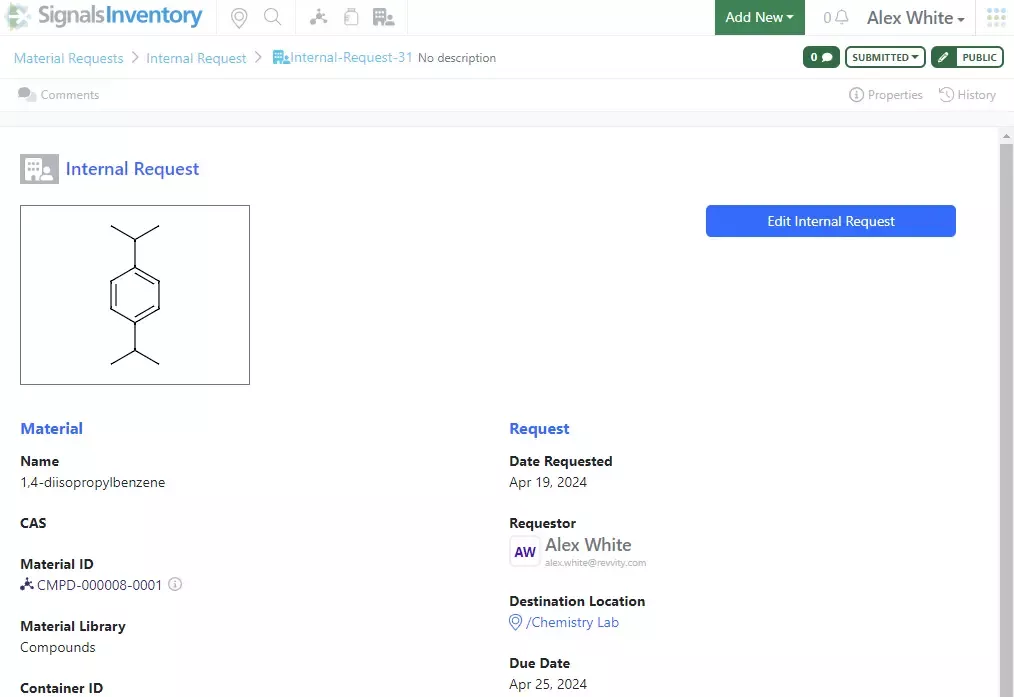
Once the form has been filled out, the user will get a confirmation with a link. Users that create the Internal Request can edit them. Admins can edit if the Security Policy is set appropriately.
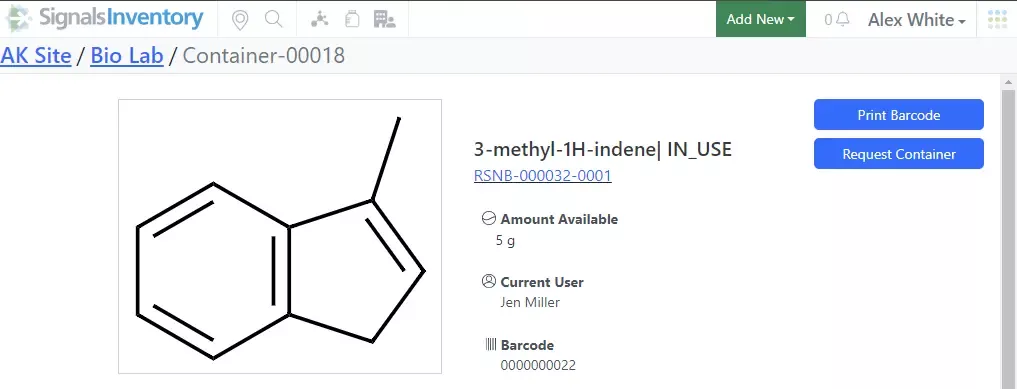
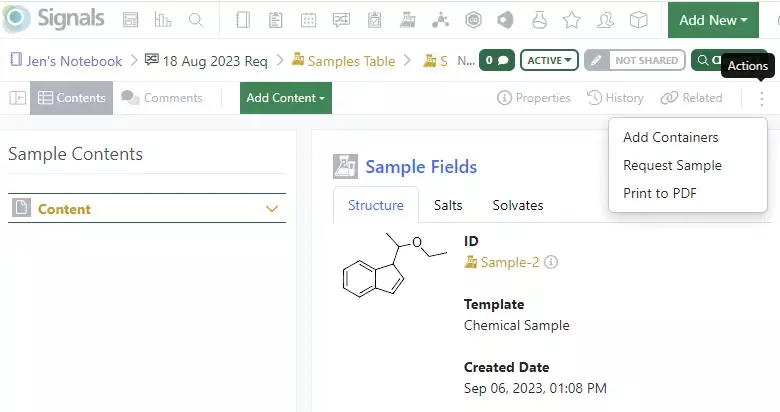
Users can also similarly request containers or Samples.
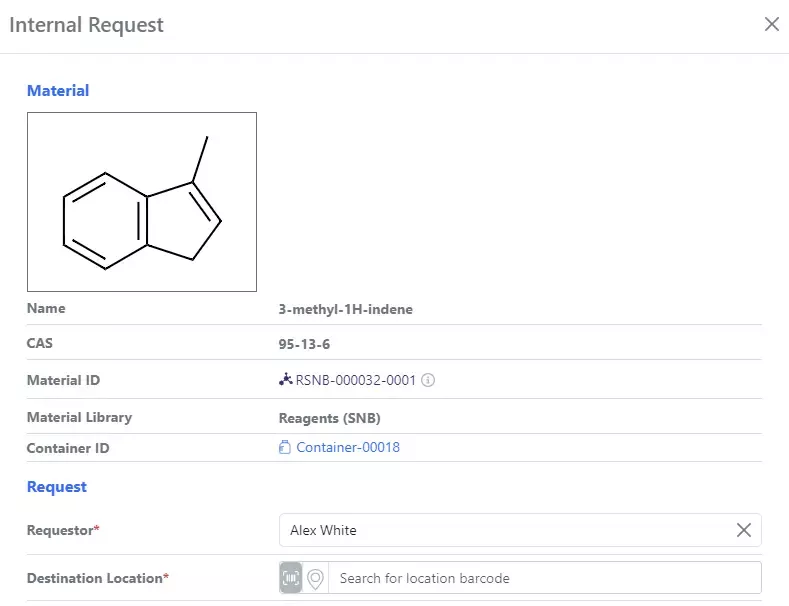
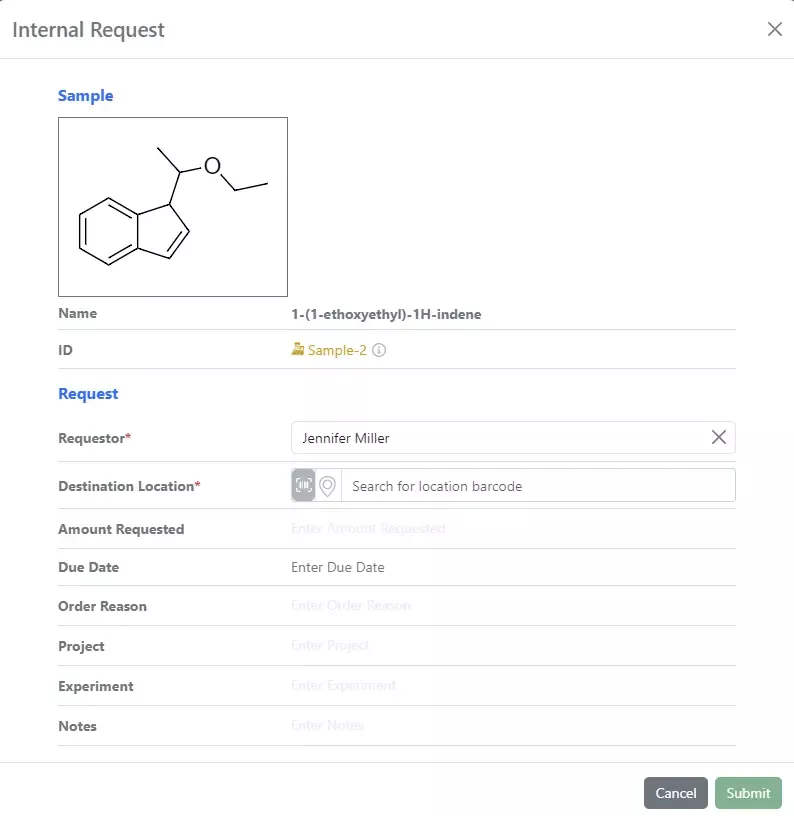
For Containers the form will be populated with both Material and Container information. For Samples the Sample information will be filled.
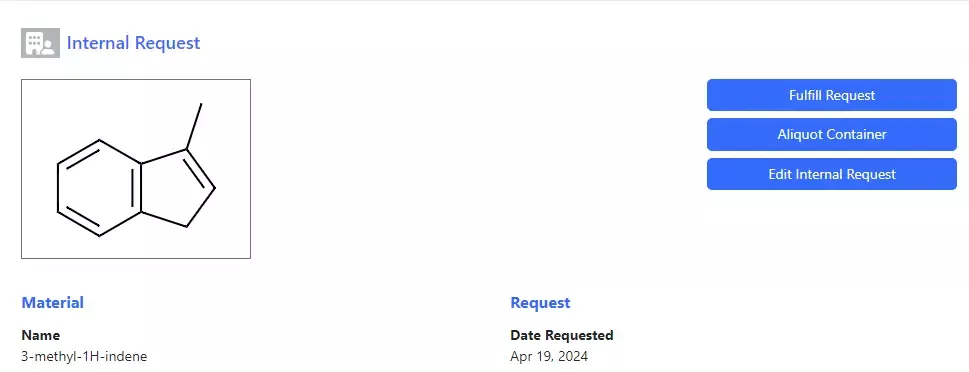
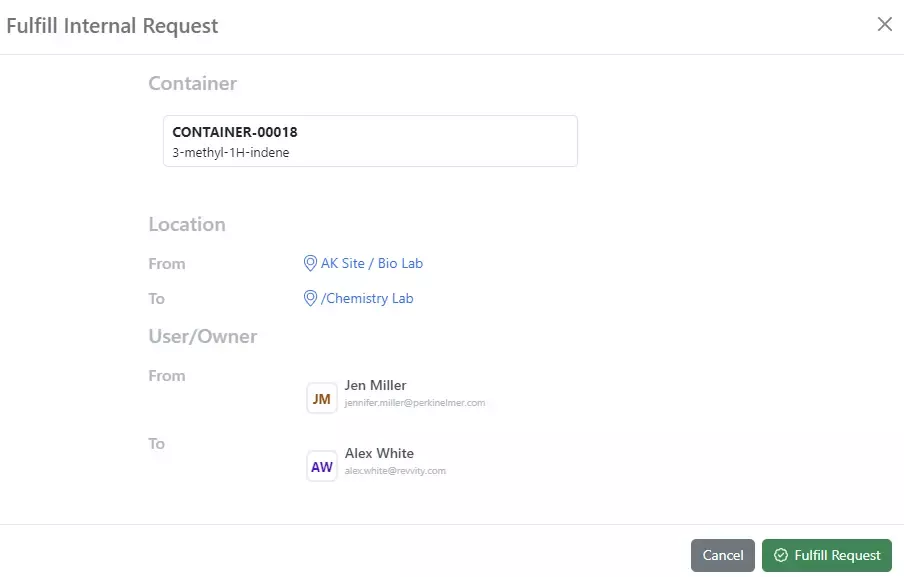
Inventory or System Administrators will be able to fulfill Internal Requests. Internal Requests can be fulfilled directly from the Internal Request object. All the required information will autofill and the administrator can Cancel or continue the Fulfill whereby the status will be updated to Fulfilled and the Location, Current User and Status will be updated.
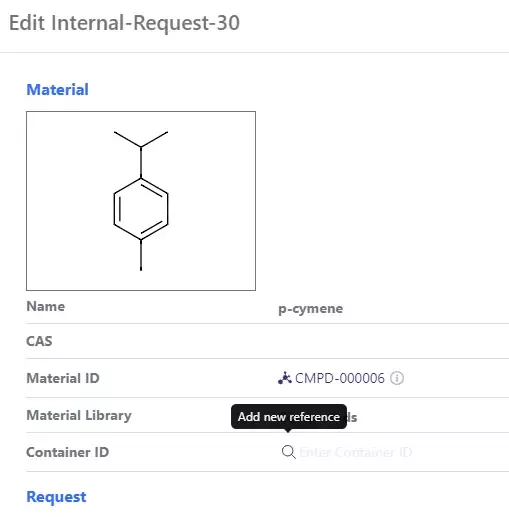
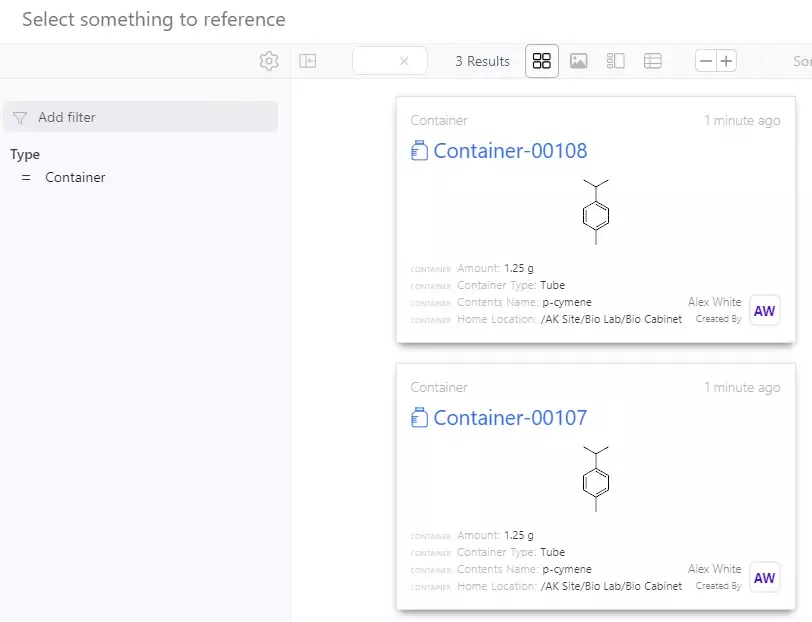
If the Internal Request was for a Material or Material with Batch/Lot, the request will need to be updated to have a container associated. The administrator can select from a list of available containers.
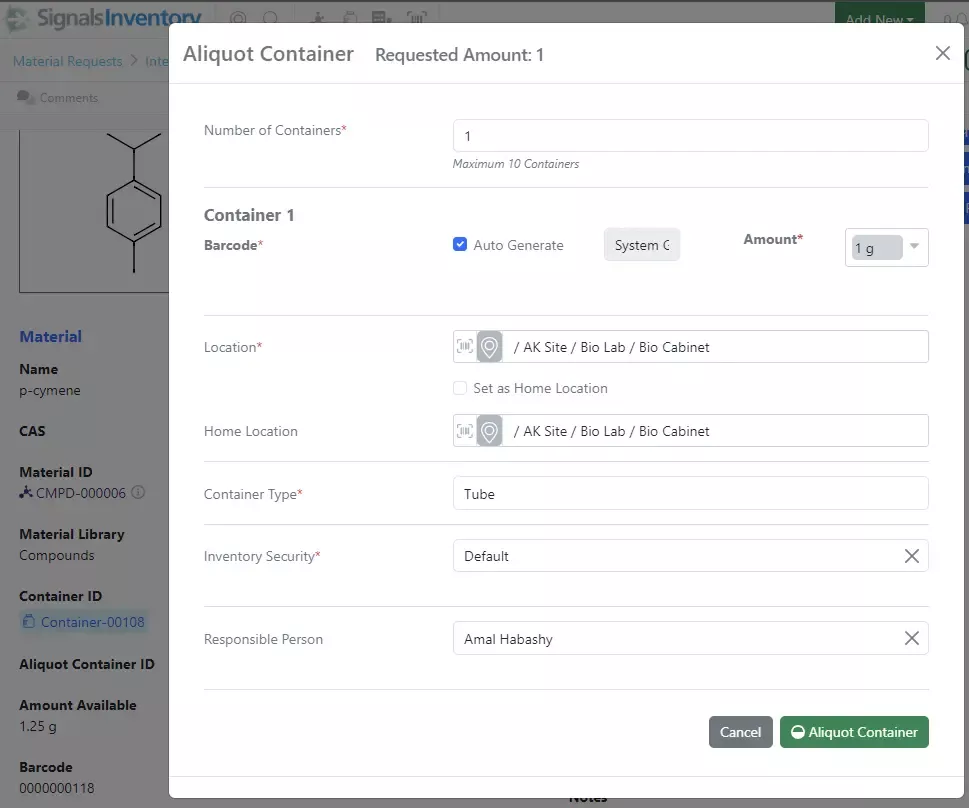
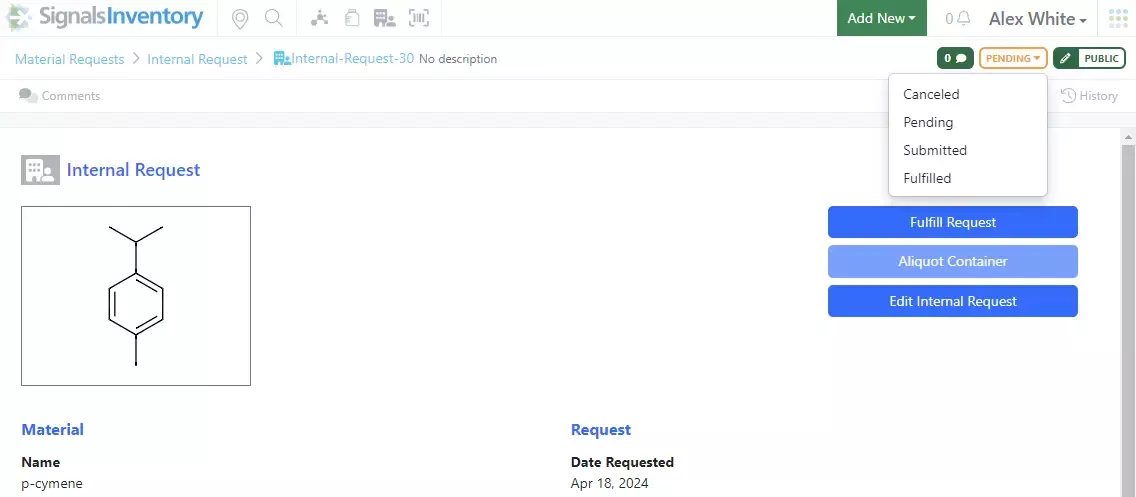
If an Aliquot should be created, the Aliquot Container workflow can be initiated. A warning is provided if insufficient material exists to create the aliquot. Once the Aliquot(s) have been created, barcode(s) may be printed. The parent Container will also be updated.
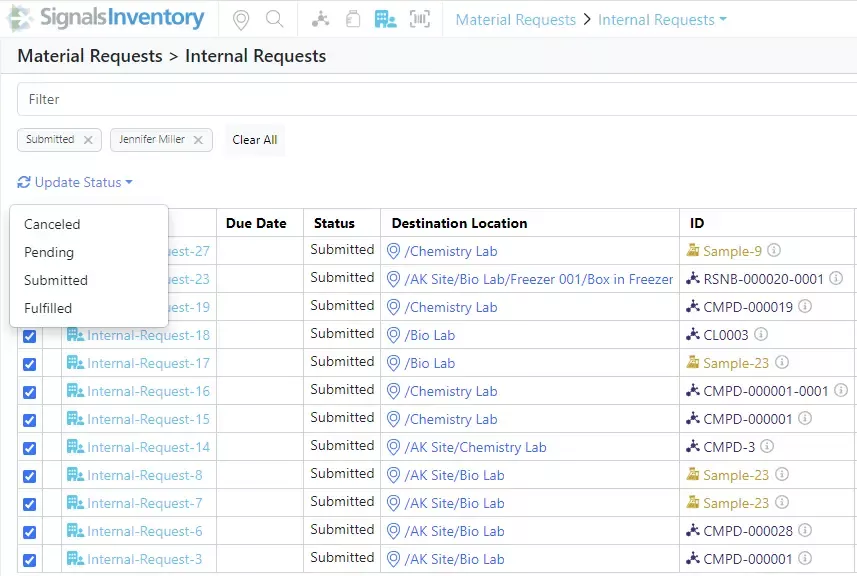
The Internal Request will initially go to a Pending status to give the administrator time to determine when the request will be fulfilled/delivered to the requestor. The status can be further updated to Fulfilled. Internal Requests can be fulfilled in bulk in the Material Requests Table. Requests that have associated containers and do not require placement in a grid location will be fulfilled. Updating Status to Pending, Submitted or Canceled do not require containers and will work for grid locations. Requests in the Fulfilled status over 30 days old will be removed from the table.

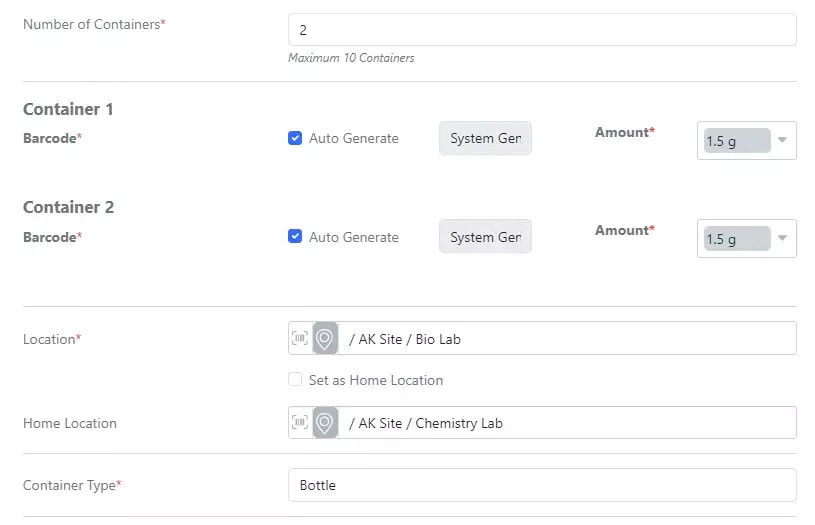
Containers not associated with an Internal Request can also be Aliquoted. Navigate to the container to be aliquoted, define the amounts to be placed in each aliquot and print barcodes.
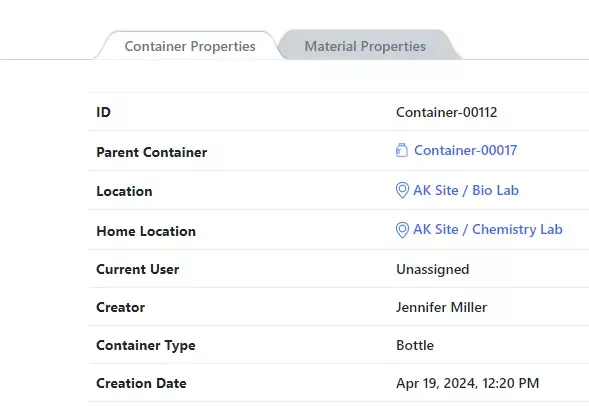
The child container(s) will have a new Container Property, Parent Container that is auto filled:
Materials
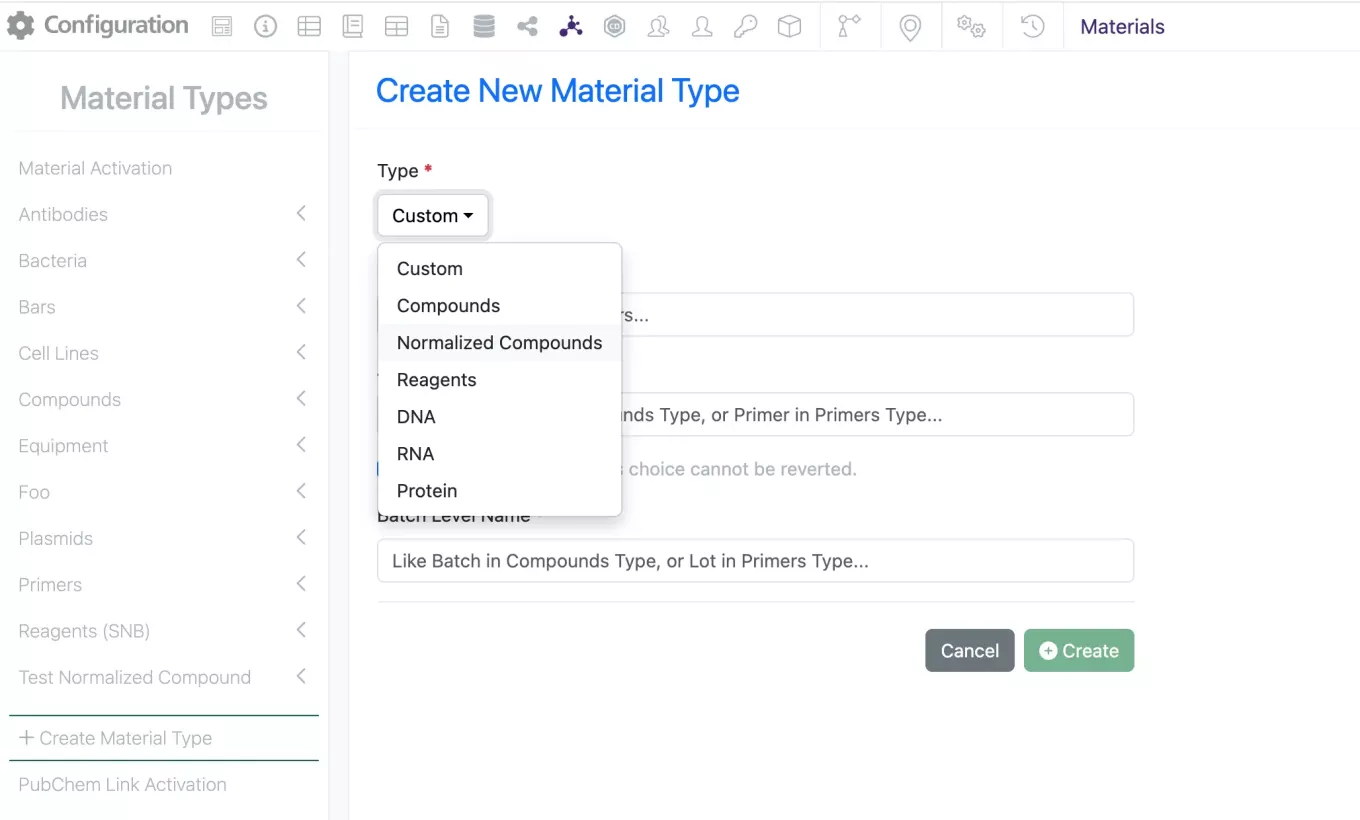
A new Material Library type called “Normalized Compound” is now available upon request. This new library type allows for a Salt Stripped or “Normalized” structure to be stored on the Asset level and the raw structure (or Salt form) to be stored on the Batch level.
In the administrator interface SN Config, an admin can create a “Normalized Compound”- type library by creating a new material type and selecting Normalized Compounds.
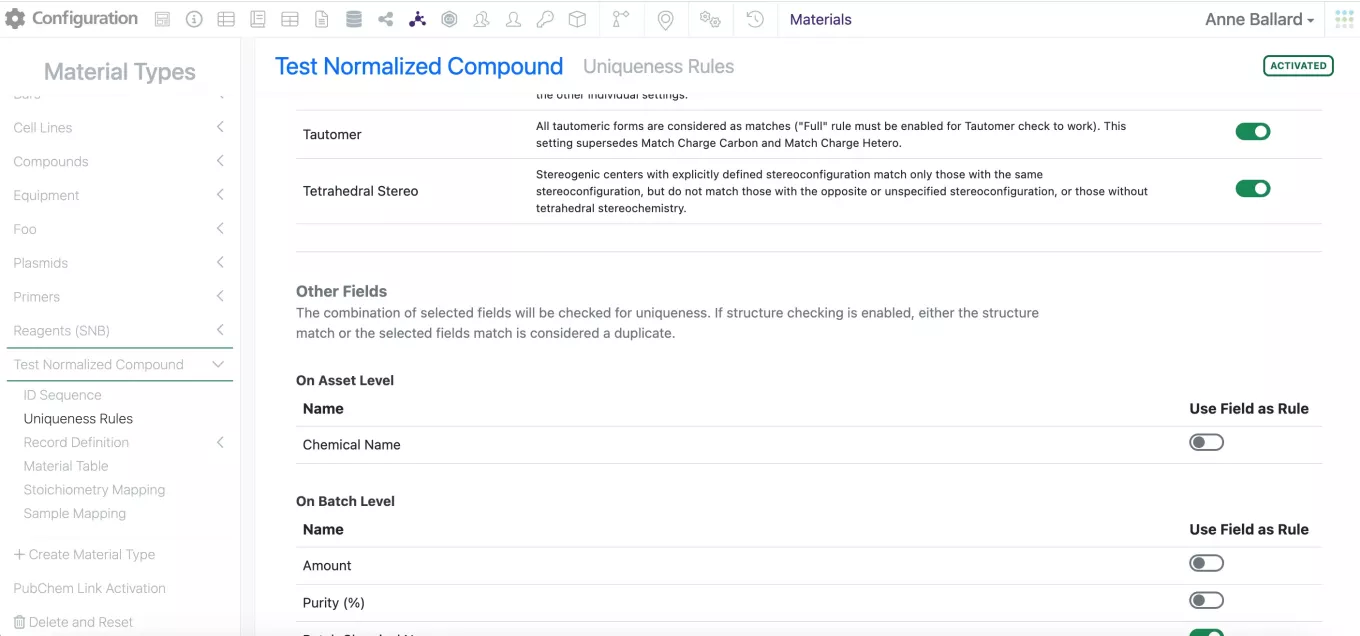
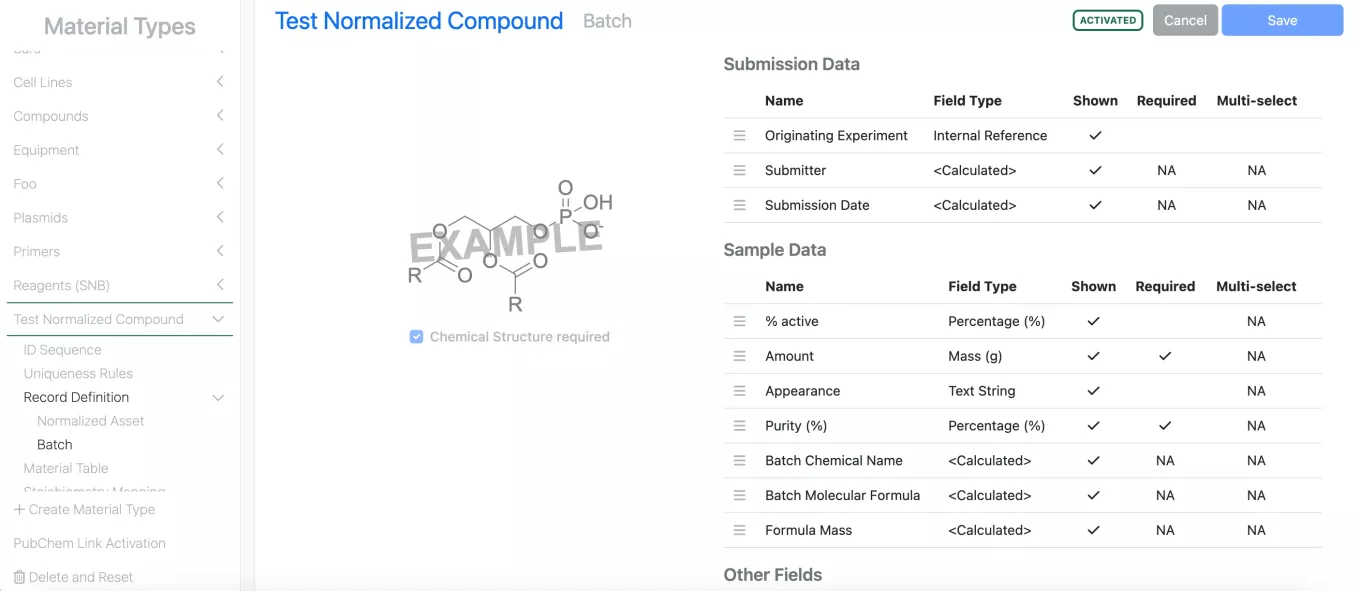
The Admin can define uniqueness rules for the structure that will apply for both the asset and batch level structures and select properties on the asset and batch level that can be used for uniqueness checking.
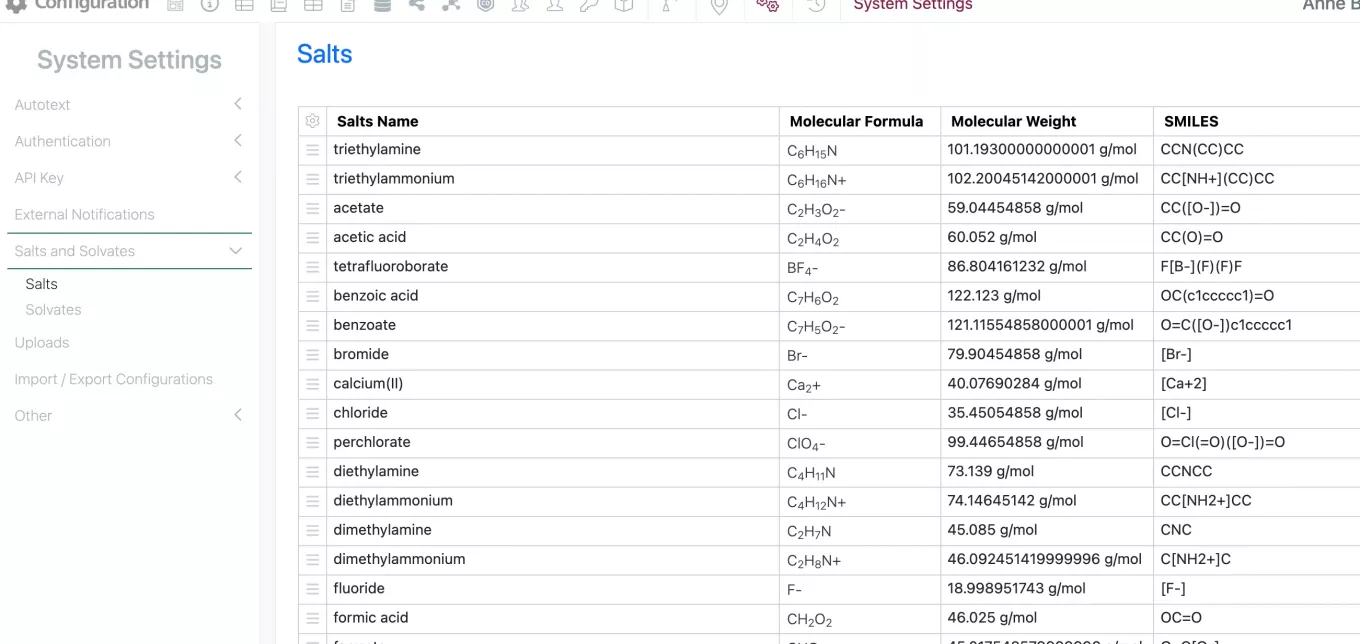
The structure option appears on both the Asset and Batch level record definition.
The Normalized Compound Material type comes with an out of the box Salt Stripper. To utilize this Salt Stripper during registration, the Admin must ensure that SMILES have been loaded in the Salt table on the SN Config.
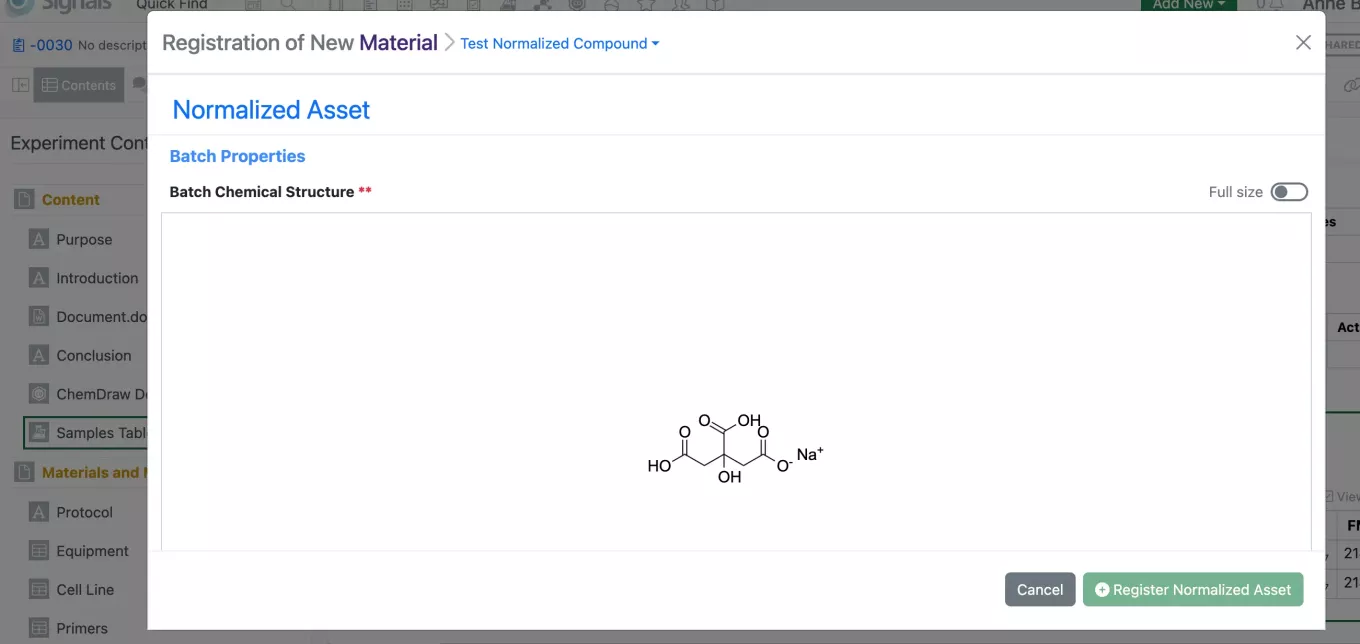
If the Salt SMILES have been loaded, when the user goes to register a new material with a salt to the new Normalized Compounds library, the CDWS Salt Stripper will automatically recognize the presence of the salt. The stripped/normalized structure will be returned on the Asset level and the stripped salts will be added to the Salts table on the batch level.
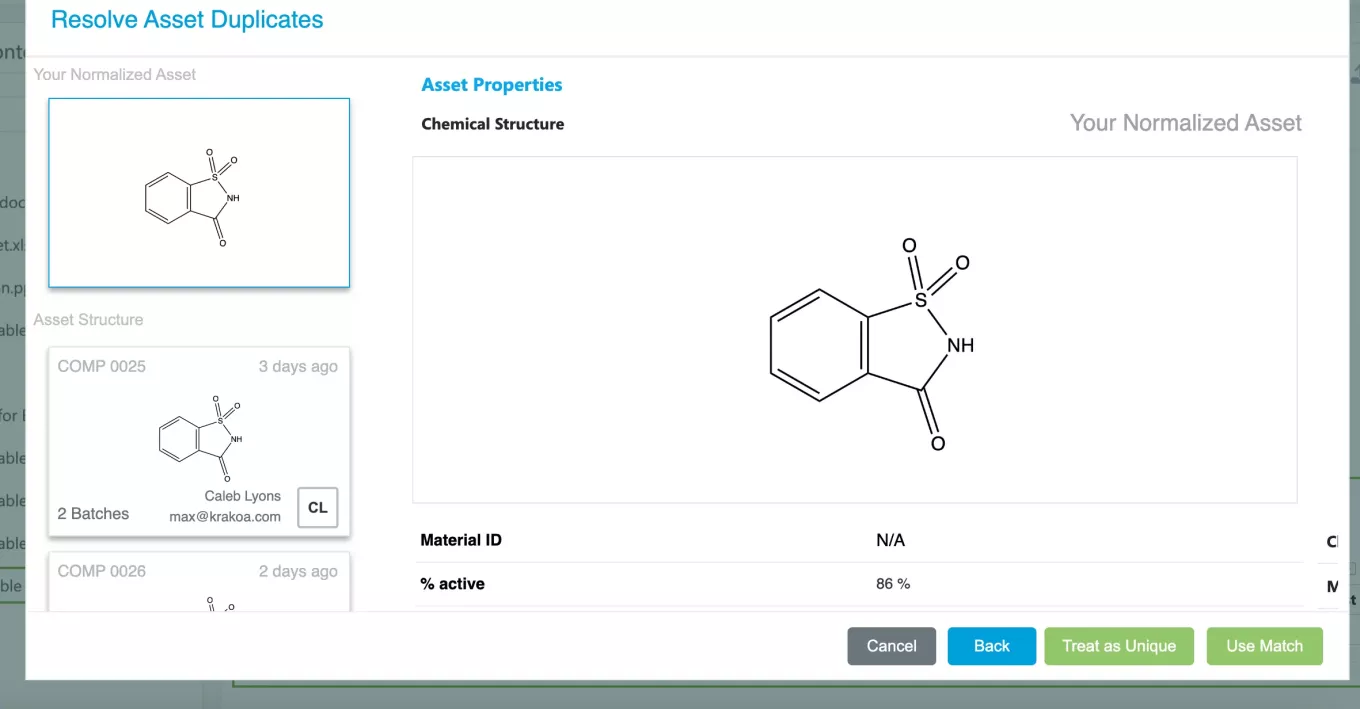
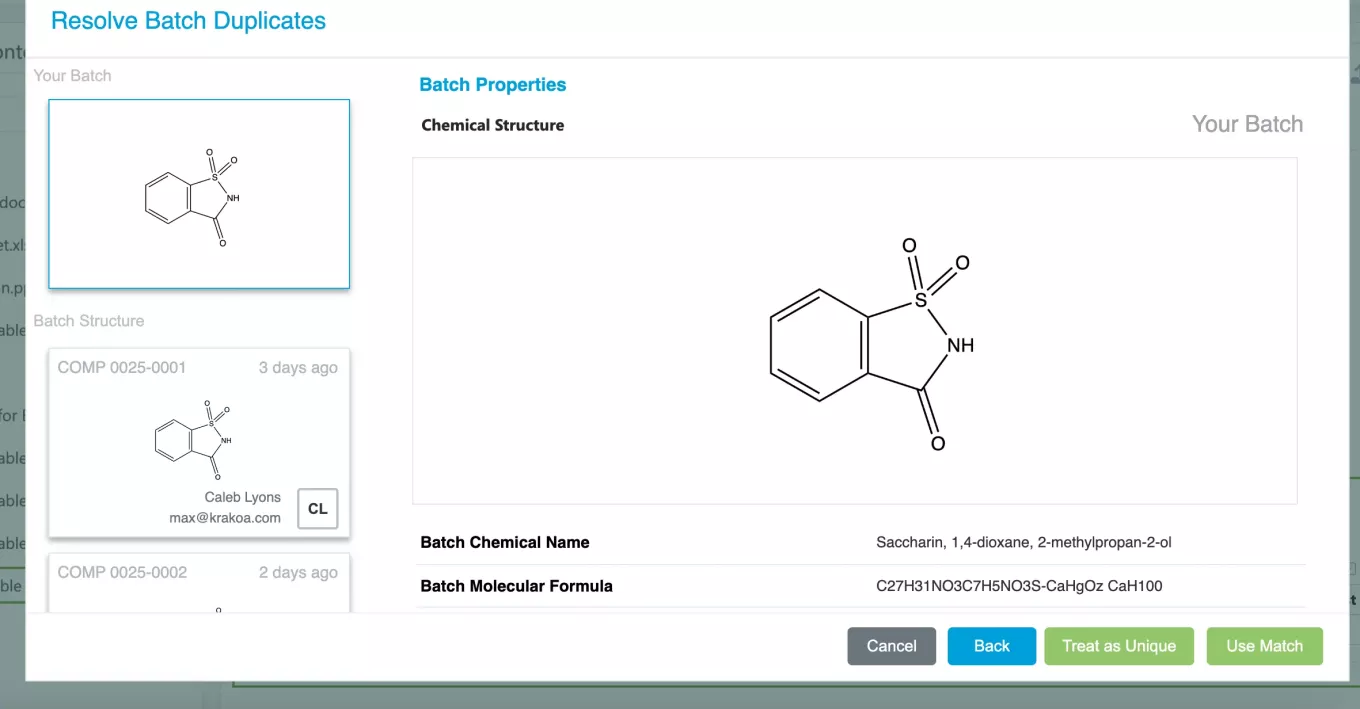
On the registration modal the user will be able to review the normalized structure, the salt form at the batch level, and the stripped salts prior to registration. When they hit Register, the Normalized structure with undergo uniqueness checking against all other registered Asset level structures in the library, if a match is found, the user will be able to either use the match or treat as unique. If the user selects “Use Match”, the Batch level structure will undergo uniqueness checking against all other batches in the chosen asset.
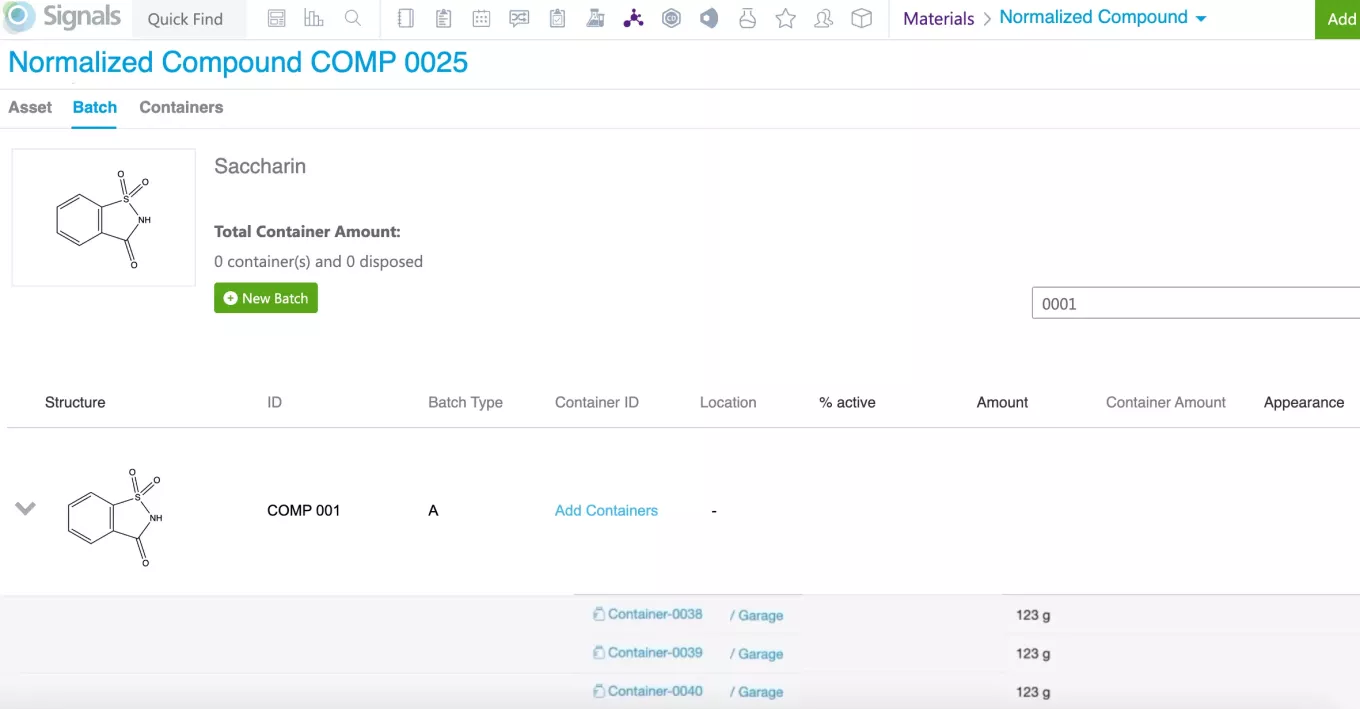
If a match is found the user will be prompted to either use the match or treat as unique. If the user elects to “Use Match” the new batch will be registered under the same Batch Type as the selected match. If the user opts to treat the batch as unique, the batch will be registered with a new Batch type.
On the Material page users will have a preview of the Batch Structure visible.
What's New
This version 24.3 release of Signals brings a series of enhancements to the ChemCharts in Signals Inventa. We have also improved the Variation Table summary views and made this capability available to all systems. We have also made all of a series of improvements around Internal reference fields available to all systems. We have continued to work on our ongoing beta capabilities for the inventory container search table and new beta capabilities around creating Tasks and other Materials from Materials. Finally, we have also fixed a number of small bugs.
The following improvements are available for users of Signals Notebook Individual Edition, Signals Notebook Standard, Signals Notebook Private Cloud, Signals Research Suite Standard and Signals Research Suite Private Cloud. Certain features may only be available with appropriate licensing and/or with enablement by an administrator.
• Fundamentals
– Type or paste of internal references available to all systems
– Mapping CSVs with Internal references to tables available to all systems
• Inventa
– Redesigned Admin Configuration of Inventa Entities and Measurement Types
– Advanced HELM visualizations and analytics with ChemCharts
– ChemCharts Data Functions for Biological Sequence annotation
– New query and data summarization tool, the Integrated Summary App (beta)
• Variation Tables
– Horizontal and Vertical Summary views available to all systems
– Choose Component properties for display in Vertical Summary view
– Updated preview view
• Inventory
– Container Search Table (beta)
• Materials
– Bulk uploads of Materials with internal references available to all systems
– Bulk updates of Materials with internal references available to all systems
– Creation of Child Replicate Materials (beta)
– Creation of Child Materials from Materials Smart Folder (beta)
• Tasks and Requests
– Assign an Analyst during Task Creation and from the Task Container (beta)
– Create Tasks from Materials in Experiments (beta)
– Notification for Task creator regarding assigned analyst access (beta)
– Notification for Analysts when assigned a Task (beta)
– Create an Experiment from a Task Container (beta)
• Administration
– User Access events in Admin Audit trail will capture origin and proxy IP address
• Integrations & APIs
– Inventa/SDF Maps Public API
– POST /entities endpoint when creating Task now matches the UI behavior
– POST /entities endpoint when creating a Worksheet allows for a Name to be specified
– A new endpoint has been created to export all content of an Entity and its children
We also fixed several small bugs in this release. Details of the enhancements are described below.
The following OnDemand videos for Signals Notebook Administrators has been updated
• Attributes - How Best to Apply and Utilize
Developers should note that the primary APIs available for Signals Data Factory are being modified and ultimately deprecated in Signals Research Suite. Where relevant these primary API endpoints are being replaced as needed with public APIs available via the Data Factory Swagger page. If you currently use these primary APIs on Signals Research Suite, please contact our Support for further guidance.
Administrators should note that when using Import Maps in Signals Data Factory, attributes no longer use attributeName as the name, but instead simply use name.
Developers in Signals Notebook and Signals Research Suite should note that the endpoints GET /attributes/{eid} and PATCH /attributes/{eid} will soon only return the "counts" object in the "attributes" object if a new query parameter is specified. This change will be made in a future release.
Developers should note that the POST /entities endpoint has been updated for creating Tasks. This update aligned the API behavior to match that of the UI, specifically regarding the display of columns for Task properties when adding Tasks to the Task table. Task tables will now always unhide the columns for properties defined in the new Task's associated Task Template, all other property columns will remain in their current state.
Administrators should note that we are changing the requirements around the unique naming of notebooks in a future release. Once this change is delivered, notebook name uniqueness will be case sensitive, and hence names differing only in case will be allowed. This behavior only applies for when Global Numbering is not enabled for notebooks.
Developers in Signals Notebook and Signals Research Suite should note that Inventory will be updated to give more meaningful error codes, the error codes provided via the External API will now better align the API with the user interface, specifically regarding 4xx (400, 409 and 412) error codes. This change will be made in a future release. The following codes will now be returned: 456 (BARCODE_IN_USE), 457 (INVALID_COORDINATES), 458 (NAME_IN_USE), 459 (TYPE_NOT_EDITABLE), 460 (ANCESTOR_NOT_EDITABLE), 461 (PROPERTY_OR_FIELD_NOT_EDITABLE), 462 (ENTITY_IN_USE), 463 (NOT_A_GRID),464 (INVALID_TYPE), 465 (CONTAINER_NOT_DISPOSED), 466 (CONTAINER_DISPOSED_OR_FINAL_DISPOSED), 467 (TYPE_NOT_SUPPORTED), and 468 (VALUE_OUT_OF_BOUND).
Administrators are recommended to subscribe to the channels within our support news site found at https://support.revvitysignals.com/hc/en-us/categories/360004446171-Support-News which contains more information about releases and other pertinent product information.
This content is anticipated for release on our Production E3 environments, and for Private Cloud customers on our deferred release schedule, in July 2024.
The following improvements are available for users of Signals Notebook Individual Edition, Signals Notebook Standard, Signals Notebook Private Cloud, Signals Research Suite Standard and Signals Research Suite Private Cloud. Certain features may only be available with appropriate licensing and/or with enablement by an administrator.
Fundamentals
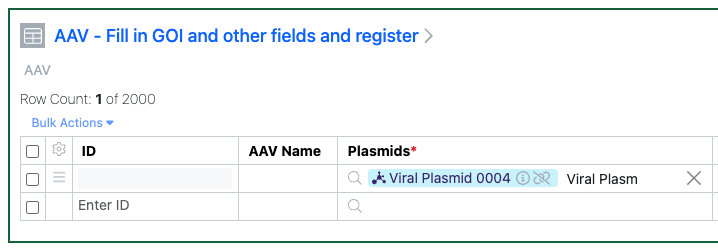
The ability to type or paste internal reference values, previously released in beta, is now available to all systems.
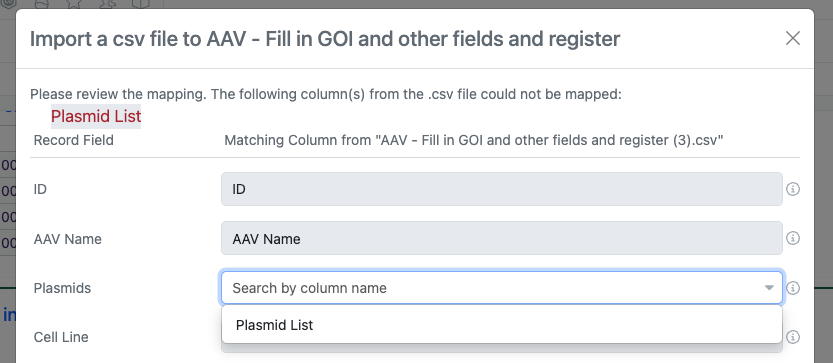
The ability to map internal reference values during CSV import to tables, previously released in beta, is now available to all systems.
Inventa
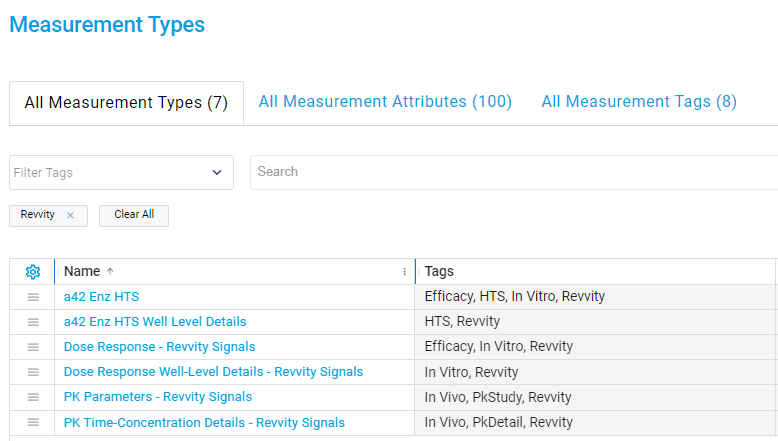
Data Factory’s entity and measurement type setup has been redesigned to streamline configuration.
A dedicated All Measurement Types section provides a sortable list of measurement types that can be filtered by admin-defined tags
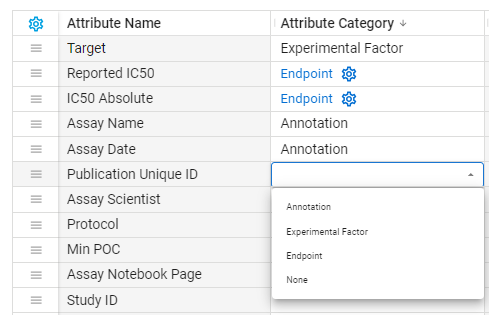
Endpoints, Experimental Factors, and Annotations can all be directly assigned from the Measurement Definition page

The Organizational Hierarchy and Endpoints now leverage a completely revamped and interactive Expression Canvas
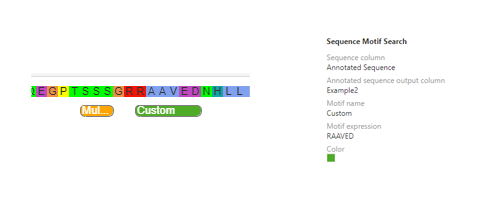
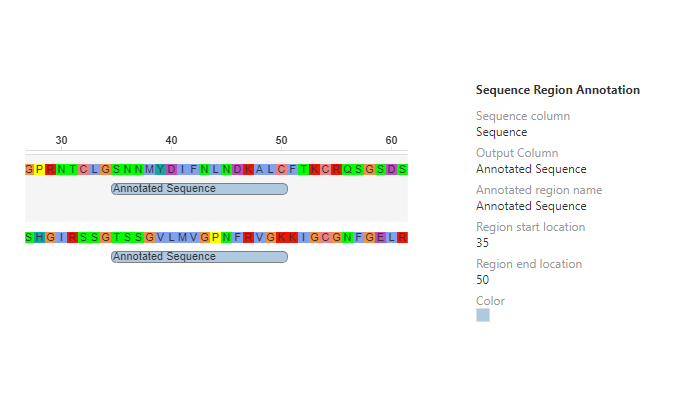
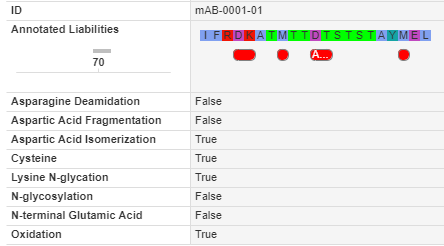
The ChemCharts Data Functions have been enhanced for Biological Sequence annotation.
Four new data functions support the removal of sequence gaps and annotation of sequences based on custom motifs, defined regions, or antibody liability sites


Advanced HELM visualizations and analytics have been added to ChemCharts.
HELM sequences can now be rendered in ChemCharts Tables

HELM rendering can be converted to a sequence like representation that supports annotations
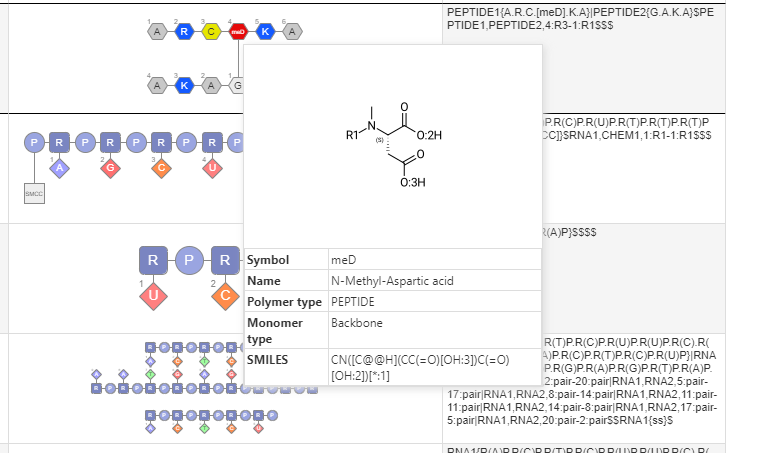
Monomers or annotations can be hovered over to display more information, with details extracted from the Signals Monomer Library
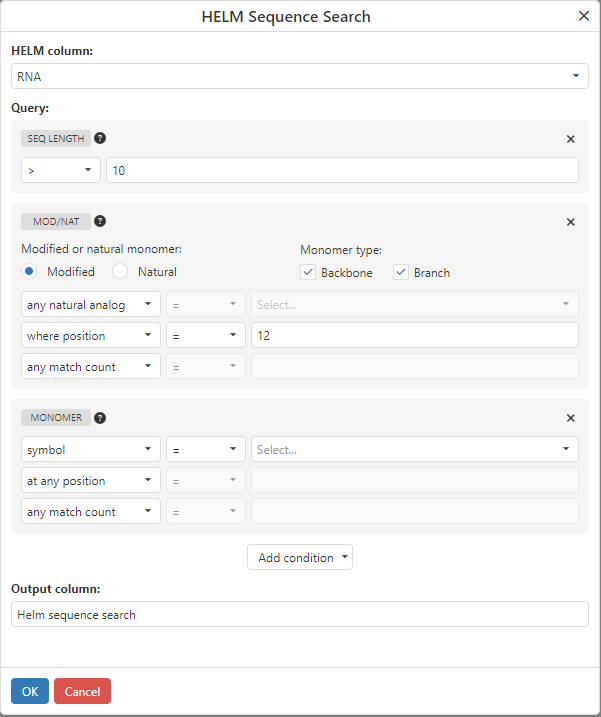
HELM-specific data functions have been introduced to support analysis of HELM sequences. Users can perform sequence alignment, sequence search, similarity search, translation, polymer extraction, and property calculations. An example of the advanced HELM sequence search panel is shown.
Variation Tables
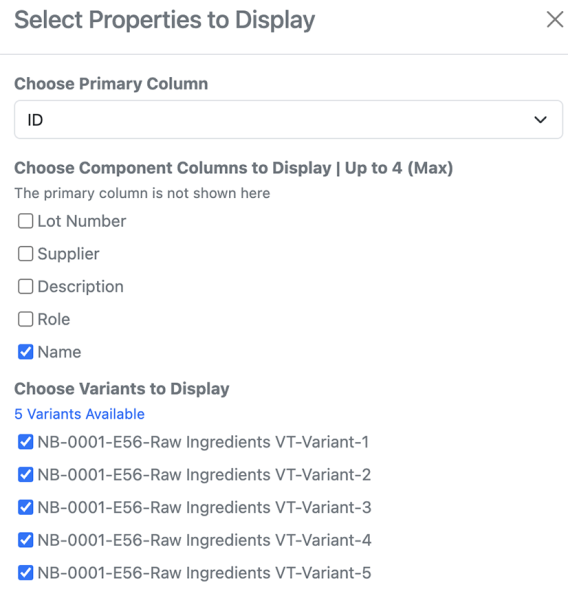
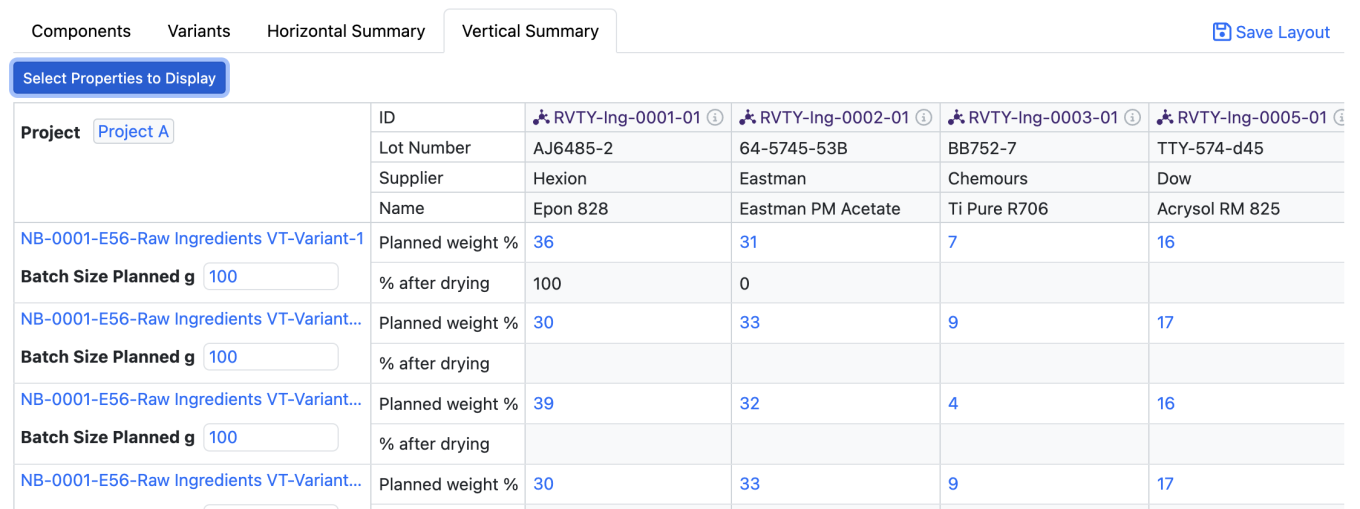
All variants will also now be selected for the Summary Tables unless otherwise unselected and the settings saved.
The administrative Preview and Try It Out views for Variation Tables are now available via the Preview button. This experience, which matches the experience for Worksheets, allows greater availability of the screen for definition of the tables.

The Horizontal and Vertical Summary views are now available to all systems.
The Vertical Summary view now also allows inclusion of Component properties for display. These can be selected from the “Select Properties for Display” popup.
Materials
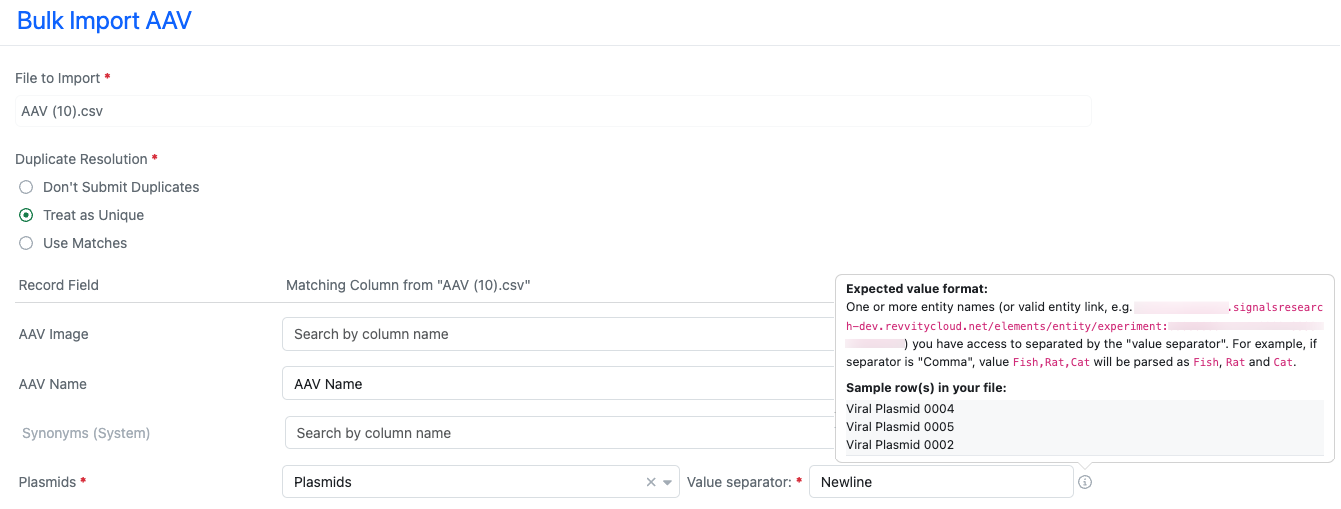
The ability map internal reference values during bulk import or bulk update of Materials, previously released in beta, is now available to all systems.
Administration
Access events in the Admin Audit trail will now record both the Originator and Immediate IP addresses when the user is accessing Signals Notebook indirectly, such as via a proxy server. This is common when a given organization uses a third party web gateway application, and that application does not remove the originator IP address. In such cases the audit trail will reflect that a given user accessed from the origin IP address via the proxy IP address. Any intermediate IP addresses are not shown.
Integrations & APIs

Data Factory public API endpoints for creating, retrieving, and deleting maps are now available

Task creation behavior when utilizing the API has been updated to match that of taking the same actions via the UI.
The POST /entity endpoint has been enhanced for Worksheets. Developers may now specify a name to give to the worksheet as part of the request body when creating the new worksheet via API. This will overwrite the “name” attribute which by default is from the entities template.
This release contains a new set of asynchronous API endpoints to facilitate the bulk export of all an entities content, including its children and their respective content.
The new endpoints function as follows:
POST /entities/export/bulk/: This endpoint initiates the bulk export process for a specified entity. There are query parameters to specify if you want only the entity, the entity and its child entities, or the entity, its child entities and all their child entities. There are additional parameters to specify data types for chemical/stoichiometry formats. The request returns a Job ID for checking the status.
GET /entities/export/bulk/{jobId}: This endpoint allows users to check the progress of the export process. It provides real-time updates on the status of the export request.
GET /entities/export/bulk/{jobId}/contents: Once the export process is complete, users can use this endpoint to download a boundary separated .dat file.
The first part of this .dat file is a JSON object representing the table of contents of an experiment. It includes information about the experiment and its children, such as their eid (Entity ID), name, content type and content part for easily finding the specific content in the file.
The subsequent parts contain the actual content referenced in the table of contents separated by a boundary marker.
The following capabilities are in beta and are only available to users and administrators of Signals Notebook Standard, Signals Notebook Private Cloud, Signals Research Suite Standard and Signals Research Suite Private Cloud upon request. Please contact your account representative or our support team if you would like access to the following features. They are unavailable as part of Signals Notebook Individual Edition.
Inventa

We have added a new query and data summarization tool, the Integrated Summary App. The Integrated Summary App (ISA) provides a new approach for querying and summarizing data compared to the Global Search and SAR Analysis apps. The ISA has a more intuitive search interface that is further simplified by administrator configuration.
Administrators can set summarization methods per attribute within Data Factory. They can also define which attributes should be displayed by default in the downstream user search interface.
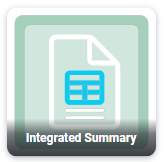
Signals Research Suite users can launch the new app from the Inventa Dashboard
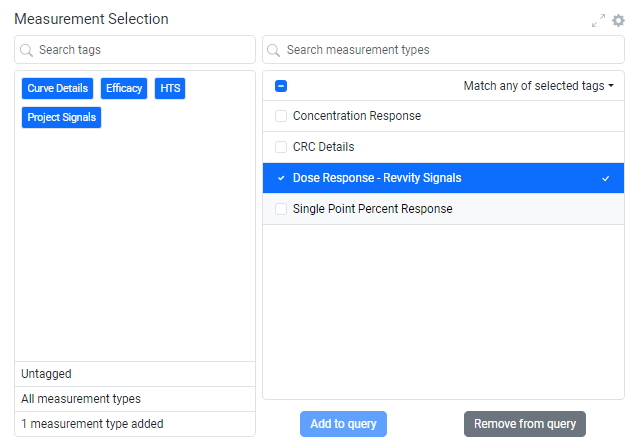
Users first specify a Data Factory Project to query and define any entity attribute criteria. To add a measurement type to the query, users browse a flat list of measurement types organized by admin-defined tags.
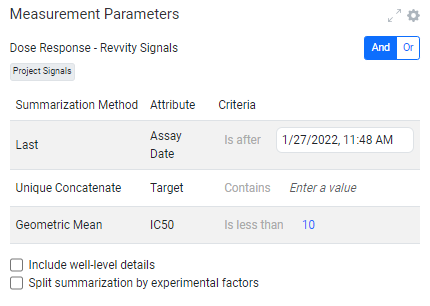
Once added to a query, users are shown a table of pre-selected attributes, where they can specify search criteria.
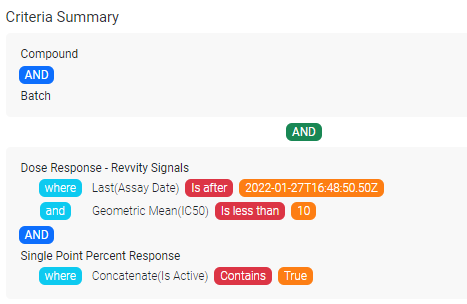

A summary of the query criteria is available for immediate review, along with an exact preview of the layout and columns that will be returned

Once downloaded, attribute data is summarized based on search criteria and organized by clear headers. Optionally, the individual measurement tables can also be downloaded and even automatically organized into a single, comprehensive data table.
Inventory
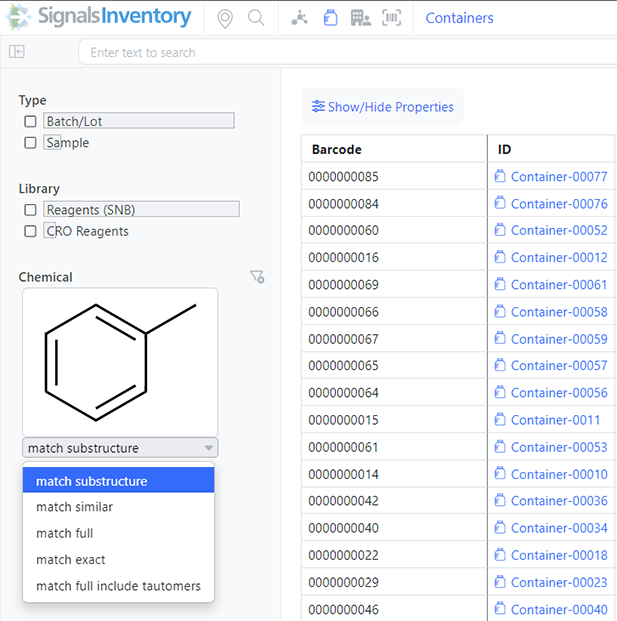
Container Search Table was updated to allow search by Chemical Structure to find containers:
Materials
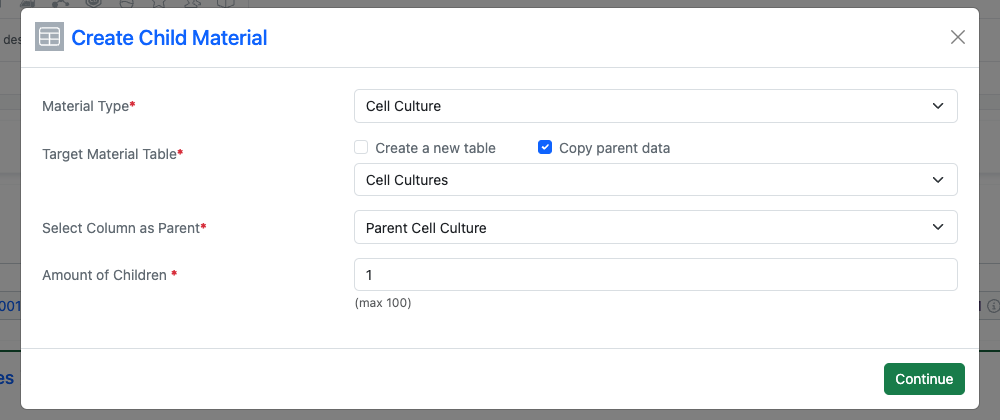
We have extended the ability to create child materials with new options from Materials Tables and the focus page of materials. When a user creates a child material of the same type as its parent, they will have the option to copy certain parent fields to the child material and to target the child material to the same table as the parent material. Previously a user would have to target the child material to an existing or newly created table.
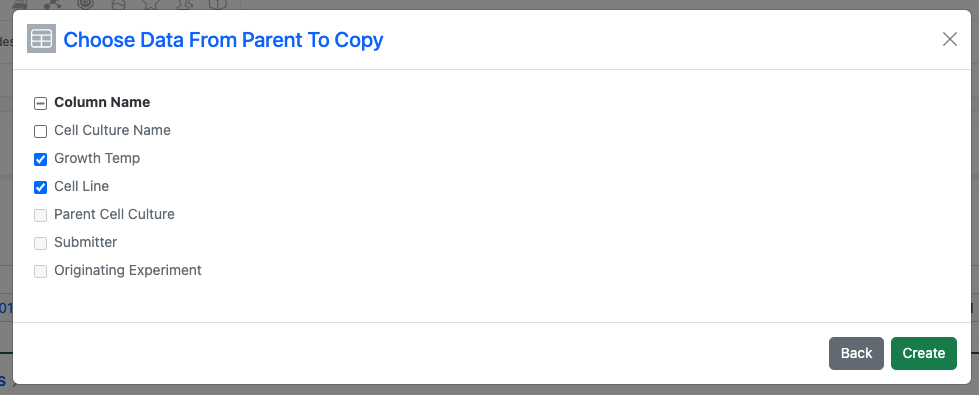
When the user selects “Copy parent data” the next screen will allow them to choose some or all the fields available for copying. Note that not all fields from the Materials Table are available for copying to the child material.

Once created, the user may add additional data and register the new child material.

Users may now also create a child material from the Materials Focus page, previously this option was only available from the Materials Tables.
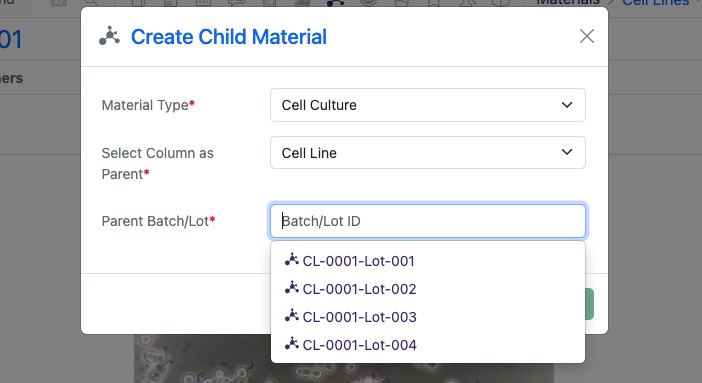
For Materials with Asset/Lot hierarchy, users will be asked to choose a parent lot for creation of the child and for self-replicates they will choose if they would like to copy data.
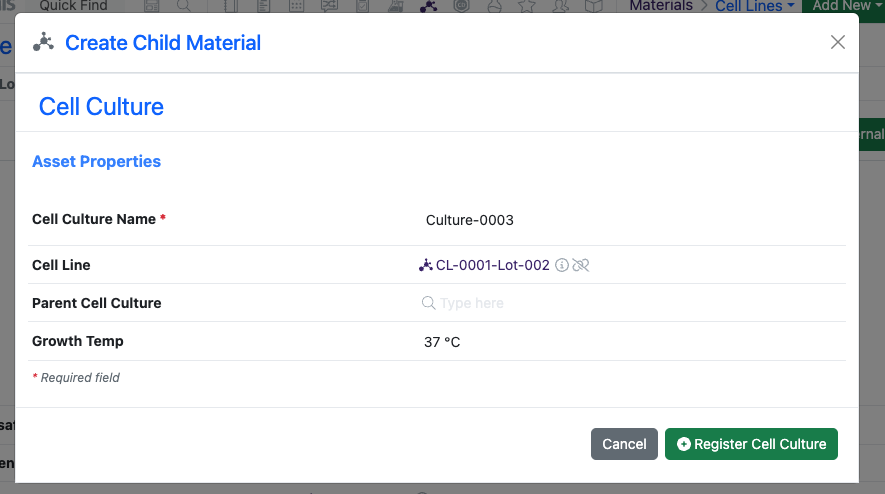
The user is then directed to a modal to populate meta-data of the child material with the parent link automatically populated. Once the user registers the new child Material, they will either go through duplicate resolution or end on the focus page of the newly created child material.
Tasks and Requests
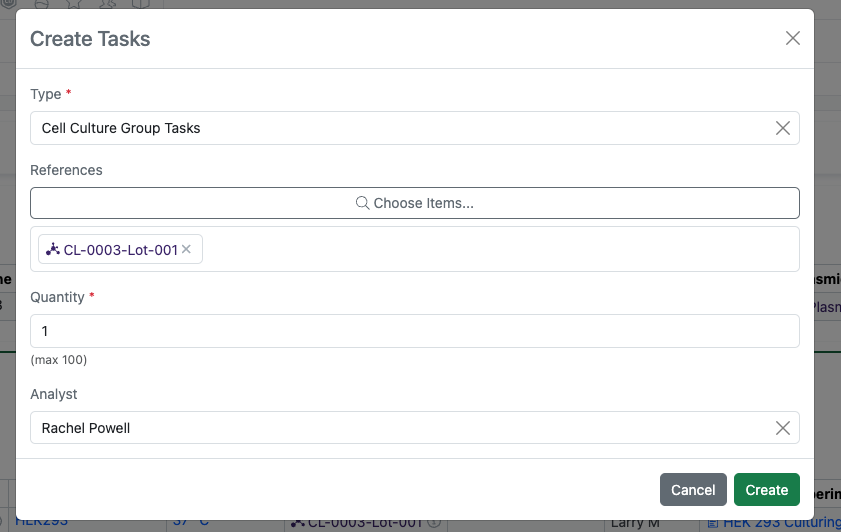
When creating a task, it is now possible to assign an analyst during the process. If the option to assign an Analyst during task creation is taken the created tasks will be automatically have a status of submitted.
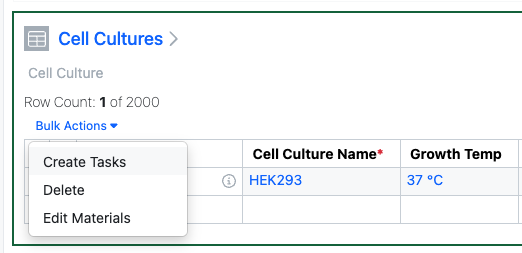
Tasks may be created and assigned directly from a Materials Table in the same Experiment. The status of the created task is dependent assignment of an Analyst at the time of creation.
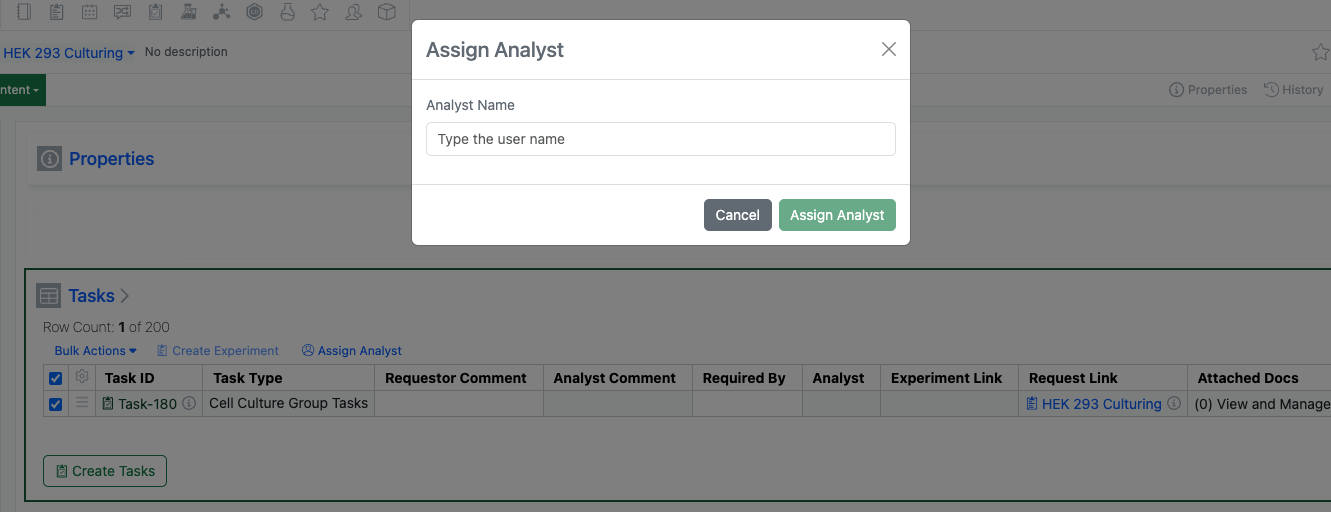
Tasks can also be assigned after their creation directly from the Task table. It is also possible for the assigned analyst to directly create an experiment from the Task table.

Analysts can now receive email and in-app notifications when they are assigned a Task. The notifications are set under the User Settings menu.
What's New
This version 24.2 release of Signals brings a redesigned Study Designer App to Signals VitroVivo, updates to Inventory including new label templates, and a URL redirect capability for text elements. We have continued to work on our ongoing beta capabilities for the Inventory Container search, and added a beta capability to Variation Tables to provide summary views of the data. Prior beta capabilities for Variation Tables and Plate Autolayout are now available to all systems. Finally, we have also fixed a number of small bugs.
The following improvements are available for users of Signals Notebook Individual Edition, Signals Notebook Standard, Signals Notebook Private Cloud, Signals Research Suite Standard and Signals Research Suite Private Cloud. Certain features may only be available with appropriate licensing and/or with enablement by an administrator.
• Fundamentals
– URL redirect in text elements
• VitroVivo
– Redesigned Study Designer App
– Updated end-to-end workflow to support Treatment Groups
• Chemistry
– Attach Data to annotate compounds and populate mol file SGROUP data
• Variation Tables
– Admin definition of Variations Tables available to all systems
– Admin definition of Auto Naming for Variants available to all systems
– End user addition of Variations Tables available to all systems
– Horizontal and Vertical Summary views (beta)
• Plates
– Additional Concentration units
– Plate Autolayout available to all systems
• Inventory
– New Label Templates for Containers
– Container Search Table (beta)
– Update to Advance Search Filters
• Integrations & APIs
– SDF Project Load Public API
– External APIs for Variations Tables
– POST Materials Table
We also fixed several small bugs in this release. Details of the enhancements are described below.
Administrators should note that we are changing the requirements around the unique naming of notebooks in a future release. Once this change is delivered, notebook name uniqueness will be case sensitive, and hence names differing only in case will be allowed. This behavior only applies for when Global Numbering is not enabled for notebooks.
Developers should note that the POST /entities endpoint is being updated for creating Tasks. This update is to align the API behavior to match that of the UI, specifically regarding the display of columns for Task properties when adding Tasks to the Task table. Task tables will now always unhide the columns for properties defined in the new Task's associated Task Template, all other property columns will remain in their current state. This change will be made in a future release.
Administrators and users are reminded that we are in the process of transitioning to new URLs for accessing the application. The new access URLs have been available since early December, we intend to remove the original URLs at the end of March. We encourage you to update relevant bookmarks and start transitioning to using the new URLs if you have not done so already. If you would like the original URLs to be removed prior to the end of March, please contact our Support team (https://support.revvitysignals.com/hc/en-us/requests/new). Further information on the ongoing changes to our URLs and the potential actions you may need to take can be found here: https://support.revvitysignals.com/hc/en-us/articles/20264670846740-Signals-Notebook-Upcoming-domain-changes.
Administrators are recommended to subscribe to the channels within our support news site found at https://support.revvitysignals.com/hc/en-us/categories/360004446171-Support-News which contains more information about releases and other pertinent product information.
This content is anticipated for release on our Production E3 environments, and for Private Cloud customers on our deferred release schedule, in July 2024.
The following improvements are available for users of Signals Notebook Individual Edition, Signals Notebook Standard, Signals Notebook Private Cloud, Signals Research Suite Standard and Signals Research Suite Private Cloud. Certain features may only be available with appropriate licensing and/or with enablement by an administrator.
Fundamentals
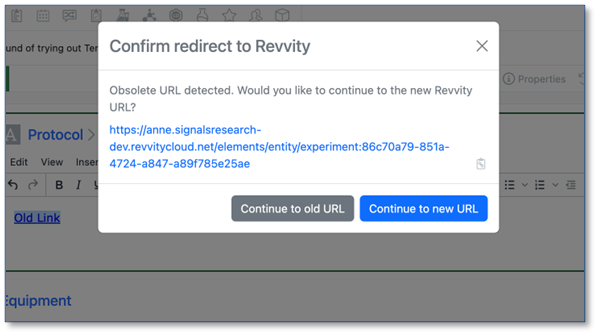
If a user has inserted a direct hyperlink that uses the previous tenant URLs (using a Revvity Signals based string) into a text element and a user clicks on that link, a popup will prompt the user to continue to the new Revvity URL. This redirect applies if the local environment is in a revvity domain, the two environments correspond (example: revvity prod to Revvity signals prod), the tenant name is the same, and the URLs are true URLs (http(s)://….).
VitroVivo
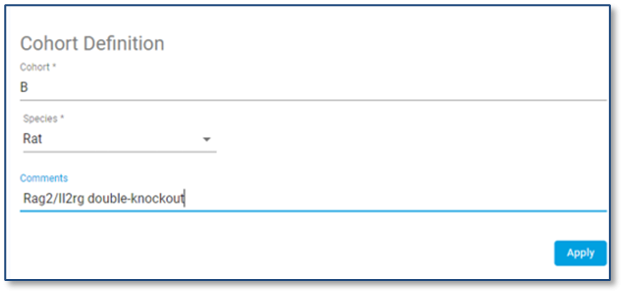
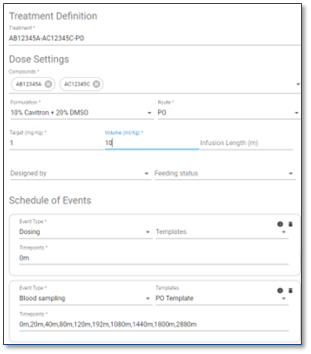
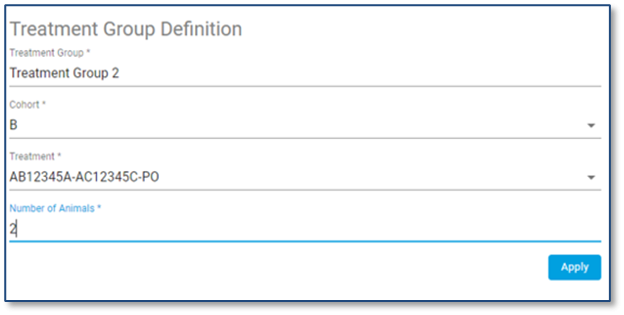
Users can now use the redesigned Study Designer App to define animal cohorts (e.g., Male or Female cohorts, Wild Type or Transgenic cohorts), specify treatments and create treatment groups by associating cohorts with treatments.
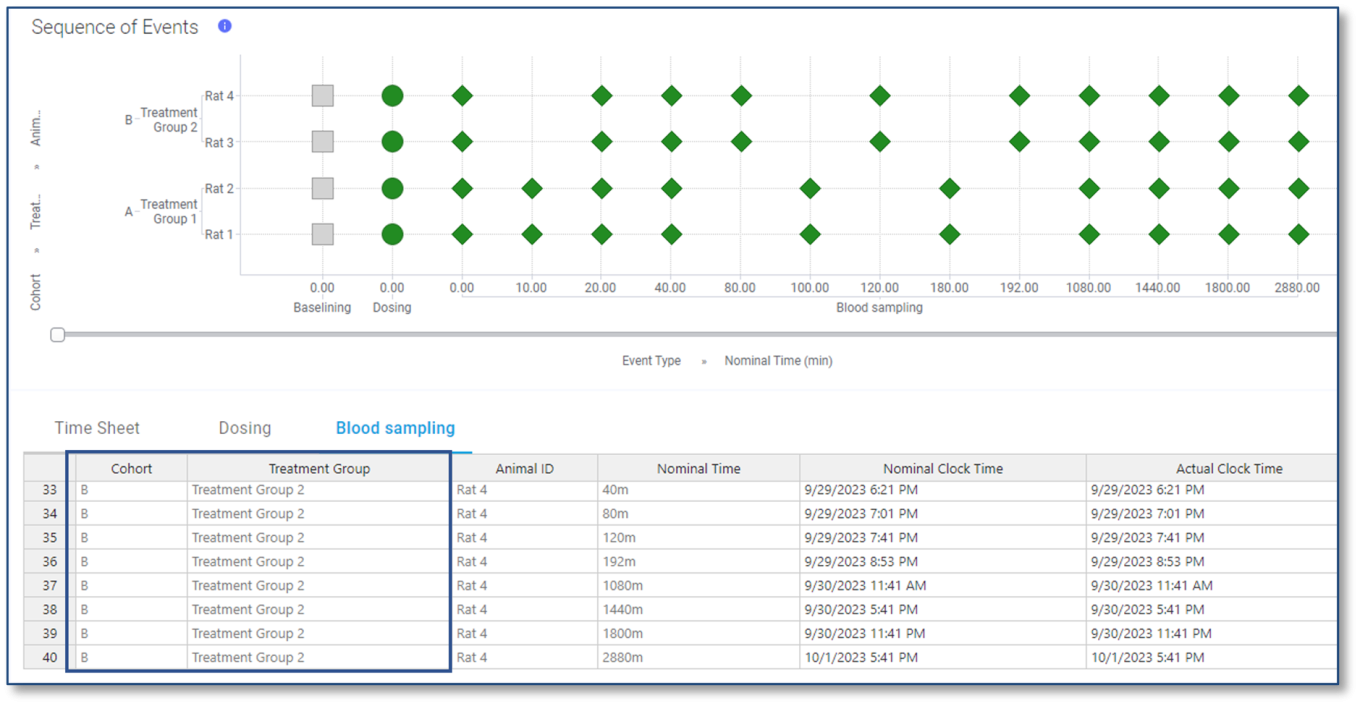
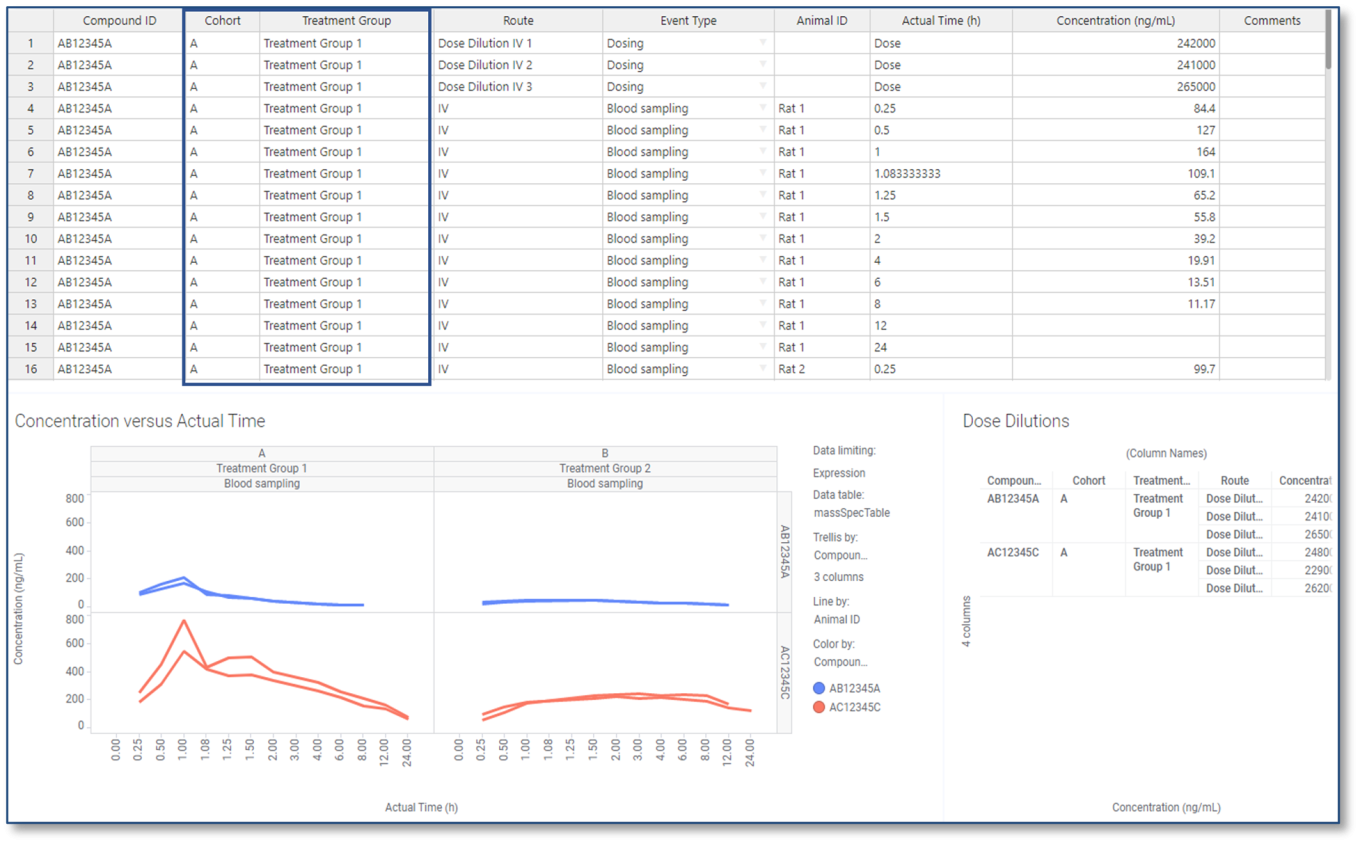
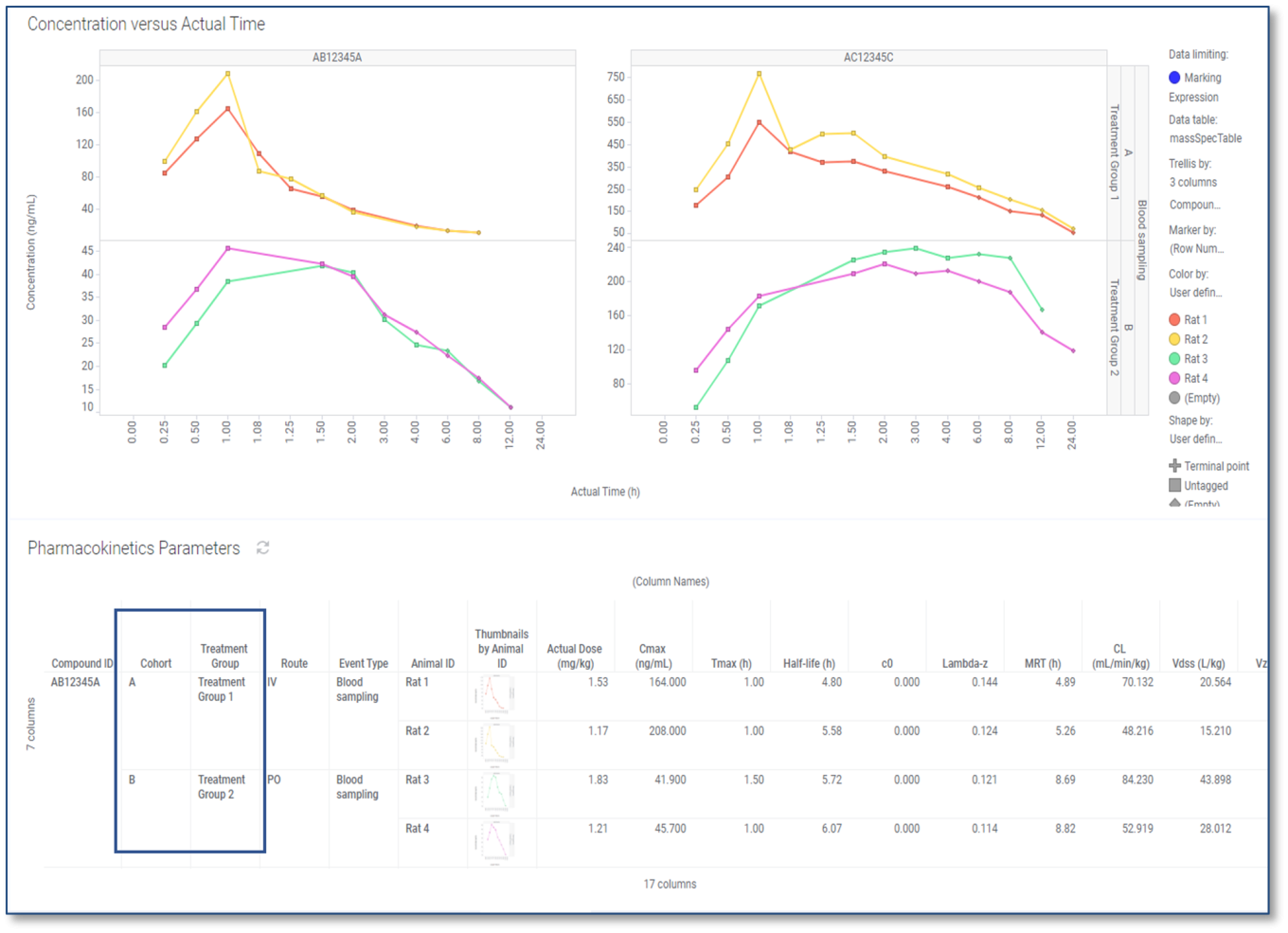
In vivo applications, including Dose Preparation, Baseline Capture, Sequence of Events, Sequence File Generator, Mass Spec, Dose Verification and PK Parameters Apps, have been revised to support Cohorts and Treatment Groups. Updated In Vivo Apps will now include representations of cohorts and their associated treatment groups in data visualizations.
Chemistry
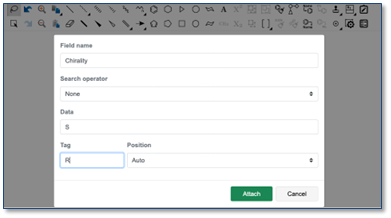
Chemists can now annotate part of their molecule using the “Attach Data” capability. This will allow annotation of a label to a specific part of a drawn molecule. If the structure is subsequently exported to a mol file, the annotation will be included in the SGROUP portion of the file.
Variation Tables
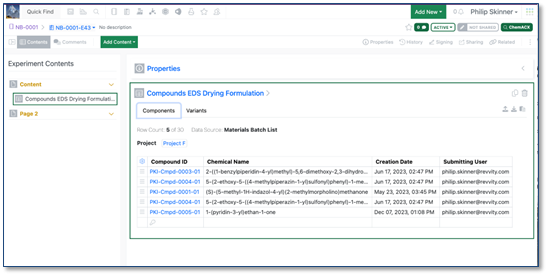
The definition of Variation Tables and their use by end users, previously released in beta, is now available to all systems.
Plates
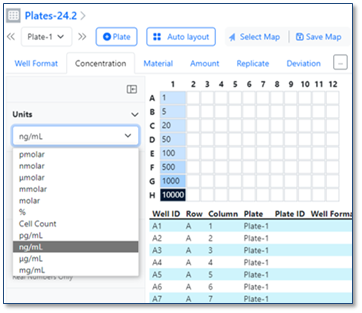
Users can now select density units (e.g., ng/mL, mg/mL etc) from the list of Units available within the Concentration annotation layer.
Inventory
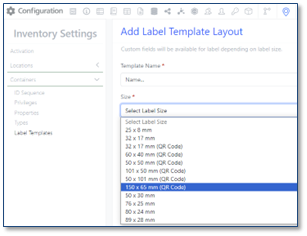
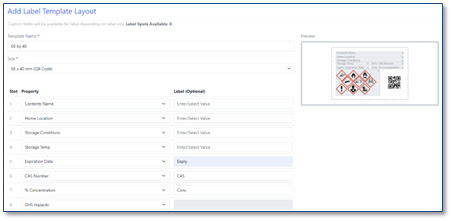
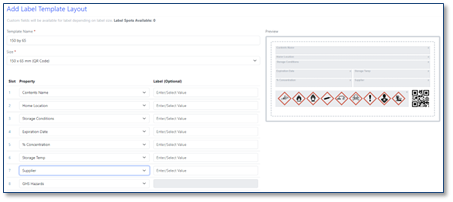
There are two additional label templates for containers to choose from: 60 x 40 mm and 150 x 65 mm with QR code and space for larger GHS Hazard pictograms:
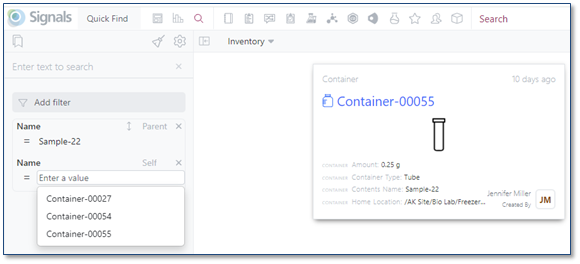
Update to Advance Search Filters: Users can change the Parent, Child or Self options on a per row basis within an AND or OR query box:
Integrations & APIs

The new Data Factory API endpoint, POST projects/{projectId}/datasets/{projectId}/actions/load supports initiating a “loadAll” or “loadNew” job for a given project ID.

The POST /entities endpoint has been enhanced to allow the creation of Materials Tables for specific for specific Material Libraries.
Additionally, API endpoints for Variants Tables are now available. Existing Entities endpoints have been enhanced to include Variations tables as appropriate. Notably POST /entities has been enhanced to allow for creation of Variants Tables.
Along with the above enhancement there are a set of new endpoints specific to Variants Tables. There are three main groups of endpoints: Adding/Removing/Copying new variants to a Variants Table, Adding/Removing/Updating the content of the component table, and Updating the content of individual variant tables.
The following endpoints are used to fetch, replace, and update a Variant Table’s variants.

PATCH /variationsTables/{eid}: Used for adding, deleting, or replacing variants in the Variations Table.

PUT /variantsTables/{eid}: Used to replace the contents of both the component table and variant table(s) simultaneously. This is used only to replace the existing tables. This is not used to create new variants.
The following endpoints are for fetching, adding, and updating the rows in the component table of the Variations table:

PATCH /variationsTables/{eid}/components: Updates the entire component table, adding, deleting, or updating rows.
PATCH /variationsTables/{eid}/components/{rowId}: Updates the content of a specific row in the component table.
DELETE /variationsTables/{eid}/components/{rowId}: Will delete the row in the component table and all variation tables.
The following endpoints are for fetching and updating the rows in an individual variant table of the Variations table and deleting an entire variant table:
PATCH /variationsTables/{eid}/variants/{variantId}: Used to update multiple rows in the variants table simultaneously.
You can only update variant specific columns, not those take from the component table itself. Updating the component table row columns will update all the corresponding variant table columns.
DELETE /variationsTables/{eid}/variants/{variantId}: Will delete the whole variant table specified. You may not delete individual rows of a variants table as they are directly tied to the components table. Deleting a row in the component table will delete it for all variation tables.
The following capabilities are in beta and are only available to users and administrators of Signals Notebook Standard, Signals Notebook Private Cloud, Signals Research Suite Standard and Signals Research Suite Private Cloud upon request. Please contact your account representative or our support team if you would like access to the following features. They are unavailable as part of Signals Notebook Individual Edition.
Variation Tables

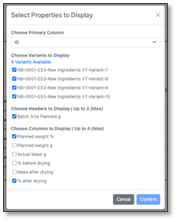

The end user can now view their Variants in a single Vertical or Horizontal summary view. Users select which Variants, Properties and Headers are displayed, the settings can be saved to be persisted. The Horizontal Summary must contain at least one of the Component properties. The user must select one of the Component properties to be displayed as the columns in the view.
Inventory
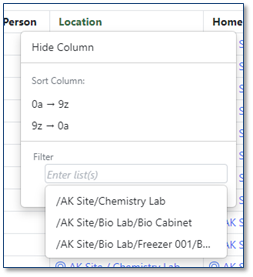
Container Search Table updates to the Location, Creator/User and Batch/Lot columns. The filter criteria selection box will remain available until users click out of the box.
Locations have been updated to be a type ahead that can have multiple options selected:
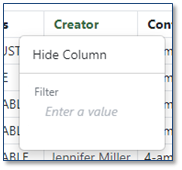
Creator/User columns have a type ahead instead of a long check box list:
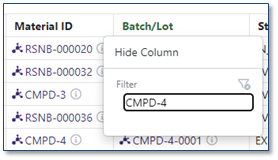
Users are now able to search for a Material ID or specific Batch/Lot by using the Batch/Lot column:
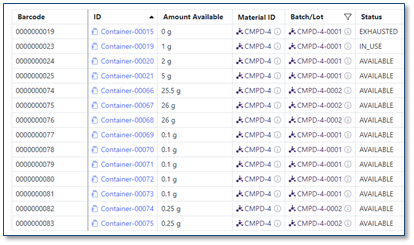
Typing in the Material ID will return all the batches/lots with containers associated:
What's New
This version 24.1 release of Signals brings a new beta capability to describe Variations Tables. Designed primarily for enabling variations of mixtures for formulation science, these are two tier hierarchical tables that facilitate the description of variations between similar sets of tabular data. We have added the ability to filter Internal references in ADTs to limit to objects within the same experiment or parent, and enhanced Materials Tables to display the hazard pictograms from the Materials used. We have continued to work on our ongoing beta capabilities for Container search in Inventory and on the use of entity names to populate Internal References, the previously beta capabilities around HELM monomer management and curation are now available on all systems. Finally, we have also fixed a number of small bugs.
The following improvements are available for users of Signals Notebook Individual Edition, Signals Notebook Standard, Signals Notebook Private Cloud, Signals Research Suite Standard and Signals Research Suite Private Cloud. Certain features may only be available with appropriate licensing and/or with enablement by an administrator.
• Fundamentals
– Mapping CSVs with Internal references to tables (beta)
• Chemistry
– HELM Monomer editor available to all systems
– HELM Monomer Curation Application available to all systems
• Admin Defined Tables
– Filter for “In this Experiment” for ADT internal reference searches
• Variations Tables (beta)
– Admin definition of Variations Tables
– Admin definition of Auto Naming for Variants
– End user addition of Variations Tables
• Materials Tables
– Hazard Pictograms in Material Tables
• Worksheets
– Before/after views for Recorded reasons for Change included in printed PDF
• Inventory
– New Label Templates for Containers
– Container Search Table (beta)
– Move Location Privilege
• Materials
– Bulk download of Chemistry based Materials with file attachments
– Bulk uploads of Materials with internal references (beta)
– Bulk updates of Materials with internal references (beta)
– Bulk import/export chemical materials as SMILES or InChI available to all systems
– Bulk update of chemical Materials with SMILES, InChI, or HELM available to all systems
– Bulk upload of HELM Materials available to all systems
• Tasks and Requests
– Task statuses display with new colors
• ELN Archive
– API key for ELN archive can be managed by System Administrators
• Administration
– Admin Audit Log shows users IP address for user login events
– Addition of SMILES data to the Salts list in SN Config
– Privileges to manage HELM Monomer Libraries available to all systems.
– Configuration Transfer of HELM Monomer library available to all systems.
• Integrations & APIs
– Public APIs for Inventa/SDF
– Enhanced SCIM endpoints to allow license assignment
We also fixed several small bugs in this release. Details of the enhancements are described below.
The following OnDemand videos for Signals Notebook End Users are now available
• Getting Started with Signals
Developers should note that the GET /entities endpoint has been updated to exclude Trashed Items by default. The "includeOptions" will now default to "untrashed" when no explicit parameters are specified. To get the current pre-change behavior you can include "trashed,untrashed" as the "includeOptions". This will not impact users who are already using specific "includeOptions" as part of their usage of the endpoint.
Administrators and users are reminded that we are in the process of transitioning to new URLs for accessing the application. We added the new access URLs shortly after the prior release and intend to remove the original URLs at the end of March. We encourage you to update relevant bookmarks and start transitioning to using the new URLs if you have not done so already. If you would like the original URLs to be removed prior to the end of March, please contact our Support team (https://support.revvitysignals.com/hc/en-us/requests/new). Further information on the ongoing changes to our URLs and the potential actions you may need to take can be found here (https://support.revvitysignals.com/hc/en-us/articles/20264670846740-Signals-Notebook-Upcoming-domain-changes).
Administrators are recommended to subscribe to the channels within our support news site found at https://support.revvitysignals.com/hc/en-us/categories/360004446171-Support-News which contains more information about releases and other pertinent product information.
This content is anticipated for release on our Production E3 environments, and for Private Cloud customers on our deferred release schedule, in July 2024.
The following improvements are available for users of Signals Notebook Individual Edition, Signals Notebook Standard, Signals Notebook Private Cloud, Signals Research Suite Standard and Signals Research Suite Private Cloud. Certain features may only be available with appropriate licensing and/or with enablement by an administrator.
Chemistry
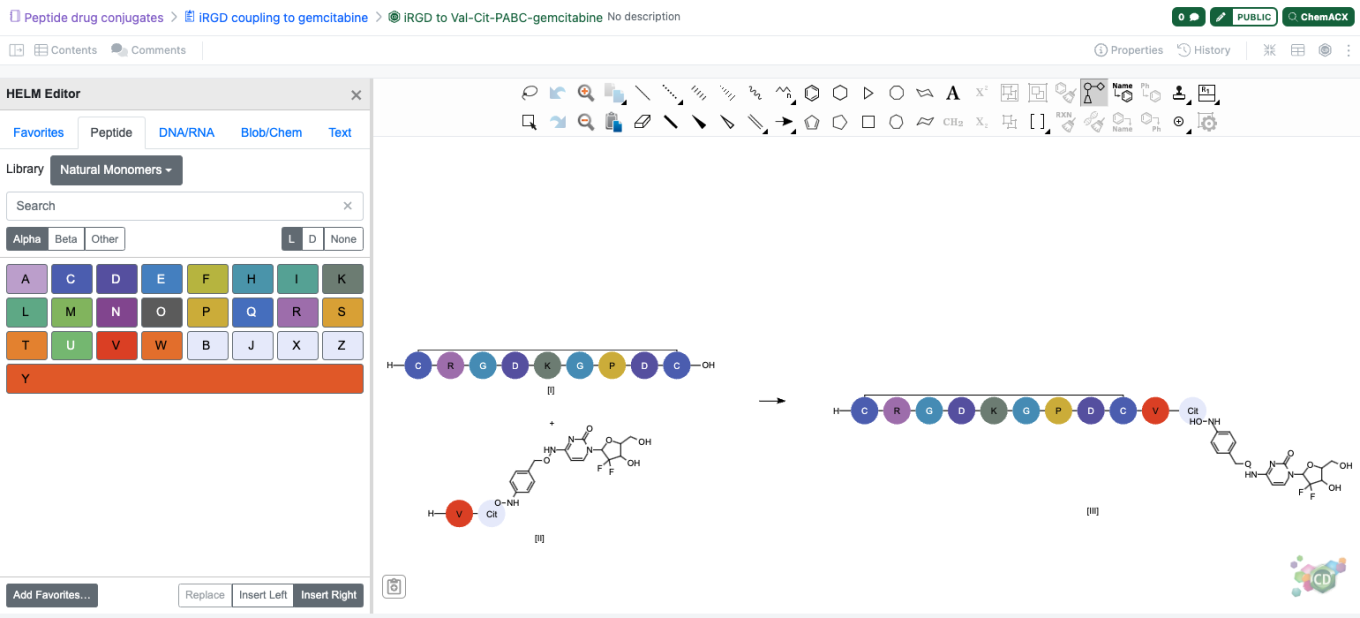
The Hierarchical Editing Language for Macromolecules (HELM) Editor is available to all systems with this release. The tool allows users to represent biopolymers and other structures rapidly with monomer building blocks. The tool is available across Signals Notebook with any ChemDraw canvas. To use the tool a System Administrator must activate at least one HELM Monomer library and enable user access.

The HELM Monomer Curation app is now available to all systems. This enables management of custom monomers and custom monomer libraries.
Admin Defined Tables
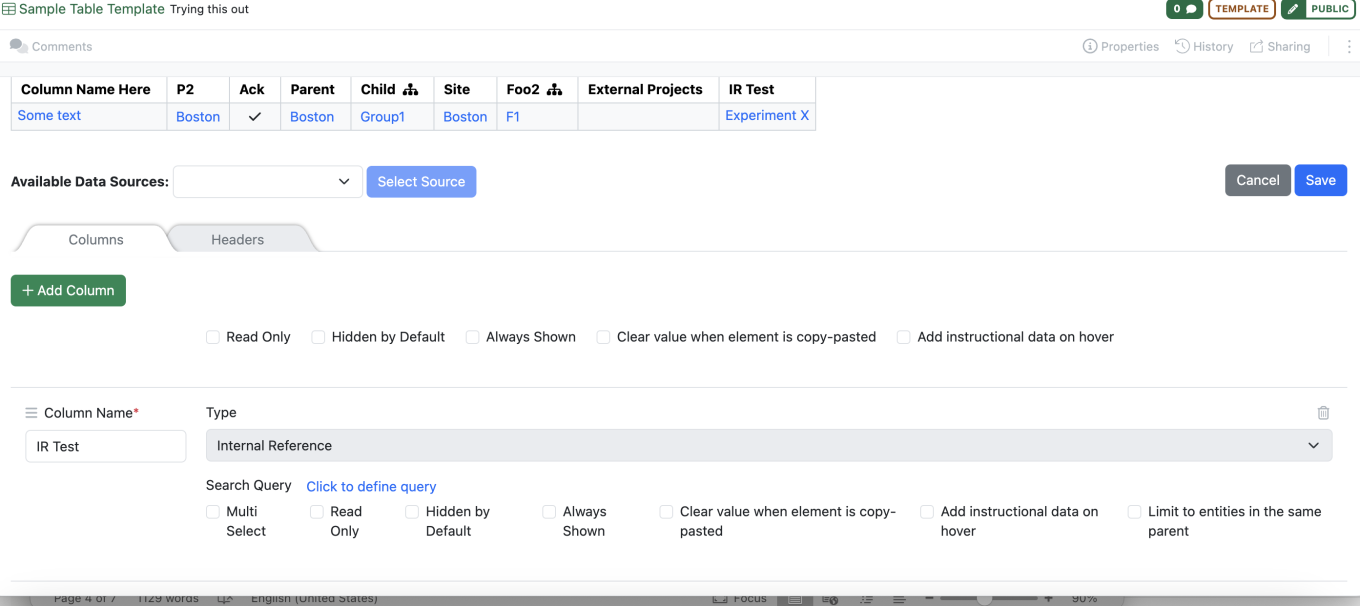
There is a new option to limit the queries for internal references in ADTs to return objects/entities within the same parent as the ADT. For example, if the “Limit to entities in the same parent” is selected and the query is defined to return Samples, then the end user will only be able to see samples within their current experiment.
Materials Tables

Hazard Pictograms are now available in Material Tables:
Worksheets

Before/after views of the changes in Locked fields, resulting in a Recorded Reason for Change, are now optionally included in the exported PDF output. If the value in a Locked field is changed, and the user is forced to record a reason for the change, the before/after view is recorded in the History of the Experiment. Now, if the Experiment is exported to PDF and the History included, the event for the change will also print the before/after views.
Inventory
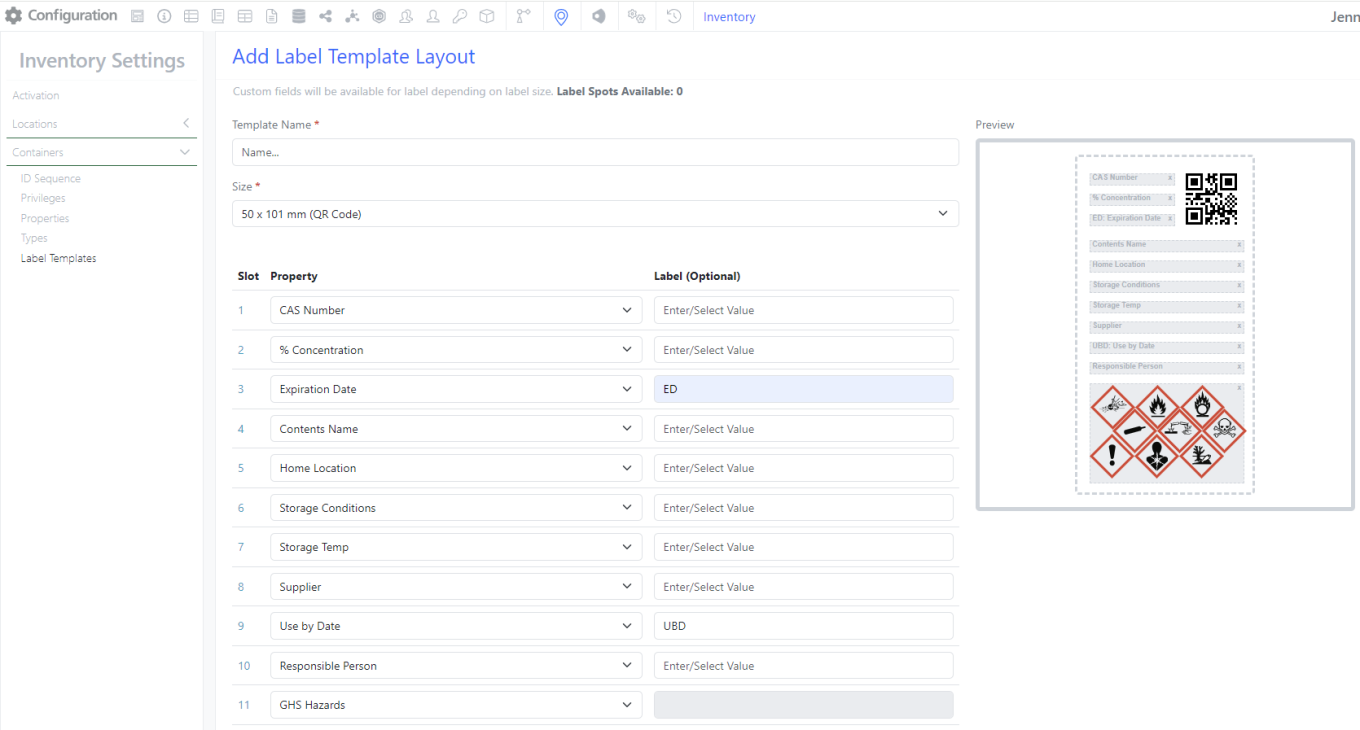
New Label Template for Containers 50 by 101 mm with QR code and space for hazard pictograms:
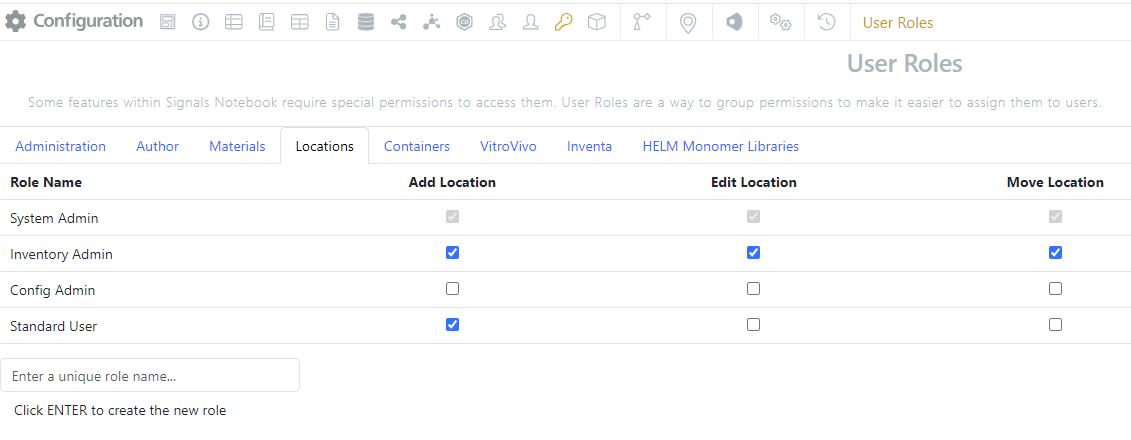
Label will be available for users after the Administrator has saved the template.
New User Role privilege has been added to allow Administrators to select User Roles to allow users to move the contents of a given location. This privilege previously was only available to Inventory Administrators:
Materials
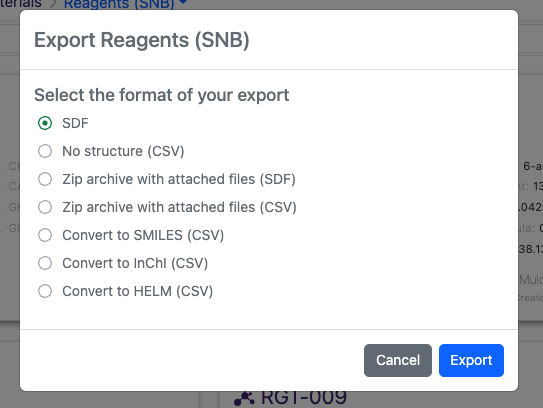
There are now options to include file attachments when exporting chemical type Materials such as Compounds or Reagents (SNB). User may choose to download a zip archive with or without chemistry if they wish to obtain attachments with those downloads.
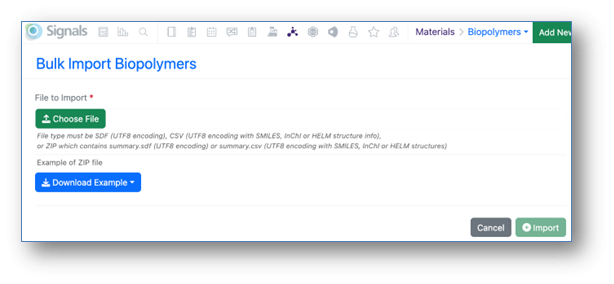
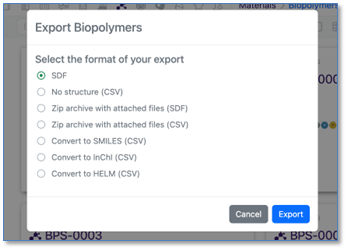
The previously released beta capabilities whereby users may bulk import, export, or update Materials with Chemical structures using SMILES, InChI, or HELM formats are now available to all systems. There are format requirement prompts on each relevant page and example download files for both bulk import and update pages.
Tasks and Requests
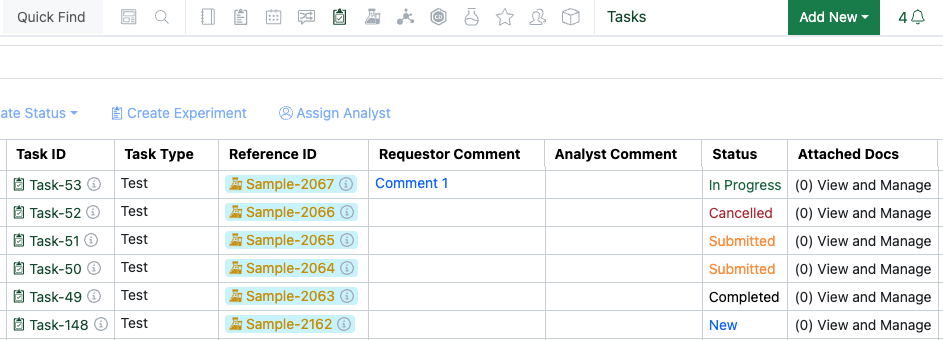
Task statuses have new colors to help users distinguish between them. The new status colors display on the Task table, Task-to-do table, Task Dashboard, and individual task screens.
ELN Archive
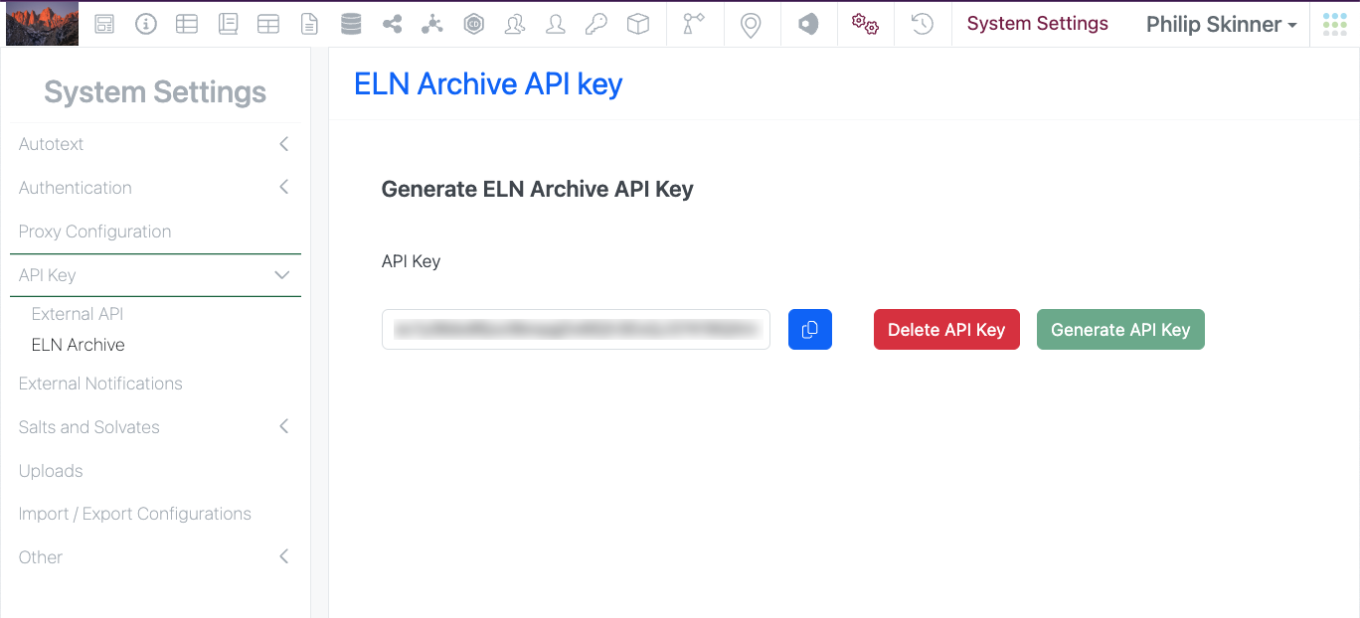
For customers who have the ELN Archive enabled, the API key for the archive can now be managed directly in SNConfig. System administrators can create new keys, delete keys and copy existing keys.
Administration
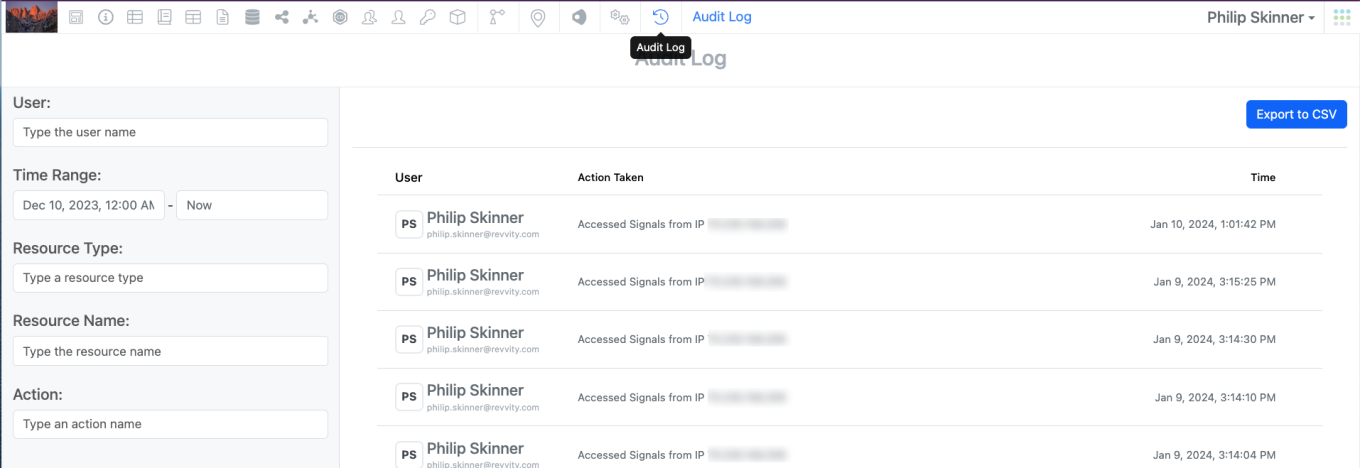
The Admin Audit Log will now record the IP address used when a User Access event is recorded.
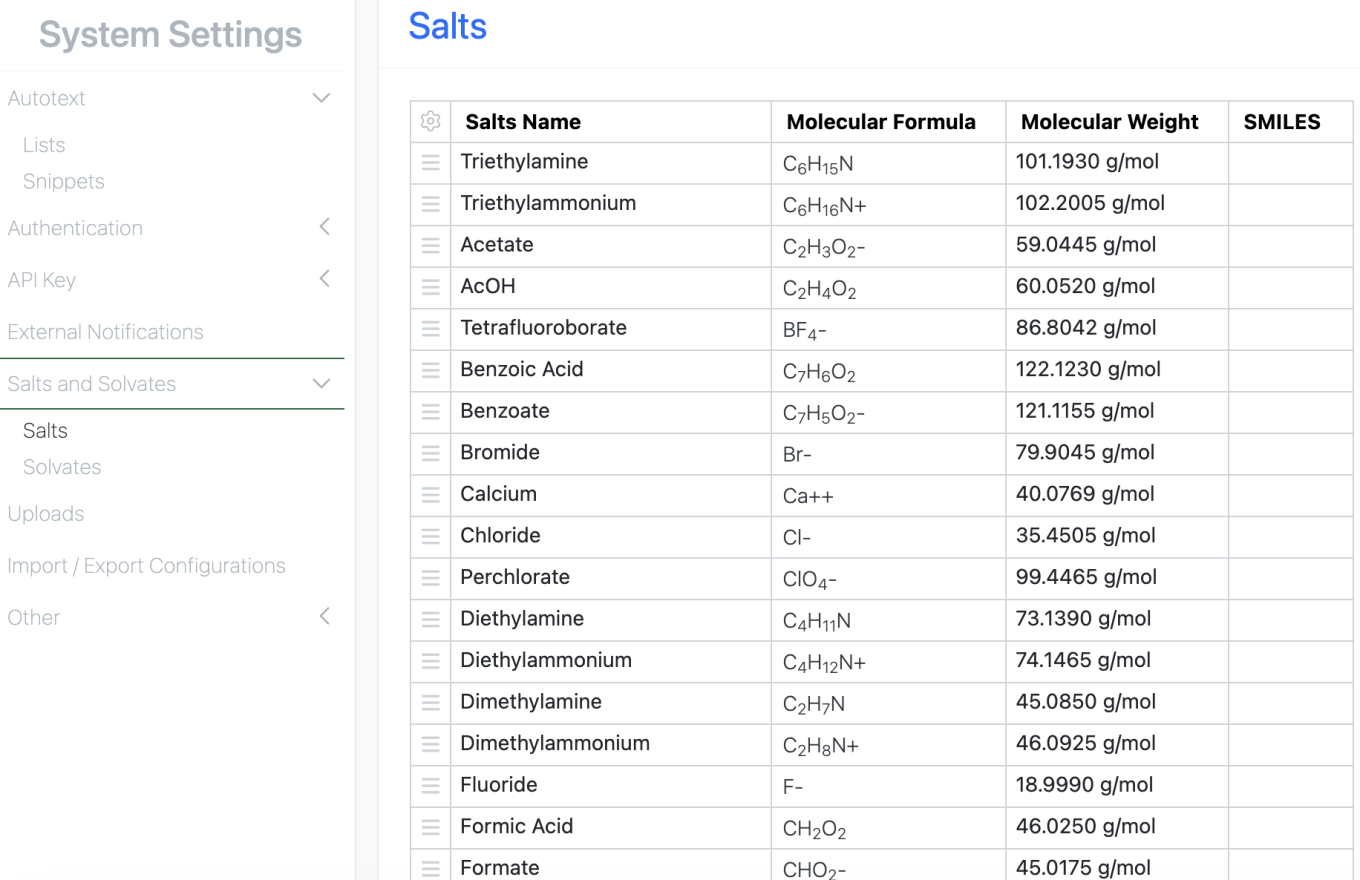
There is now the option to load SMILES data into the Salt table under System Settings.

Admins can generate their own SMILES strings using chemdraw or bulk load the SMILES data for all system salts by exporting the System salts list to csv then uploading that csv to bulk update the salt list. The SMILES data be utilized in future capabilities being developed within the Materials Library.
Privileges to manage HELM Monomer Libraries available to all systems. System administrators can assign privileges to user groups for access and management of HELM Monomer libraries.
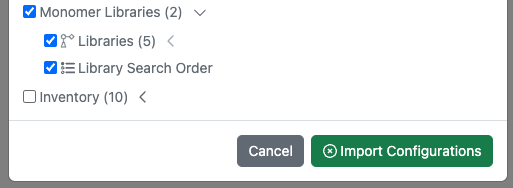
Configuration transfer for HELM Monomer libraries is available to all systems. The configuration of custom libraries as well as the HELM Monomer library search order can be included in a transfer between Signals tenants.
Integrations & APIs
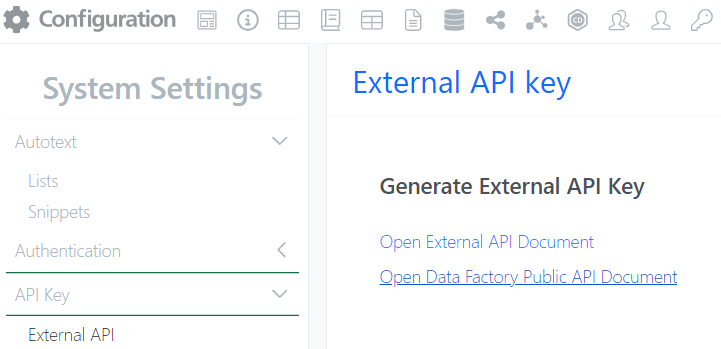
The first set of Public APIs for Inventa/Signals Data Factory are now available. They can be accessed from the System Settings within SNConfig.

The GET/POST projects endpoints support retrieving a list of Inventa projects and creating a new project

The GET/DELETE projects/{projectId} endpoints support retrieving or deleting Inventa projects by their identifier

The GET/POST projects/{projectId}/datasets endpoints support retrieving a list of datasets for an Inventa project and creating a dataset within a project

The GET/DELETE projects/{projectId}/datasets/{datasetId} endpoints support retrieving and deleting specific dataset in a project based on the dataset ID

The GET/POST projects/{projectId}/datasets/{datasetID}/datasources endpoints support retrieving a list of datasources for a specific project dataset and creating a new datasource for a specific project dataset.

The GET/DELETE projects/{projectId}/datasets/{datasetId}/datasources/{datasourceId} endpoints support retrieving and deleting a specific datasource in a dataset

The POST projects/{projectId}/datasets/{datasetId}/datasources/{datasourceId}/actions/update-settings endpoint supports modifying the settings for a specific datasource

We will continue to expand the list of available Data Factory public APIs in future releases.
SCIM Endpoints have been updated to support management of user licenses. This allows API users to check, update, and delete licenses from a User individually or in bulk via enhanced SCIM endpoints.
The SCIM Schema endpoints have been updated to include licenses as part of the UserProperties:
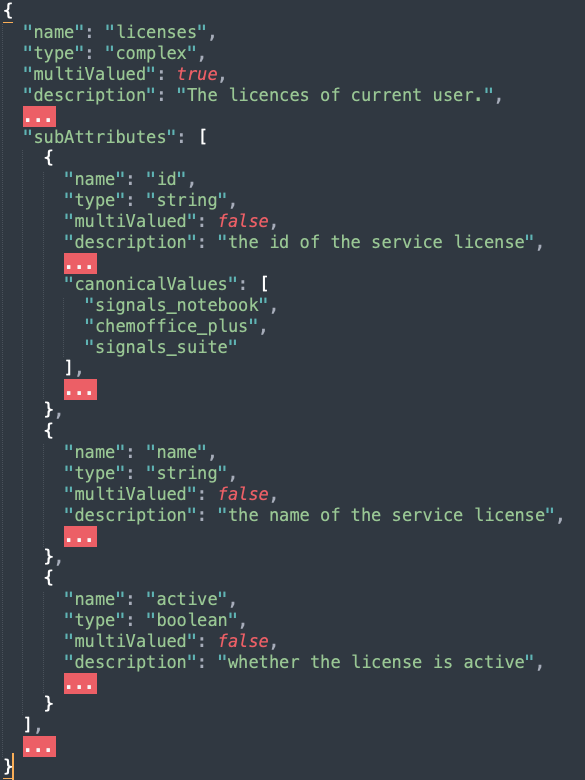
The SCIM Schema endpoints have been updated to include licenses which includes three subAttributes – “id” representing the id of the license, “name” representing the name of the license, and “active” representing whether the license is active:

The GET SCIM User endpoints have been updated to include the user’s licenses:
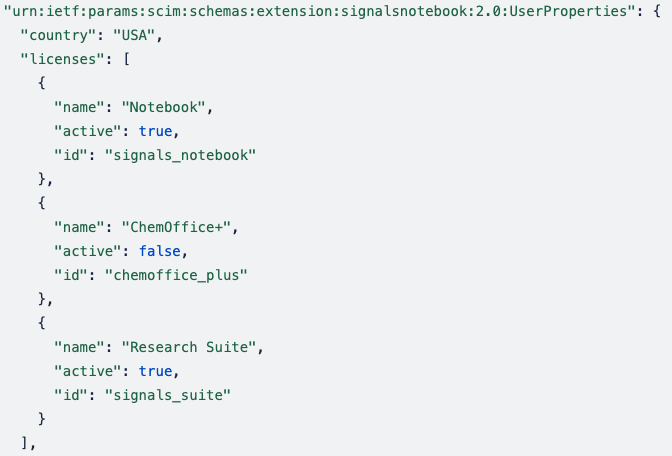
All of a user’s licenses are returned in the “licenses” object in the UserProperties:

The PATCH and PUT SCIM User endpoints have been enhanced to activate and deactivate licenses for a user:
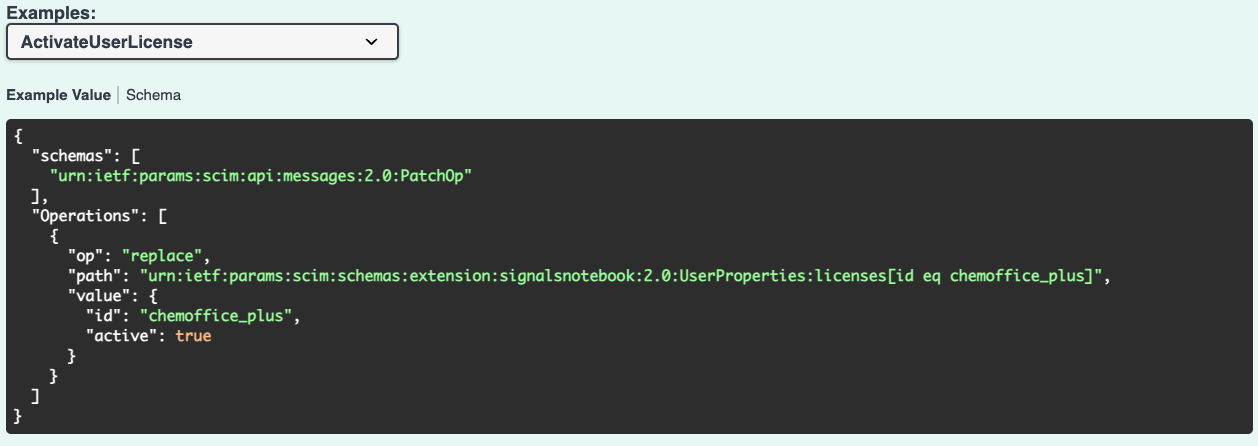
Example body of an activate request via the PATCH SCIM Users endpoint:
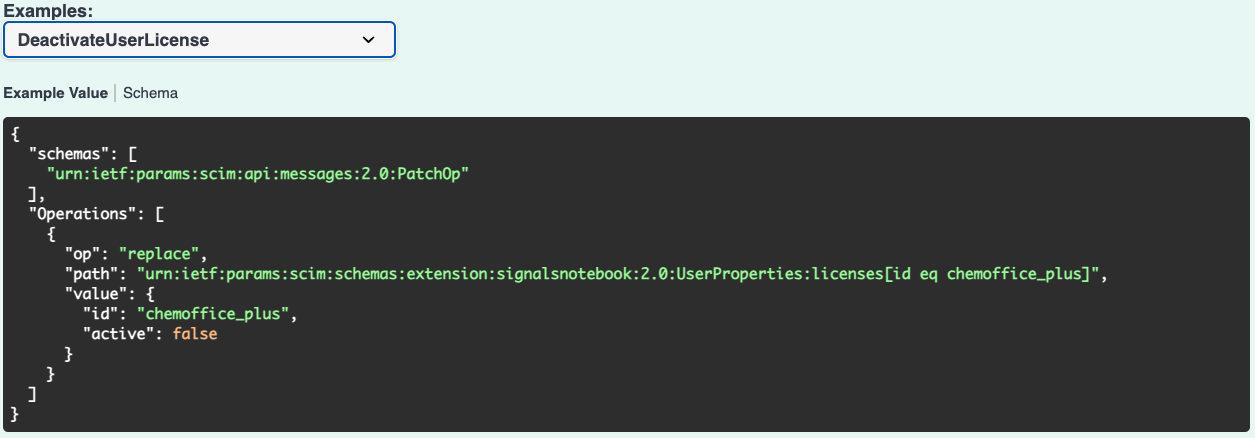
Example body of a deactivate request via the PATCH SCIM Users endpoint:
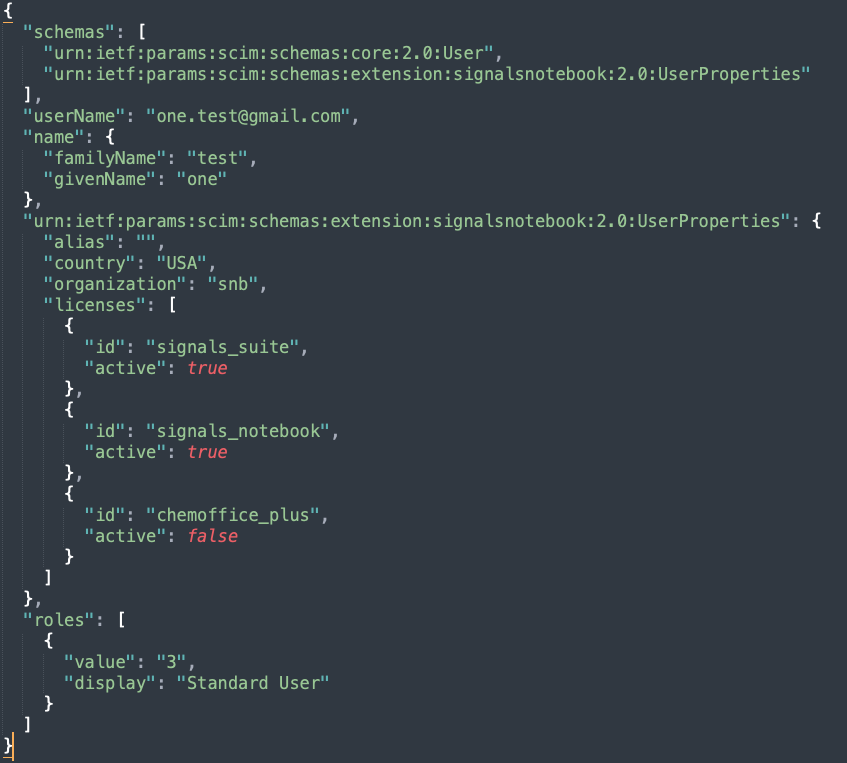
Example body for updating multiple licenses via the PUT SCIM Users endpoint:

The above operations are available in bulk via the SCIM Bulk endpoint:
The following capabilities are in beta and are only available to users and administrators of Signals Notebook Standard, Signals Notebook Private Cloud, Signals Research Suite Standard and Signals Research Suite Private Cloud upon request. Please contact your account representative or our support team if you would like access to the following features. They are unavailable as part of Signals Notebook Individual Edition.
Fundamentals
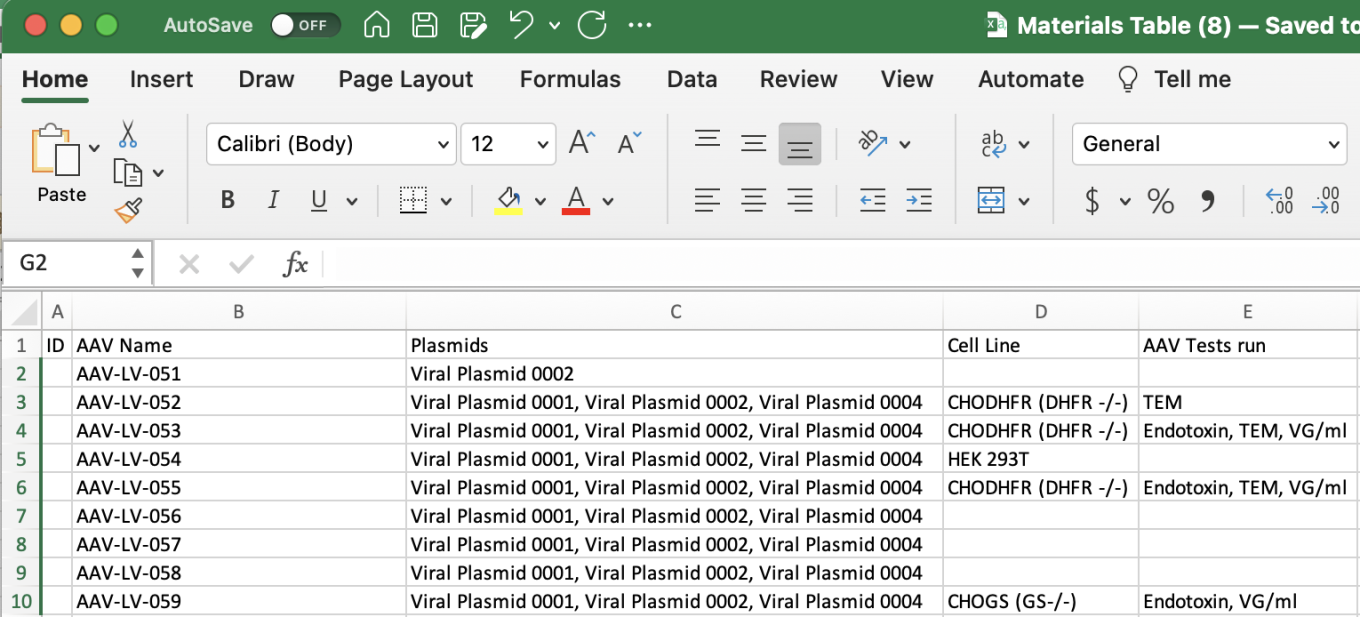
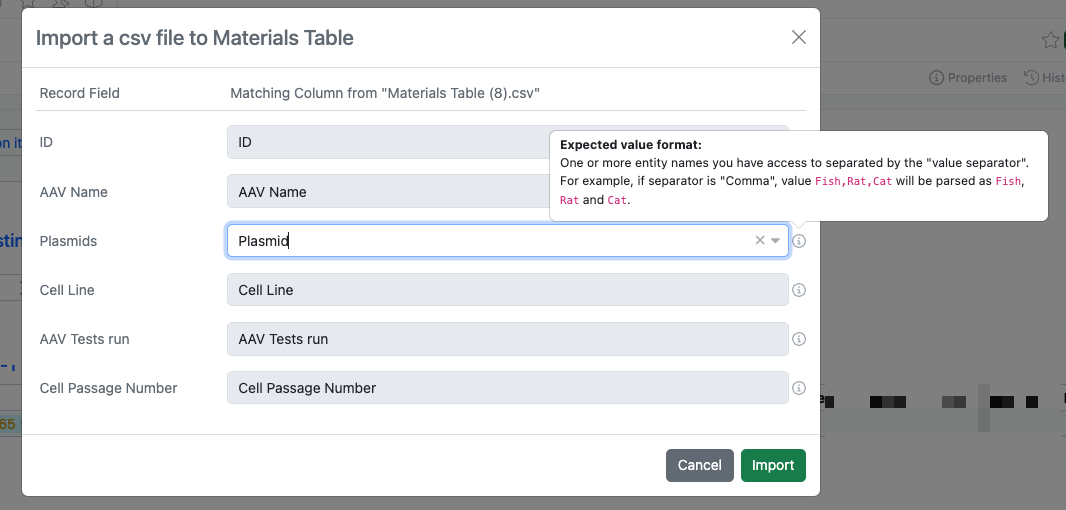
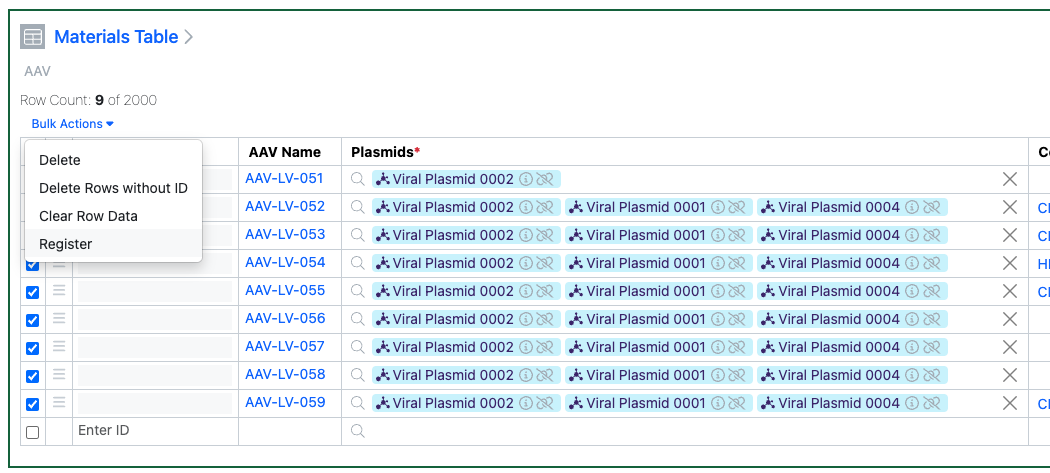
Users may now upload CSVs that include internal references to Tables and Materials Tables. Internal references must be valid and unique across the system to be accepted. Delimiters are required for multi-select internal references. For column headers that do not map to the tables, the user will be prompted to map the values. If there are any errors in the upload, the user will be notified, and no values will be added to the table.
Variations Tables
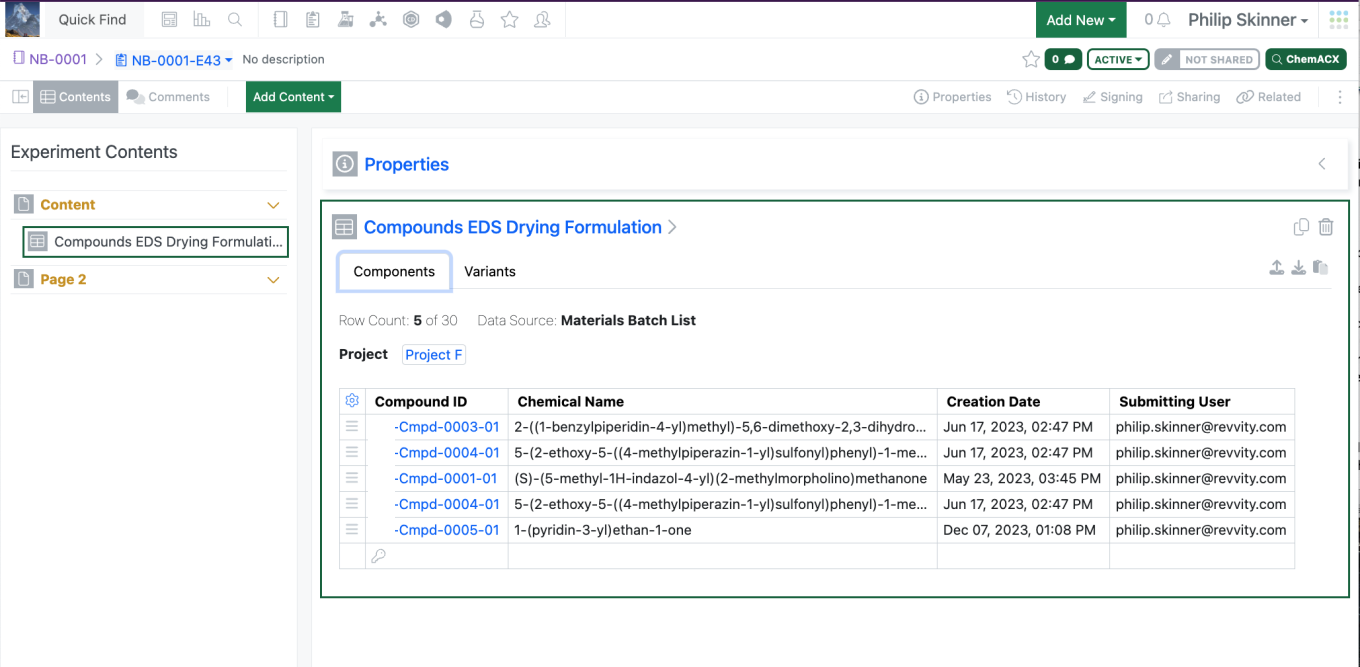
We have added a new content entity type called Variations Tables. These objects were designed primarily to satisfy the needs of varying compositions and conditions in materials sciences although they have broader applicability.
Users can select a Variations Table template to use. Once selected they can fill in a Components table to describe their high level composition. This components table allows data entry in our standard set of property types, data can be added via lookup to an Internal or External Data Source, manually entered or calculated via equations in appropriate columns. Data can also be uploaded via CSV or pasted into the relevant cells. Data can also be downloaded to csv, or copied to clipboard as tab delimited text.
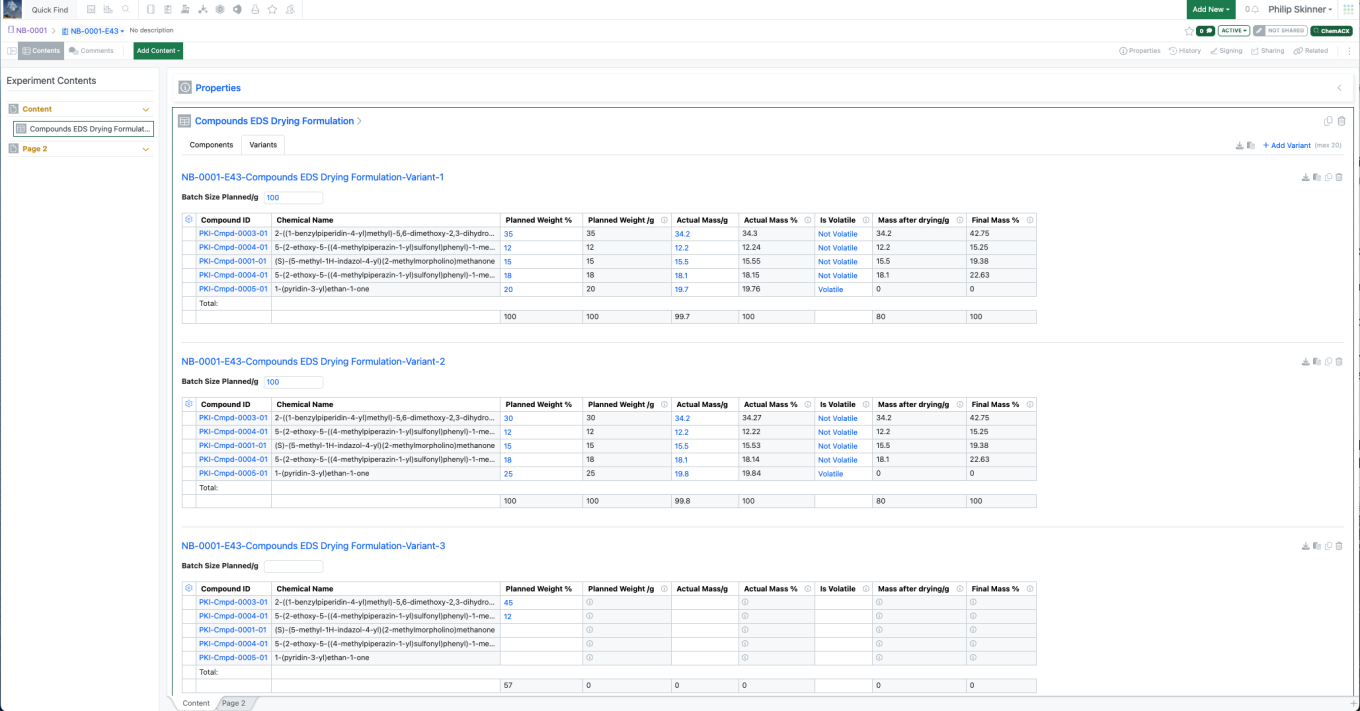
Once the Components have been defined, the user can add a series of Variants. In these Variants tables, they can add data to additional columns appended to the list of components. Again, the Variants allow data entry in our standard set of property types, data can be manually entered or calculated via equations in numeric columns. Data can be copy/pasted, but cannot be uploaded from csv files. Users can create new Variants or can clone existing Variants. Data for individual, or for all Variants, can be downloaded to csv, or copied to clipboard as tab delimited text. Variants are named according to a naming sequence defined by the System Administrator.
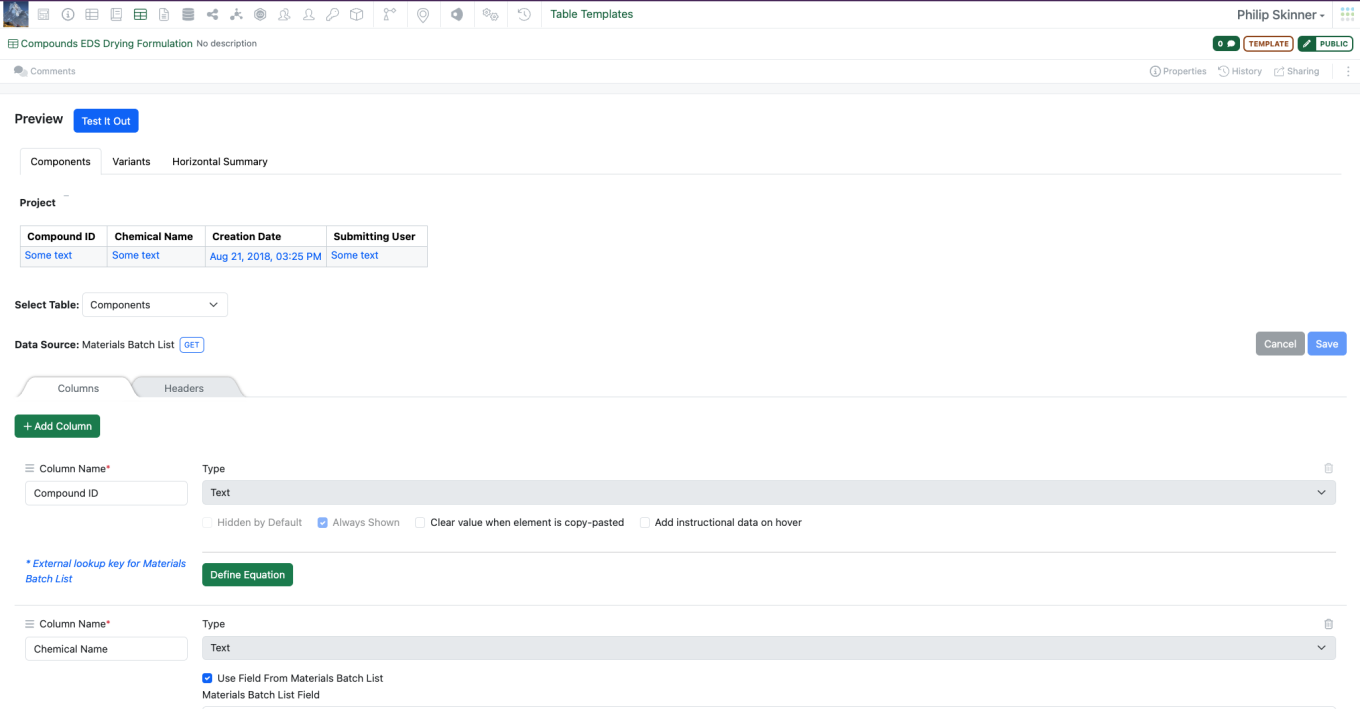
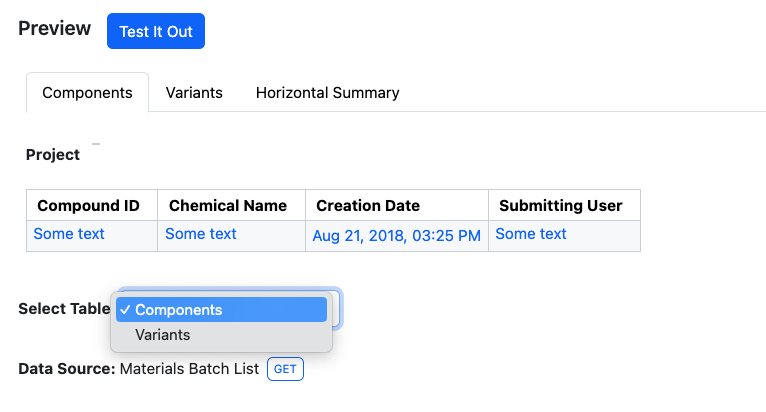
Variation Table Templates are defined by an administrator in the Table Templates folder in SNConfig. Administrators can define Headers and Properties at both the Components and Variants level, from the standard library of property types. All Component Properties are also added into the Variants view but can be defined as hidden by default if not typically needed. The admin can select Internal/External Data sources for use in the Components view, and define equations on appropriate columns to calculate the values.

The names for the Variants are generated automatically. A System Administrator can define a string format for the naming in System Settings. This naming format then applies to all new Variations created using all Variation Table Templates.
Inventory
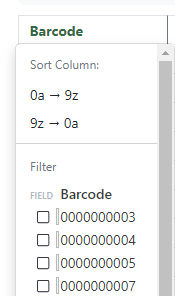
Additional updates have been made to the column headers in the Container Search Table results. For barcode/ids users can click on the header and sort or filter the results:
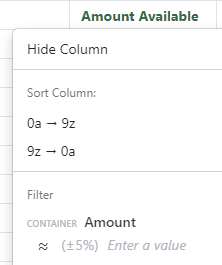
For all other headers besides Barcode, there is a Hide Column option.
For the Amount Available/ fields that are numbers with units the Filter will allow you to enter a value. For container properties, you can Sort as well:
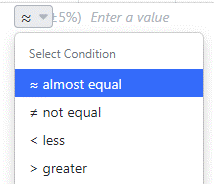
The operator can be updated:
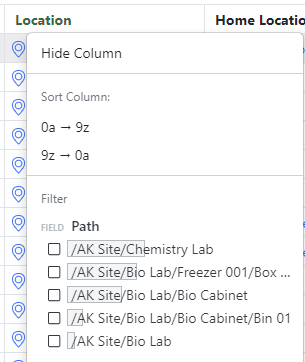
For Locations, a path can be selected to narrow the results:
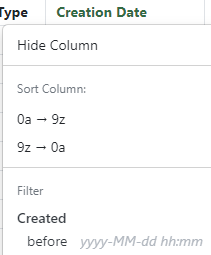
For Date headers you can enter a date and change the “before” operator:

To reorder the columns, drag and drop the header where you would like it:
Before:

After:
Materials
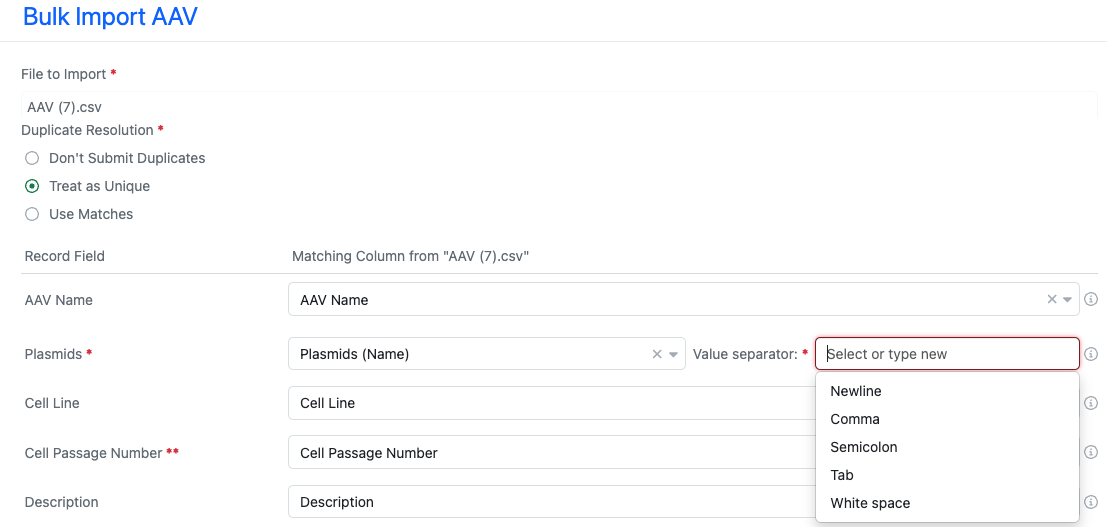
Users may include internal references in bulk uploads to Materials Libraries. Users specify the column with the internal references and the delimiters in the CSV for upload. Users may specify new delimiters if desired. Values must be unique and valid to successfully be used to create new Materials in Bulk. Internal references that do not meet these criteria will be included in an error report.
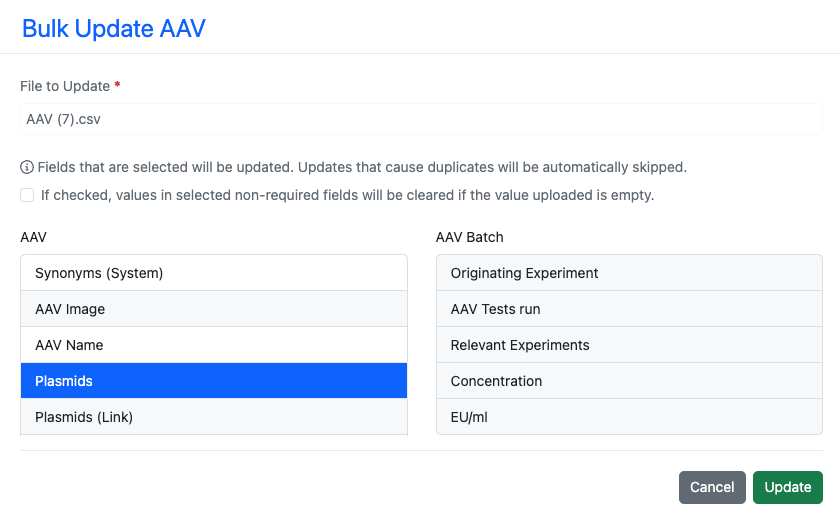
Users may include internal reference values in bulk updates. Values must be unique and valid to successfully be used to update Materials in bulk. Internal references that do not meet these criteria will be included in an error report.